Learn about the latest news from the world of biking.

The Benefits of Great Places to Ride
June 3, 2025
Learn why great places to ride benefit everyone and see how your community’s network of great places to ride ranks with PeopleForBikes’ City Ratings.

PeopleForBikes City Ratings: What’s New for 2025
June 2, 2025
By including thousands of bike projects being completed across the U.S., we’re making the critical connection between the creation of safe and connected bike infrastructure and improved City Ratings scores.
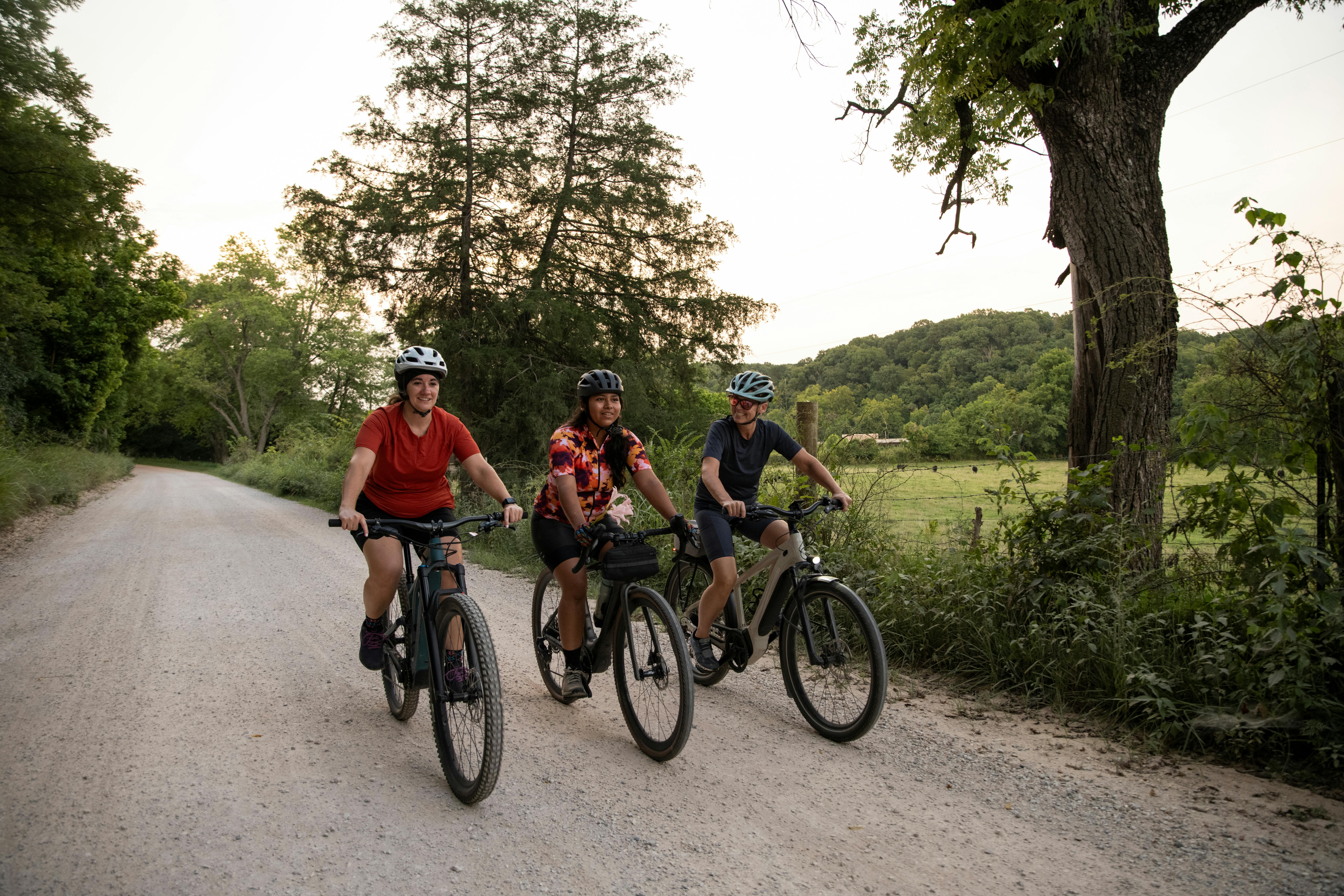
House Budget Drops Closely Watched Public Lands Sell-Off Proposal
May 23, 2025
PeopleForBikes strongly supports the recent successful effort to prevent the sale of public lands led by Rep. Zinke (R-MT) and Rep. Simpson (R-ID).

New Report Dives Into Why Public Lands Are Crucial for Americans
May 16, 2025
Outdoor recreation is booming across the U.S., and protecting access to public lands is critical to continuing this momentum.

Mountain Biking Means Business
May 16, 2025
A recent study from the Trust for Public Land highlights the tremendous economic benefits of mountain biking, especially for rural communities.

Bike Industry Updates on New Trump Administration Tariffs
May 12, 2025
Following the announcement of a 90-day reduction in reciprocal tariffs between the U.S. and China, the total tariff on most bicycles imported from China will be 66% with e-bikes at 55%.

Five Priorities for Increasing Bicycle Access on Public Lands
April 25, 2025
PeopleForBikes is advocating to keep public lands public and expand access for bike riders on public lands nationwide.

Five Ways to Boost Employee Engagement During May Bike Month
April 14, 2025
This May, thousands of businesses across the U.S. will encourage their employees to get out on two wheels. Is your organization ready to ride along?

More Americans Rode a Bike Than Ever Before in 2024
April 11, 2025
A record 112 million Americans — 35% of those ages 3 and older — rode a bike at least once in 2024. Youth ridership saw the biggest surge, reversing a steady decline since 2018.

PeopleForBikes Supports Children’s Bill of Rights in Sport Because Every Kid Deserves Safe Places to Ride
April 9, 2025
Every child deserves the freedom to ride, play, and explore, but too many kids lack access to safe bike paths, parks, and trails. That’s why PeopleForBikes is proud to endorse a nationwide initiative from the Aspen Institute’s Project Play that champions access to youth sports and outdoor recreation.

PeopleForBikes FAQ on Trump Administration Tariffs
April 7, 2025
PeopleForBikes' policy experts provide general information on the current state of trade and tariffs for members of the bike industry.

Industry Leaders Push for Tariff Relief and Trade Fairness During PeopleForBikes’ Fly-In in Washington, D.C.
March 31, 2025
Focused on retroactive GSP authorization and de minimis reform, PeopleForBikes hosted industry executives for meetings with congressional offices and committees.
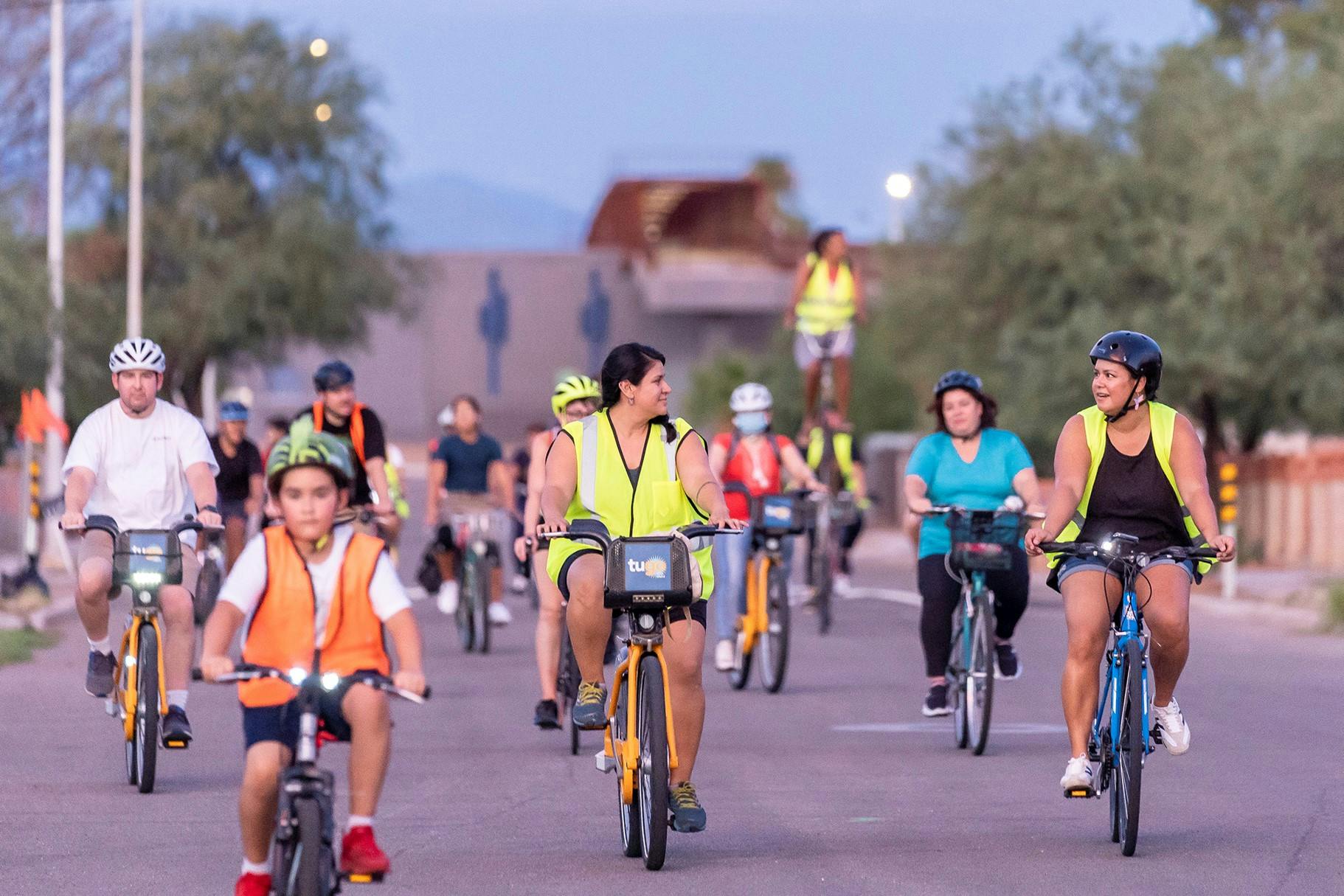
Advancing Resilience and Access to Biking in Tucson
March 13, 2025
Sustainability sponsors for PeopleForBikes’ annual Bicycle Leadership Conference and FUGA, a local mobility justice organization, are helping more people access active transportation.

How to Advocate for Better Biking in Your Community
March 13, 2025
Whether you have five minutes or an entire afternoon, PeopleForBikes developed some simple steps you can take to improve biking in your backyard.

PeopleForBikes’ New Tool to Expand Access to Recreational Bicycling
February 24, 2025
The first-of-its-kind Recreational Bicycling Access Tool measures and quantifies access to recreational bicycling facilities across the U.S. to guide investment in more and better places to ride.

Bikes and E-Bikes Avoid New Steel and Aluminum Tariffs
February 18, 2025
The new tariffs are set to go into effect on March 12, 2025.

PeopleForBikes Industry Community Grants Are Supporting Youth Bicycling Nationwide
January 28, 2025
Projects like Apache County's pump and skills track in Arizona, Los Angeles Bicycle Academy’s youth programs, and the Lodestone XC mountain bike park in Kearns, Utah, are creating safe and inclusive spaces for the next generation of riders.
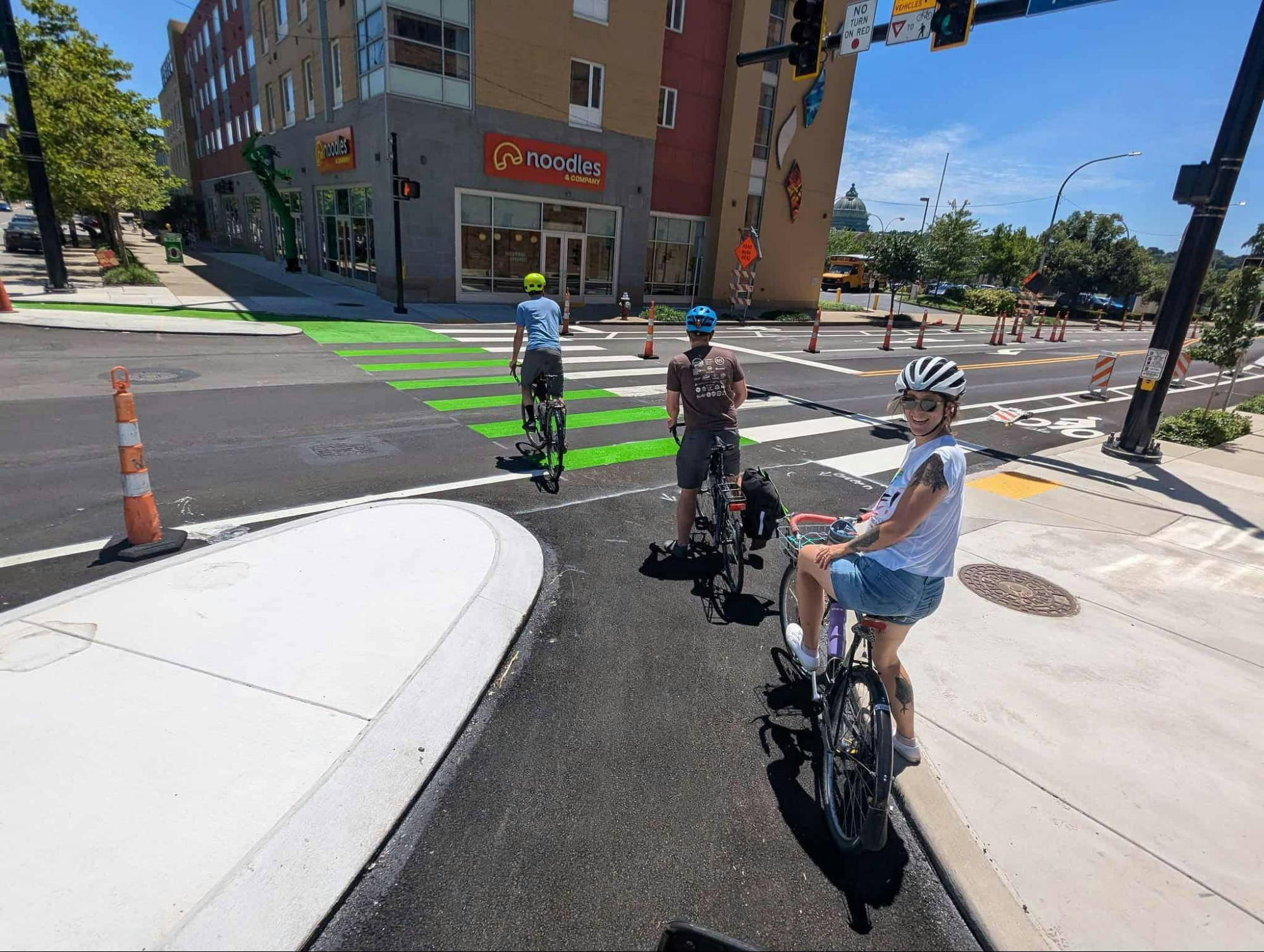
2024’s Best New U.S. Bikeways
January 23, 2025
With amazing new bike infrastructure being built across the U.S., PeopleForBikes collected some of the best bike projects built in the last year to celebrate how all kinds of communities are benefiting from safe, fun, and connected places to bike.

Supporting Better Biking in Chicago With the Active Transportation Alliance
January 21, 2025
PeopleForBikes is supporting the nonprofit advocacy organization’s efforts to transform Chicago streets by making biking safer and more accessible for everyone.
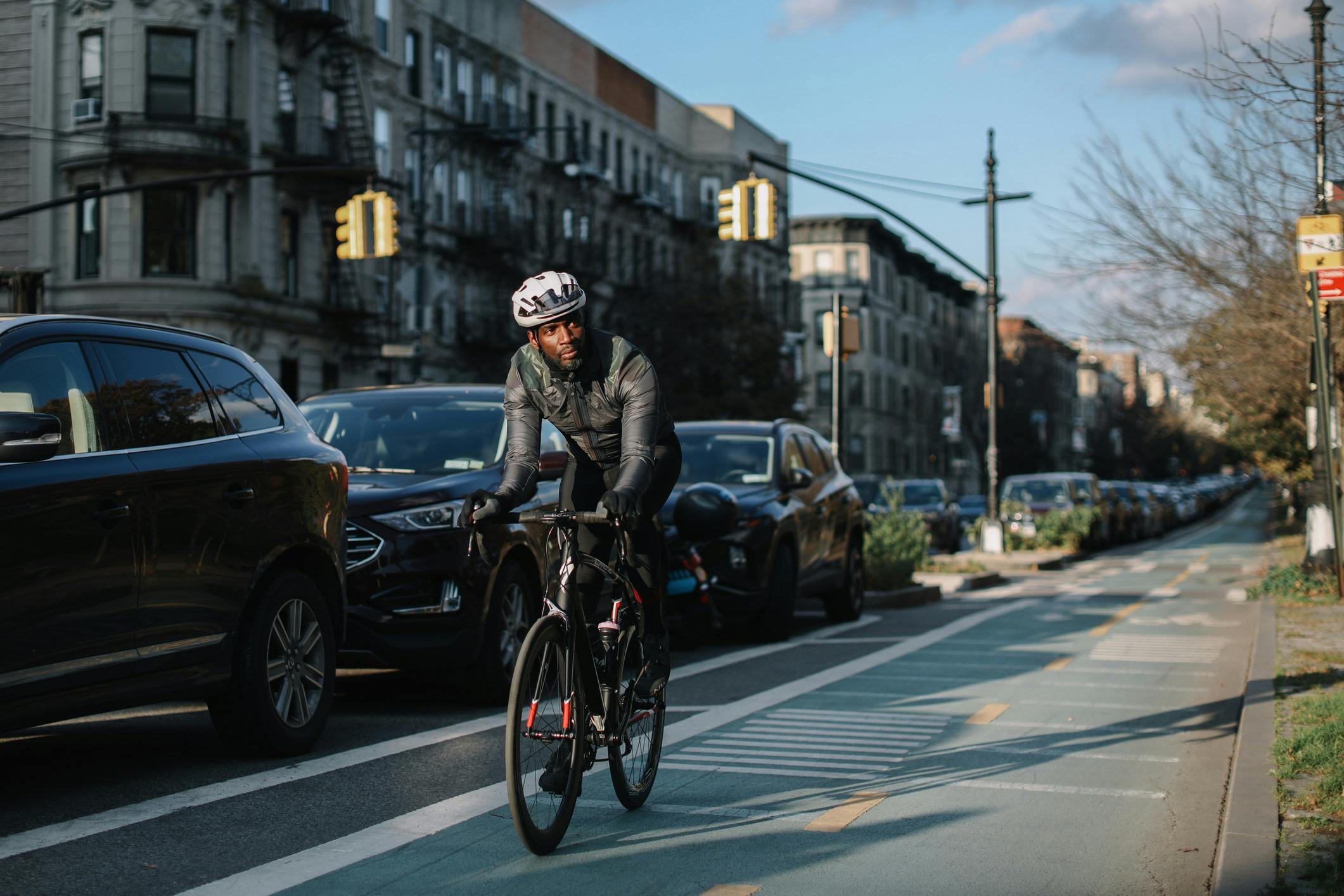
New Resources Offer Guidance on Building Great Places to Ride
January 21, 2025
As communities work to improve the quality and design of bike infrastructure, two new resources provide state-of-the-art strategies for creating safer, more connected, and user-friendly bikeways that meet the needs of riders in diverse environments.

Reflections on Shared Micromobility and the Road Ahead
January 21, 2025
Better Bike Share Partnership Writer and Content Manager Odochi Akwani shares personal reflections on the past year and explores what’s ahead in 2025.

PeopleForBikes Celebrates Passage of EXPLORE Act, Expanding Access to Outdoor Recreation Nationwide
December 20, 2024
Our organization strongly advocated for the bipartisan legislation that looks to improve and expand America’s outdoor recreation economy while delivering sustainable economic boosts to rural communities.

Why New York City Faces a Perfect Storm of E-Mobility Risks
December 17, 2024
A disproportionate number of fatalities related to fires from unsafe and untested lithium-ion batteries used in e-mobility products are occuring in New York City, but why?

PeopleForBikes' 2024 Industry Community Grants Recipients
December 16, 2024
$75,000 in grants will help fund projects that support our focus on building infrastructure that makes communities great places to ride a bike.

Should You Buy Your Kid an E-Bike?
December 5, 2024
PeopleForBikes’ legal expert weighs in on what to look for ahead of the holiday shopping season.

Building the Future of Biking in Los Angeles
November 15, 2024
Leveraging the upcoming Olympic Games and a local desire to improve bike networks, PeopleForBikes has an ambitious vision for biking in LA for 2028 and beyond.

Key Updates from the California Mountain Biking Coalition’s Connected Conference
November 15, 2024
Advocacy, eMTB policy, and recreation funding were all major points of discussion.
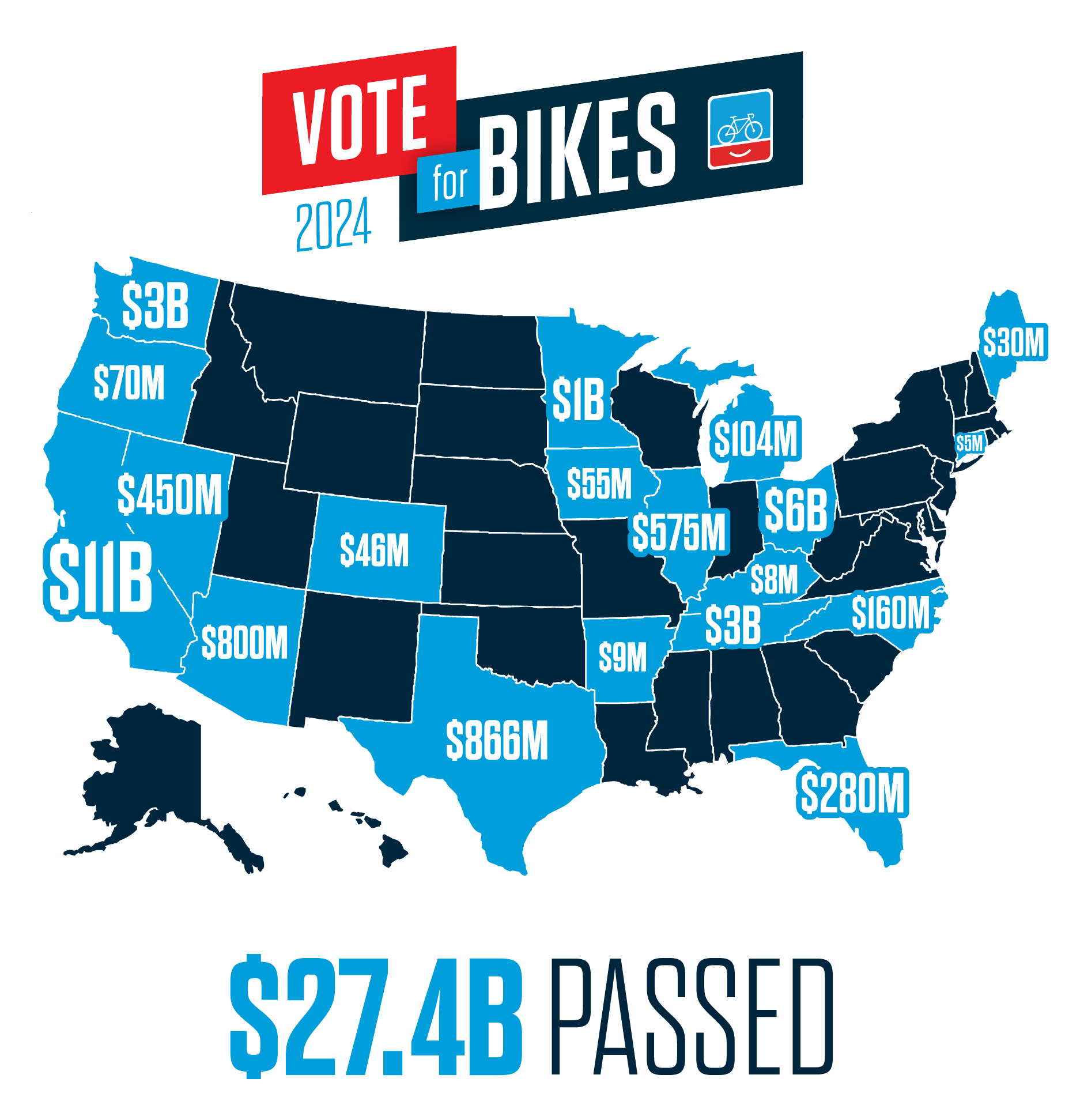
Voters Approved $27.4 Billion to Support Better Biking in 2024
November 13, 2024
PeopleForBikes' VoteForBikes campaign tracked and supported a historic amount of funding on pro-bike ballot measures across the U.S. this year.

Advance Safe and Successful E-Bike Policies With PeopleForBikes’ New Toolkit
October 28, 2024
The new resource includes best practices and sample legislation for bike advocates, industry members, and policymakers to create or amend state and local electric bicycle laws.
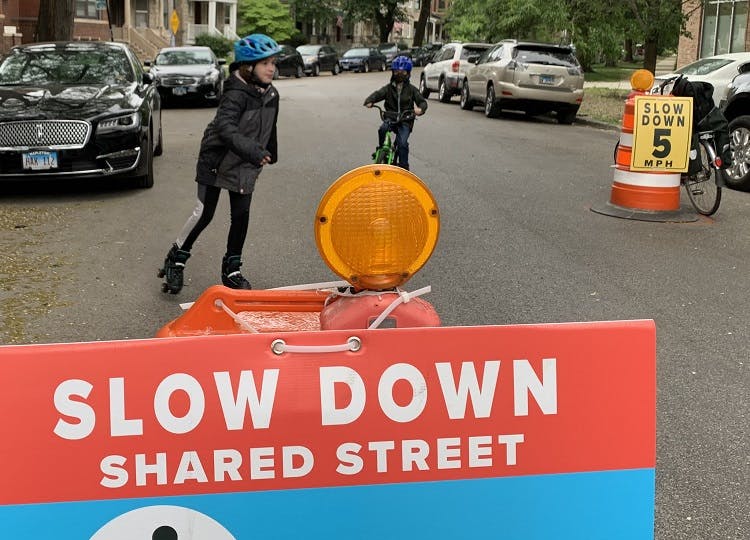
Designing Streets for Safety, Not Speed
October 11, 2024
Reducing traffic speeds is one of the most effective strategies to make our streets safer for all road users, not just bicyclists.

National Park Service Releases Environmental Assessment on E-Bike Use in National Parks
October 11, 2024
The assessment confirmed that the use of e-bikes where traditional bikes are already allowed has no significant impact on the environment or user experience.
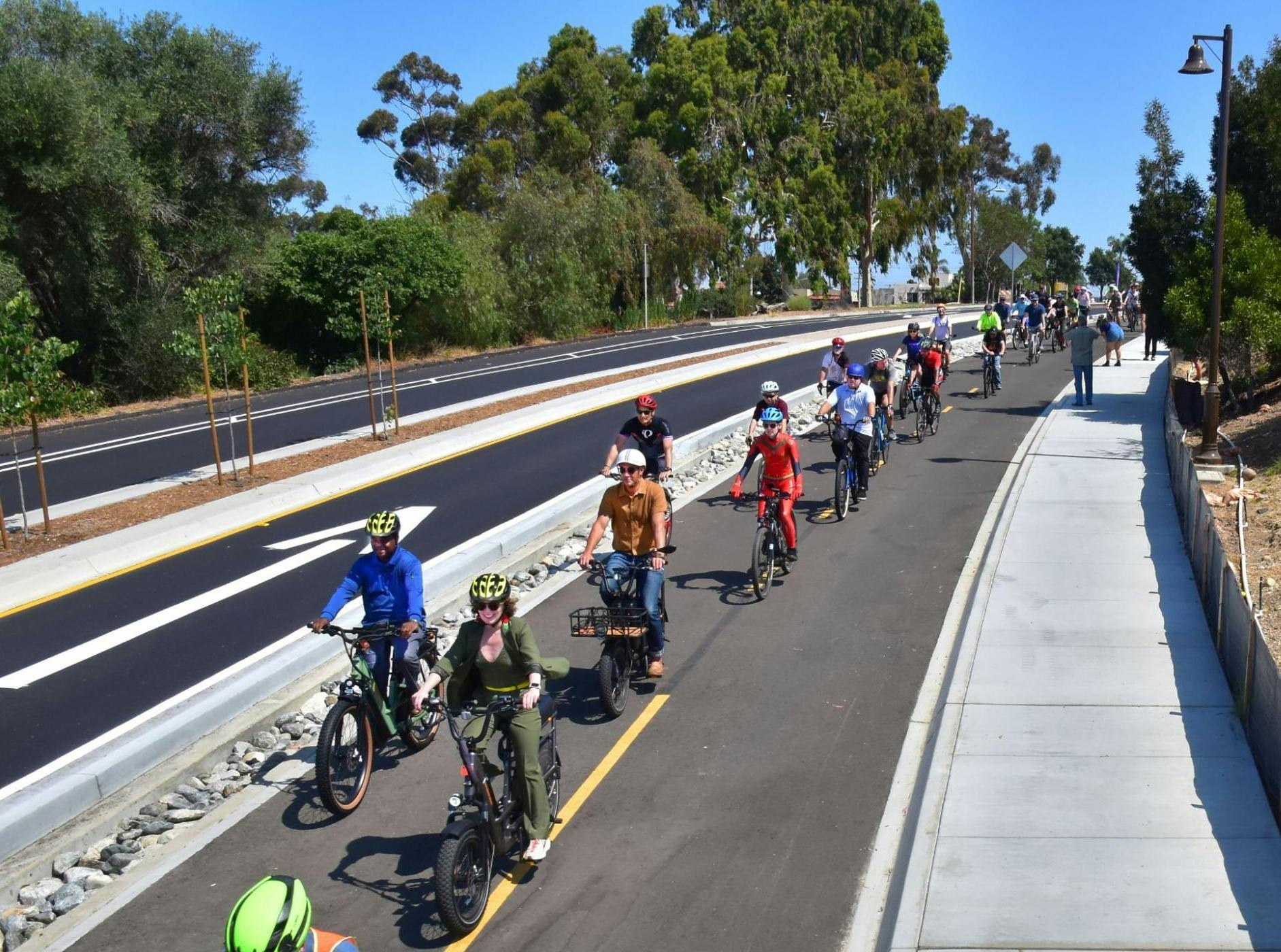
Bike Projects Are Benefiting Communities Nationwide
October 10, 2024
We’re celebrating a few of our favorite recent bike projects along with the many benefits that better places to ride can offer communities of all shapes and sizes.
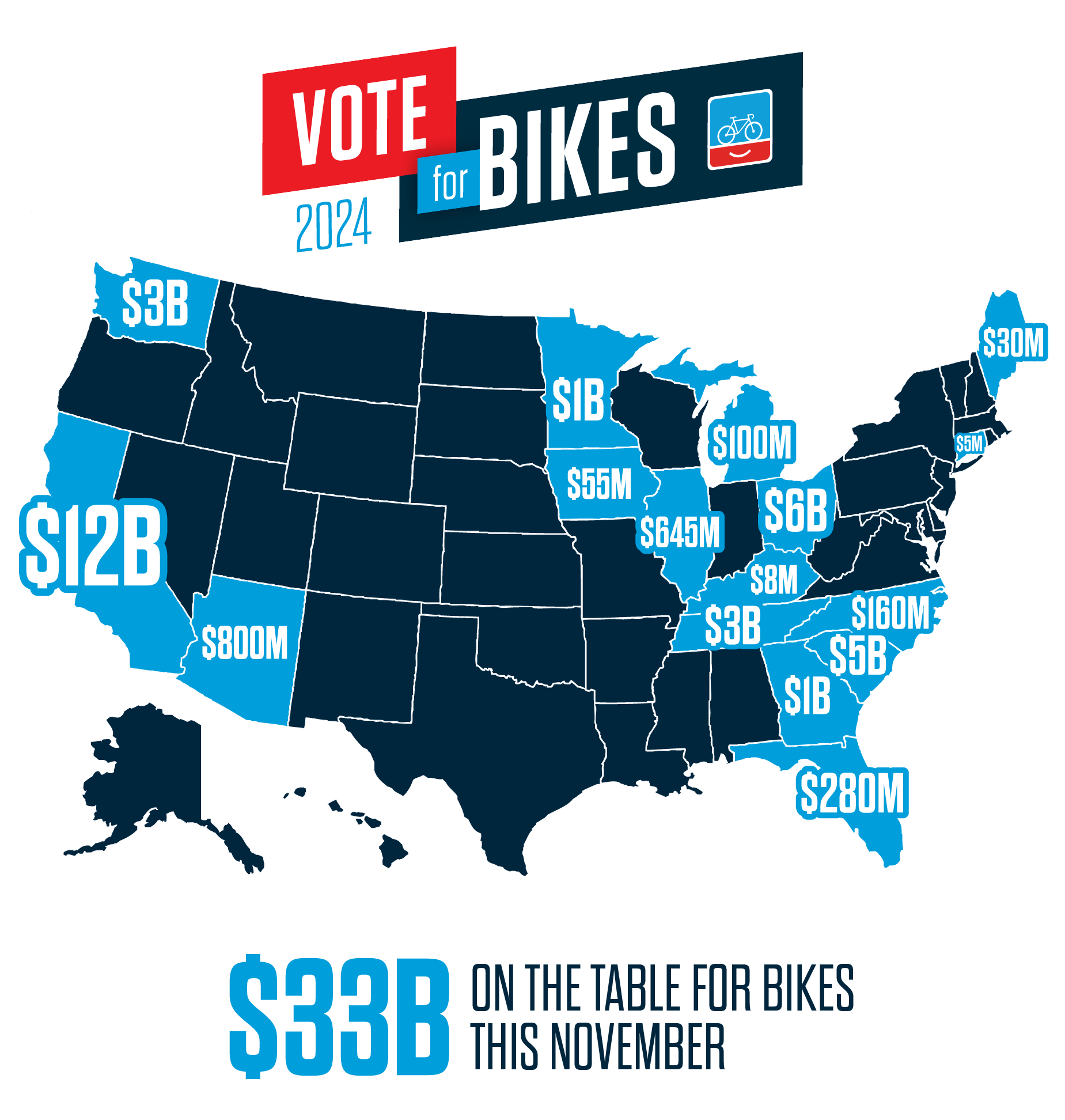
$33 Billion is on the Ballot for Bikes This November
October 7, 2024
Through our VoteForBikes campaign, we're tracking and advocating for ballot measures that make it safer and easier to ride a bike in communities across the country.

Tennessee is Using Bicycling to Support Rural Tourism
August 28, 2024
52 curated bike routes across the state look to help residents and visitors experience Tennessee’s rural landscapes and towns by bike.

Tracking Seasonality and International Sales Trends of Kids’ Bikes
August 13, 2024
Despite representing a smaller percentage of total dollar sales, the kids’ bike category is still an important metric for the growth of the bike industry.

Origins of Unity: How Bikes Belong Shaped Industry Collaboration
August 13, 2024
We take a look back at key moments from bike industry history that led to the founding of Bikes Belong (now PeopleForBikes), uniting the industry under one collective voice.

NACTO’s 2023 Shared Micromobility Report Highlights Need for Partnerships and Public Investment
August 9, 2024
Data from the U.S. and Canada shows how shared micromobility (SMM) ridership continues to increase despite challenges cities face in providing SMM as an essential service.

PeopleForBikes’ 2024 Policy Wins Advance Bicycling Safety and Access Nationwide
July 29, 2024
PeopleForBikes successfully advocated for a multitude of policies during the 2024 legislative session that will support and bike businesses and riders of all ages, abilities, and backgrounds nationwide.

Boost Your City Ratings Score With These Four Policies
July 24, 2024
Explore top policy approaches to accelerate the construction of bike infrastructure to help your community climb the ranks of PeopleForBikes’ City Ratings program.

2024’s Most Improved Cities for Biking
July 24, 2024
Through City Ratings, PeopleForBikes evaluates the progression of bike networks in thousands of U.S. cities. Discover which cities improved the most over the past four years and how they did it.
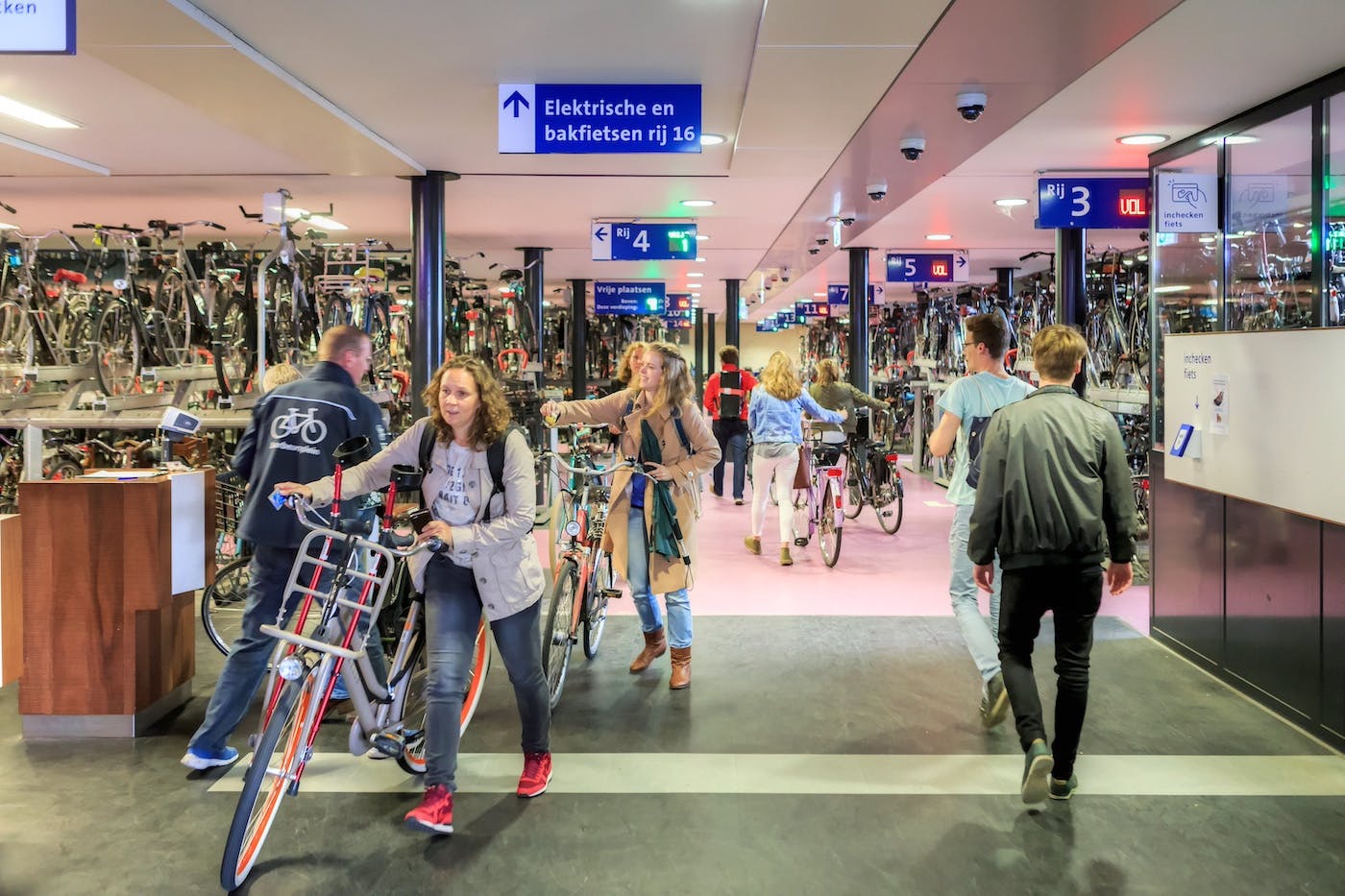
Utrecht's Constant Commitment to Make Biking Better
July 18, 2024
Explore a first-hand account of what it’s like to travel around one of the best cities for biking in the world.

Reconnecting With Joy: How a Simple Bike Bus Transformed a Neighborhood and Its Families
July 18, 2024
Thanks to a PeopleForBikes Industry Community Grant, Broadmor Elementary School students in Tempe, Arizona, are experiencing the magic of biking to school together.

Bikeable Hometowns: PeopleForBikes Staff Celebrate Their City Ratings Scores
July 16, 2024
Using the popular Strava Art method, eight PeopleForBikes staffers share what it’s like to bike where they live.
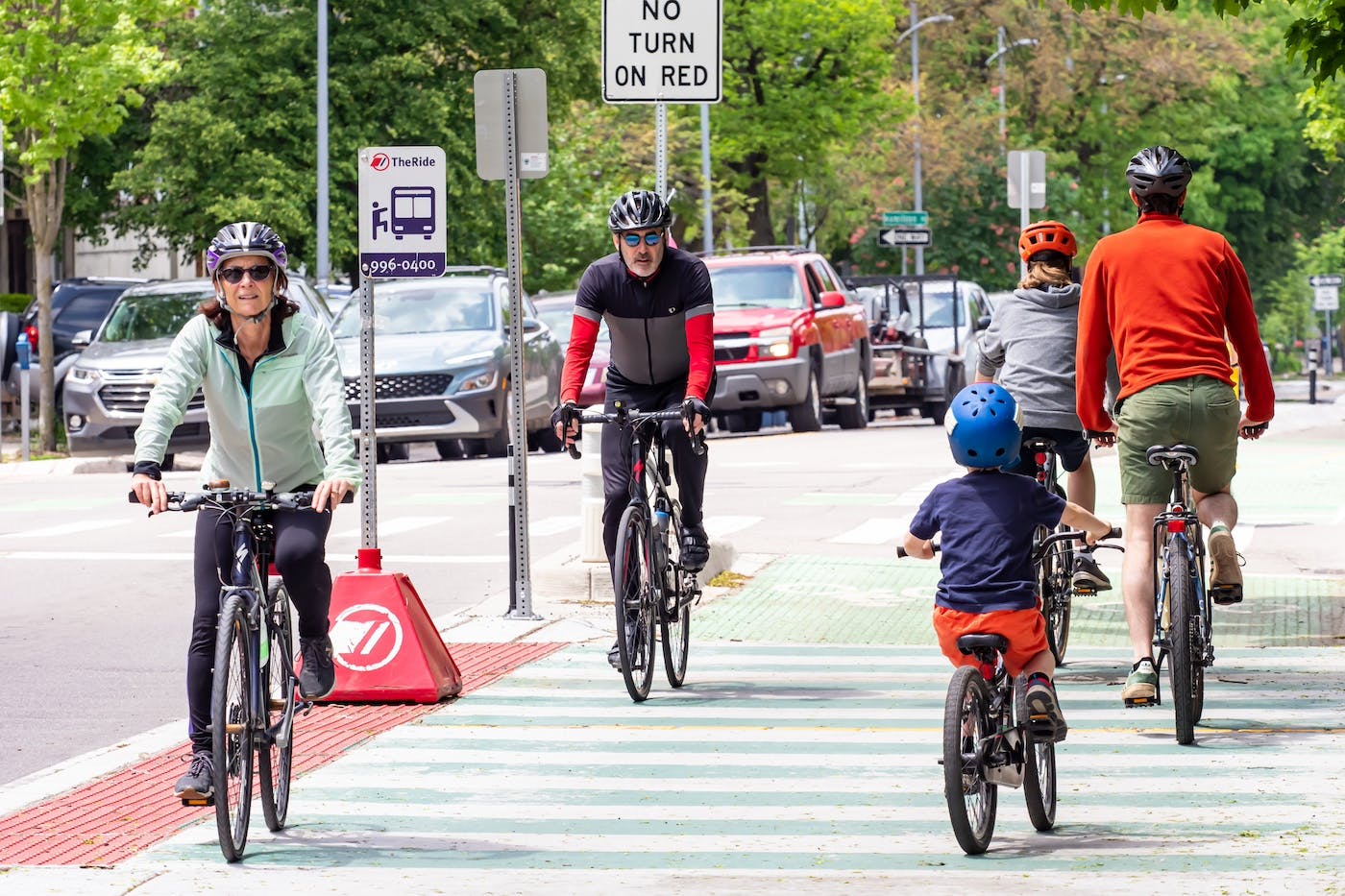
These Midwest College Towns Are Making Big Strides for Better Biking
July 11, 2024
We’re celebrating Ames, Iowa; Madison, Wisconsin; and Ann Arbor, Michigan as Cities on the Rise as part of PeopleForBikes’ 2024 City Ratings.

Great Biking Isn’t Just for Big Cities
July 10, 2024
The top 10 small cities in PeopleForBikes’ 2024 City Ratings scored an average of 89 out of a possible 100, showing that great places to bike come in all shapes and sizes.

Mountain Bike Market Insights From Industry Experts
July 8, 2024
Leaders from Workstand, Circana, and Bicycle Market Research offer an analysis of the mountain bike market with insights on discounting, inventory, and the used market.

New York Legislation Leads the Nation on E-Mobility Safety
July 8, 2024
The policies offer a model for other states to protect consumers and first responders from uncertified and unsafe batteries.

Electric Bicycle Market Insights From Industry Experts
July 8, 2024
Leaders from Workstand, Circana, and Bicycle Market Research answer questions about the electric bicycle market.
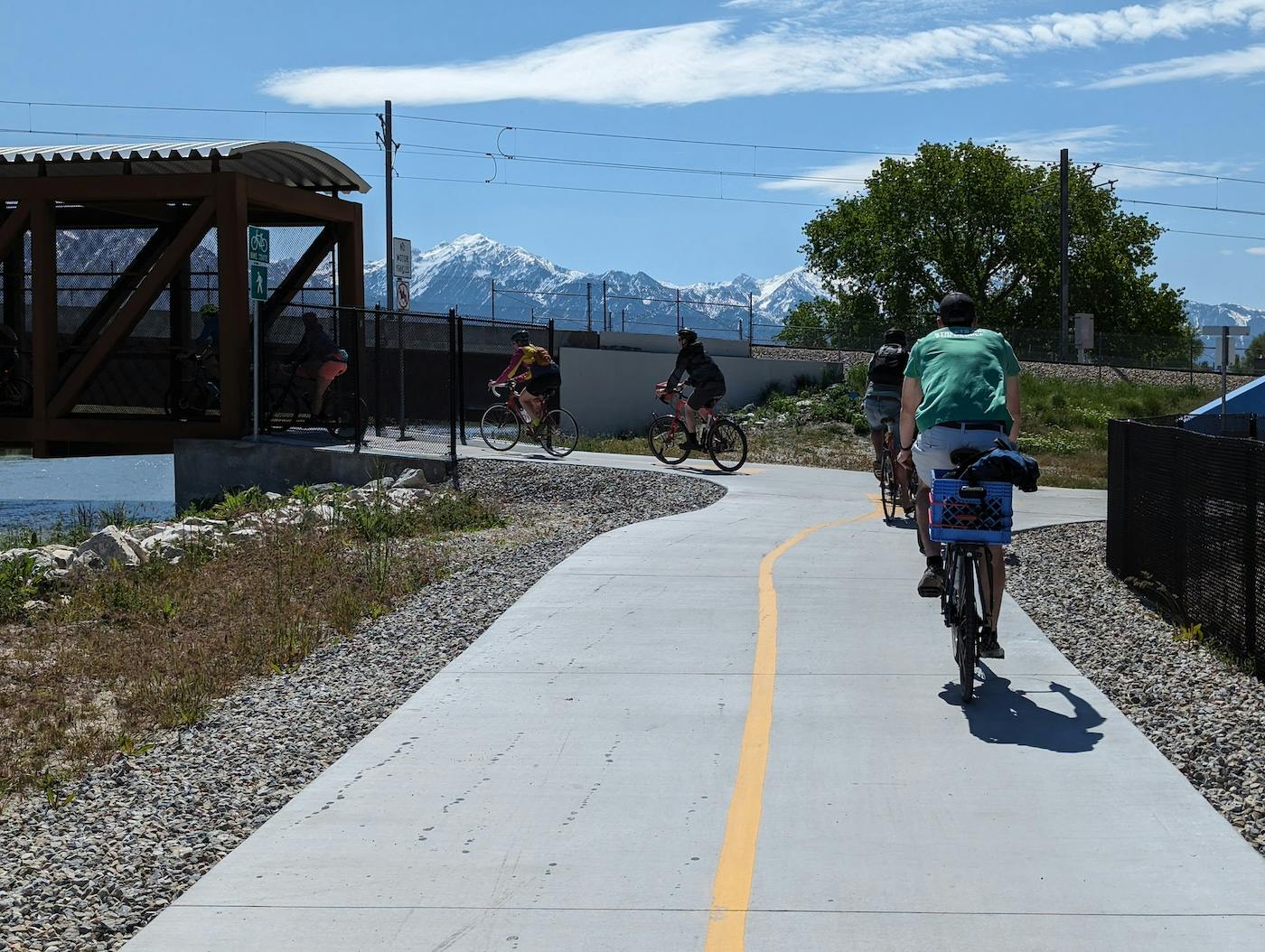
Investments in Infrastructure and Community Make Salt Lake City a Great Place to Bike
June 21, 2024
One of our 2024 Cities on the Rise, the Utah capital city raised its City Ratings score from 46 in 2020 to 52 in 2024.
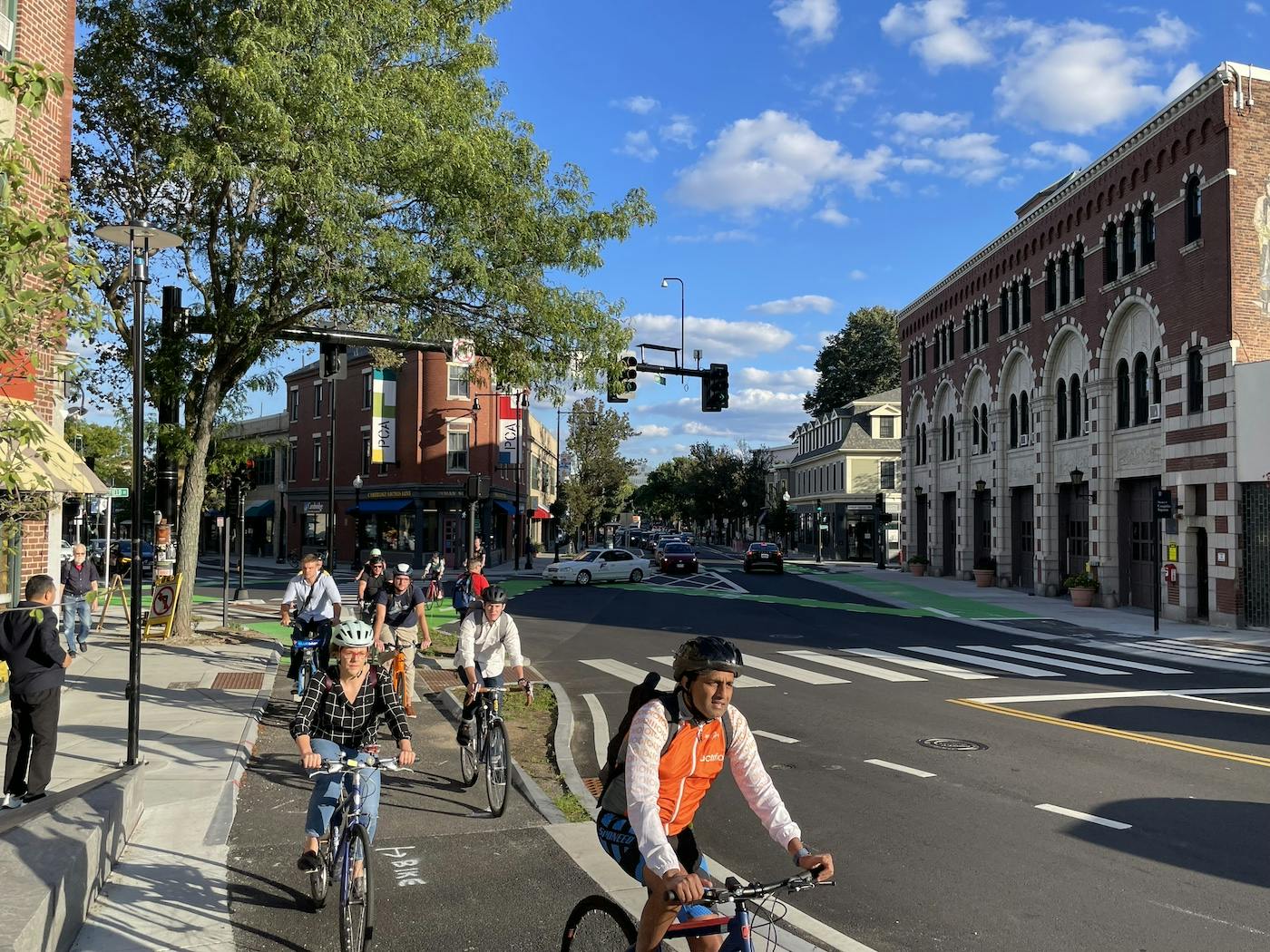
How Pro-Bike Policies Transformed Cambridge, Massachusetts, Into a Top City for Biking
June 21, 2024
As one of our 2024 Cities on the Rise, building better bike infrastructure isn’t just the norm in Cambridge, it's the law.

This Michigan Tourist Destination is the Best Place to Bike in the U.S.
June 21, 2024
New this year, Mackinac Island ranked #1 overall in our 2024 City Ratings.

London Leads the UK in Safe and Connected Places to Bike, but England Still Lags Behind Europe
June 21, 2024
The latest City Ratings, PeopleForBikes' annual program ranking global cities and towns on how good they are for biking, shows that while London continues to lead the way in England, the country as a whole continues to lag seriously behind its European counterparts. This new data may concern local ...
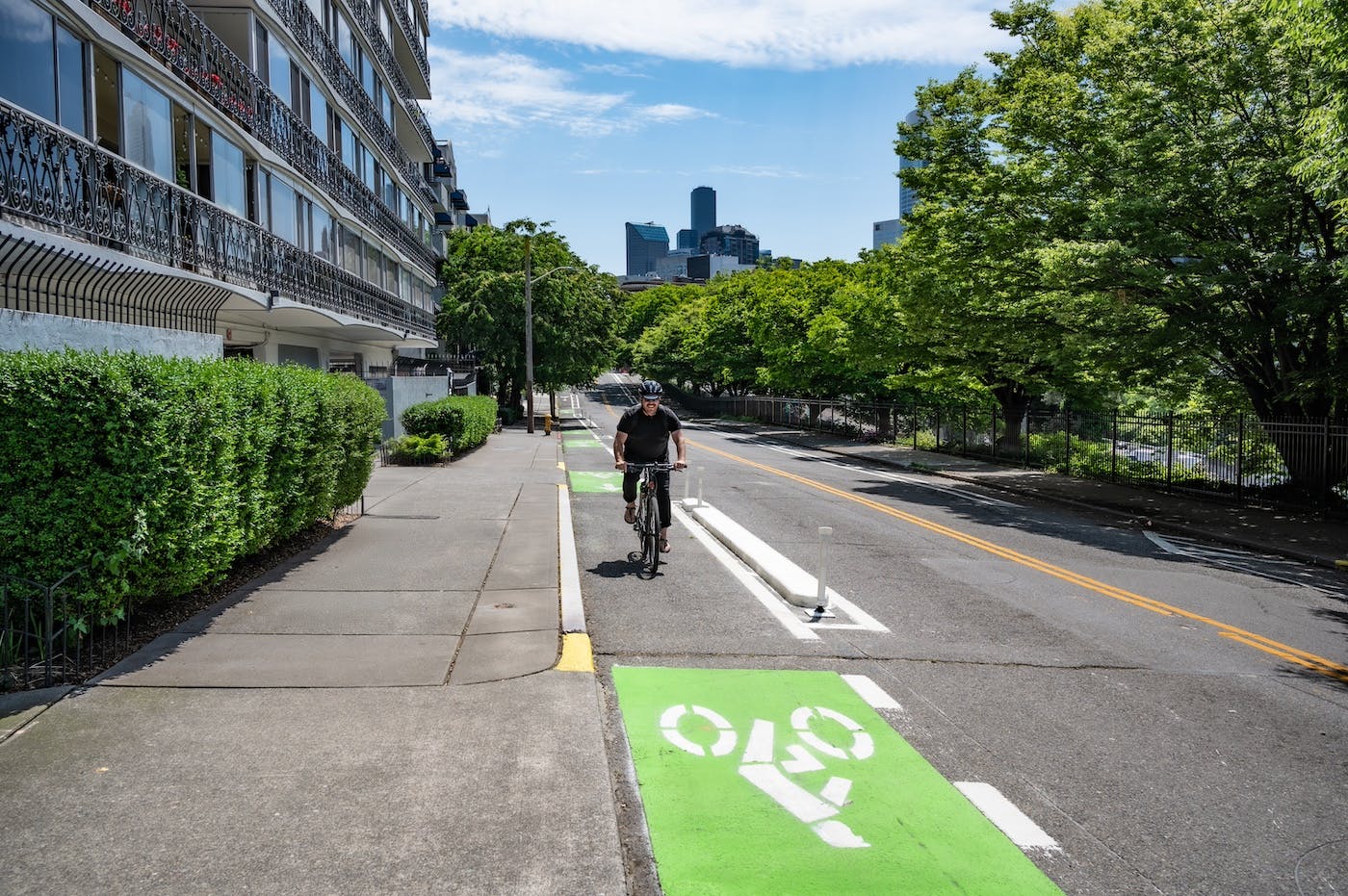
Bicycling Is Improving in Cities Across the U.S.
June 21, 2024
With seven years of City Ratings results, dive into the data and explore how bicycling has changed in cities nationwide since 2018.
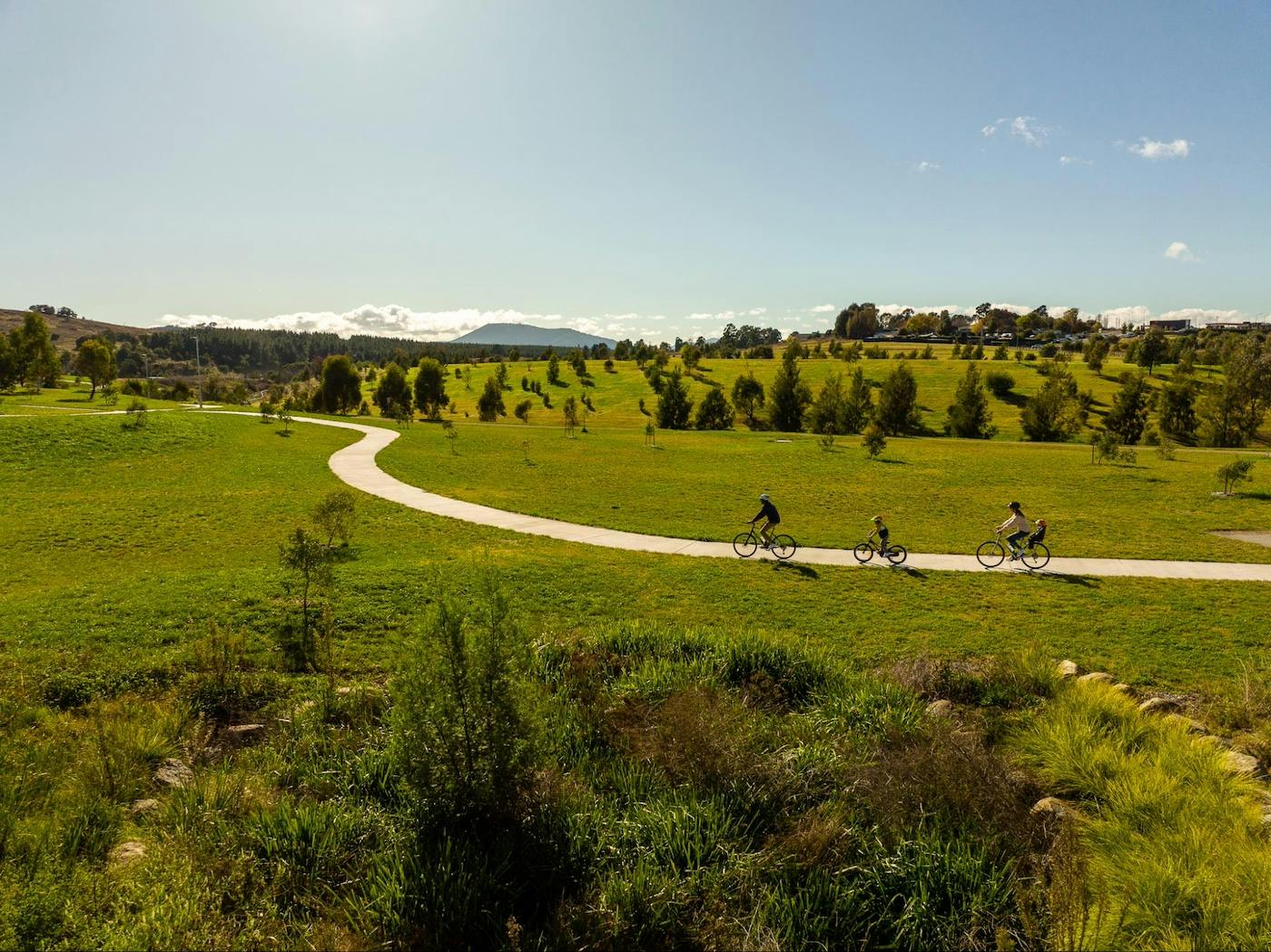
Canberra Comes Out on Top as Best City for Biking in Australia
June 21, 2024
The latest City Ratings, PeopleForBikes' annual program ranking global cities and towns on how good they are for bicycling, shows that Canberra is the best place for biking in Australia, followed by Alice Springs and Sunshine Coast. This comes as the Australian Government recently announced the larg ...

2024’s Best Places to Bike
June 21, 2024
This year’s City Ratings results feature some new and familiar faces across our top small, medium, large, and international cities for biking.
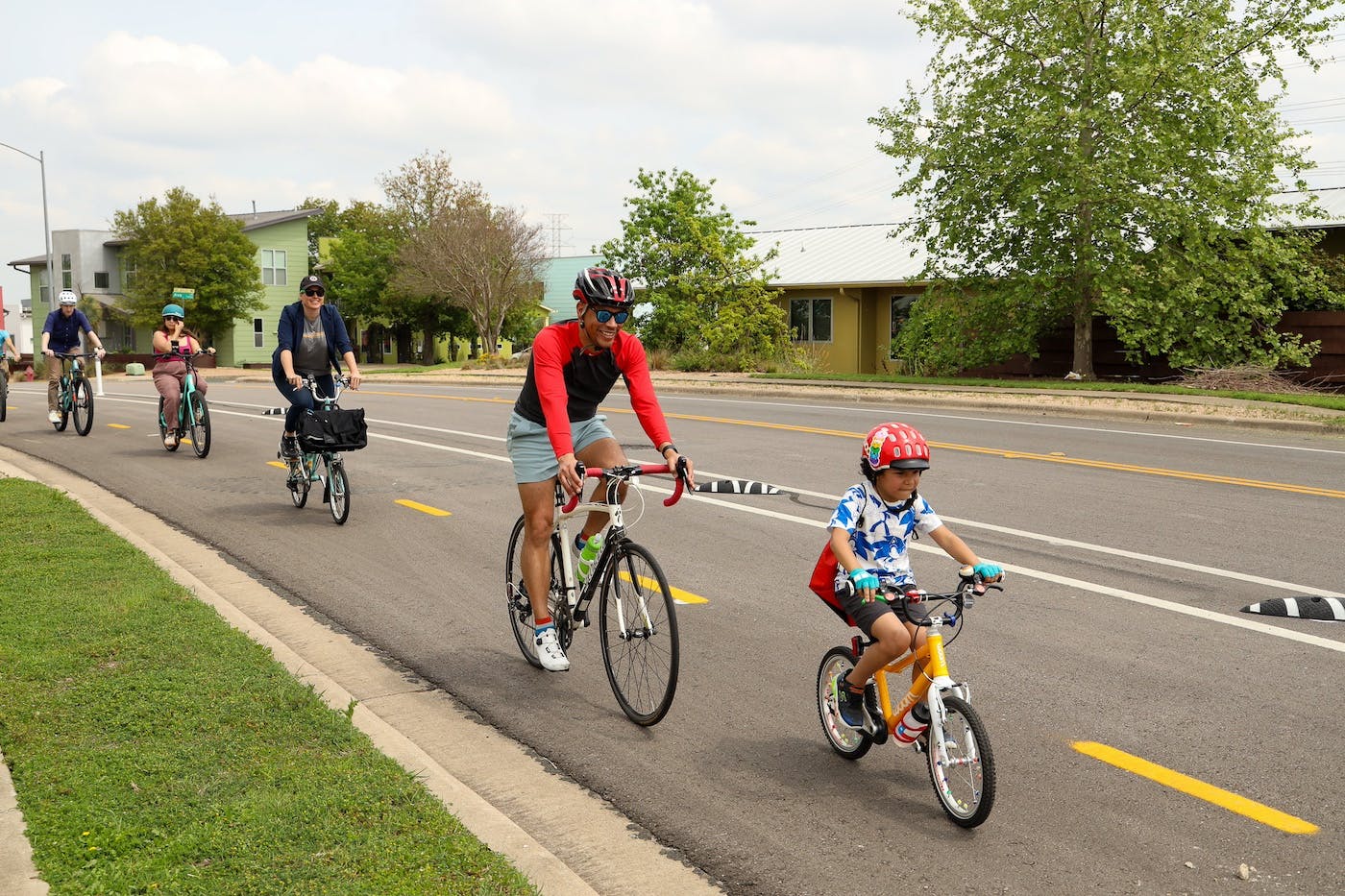
Why is Bike Infrastructure Important?
June 14, 2024
When people have safe and accessible places to bike, communities become safer and more sustainable, residents enjoy better physical and mental health, and the local economy thrives.

Advancing Bike Infrastructure Through Climate Legislation
June 13, 2024
With more state-level support behind the construction of bike infrastructure, more people can replace car trips with bike rides and reduce transportation-related emissions.

Minnesota on Track to Become the Safest State to Ride a Bicycle
June 12, 2024
New, nation-leading legislation is set to protect vulnerable road users, more clearly define electric bicycles, and require the implementation of Complete Streets policies.

Bureau of Land Management Releases Final Public Lands Rule
June 5, 2024
The Public Lands Rule legitimizes conservation as part of a multiple-use mandate and will guide the balanced management of our nation’s BLM lands.

Representing the Bicycle Industry at the National Outdoor Recreation Conference
June 5, 2024
National leaders gathered in Lake Tahoe, California, to chart the future of outdoor recreation access.
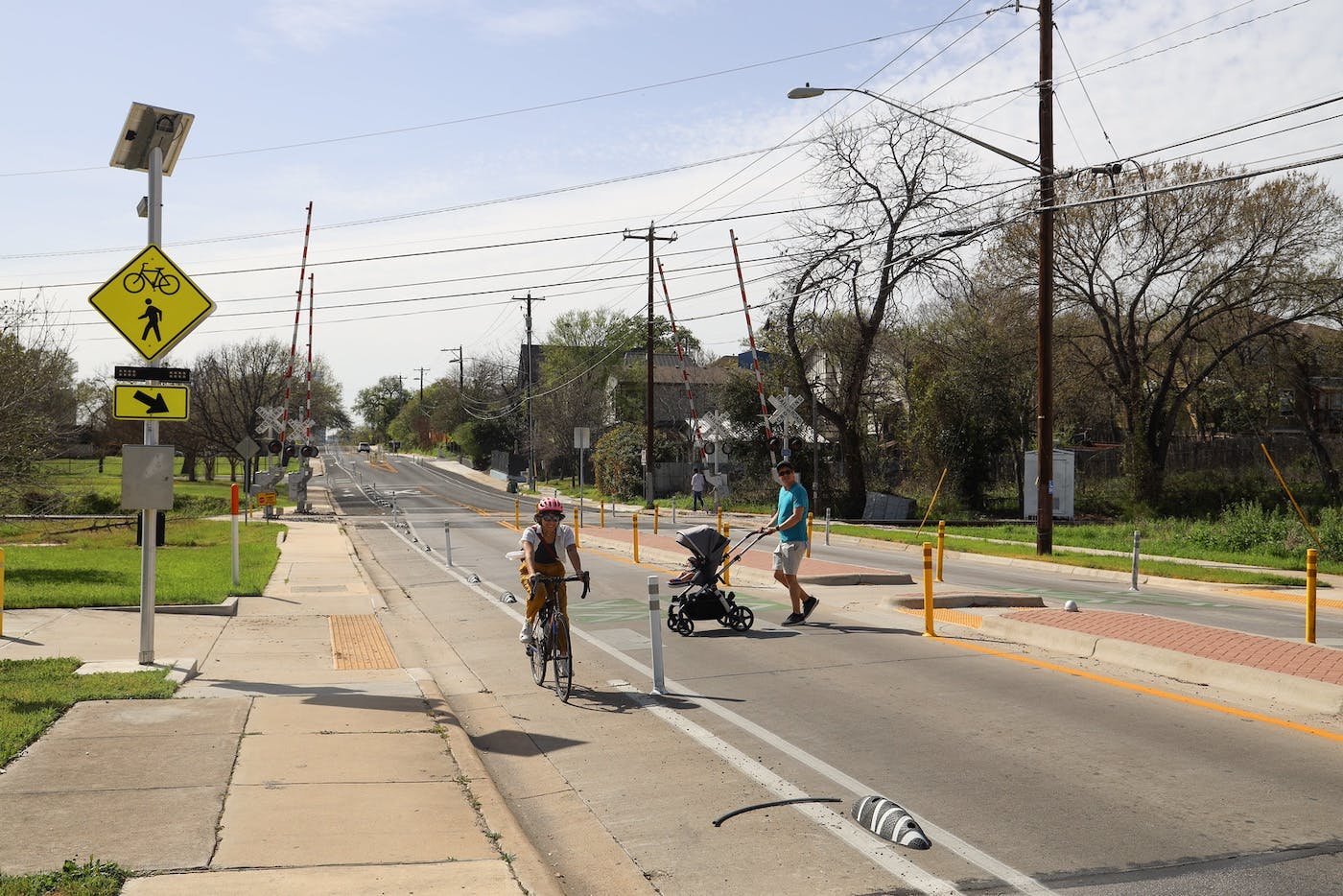
What Makes a Good Bike Network?
June 4, 2024
PeopleForBikes’ City Ratings program measures six factors found in good bike networks captured by the acronym SPRINT.

Advocating for a Pro-Bike Federal Trade Agenda
May 21, 2024
PeopleForBikes’ domestic trade policy for bicycles, electric bicycles, and bicycle products includes seven principles to create economic, environmental, and health benefits for all Americans.
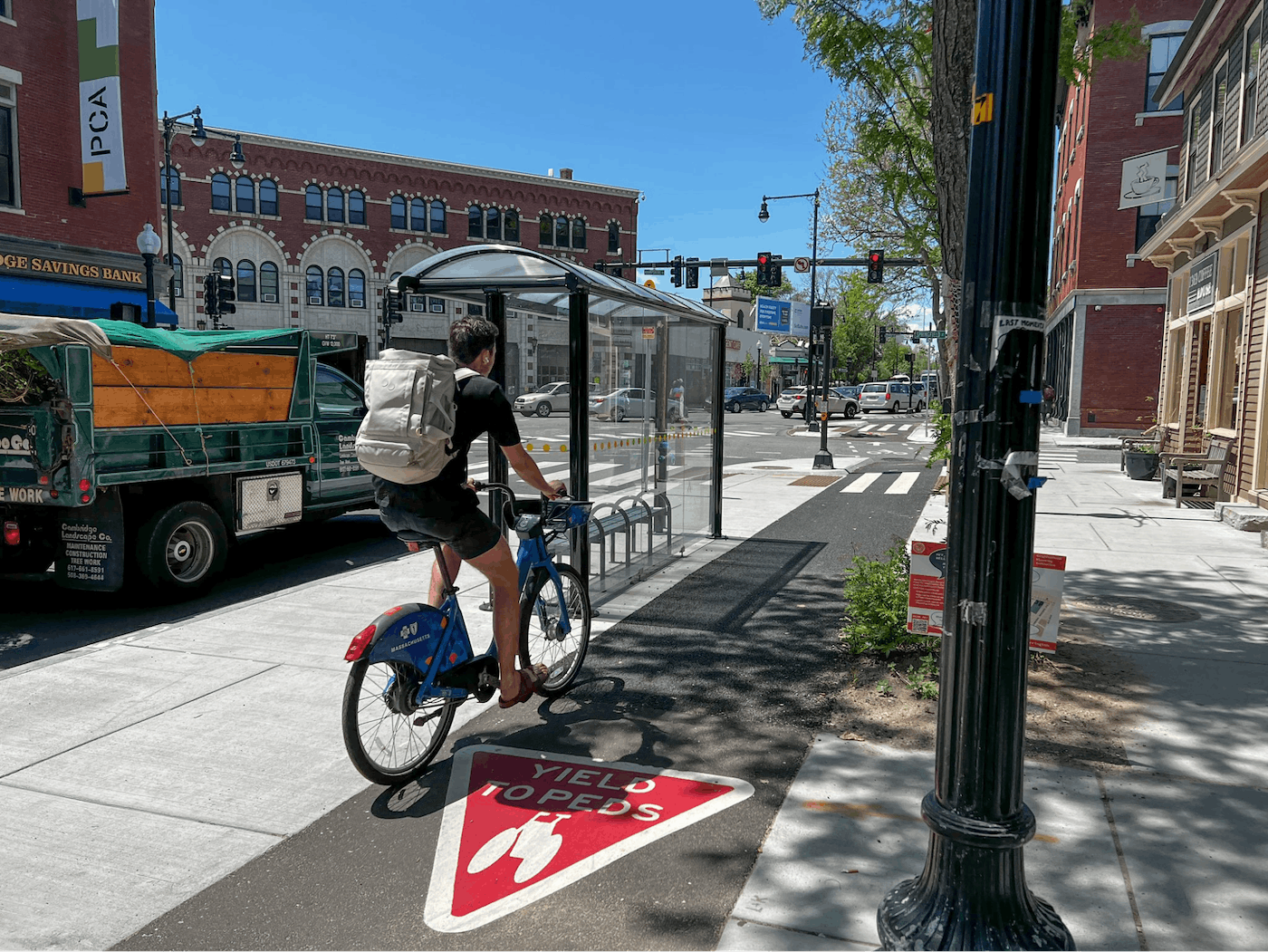
The Power of Complete Streets Mandates
May 16, 2024
Explore the crucial role of Complete Streets mandates in creating great bike networks as part of our blog series, "A Legislative Playbook to Build More Bikeable Communities.”

Shaping Future Safety Standards for Electric Bicycles
May 14, 2024
PeopleForBikes created an industrywide comment in response to the U.S. Consumer Product Safety Commission’s advanced notice of proposed rulemaking on e-bike safety standards.

Meet the Better Bike Share Partnership's New Living Lab Grantees
May 6, 2024
Four organizations will receive funding, support, and additional resources to develop best practices for expanding access to and use of shared micromobility in historically marginalized communities.

California's Pines to Mines Trail Project Announces Decision Notice and Finding of No Significant Impact
May 3, 2024
The project will provide new recreation opportunities open to equestrian, pedestrian, bicycle, and Class 1 eMTBs use on National Forest System lands.

A 2024 Mid-Session Recap of PeopleForBikes’ Work in State Legislatures Nationwide
April 23, 2024
With more than 650 pieces of legislation that could affect bikes in all 50 states, join us in celebrating five notable wins that will support safety, infrastructure, recreation, and electric bicycles.

You Can Help Improve Road Safety Across the United States
April 15, 2024
Your voice matters in shaping federal updates that will prioritize the safety of vulnerable road users, including people who ride bikes.
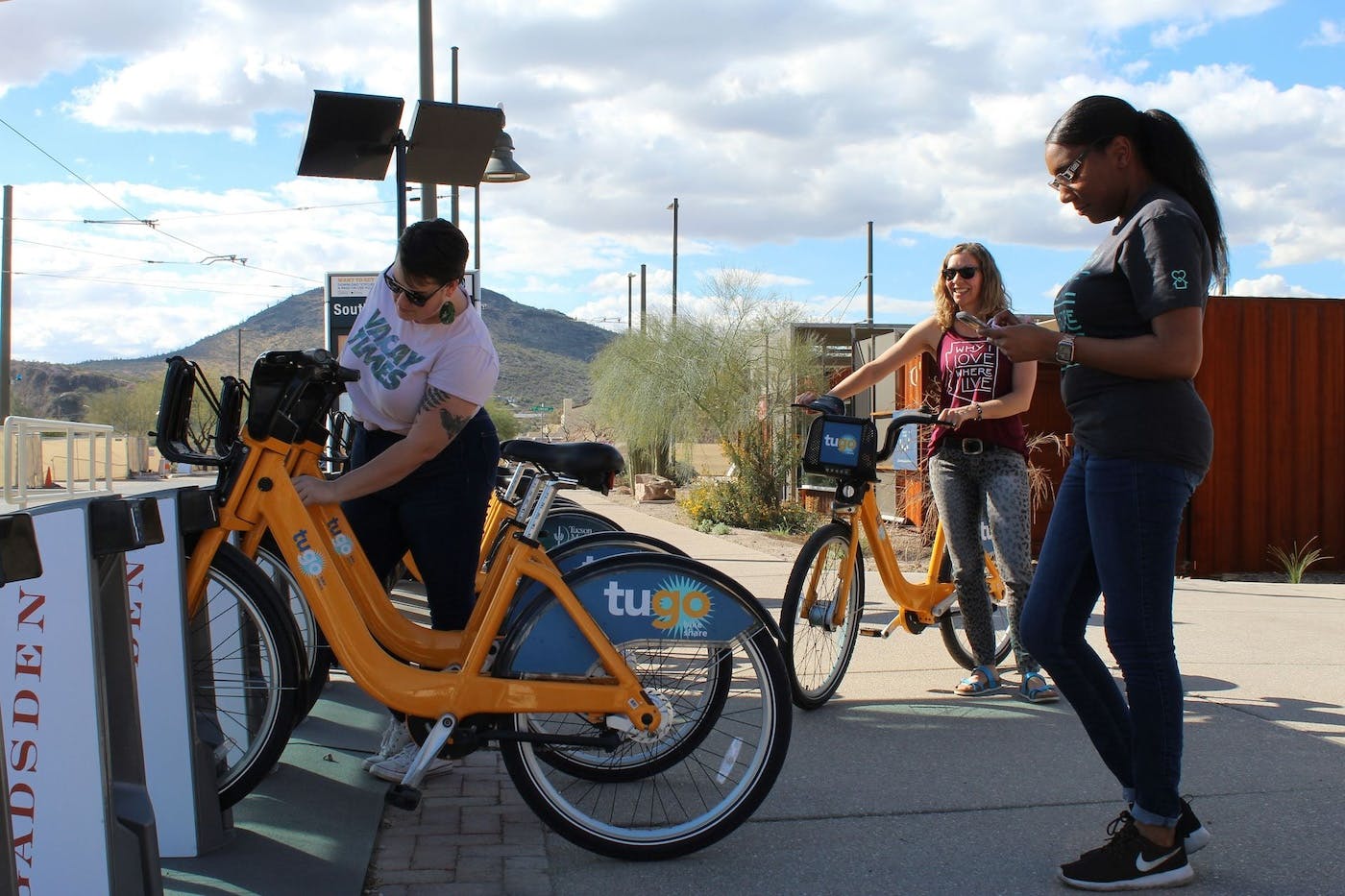
Bike Share Gets a Boost in Tucson
April 5, 2024
Sustainability sponsors for PeopleForBikes’ annual Bicycle Leadership Conference and Tugo Bike Share are expanding access to active transportation.
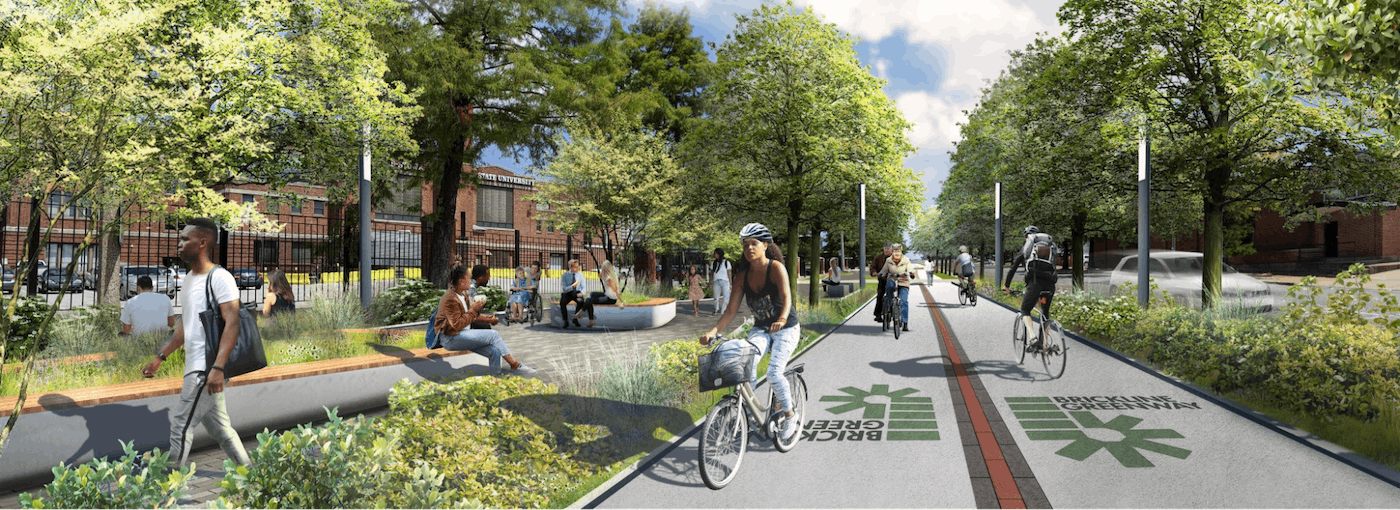
Federal Grants Help Bike Projects Reconnect Communities
April 4, 2024
Bikes were a big winner in USDOT’s recent round of grant awards for the highly competitive Reconnecting Communities and Neighborhoods Program.

How Bike Industry Companies Are Prioritizing Sustainability
March 13, 2024
From used bike programs to incorporating circularity into product design, these brands are working to decrease our industry’s impact on the environment.

Support the Next Generation of Bike Riders With a Riding for Focus Grant
February 26, 2024
Applications are open for Outride’s 2024 Riding for Focus program, which provides middle schools with everything they need to get students bicycling.

Own Your Backyard: An Industry Guide to Supporting Local Bike Infrastructure
February 23, 2024
Discover how your business can help get more people on bikes more often.
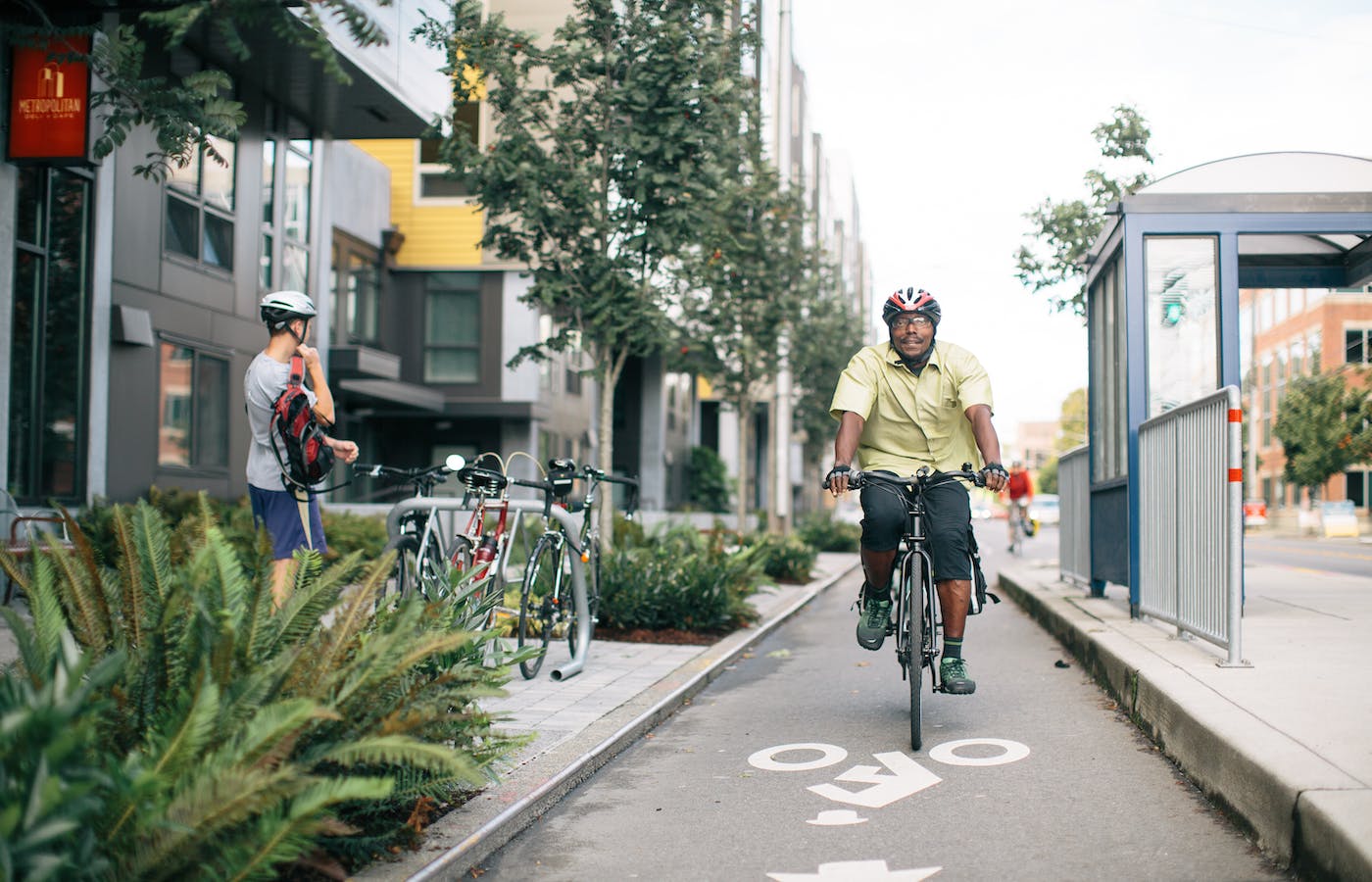
Paving the Way for Complete Bike Networks: The Essential Role of State and Local Funding
February 20, 2024
While billions of dollars in federal funding is available for bike infrastructure, local and state funding still plays the biggest role in financing better bike networks.

PeopleForBikes’ Guide to Effective Local Bike Advocacy
February 9, 2024
Our new guide offers key strategies to ensure your advocacy efforts have a lasting impact.

New Mexico Considers $350 Million in Funding for Conservation and Recreation
February 7, 2024
The Land of Enchantment Legacy Fund looks to provide a dedicated stream of resources to invest in the state’s public lands and waters.

EXPLORE Act Passes House Natural Resources Committee
January 18, 2024
The bipartisan legislation looks to improve and expand America’s outdoor recreation economy while delivering sustainable economic boosts to rural communities.
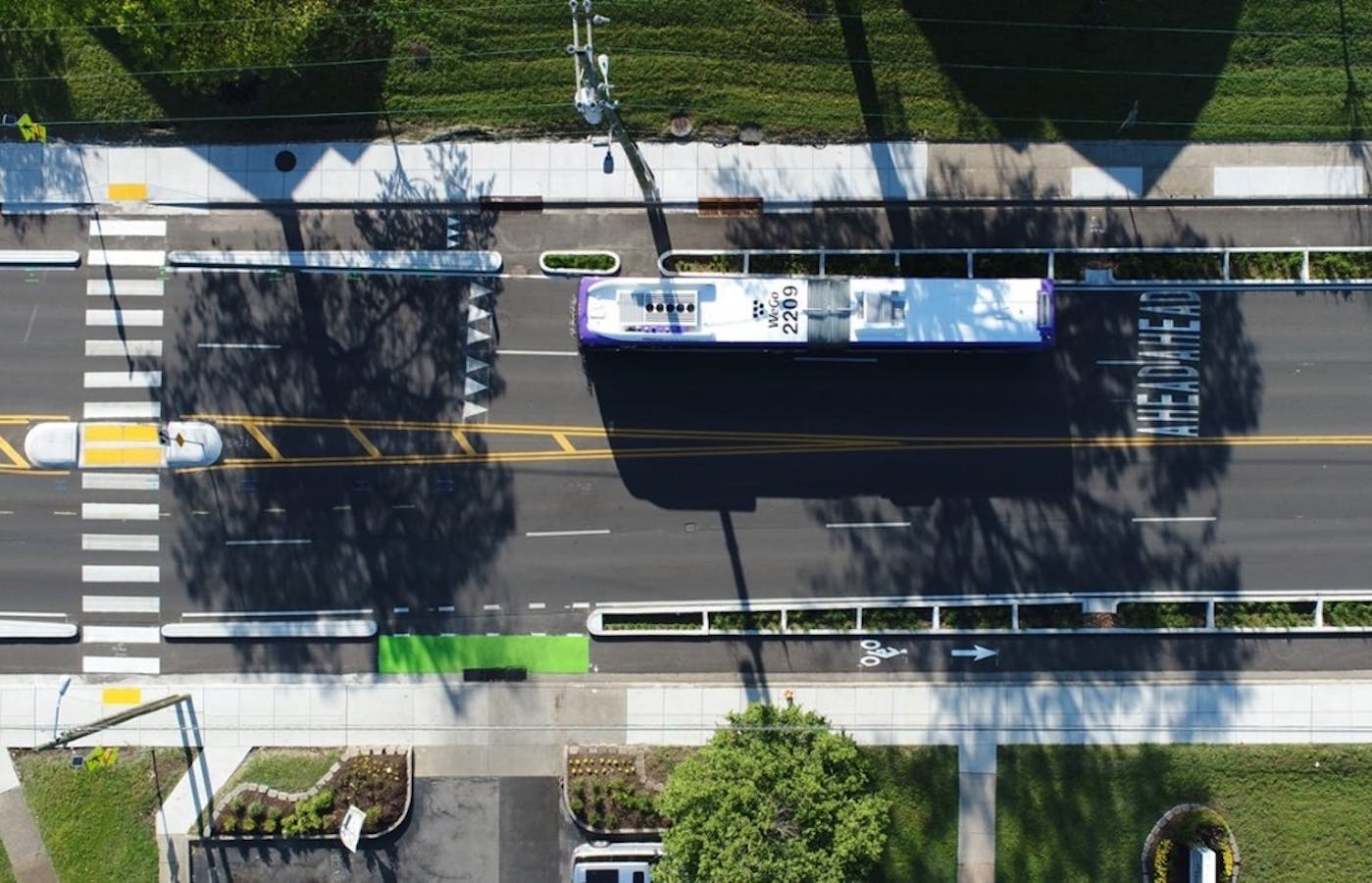
The Best New U.S. Bike Lanes of 2023
January 12, 2024
As we pedal into 2024, we’re reflecting on the best bike lanes built across the country in 2023.

PeopleForBikes' Biggest Wins of 2023
December 18, 2023
Our team was hard at work in 2023 improving opportunities for bicycling and the bike industry nationwide.

PeopleForBikes' 2023 Industry Community Grants Recipients
December 13, 2023
The grants will help fund projects that support our focus on building infrastructure that makes communities great places to ride a bike.

What It’s Like To Ride in a Top-Rated Bike City
November 27, 2023
Lyon, France, which consistently ranks among the best cities for bicycling in PeopleForBikes’ annual City Ratings list, is still working hard to improve bicycling locally.

Voters Approved $1.9 Billion to Support Better Places to Bike
November 20, 2023
PeopleForBikes tracked 17 bike-related measures on local and state ballots across the country through our VoteForBikes campaign.

This Bike Program Is Empowering Indigenous and Latino Youth
November 7, 2023
Story Riders, an initiative from The Center of Southwest Culture, combines practical bike training with lessons on New Mexican culture and the natural environment.

Research Highlights the Positive Impact of In-School Cycling
November 1, 2023
A collaboration between Outride and Loma Linda University showcases the critical role middle school cycling programs play in enhancing adolescent health and well-being.

Better Bike Infrastructure Saves Lives
October 24, 2023
With U.S. cyclist injuries and deaths at an all-time high, now is the moment to demand the protected bike lanes, road diets, and intersection treatments that make our communities safer.

Create Your Own Electric Mountain Bike Pilot Project
October 16, 2023
PeopleForBikes’ latest toolkit can help land management agencies, policymakers, and advocates design and implement new programs to introduce eMTBs on natural surface trails.
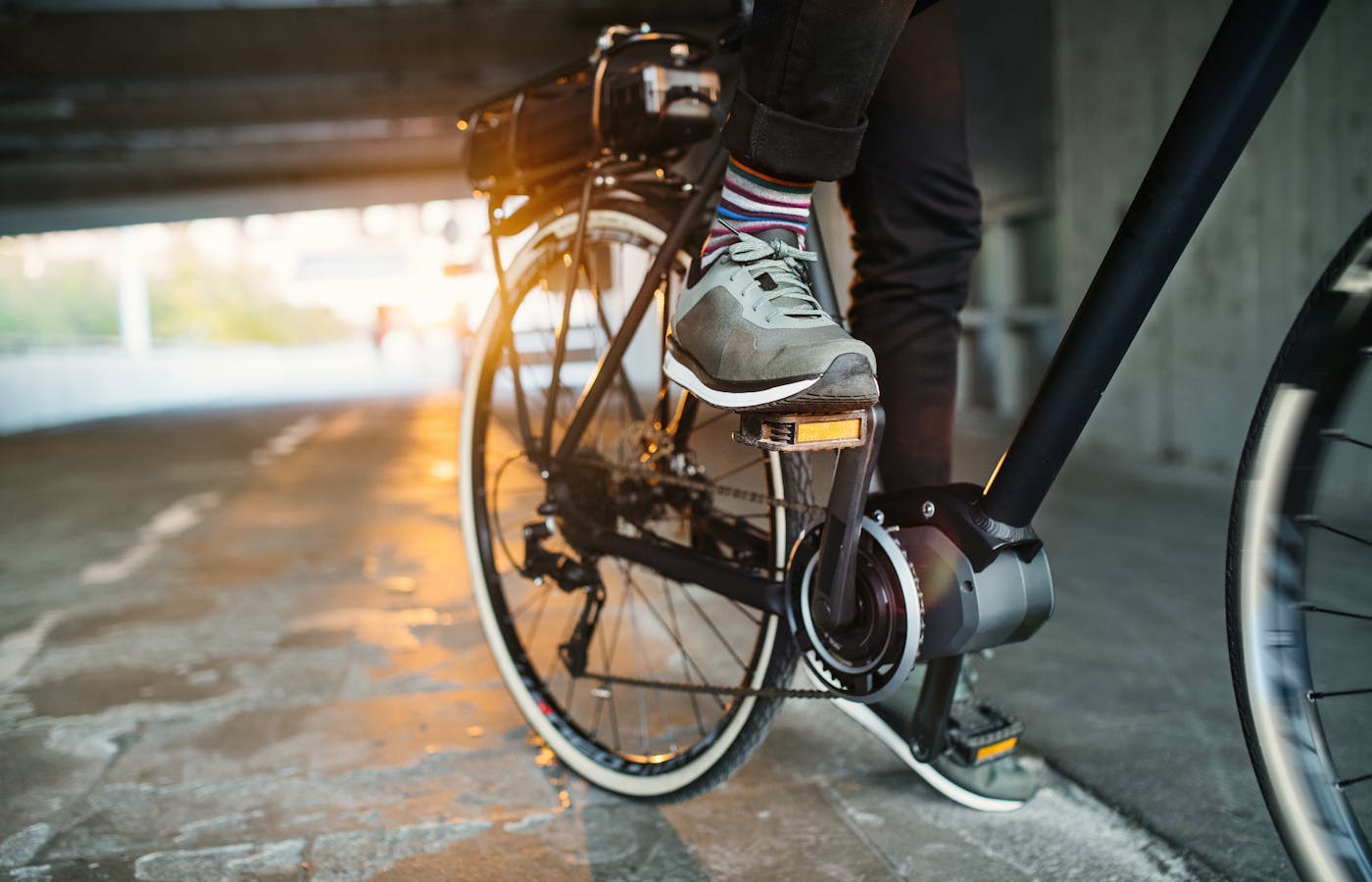
Advice from 2023’s Bike Advocate of the Year
October 13, 2023
There’s a lot to be learned from the state with some of the biggest bike policy wins of the year. We spoke with Dorian Grilley, BikeMN’s former executive director, to learn more.

There’s $1.86 Billion on the Table for Bikes
October 13, 2023
This November, five ballot measures are poised to significantly move the needle for bike infrastructure.
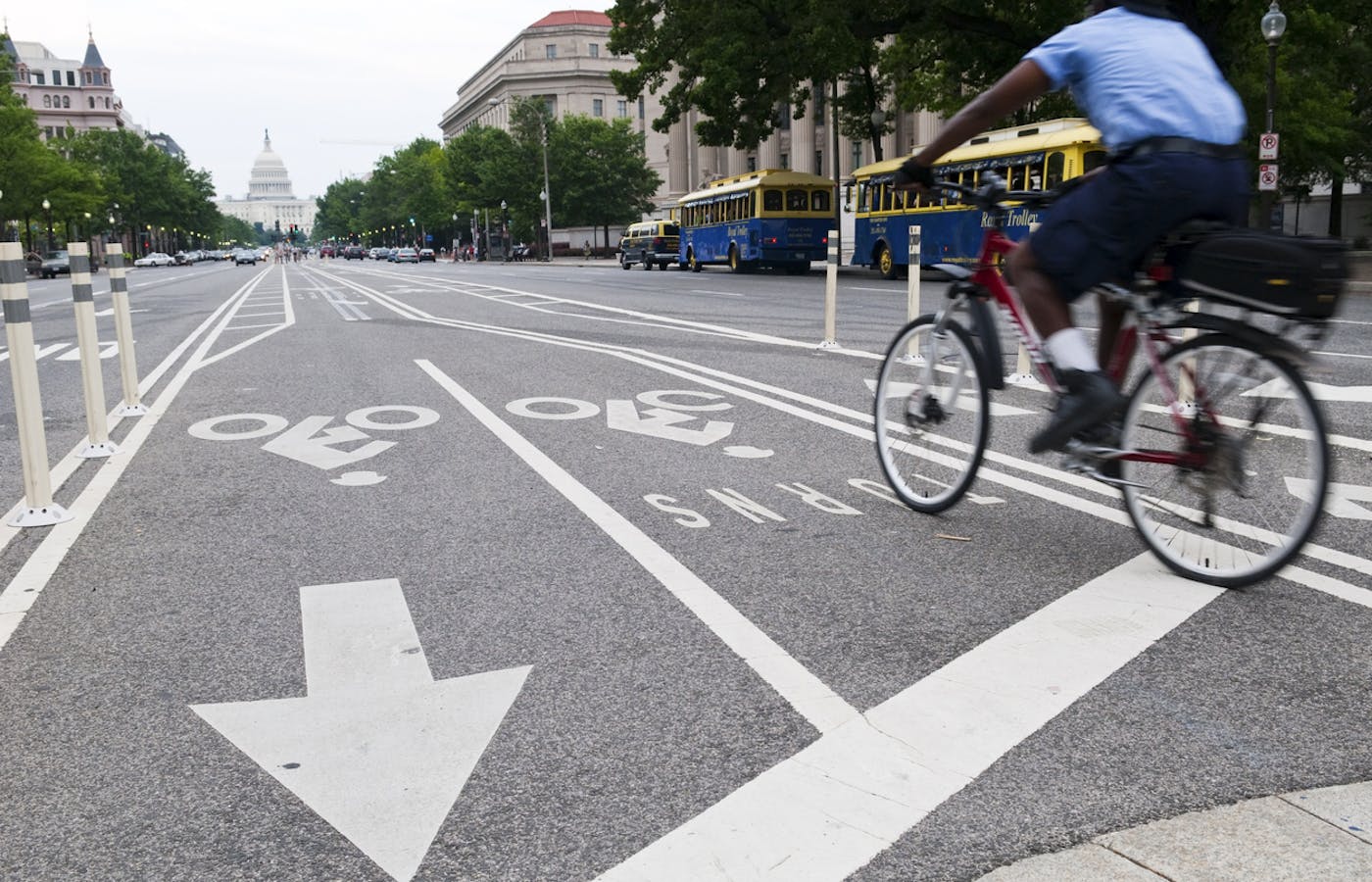
A Legislative Playbook to Build More Bikeable Communities
October 13, 2023
Designed to aid policymakers and advocates in expanding local bike infrastructure, this comprehensive guide outlines four highly effective legislative strategies.

Congressman Blumenauer Is Bicycling’s Biggest Advocate
October 5, 2023
We spoke with Rep. Earl Blumenauer (D-OR) about the push for safe infrastructure, federal bike policy, and the trend toward electrification.
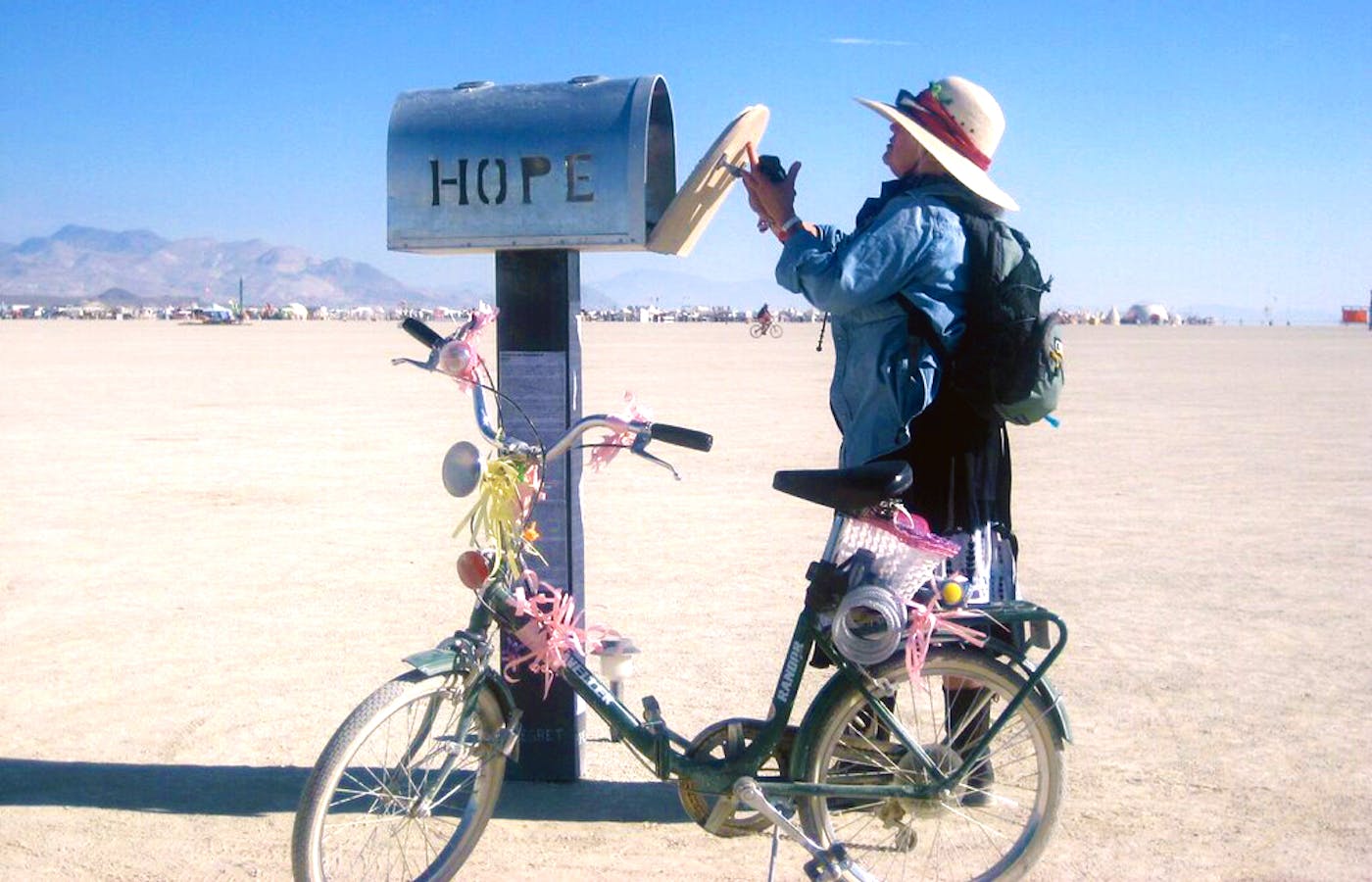
Nevada’s Annual Experiment in a Temporary, (Nearly) Car-Free City
September 22, 2023
Burning Man, the weeklong desert event focused on community, art, and self-reliance, shows a path toward gender equity in bicycling.
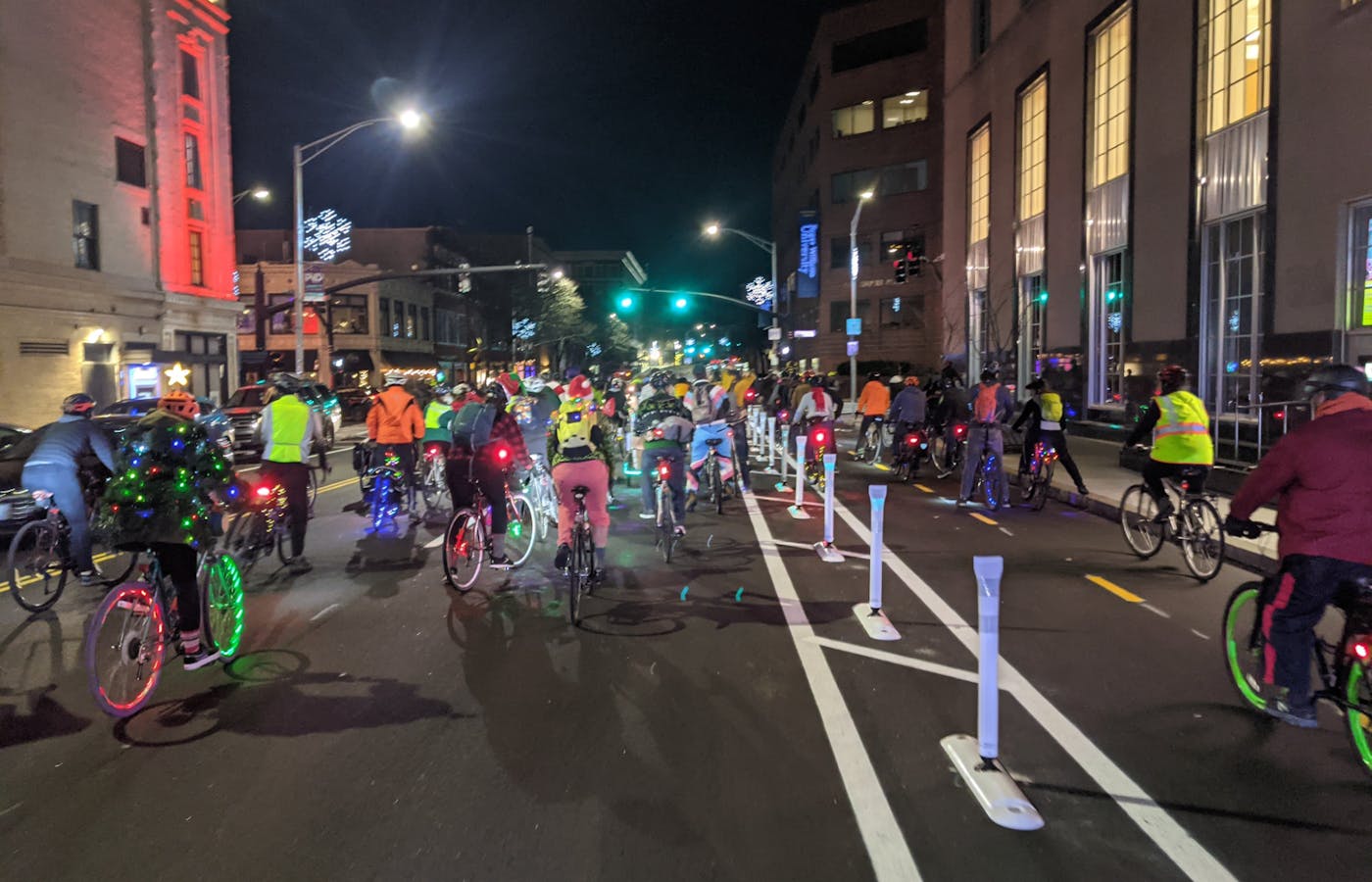
5 Ways to Boost Community Engagement in Bike Advocacy
September 20, 2023
These techniques will help you go beyond traditional engagement methods to reach a broader, more diverse audience.

Apply for a 2023 PeopleForBikes Industry Community Grant
September 11, 2023
Funded by the bike industry, these $5,000 to $10,000 grants support local infrastructure initiatives.
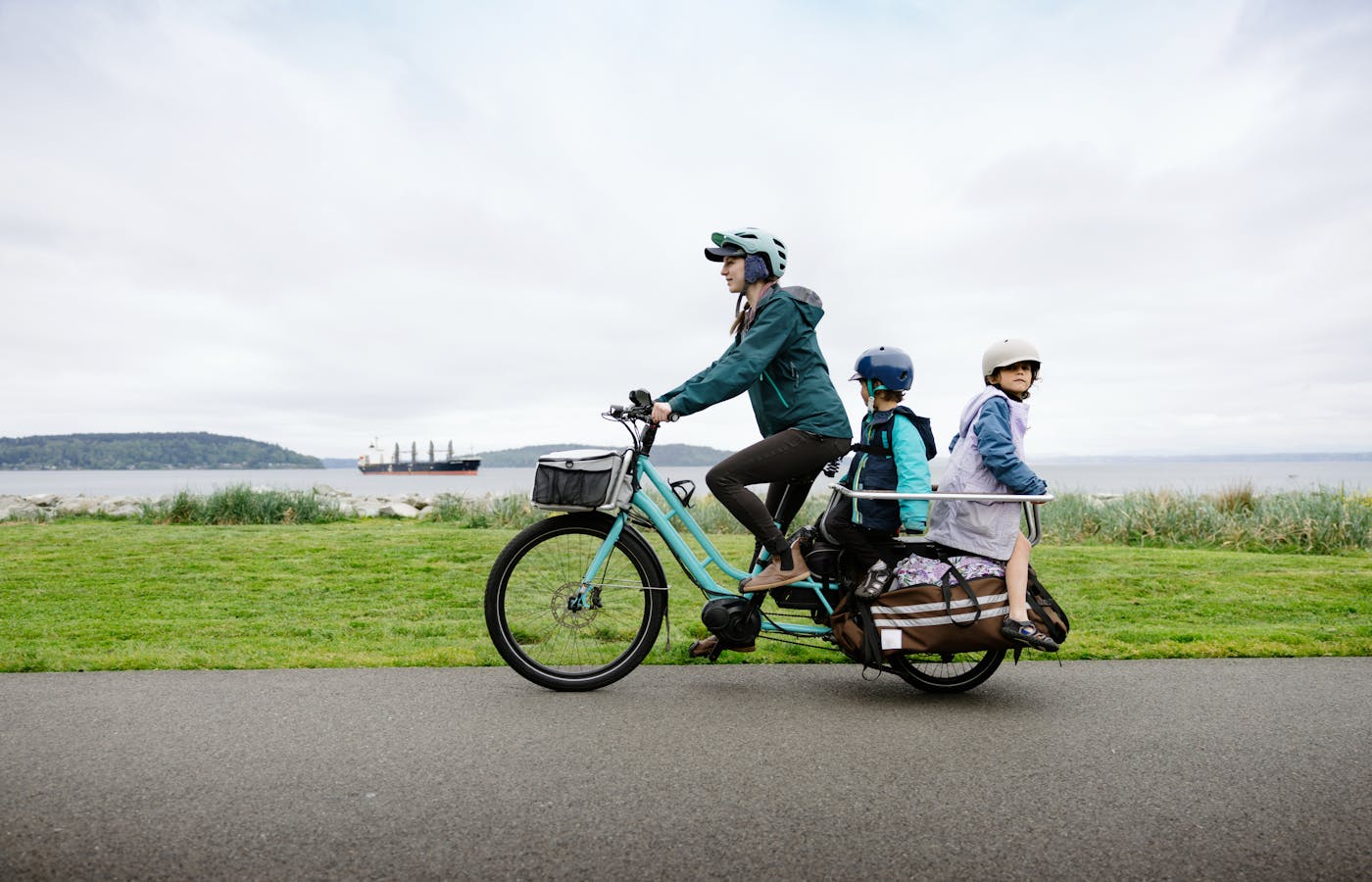
Introducing E-Bike Smart, a New Rider Education Program
August 30, 2023
PeopleForBikes, the League of American Bicyclists, and Bicycle Colorado came together to help riders of all experience levels learn more about safely riding electric bicycles.

The Evolving Landscape of Bicycle Regulations
August 14, 2023
PeopleForBikes is continuing our engagement with the CPSC on lithium battery safety, coaster brake requirements, and potential new bicycle and e-bike regulations.

Introducing PeopleForBikes’ New Electric Bicycle Policy Database
August 8, 2023
Land managers and recreation enthusiasts alike can now review and browse all known eMTB and e-bike policies throughout the U.S.

Learnings From the Inaugural Recreational Trails Workshop
August 8, 2023
By bringing together diverse groups of stakeholders, PeopleForBikes hopes to break down some of the silos that currently exist in the recreation space.

New Framework Aims to Conserve Our Public Lands
August 2, 2023
A newly proposed Public Lands Rule could help restore and protect 245 million acres across the country. PeopleForBikes weighs in on the proposal and what it could mean for recreationists.

There’s Already Record Funding For Bikes in 2023
August 1, 2023
More than $800 million in state and local funding is going to projects that directly support infrastructure, promote safety, and enhance recreational opportunities for bicycling.

How Minneapolis Became a Top U.S. Bike City
July 27, 2023
The Midwestern city prioritized bicycling by lowering speed limits, redesigning streets, and implementing an equitable, all ages and abilities network.

Introducing the Great Bike Infrastructure Project
July 26, 2023
PeopleForBikes launched a first-of-its-kind campaign to transform communities across the United States by advancing thousands of bike projects and policies.

Growing Female Ridership in West Virginia
July 25, 2023
Girls Riding Together (GRiT) gets more women on bikes, breaking down barriers in a male-dominated sport.

Legislative Bike Triumphs: A 2023 Mid-Year Review
July 21, 2023
In 2023, U.S. states have made big strides toward advancing safety, investing in infrastructure, combating climate change, and expanding access to outdoor recreation.
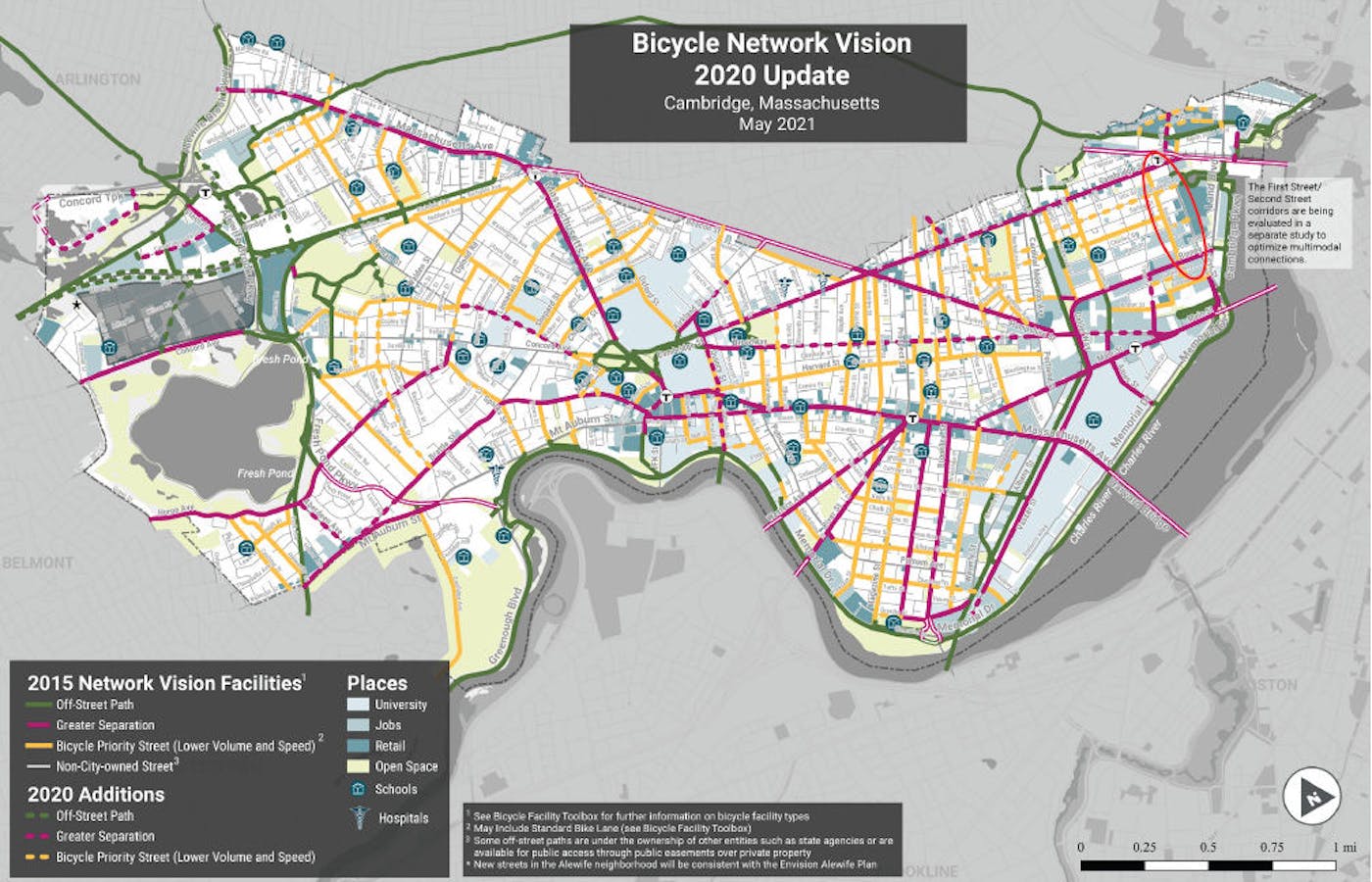
How Great Bike Plans Transform Communities
July 19, 2023
If you’re seeking inspiration to help guide your local bike planning process, here are nine cities with plans worth duplicating.
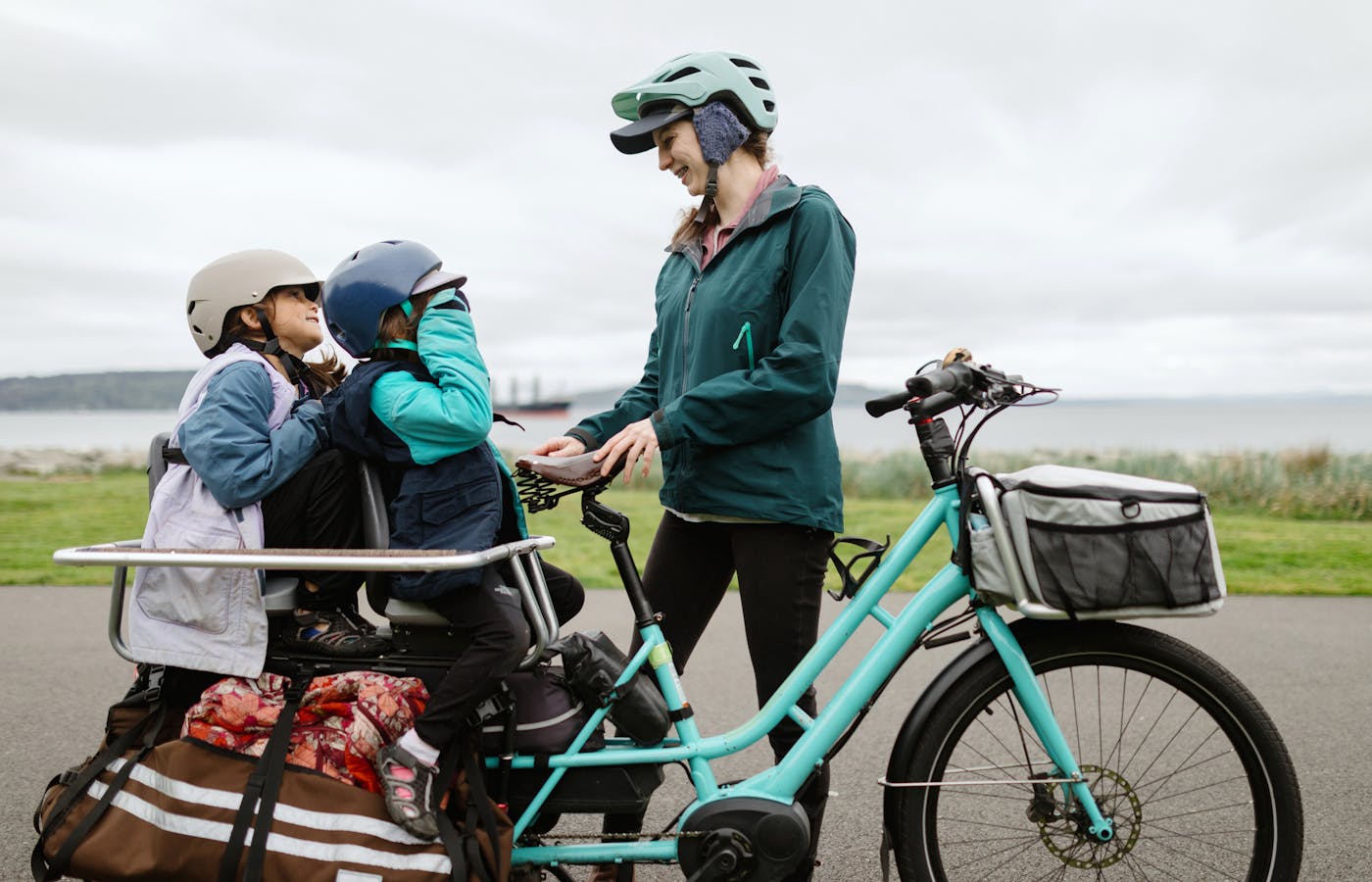
Five States Announce New E-Bike Incentive Programs
July 13, 2023
Colorado, Maine, Minnesota, Vermont, and Washington are the newest states to encourage e-bike adoption via rebates and tax credit initiatives.

55 New Schools Commit to Youth Cycling
July 3, 2023
Outride recently announced 55 new Riding For Focus programs, continuing efforts to empower youth and communities through bicycling and counteract a nationwide decline in youth ridership.

Federal Policy Moves for Safer Batteries and E-Bikes
June 27, 2023
The newly reintroduced Import Security and Fairness Act would be a big win for the government, the economy, and consumers alike.

2023’s Best Places to Bike
June 27, 2023
An overview of this year’s U.S. City Ratings data, including top performers, biggest improvements, and more.
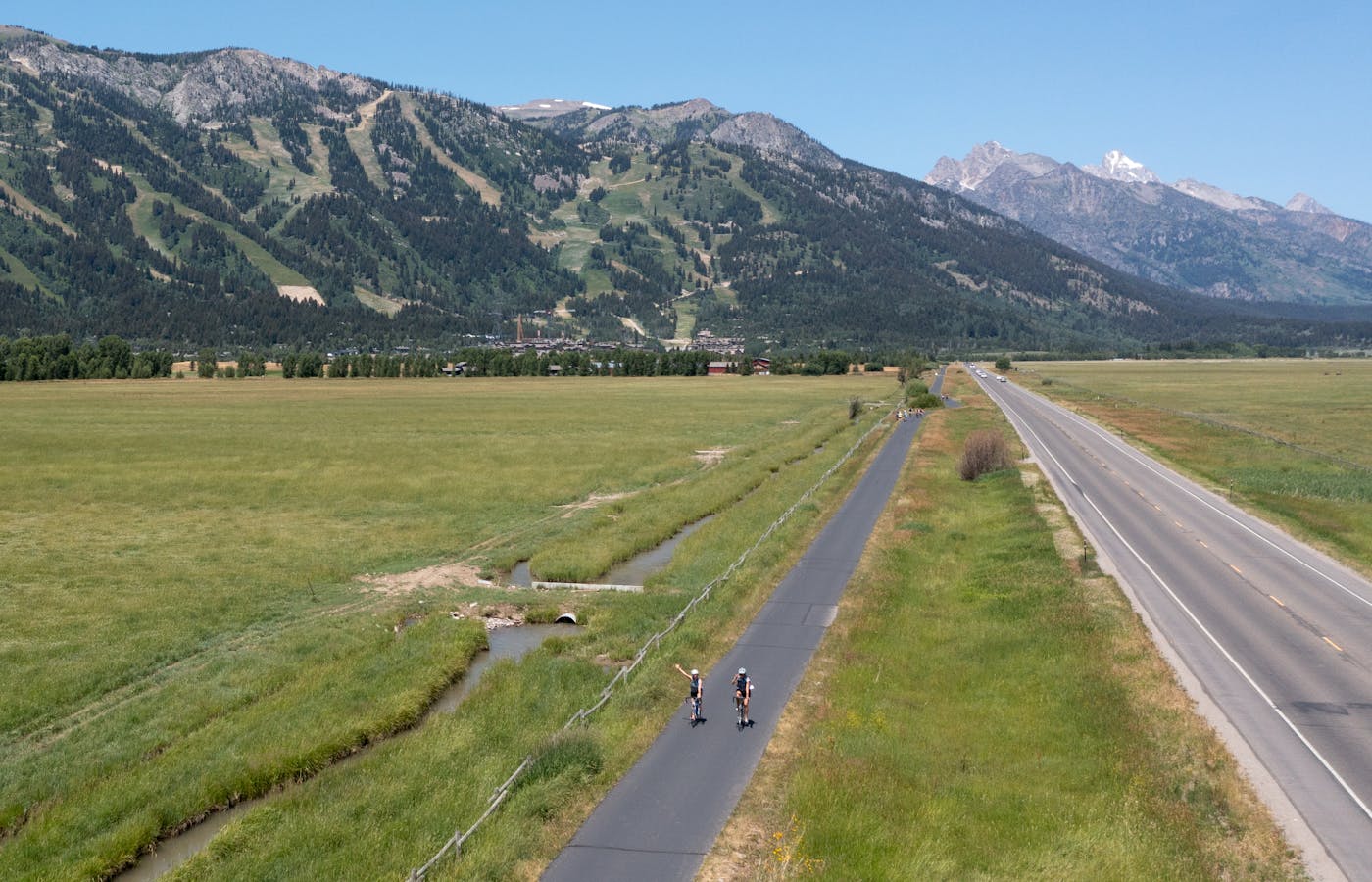
From Town to the Tetons, Jackson Is Best Seen By Bike
June 21, 2023
With 70 miles of pathways and 150 miles of trails, bicycling is helping to build community in this Wyoming mountain town.
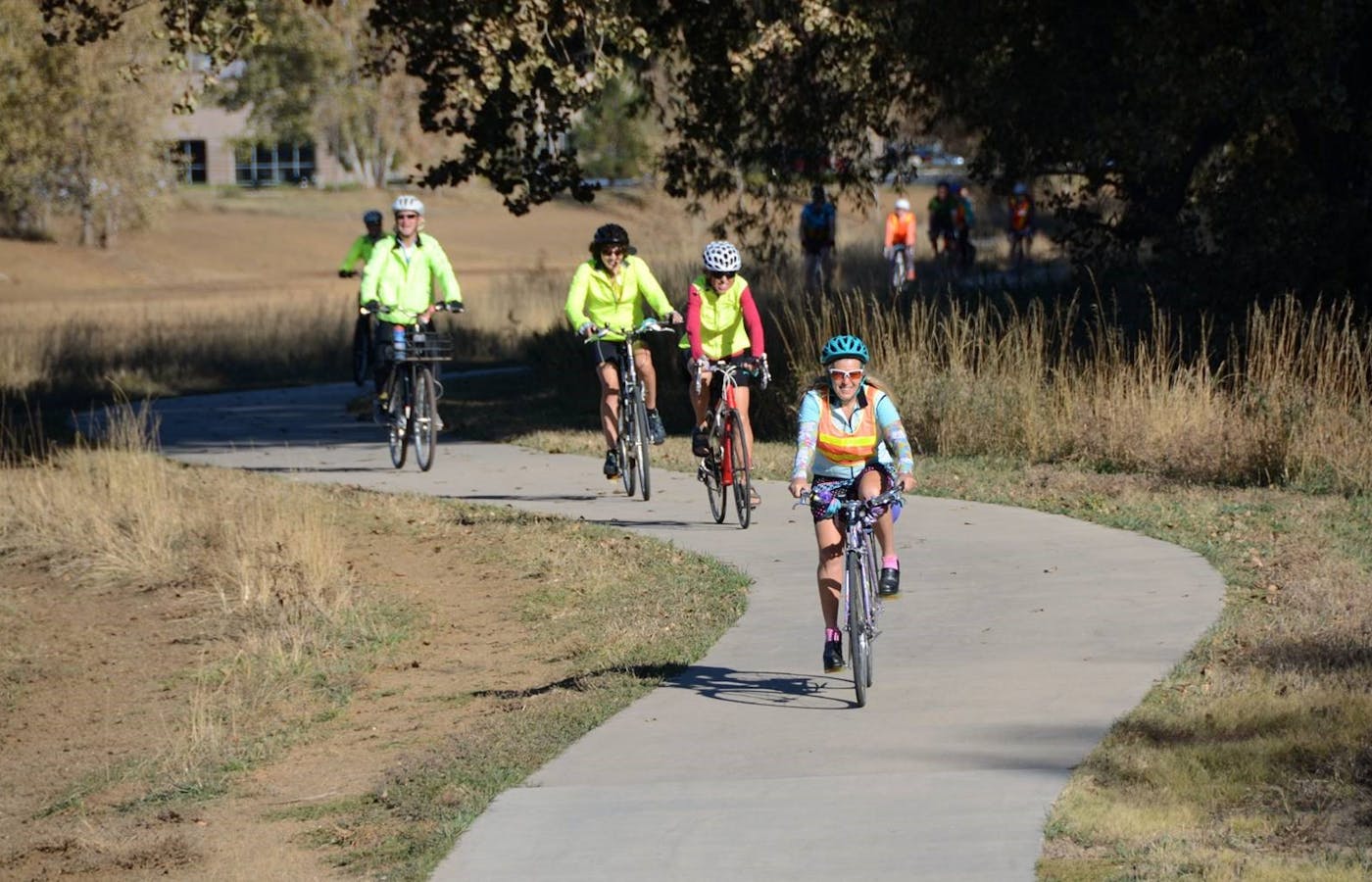
Longmont’s Multifaceted Approach to Better Bicycling
June 21, 2023
From eliminating parking minimums to mandating the inclusion of bike lanes in road improvement projects, biking is at the forefront of urban planning for this Colorado city.
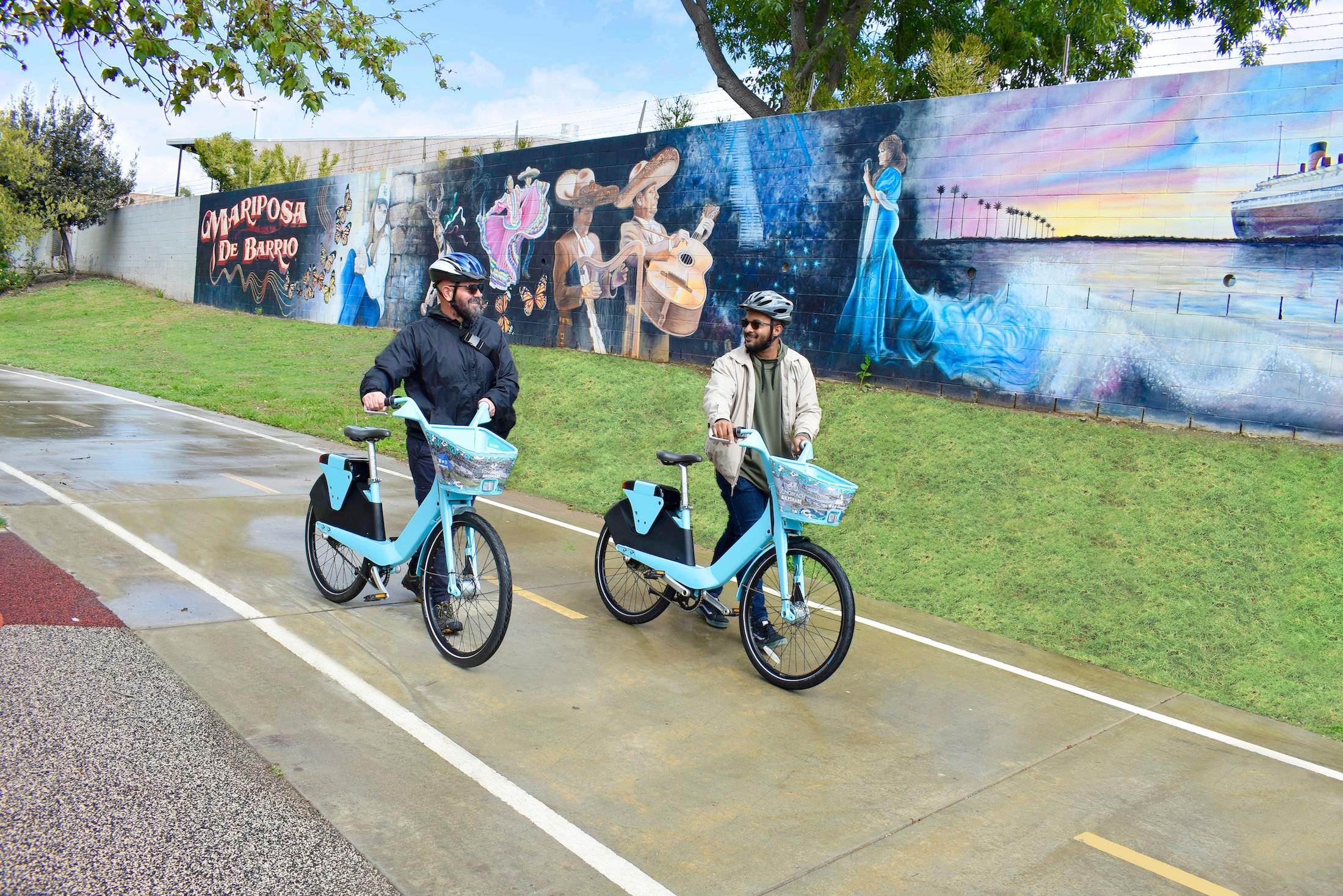
Bike Share Boosts Long Beach's Bikeability for All
June 21, 2023
The Southern California city has an ambitious plan to build a true 15-minute city, complete with protected bike facilities on every arterial and a bike share dock in every neighborhood.

PeopleForBikes Receives Grant to Keep Shared Micromobility Equitable
June 14, 2023
This is the fifth grant to support the work of the Better Bike Share Partnership since its inception in 2014.

What You Should Know About E-Bike Battery Certification
June 13, 2023
PeopleForBikes’ new Certification Terminology guidelines help manufacturers better understand the nuances associated with testing standards and what is currently required.
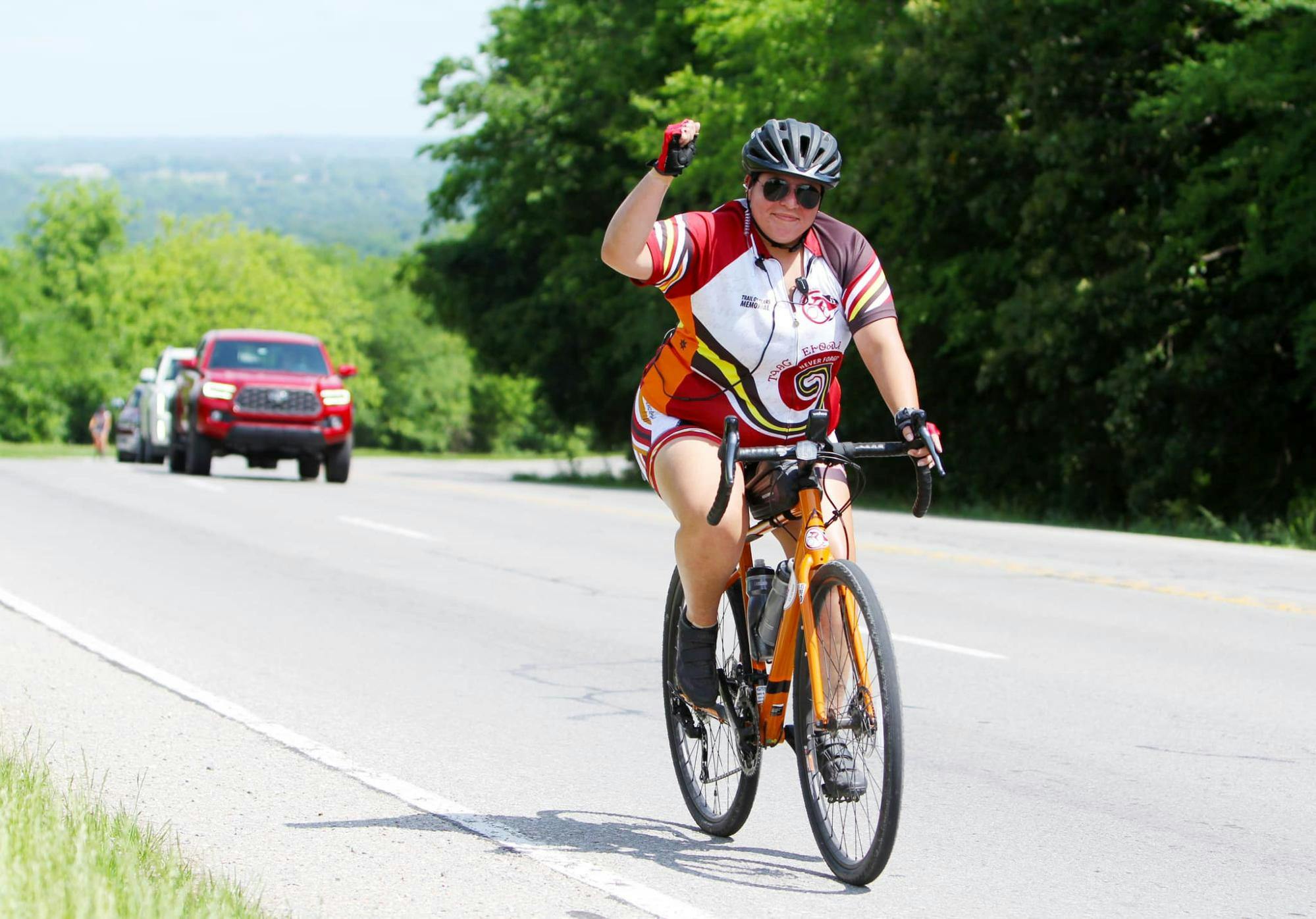
This Annual Bike Ride Connects Cherokee Youth to Their History
June 1, 2023
Every June, a cohort of bicyclists “Remember the Removal” by traveling nearly 1,000 miles from Georgia to Oklahoma, honoring their ancestors along the way.
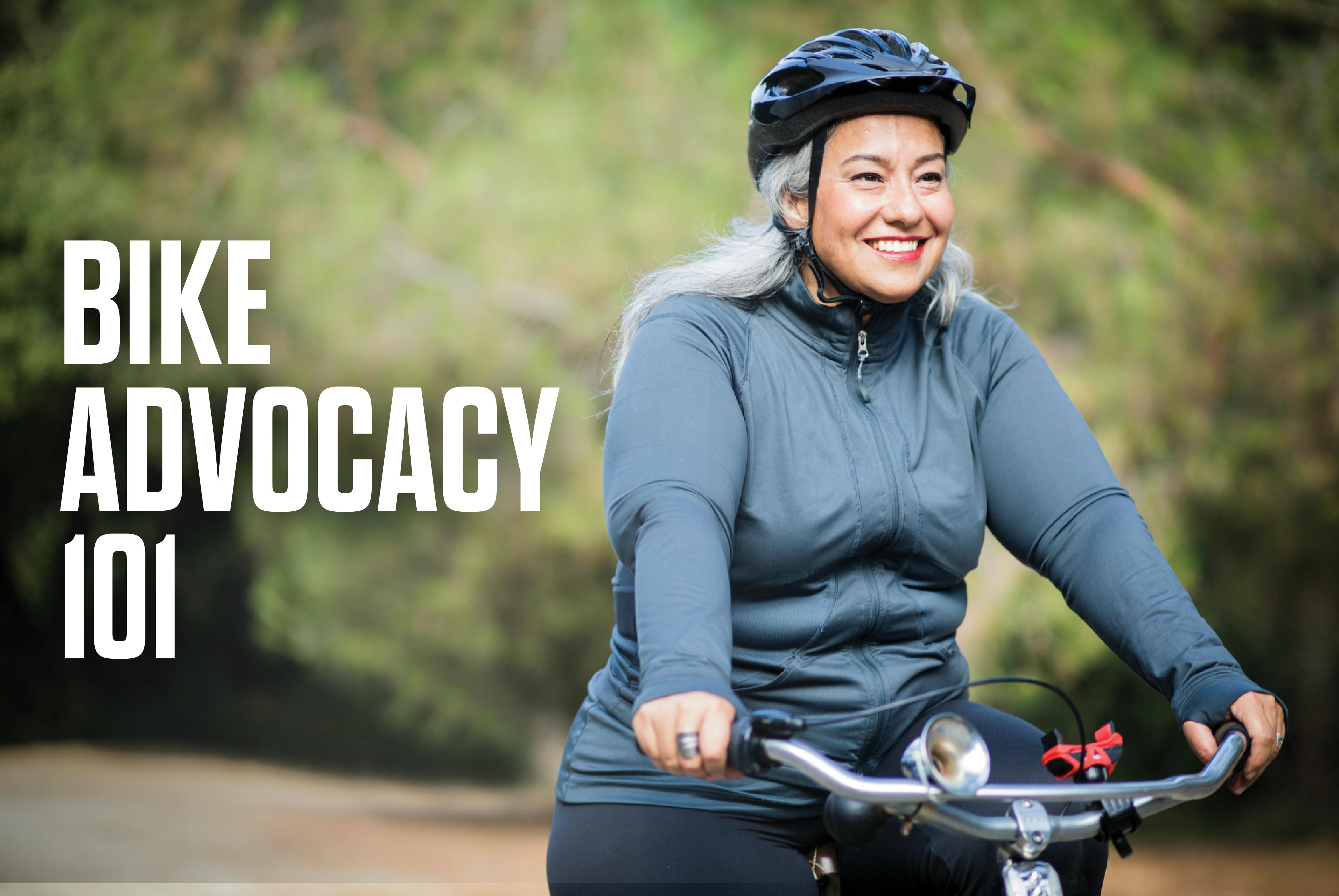
Your Bike Advocacy Playbook
May 23, 2023
Want to help make your city a better place to bike? We developed a 15-point, research-based fact sheet to help you push for change.
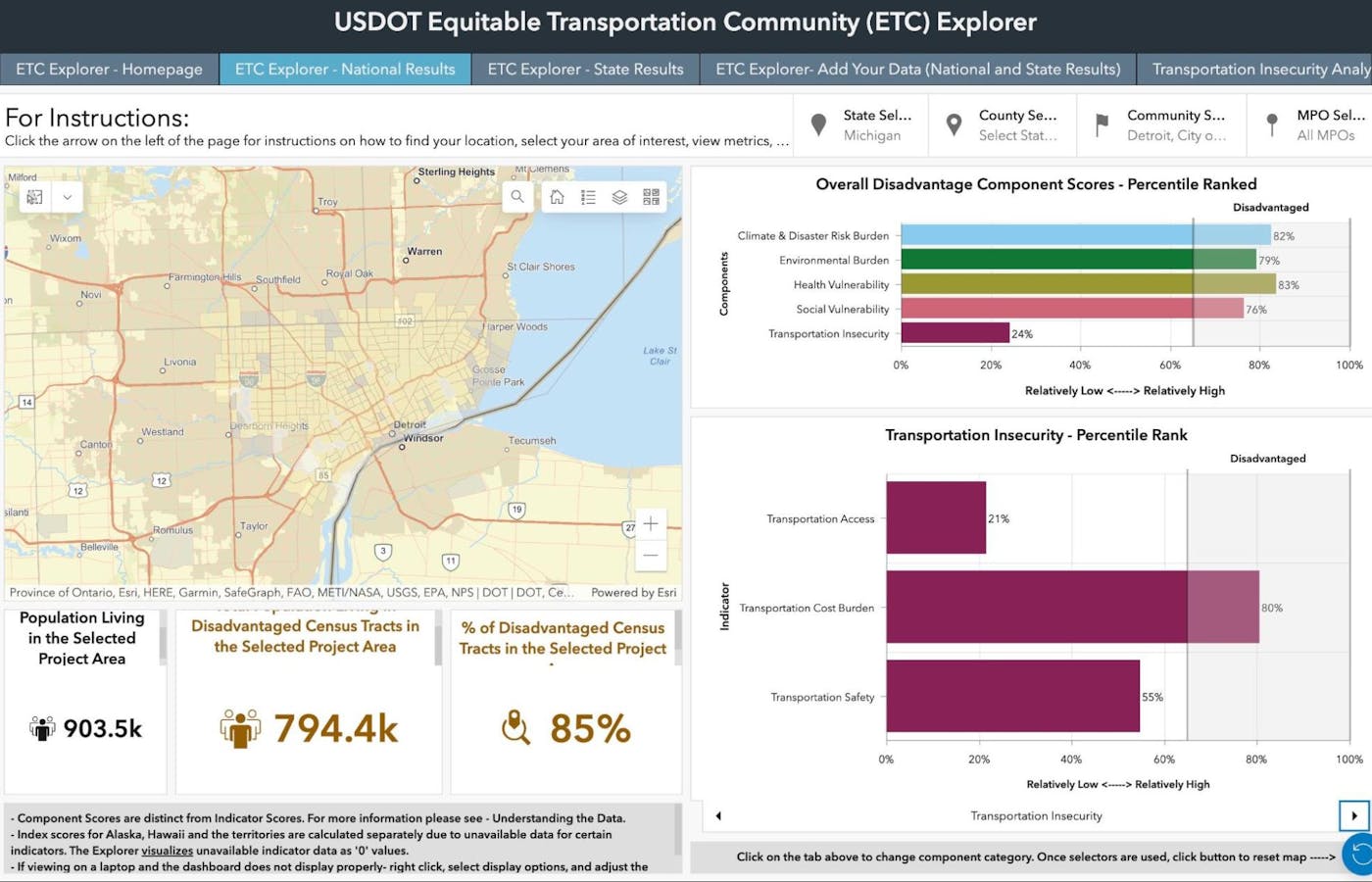
A New Tool for Equitable Bike Planning
May 22, 2023
The Equitable Transportation Community (ETC) Explorer helps cities identify where to prioritize investments in bicycling and walking infrastructure.

PeopleForBikes’ New E-Bike Incentive Design Tool
May 15, 2023
The new resource includes lessons, best practices, and sample legislation for bike advocates, industry members, and policymakers to create electric bicycle incentive programs.

West Virginia’s New Law Legalizes Class 2 E-Bike Access
May 12, 2023
Governor Jim Justice signed a bill into law establishing rules and regulations for electric bikes that more closely mimic federal law.

North Carolina’s Year of the Trail
May 3, 2023
A year-long marketing campaign aims to highlight the benefits of trails, garnering more support and funding in the process.

New Florida Bill Expands Access and Funding for Multi-Use Trails
May 2, 2023
Senate Bill 106 will expand access to Florida’s iconic Wildlife Corridor and fund the design, planning, and construction of trails connecting the Corridor to other trail networks.
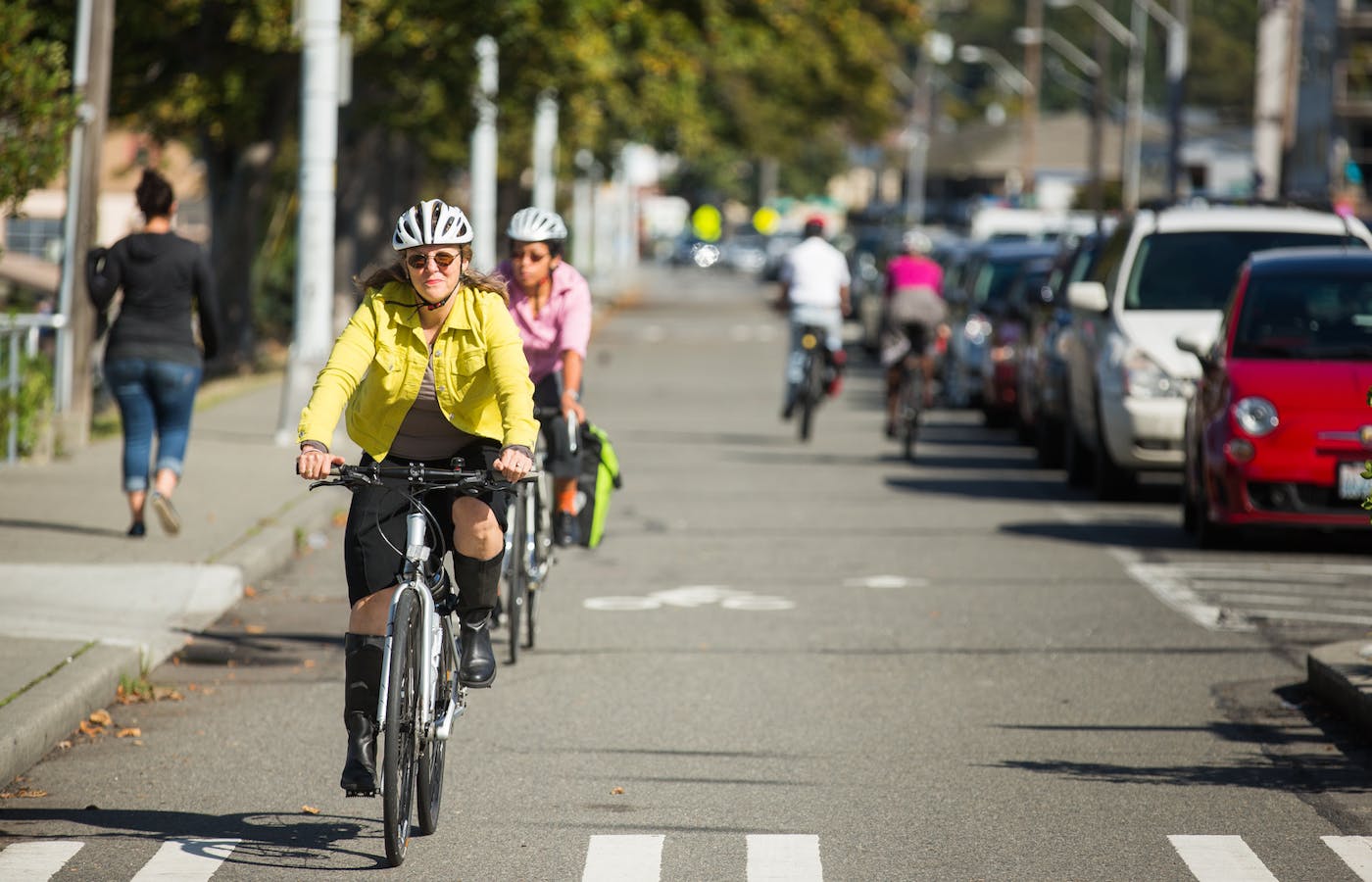
Bike-to-Work Week Isn’t Working
May 1, 2023
Want to build a lasting bike culture at your company? Follow these steps.

New Battery Safety Bills Land in Congress
April 24, 2023
The proposed legislation would direct the Consumer Product Safety Commission to regulate lithium ion batteries in mobility products.

Highlights from the California Trails and Greenways Conference
April 17, 2023
Nine high-level takeaways from this year’s conference, with an emphasis on how trails can be a multifunctional asset to communities nationwide.

New Research Shows Promising Future for eMTB Access
April 14, 2023
A first-of-its-kind Vermont study found that overall, electric mountain bike usage was perceived as more positive than negative.

Creating a Better World for Adaptive Cyclists
April 5, 2023
Washington’s AIROW Project shares challenges, opportunities, and successes as it works to make bicycling and the outdoors accessible for people of all abilities.

Senate Brings Back America’s Outdoor Recreation Act
April 4, 2023
The reintroduced package prioritizes recreation and mountain biking on public lands nationwide.

Barriers to Bike and E-Scooter Use in Black Communities
April 3, 2023
The recent Arrested Mobility report is the result of an investigative survey of bicycle, pedestrian, and e-scooter policies across all 50 U.S. states.

A Diplomat’s Tragic Death Sparks a New Safety Bill
March 30, 2023
The bipartisan Sarah Debbink Langenkamp Active Transportation Safety Act will encourage state and local governments to fully leverage federal funding for complete bike networks.

Offices of Outdoor Recreation Deliver Big
March 28, 2023
Eighteen states house OREC offices, which can help guide investments toward bicycle infrastructure, programming, and other pertinent resources.

Lessons From the First State Office of Outdoor Recreation
March 27, 2023
Founded in 2013, Utah's OREC (now Division of Outdoor Recreation) ensures every Utahn can live a healthy and active lifestyle through outdoor recreation and access to natural space.

How a Bike Bus Inspired a State Bill
March 23, 2023
In Portland, Oregon, a wildly successful bike bus not only inspired similar actions around the country but also forced state legislators to rethink school transportation funding.

Highlights from the 2023 Bicycle Leadership Conference
March 22, 2023
Couldn’t attend the 2023 BLC in March? Check out our recap video and action-oriented takeaways.

How to Use Ride Spot to Give Back
March 21, 2023
Last year, we began Ride Spot Gives Back to elevate marginalized voices, Here’s what’s to come in 2023.
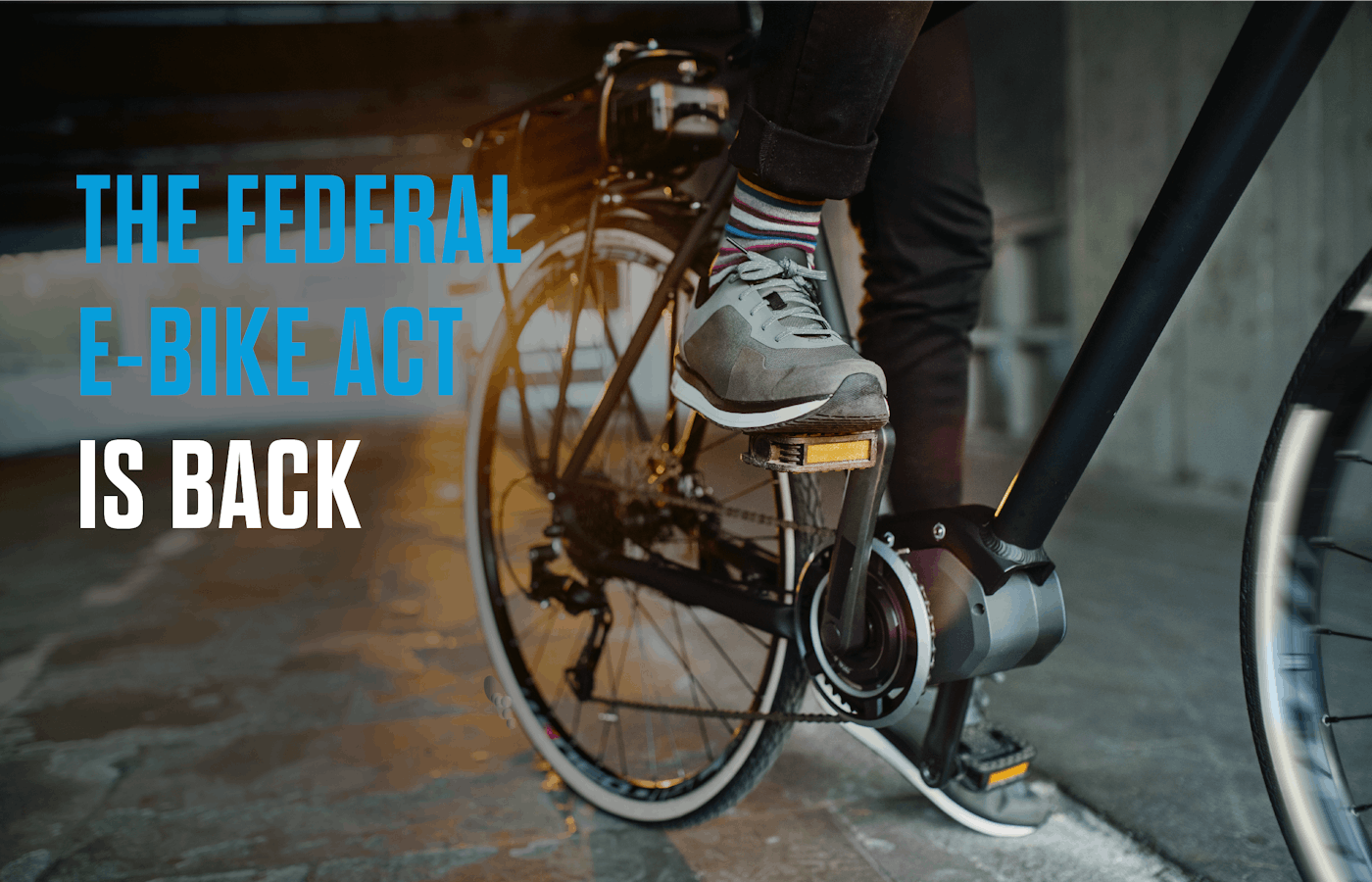
E-BIKE Act Makes a Comeback in Congress
March 21, 2023
Climate leaders reintroduced the E-BIKE Act in Congress, renewing the possibility of a federal tax credit for electric bicycles. ...

Bill for Long-Distance Bike Trails Introduced in Congress
March 3, 2023
The BOLT Act will help rural recreation economies plan for and meet the growing demand for bicycling as a low-cost, emissionless, and tourism-driving activity.

How to Build a Bike City: Lessons from CDMX
February 22, 2023
In the last four years, bicycling in Mexico City has transformed thanks to a connected network, dedicated infrastructure, and an emphasis on equitable mobility.

Two New Sustainability Benefits for PeopleForBikes Members
February 21, 2023
Introducing the industry’s first comprehensive Sustainable Packaging Guide and Chemicals Management Memo.

Help Get More Kids on Bikes
February 21, 2023
Applications are open for Outride’s 2023 Riding for Focus program, which provides middle school teachers with everything they need to get students bicycling.
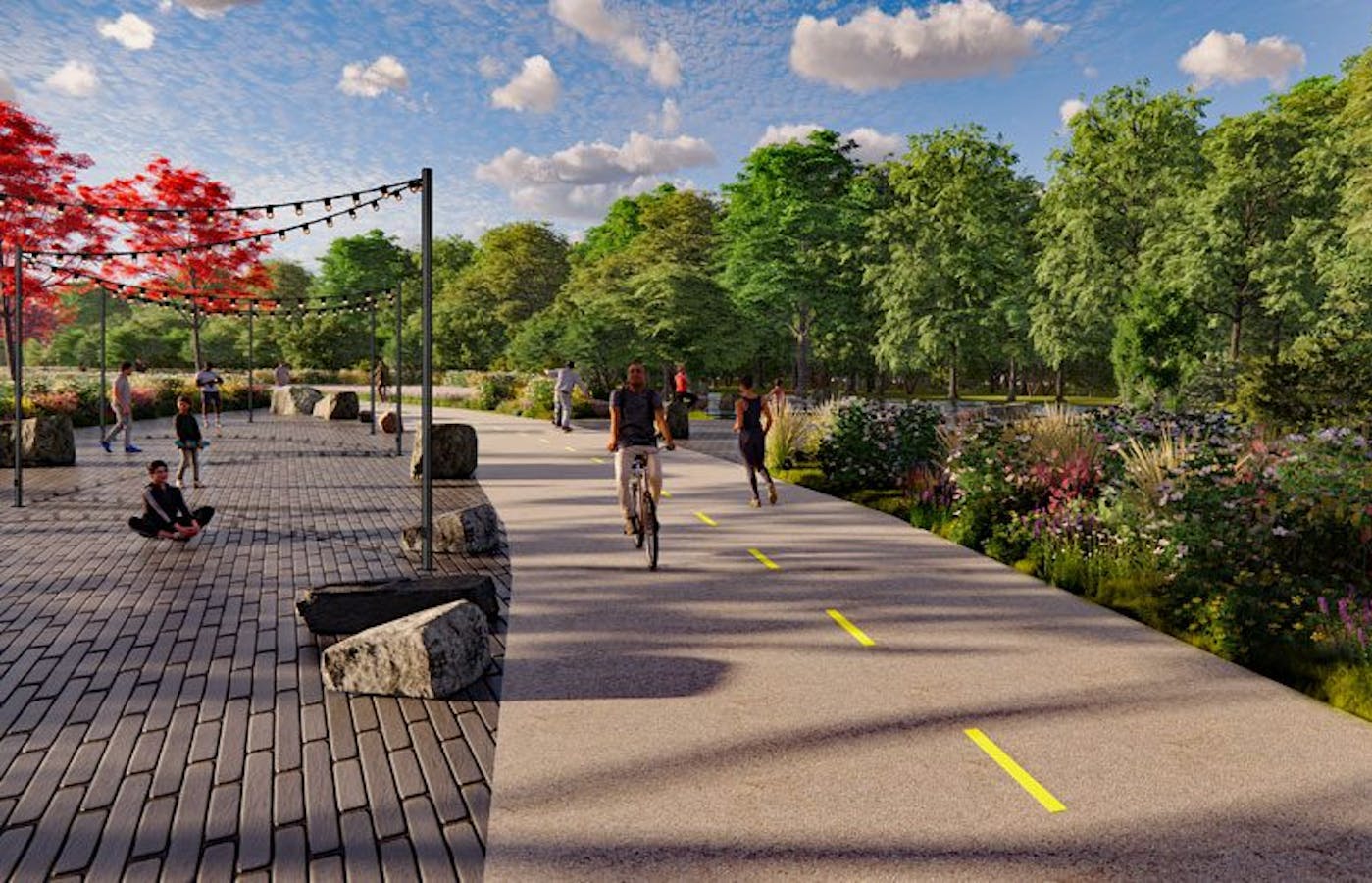
Billions of Dollars Are Available for Bike Projects
February 14, 2023
Between numerous federal programs, municipalities across the U.S. have unprecedented access to funding for safe, connected bike networks and trails.
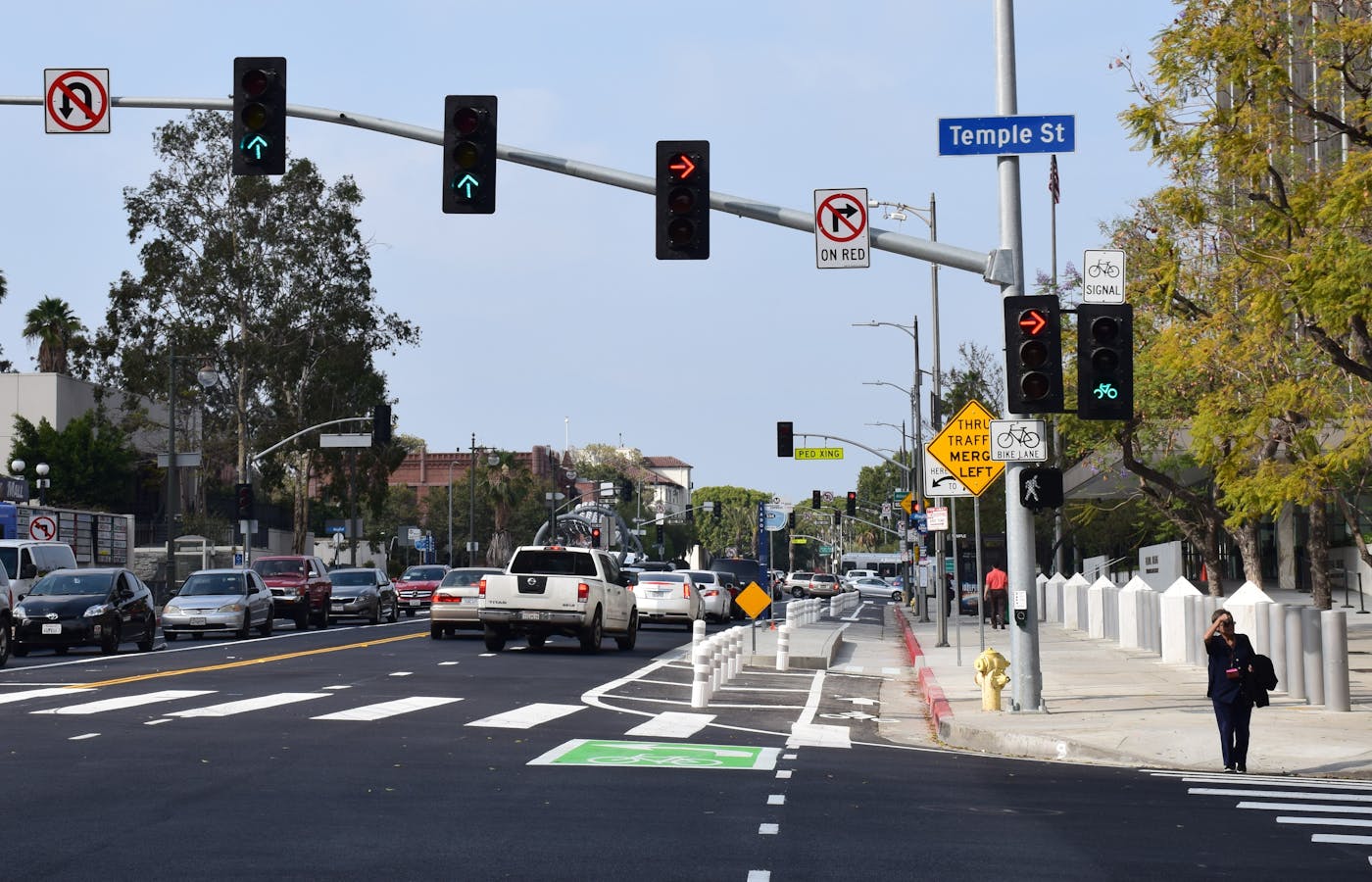
This Ground-Breaking Research Will Improve Intersection Safety
February 9, 2023
Diagnostics firm MicroTraffic released 10 design recommendations for reducing crashes where a protected bike lane approaches and crosses an intersection.

Why Become a PeopleForBikes Member?
February 8, 2023
Our mission is to help bike riders and bike businesses thrive, transforming the U.S. into the best bicycling nation in the world.
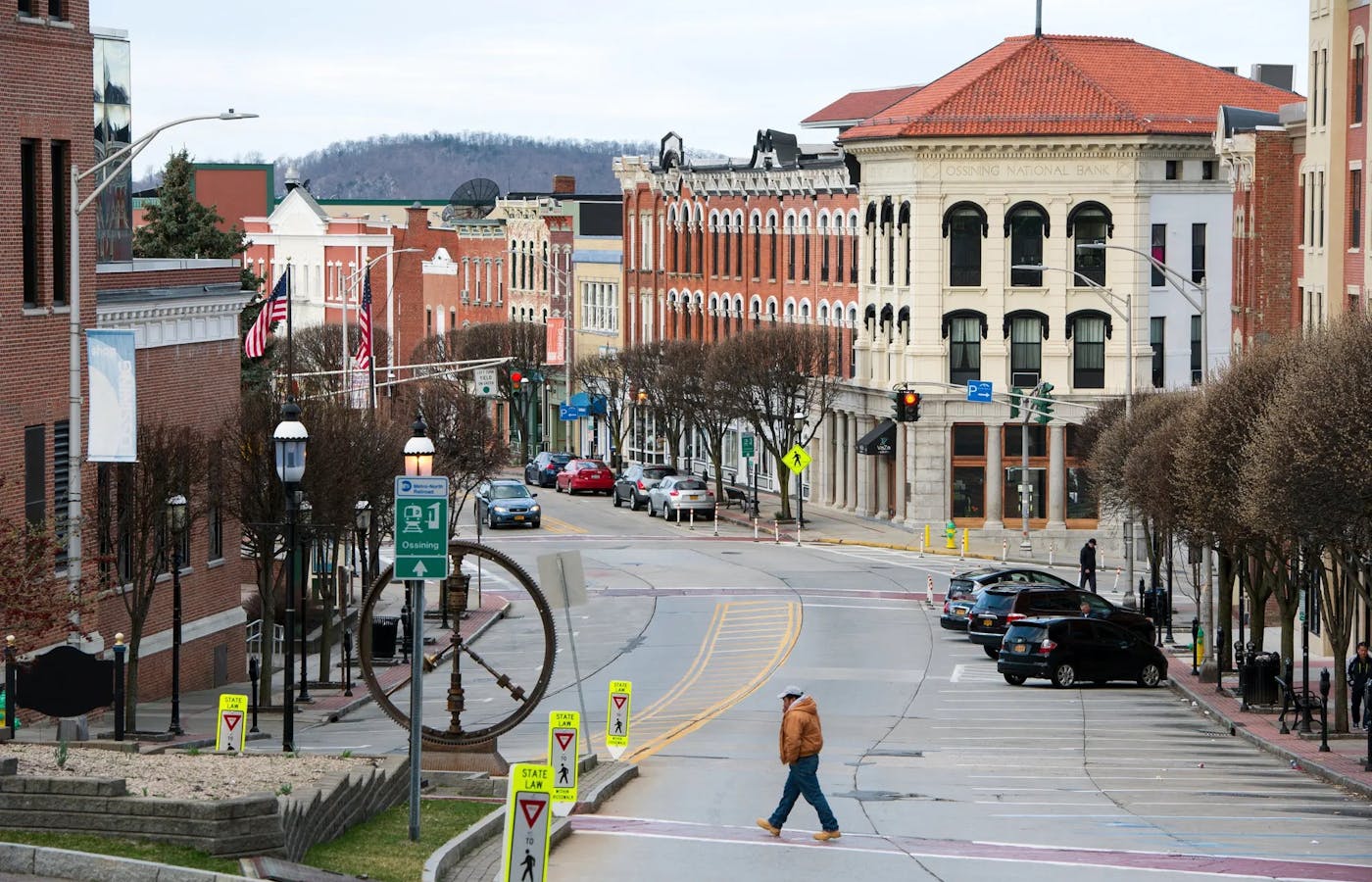
Electric Bicycles Meet Equity in Upstate New York
January 30, 2023
In the Village of Ossining, e-bikes are being deployed to create a barrier-free network that includes bike share, lending libraries, and a lease-to-own scheme.
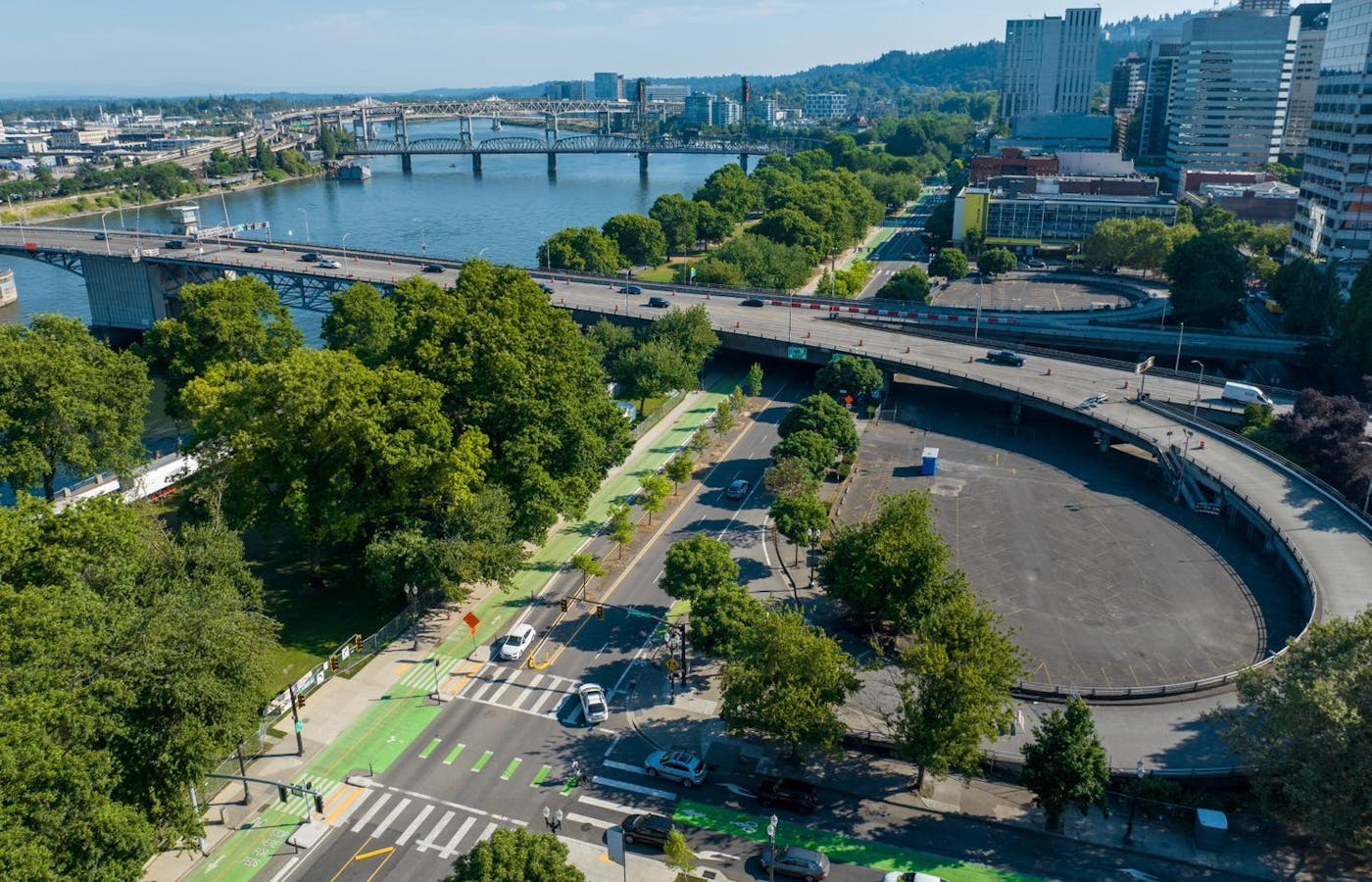
The Best New U.S. Bike Lanes
January 27, 2023
Cities from coast to coast stepped up to build world-class protected bicycle infrastructure in 2022.

Great Smoky Mountains National Park Announces Finding of No Significant Impact for New Trail System
January 26, 2023
The proposed trail system will feature 11.8 miles of bicycle-optimized mountain bike trails in the Wears Valley area of the national park.

Exciting New Mountain Biking Trails Opened in 2022
January 21, 2023
Spanning from Colorado to Vermont, PeopleForBikes compiled some of the best new trails to explore in the new year.

Pennsylvania DCNR Finalizes E-Bike Policy for State Parks and Forests
January 20, 2023
Electric bicycles will officially be allowed on trails already open to traditional bicycle usage on PA DCNR-managed lands.
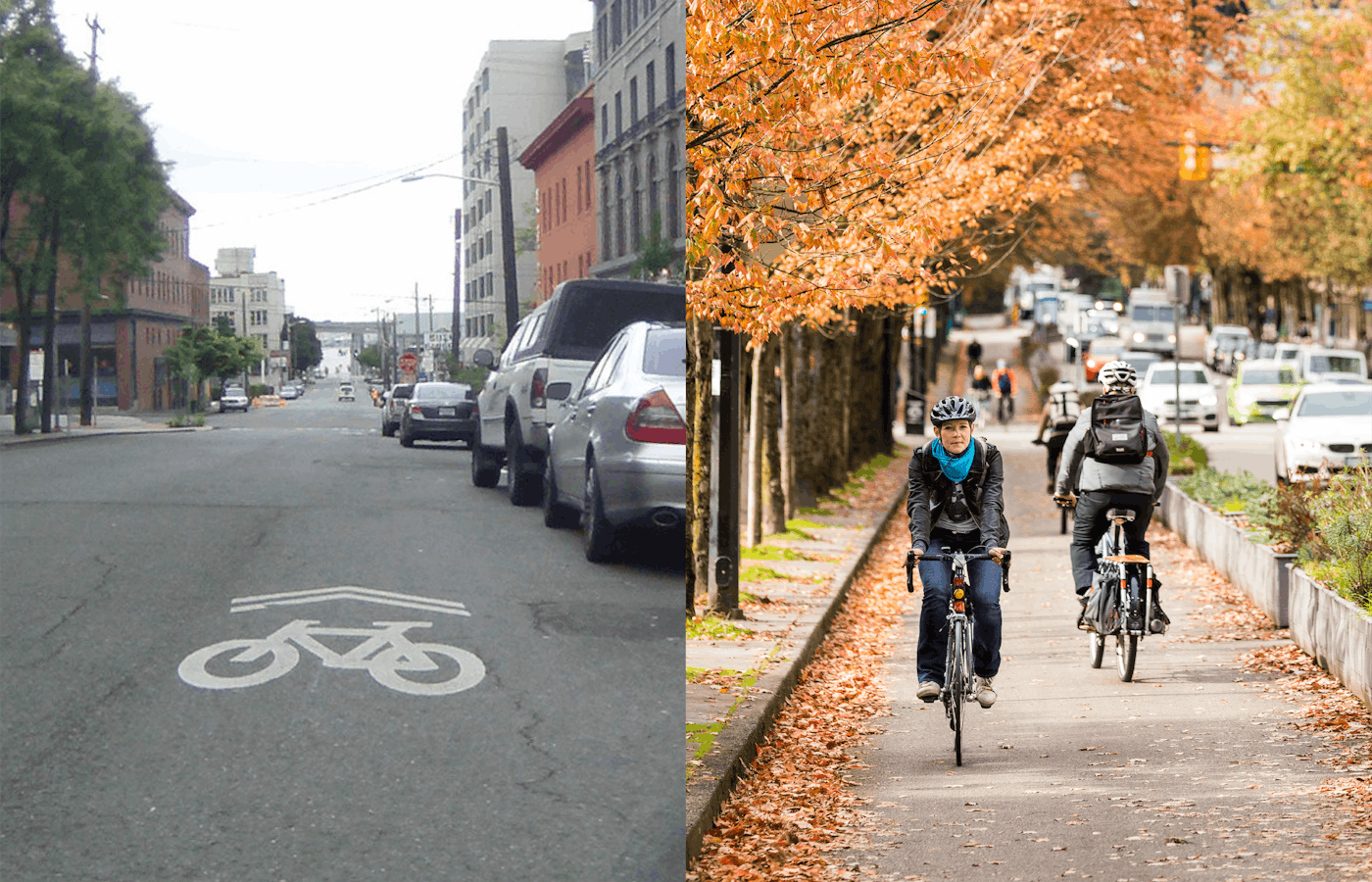
We Were Wrong About Sharrows
January 19, 2023
The former executive director of the California Bicycle Coalition was a key player in the proliferation of shared lane markings. Twenty years later, he’s disillusioned with them.

PeopleForBikes Has a New, Data-Driven Podcast
January 18, 2023
“Inside the Outdoors” is a collaboration between Patrick Hogan, PeopleForBikes’ senior research manager, and Kelly Davis, research director at the Outdoor Industry Association.

2023 Outride Fund Applications Are Open
January 17, 2023
The youth bicycling organization is ditching its community match requirement and putting a renewed emphasis on improving social, emotional, and cognitive health.

A Bicycle Garden Grows in Michigan
January 13, 2023
In Flint, a neighborhood association transformed an unused urban tennis court into a space where local youth can learn to bike.

How PeopleForBikes Encourages Staff to Ride More
January 10, 2023
Last year, we debuted our “Bike Perks” program, which pays employees to get out and ride.

Leveraging Federal Infrastructure Funding for Bikes in 2023
January 9, 2023
Check out our recap of what happened in 2022 and what to expect in the new year.

PeopleForBikes' 2022 Must-Reads
January 3, 2023
In case you missed them, here are 10 of our most important stories from last year.

U.S. Bicycle Industry to Save Additional $100 Million in Extended Tariff Exclusions
December 19, 2022
The United States Trade Representative recently announced extensions to 352 Section 301 tariffs, covering U.S. bicycle industry products worth more than $370 million in annual import value.
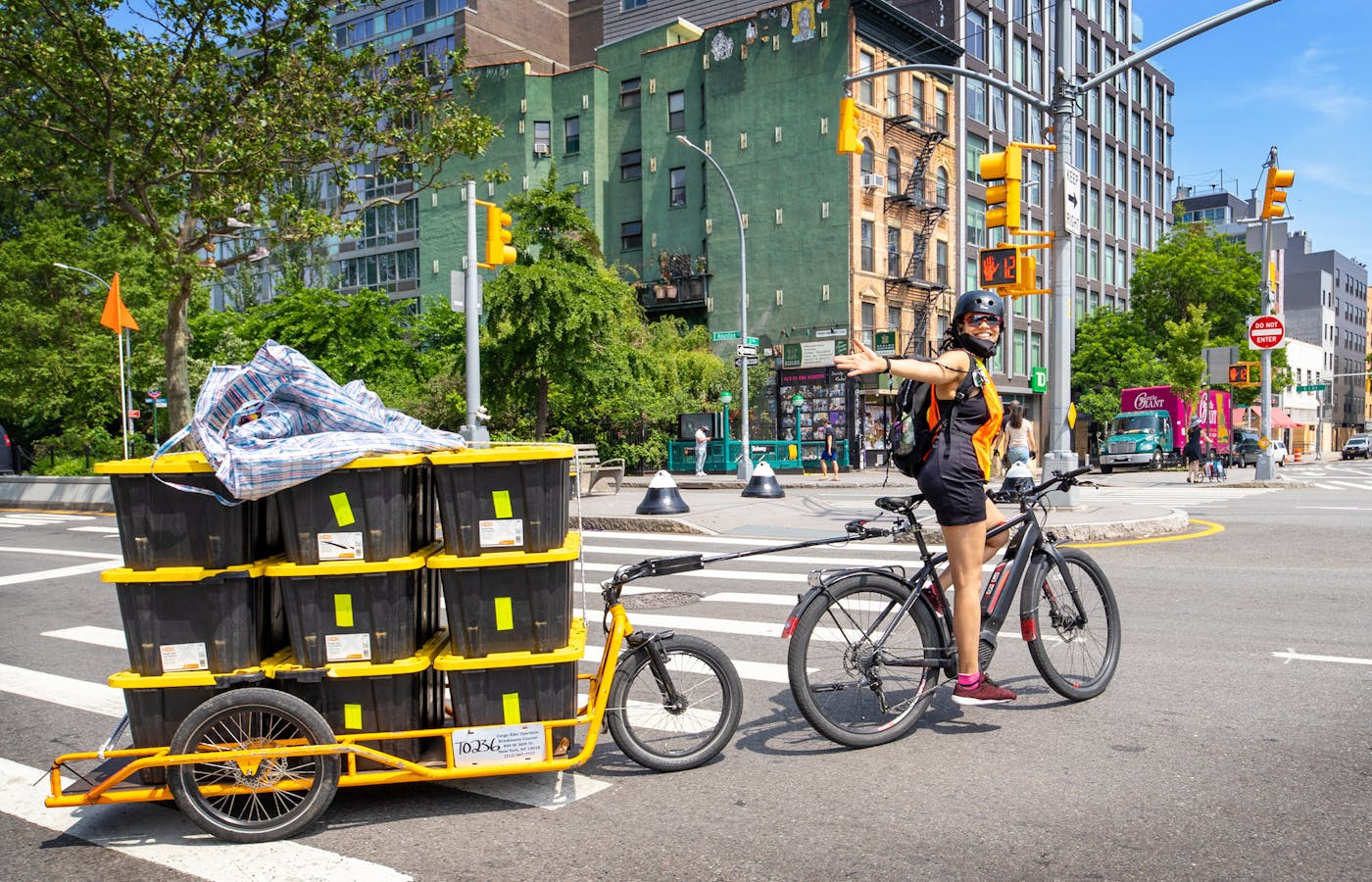
Electric Cargo Bikes Deliver Big
December 15, 2022
Governments, corporations, and nonprofits alike are betting on a cheaper, greener, and more efficient way to transport goods.

Takeaways From the PeopleForBikes Coalition Board Meeting
December 14, 2022
The PFB Board met on December 14 to welcome new members and discuss infrastructure, data, and participation goals for 2023.

PeopleForBikes Announces 2022 Industry Community Grant Recipients
December 14, 2022
The 11 projects funded in 2022 will support bicycle infrastructure and advocacy projects across the U.S.

Building Inclusive Bicycling at School and Beyond
December 13, 2022
In Oklahoma, Bike Club Tulsa is creating a bicycle ecosystem, complete with adaptive cycling, educational opportunities, community repairs, and safer places to ride.
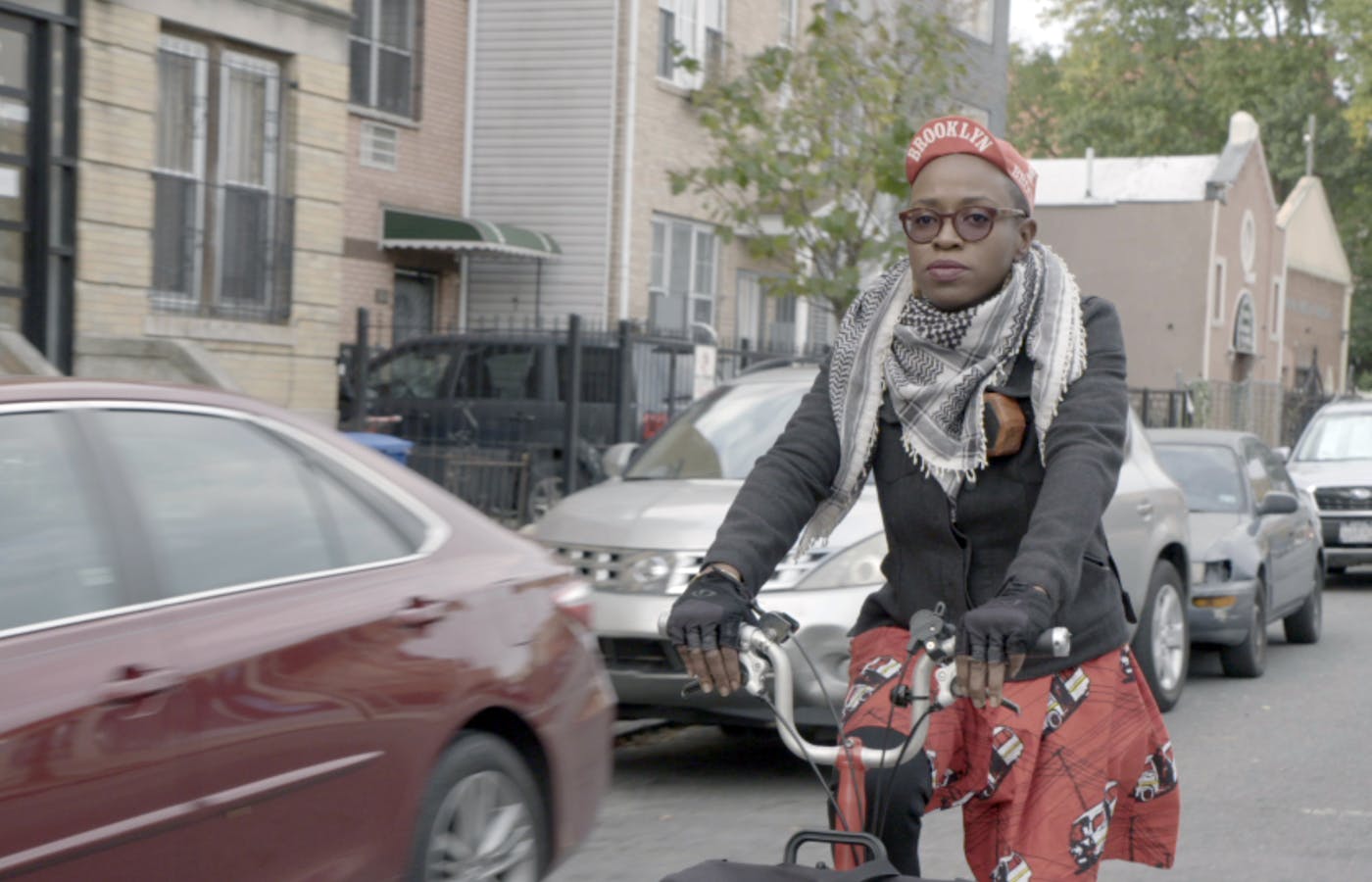
Fighting to Make Our Streets Safer
December 12, 2022
"The Street Project," a new documentary, tells of the global, citizen-led fight to reclaim our neighborhoods, combat preventable deaths, and get new infrastructure on the ground.

2022’s Biggest State Policy Wins
December 7, 2022
After a year’s worth of policy tracking and engagement, we’ve identified six state-level policy gains worth celebrating.

Our Top Lessons Learned From SHIFT‘22
December 6, 2022
Unable to attend the inaugural conference in Northwest Arkansas this October? Check out our recap of actionable takeaways from each of our three education pillars.

Gravel Biking Is Transforming Small Town America
November 28, 2022
Small towns offer many benefits for gravel biking and racing, but the fastest-growing sector of the bike world also has reciprocal positive effects on the communities.

Low Cost Ways to Improve Bike Culture at Work
November 22, 2022
Curated from 650 individual survey responses, these tips can help promote a pro-bike culture at any workplace.

Voters Approve $725 Million in Recreation Infrastructure Funds
November 18, 2022
On November 8, recreational bicycling won big, with several notable measures passing at the local level.
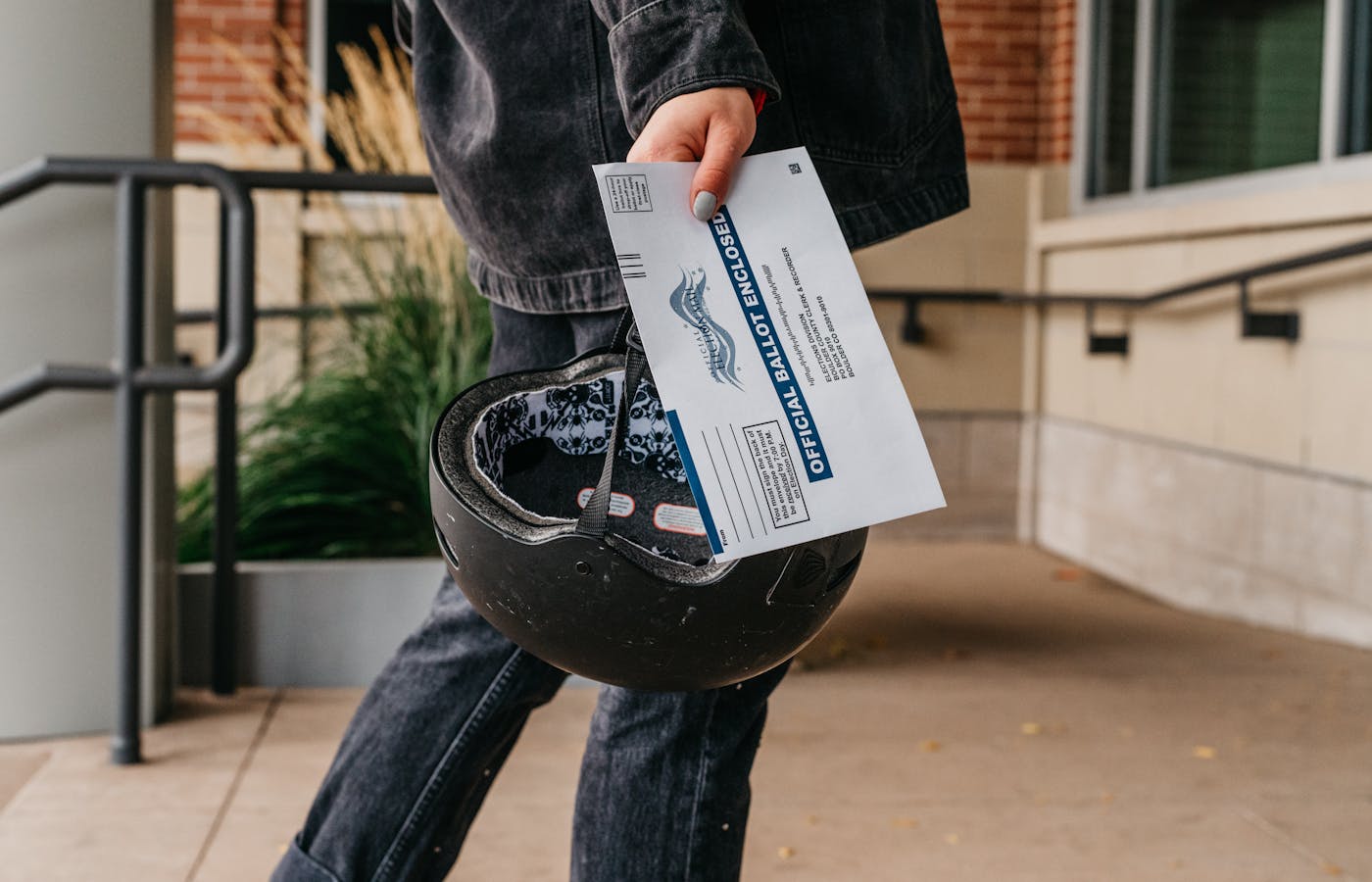
Bikes Win Big at the Polls
November 17, 2022
This past election, voters approved nearly $3.6 billion dollars across the country for new and improved bicycling infrastructure.
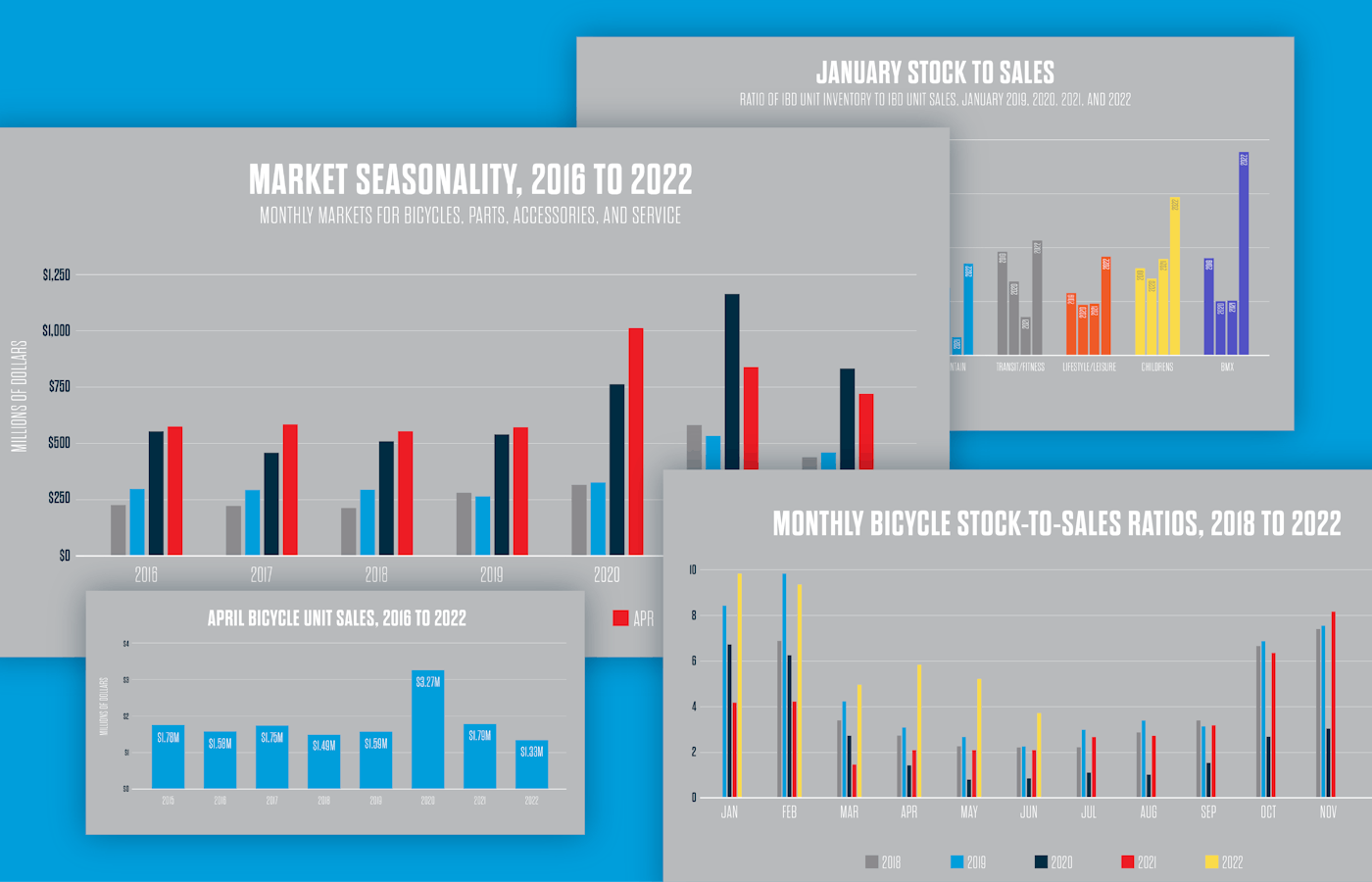
A Data-Driven Bike Industry, Powered by PeopleForBikes
November 15, 2022
With a significant investment approved to expand our research and statistics program, PeopleForBikes is working to create a more comprehensive view of bicycling in the U.S.

What Are the Biggest Challenges Facing Electric Bicycles?
November 15, 2022
Members of PeopleForBikes’ Electric Bicycle and Legal, Legislative, and Safety subcommittees met to discuss priorities and strategies for electric bicycles over the next five years.

Bureau of Economic Analysis Estimates Increases in GDP for Bicycling in the U.S.
November 15, 2022
While the measure of GDP only tells a small portion of bicycling’s overall contribution to the U.S. economy, the takeaways are still impactful.

A Recap of the 2022 Outride Summit
November 10, 2022
The annual gathering, which took place from October 25-26, focused on how to change the lives of youth and communities through bicycling.
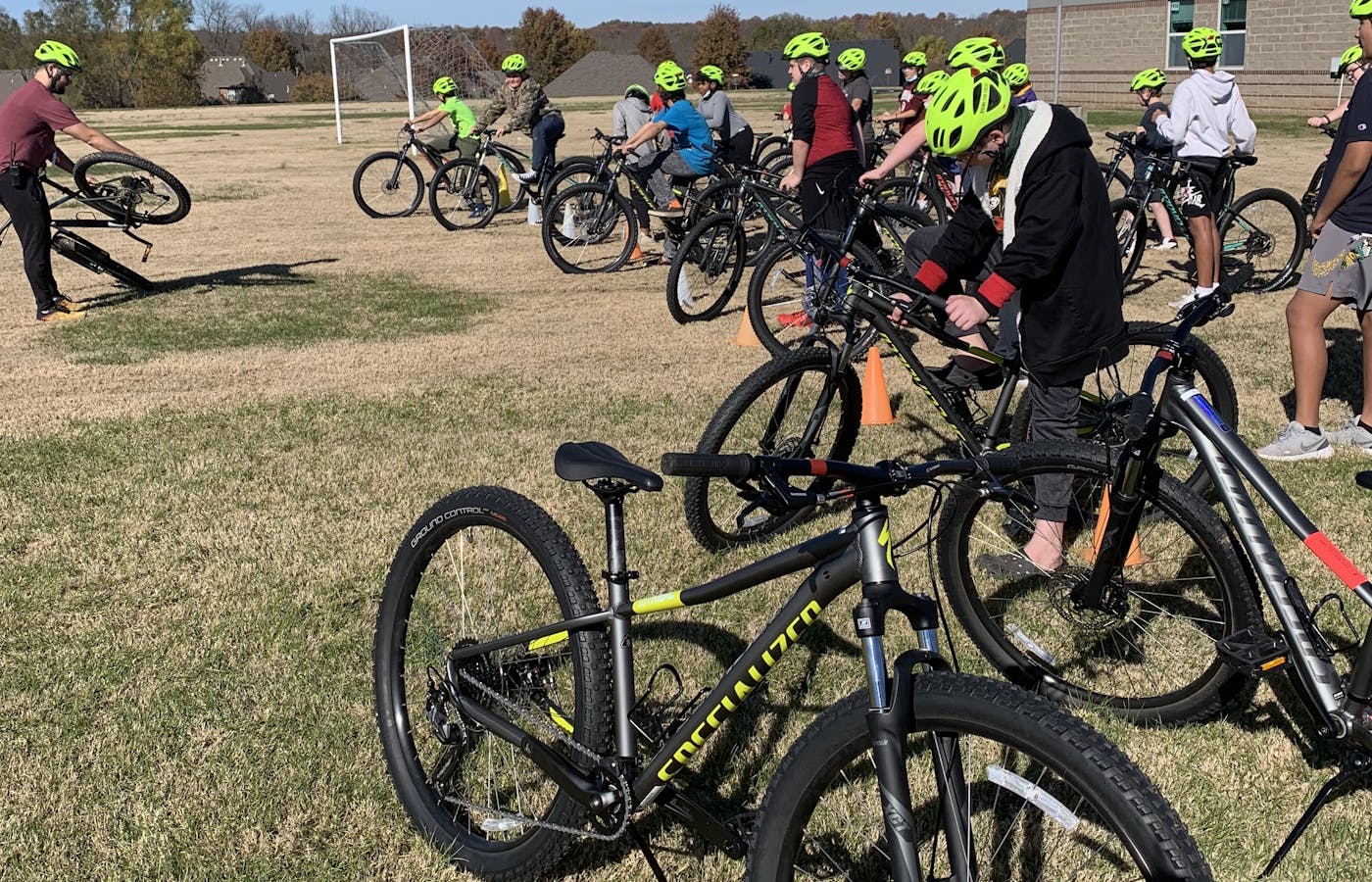
Northwest Arkansas Schools Go Big on Bikes
October 13, 2022
The state's northwest corner is taking a holistic approach to nurturing cycling among students and teachers.

The Cycle Effect Gets Latina Youth Riding
October 12, 2022
The Colorado-based nonprofit uses culturally relevant, bilingual programming to get more young women into mountain biking.
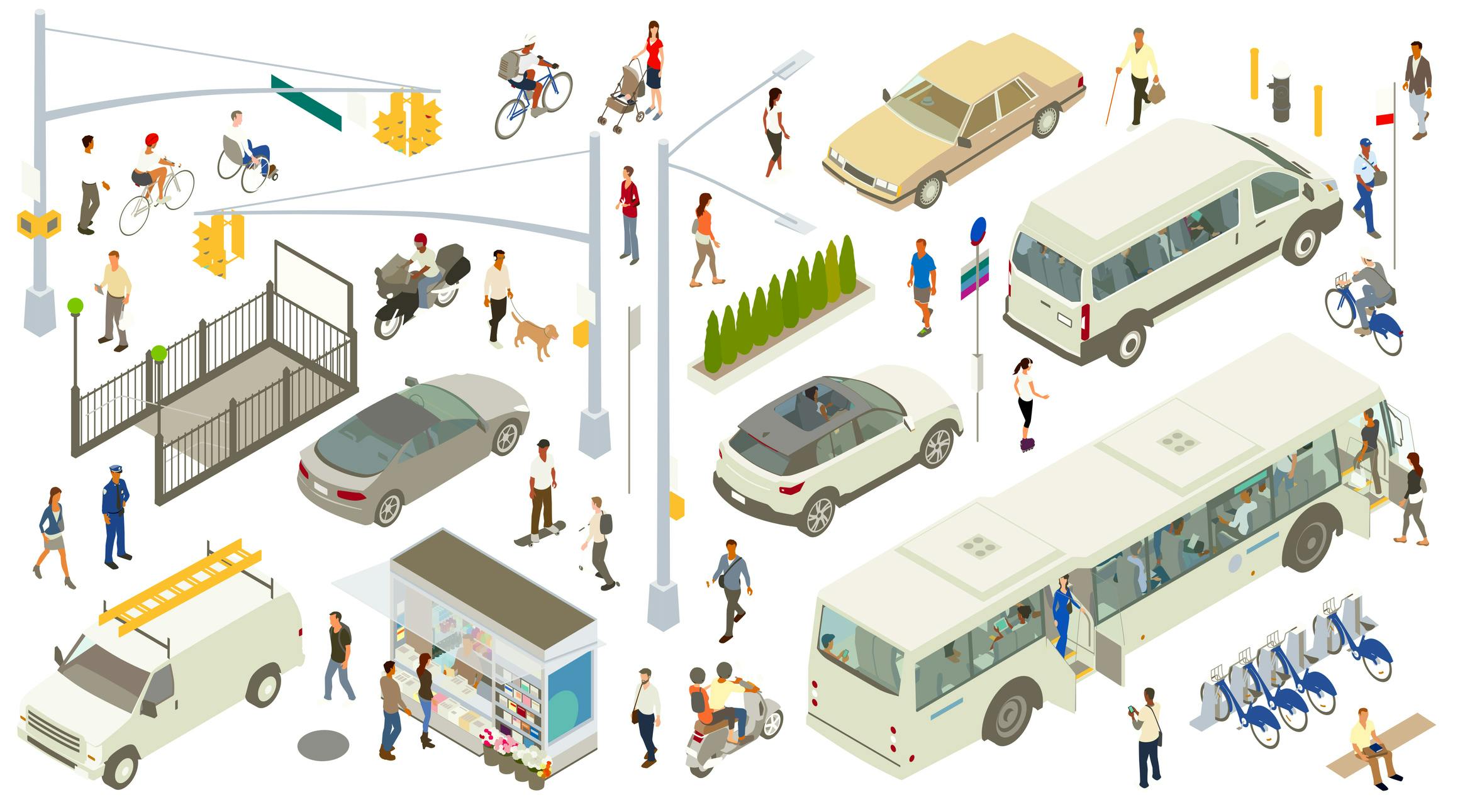
The Case for Guaranteed Basic Mobility
October 12, 2022
It’s time to reframe how we think about transportation and mobility — the ability to move freely and participate in society is a basic right.
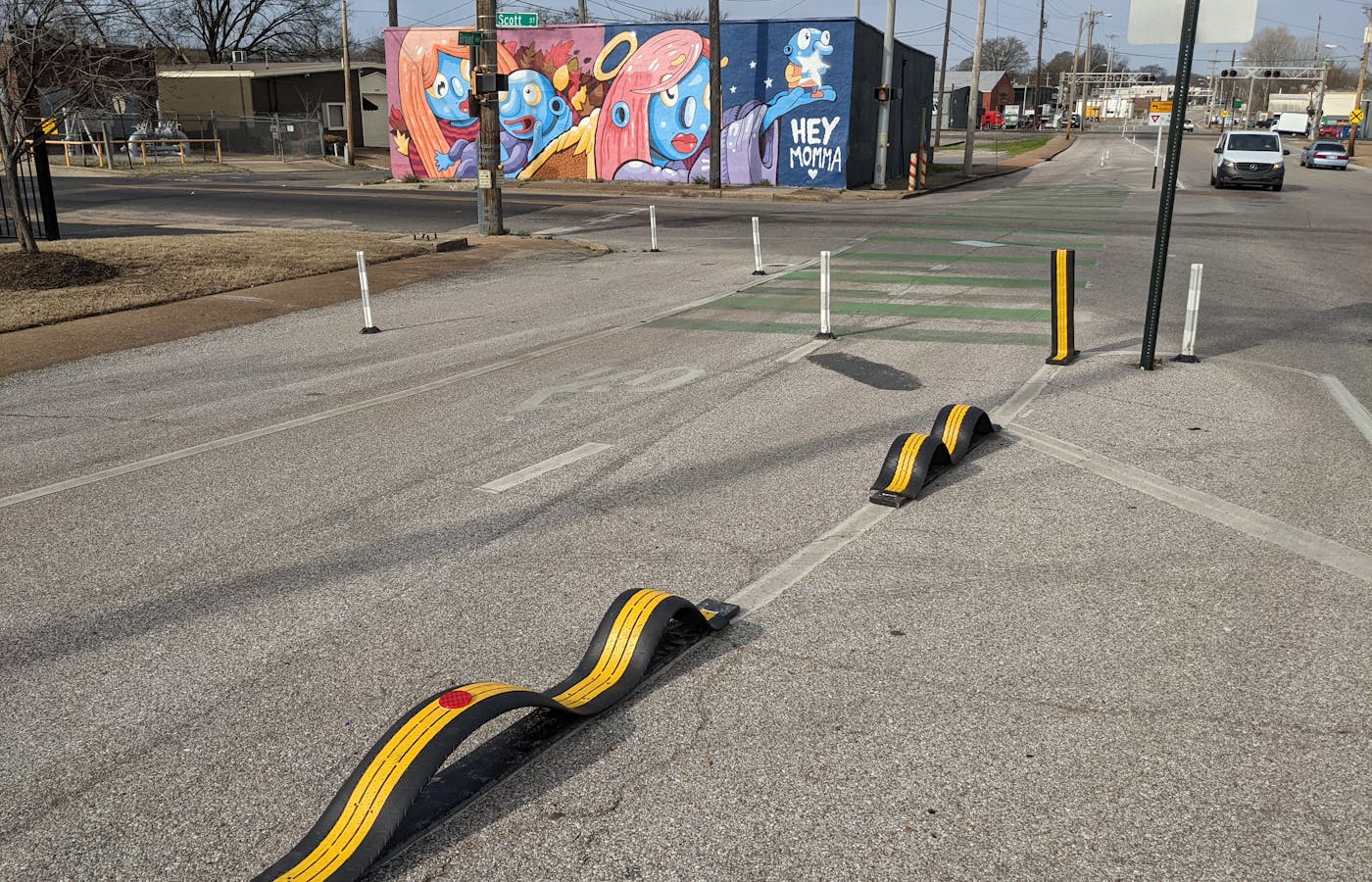
Transforming Old Tires Into Bike Lane Barriers
October 11, 2022
In Memphis, a workforce development program is using old car parts to carve out space for bicycling.
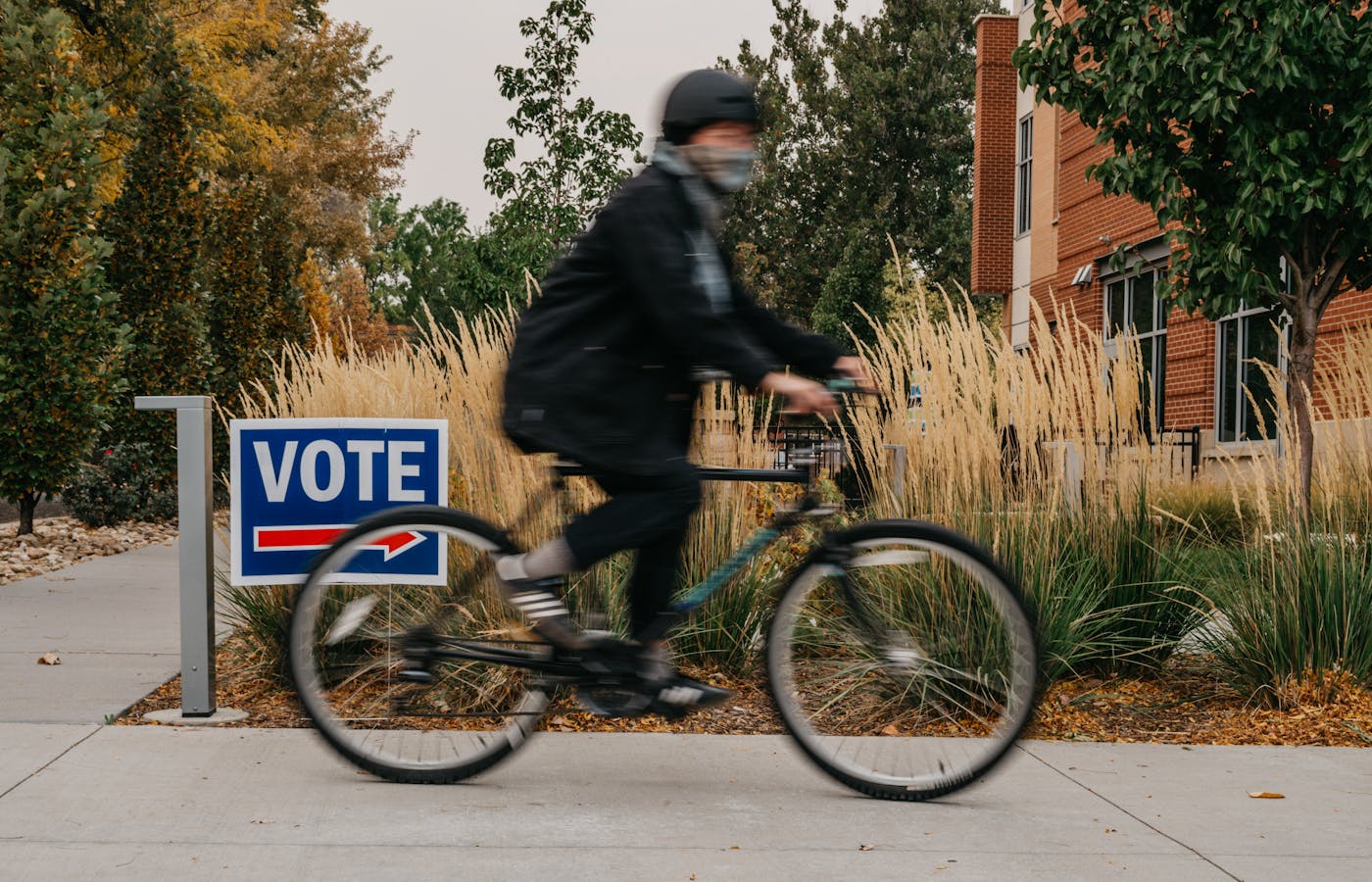
Vote for Better Bike Infrastructure
September 22, 2022
This November, your vote is needed to pass important bike initiatives in all 50 states.
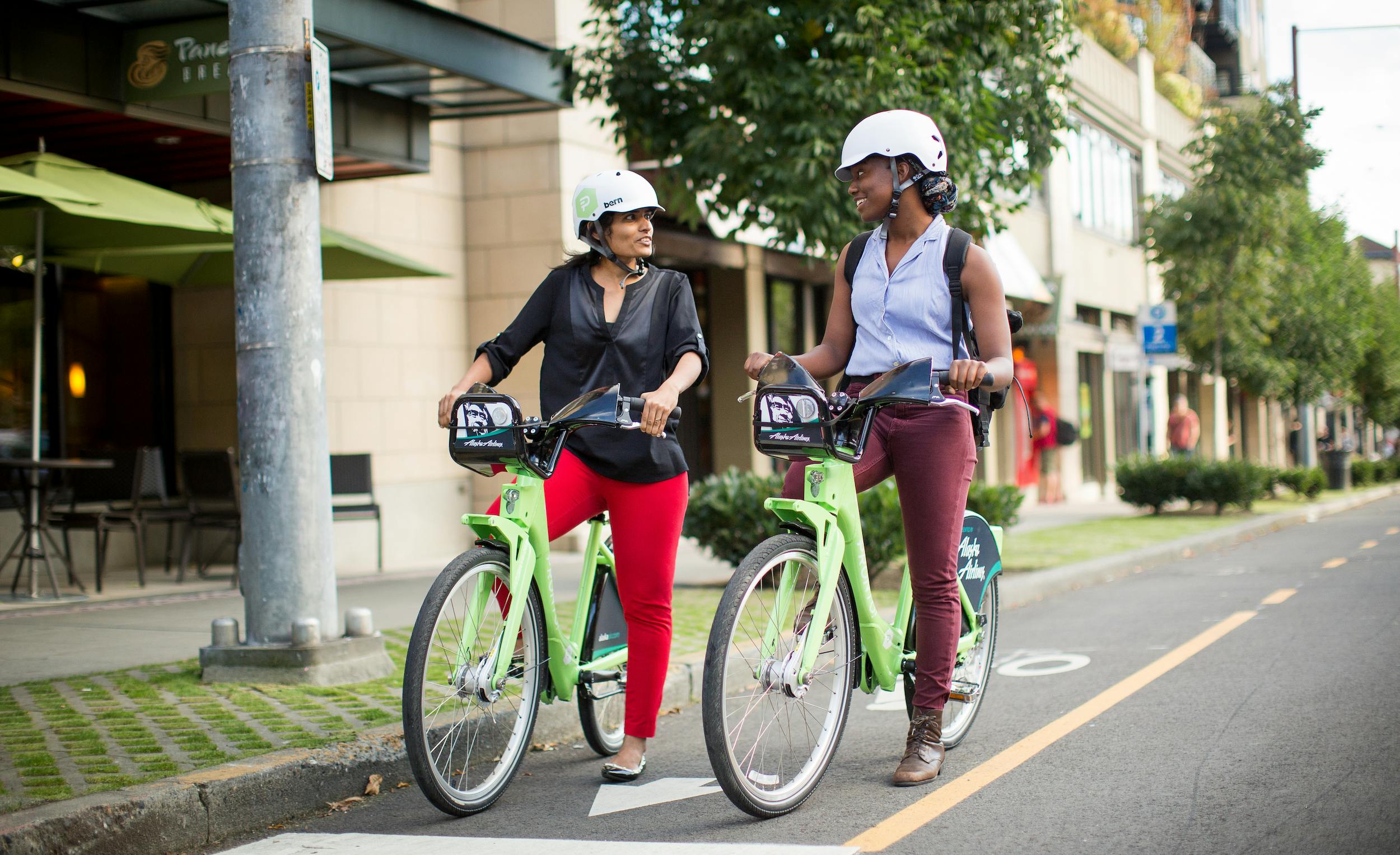
Charging Ahead on Micromobility Policy
September 21, 2022
Industry, advocacy and research organizations joined forces to devise a set of principles guiding the implementation of funding and policy for micromobility.

2022 State Legislative Wins for Electric Bicycles
September 21, 2022
States across the country are getting serious about electric bicycles. Check out a recap of this year’s legislative wins so far.

The Power of A Bike Park
September 19, 2022
In El Paso, Texas, the Desert Downs Bike Park is breaking down barriers to entry, showcasing the positive economic, health, and community-building benefits of biking.

Tap Into More Bike Infrastructure Funding
September 15, 2022
The League of American Bicyclists and Safe Routes Partnership collaborated on state-specific fact sheets for the Transportation Alternatives Program.

Marley Blonsky Takes On Size Inclusion in Bicycling
September 9, 2022
A Q&A with the co-founder of All Bodies on Bikes, an advocacy group that empowers folks of all shapes and sizes to ride joyfully.
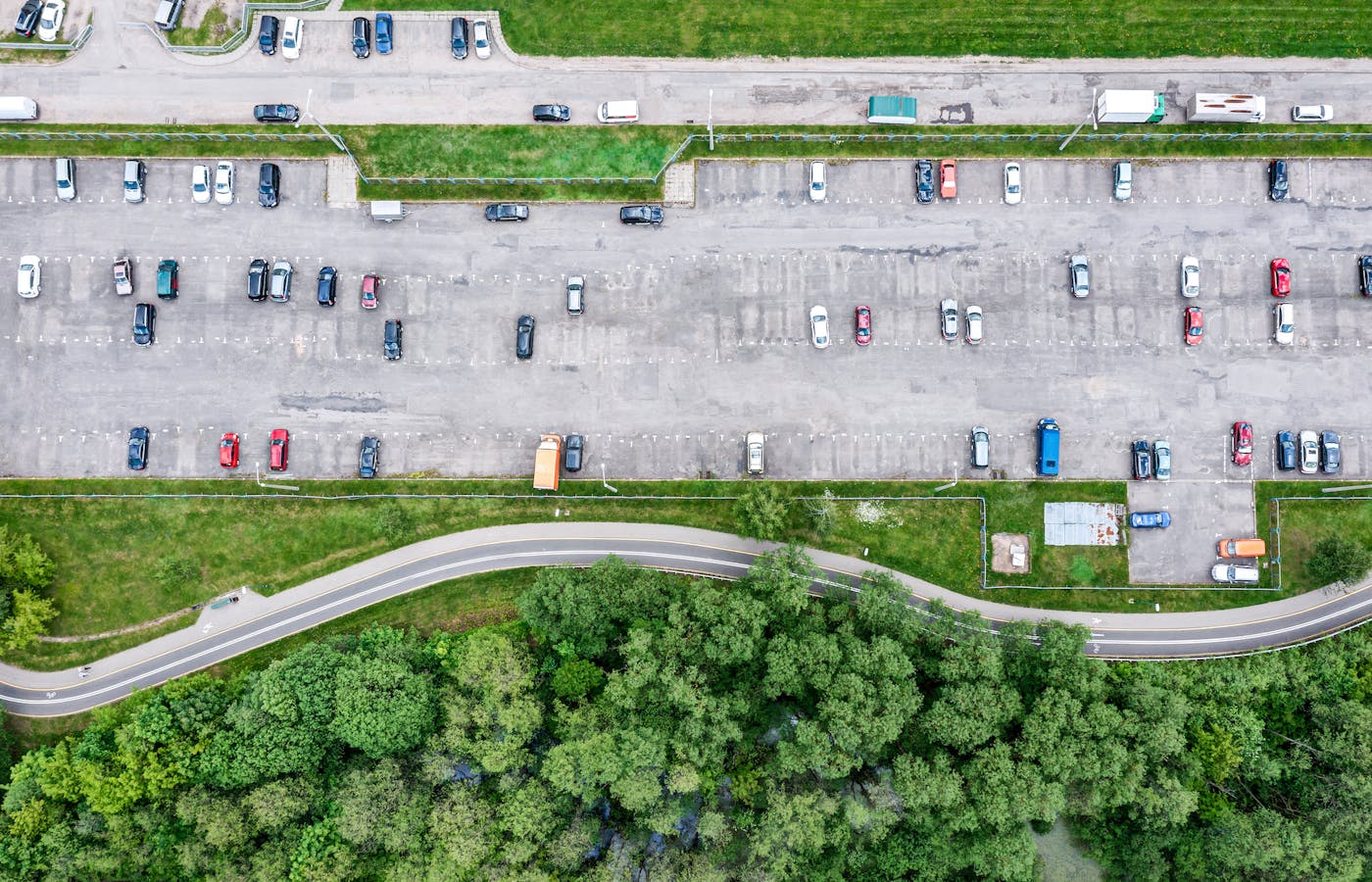
Parking Reform is Key to Building Bike-Friendly Cities
August 31, 2022
In order to build safe, convenient bike networks, we need to rethink how we allocate public space and specifically, how we prioritize parking.
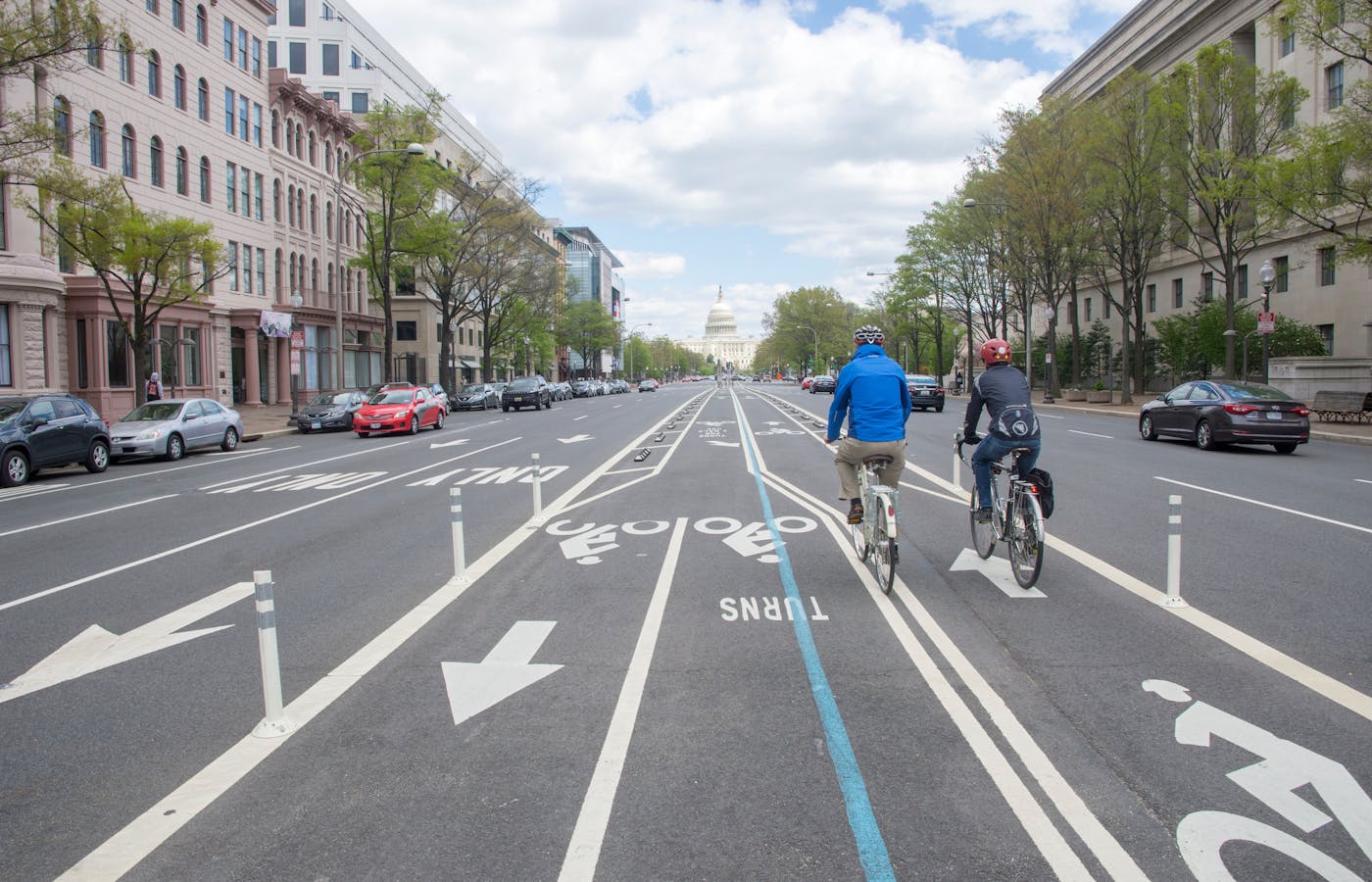
What IS in the Inflation Reduction Act for Bikes?
August 16, 2022
While it neglects to consider several incentives that center bikes as climate action, the IRA still advances much needed climate policy for the U.S.

The Urban Wilderness Transforming Knoxville
August 15, 2022
The home of the University of Tennessee is becoming one of the best cities in the Southeast for biking thanks to its redefinition of "wilderness."
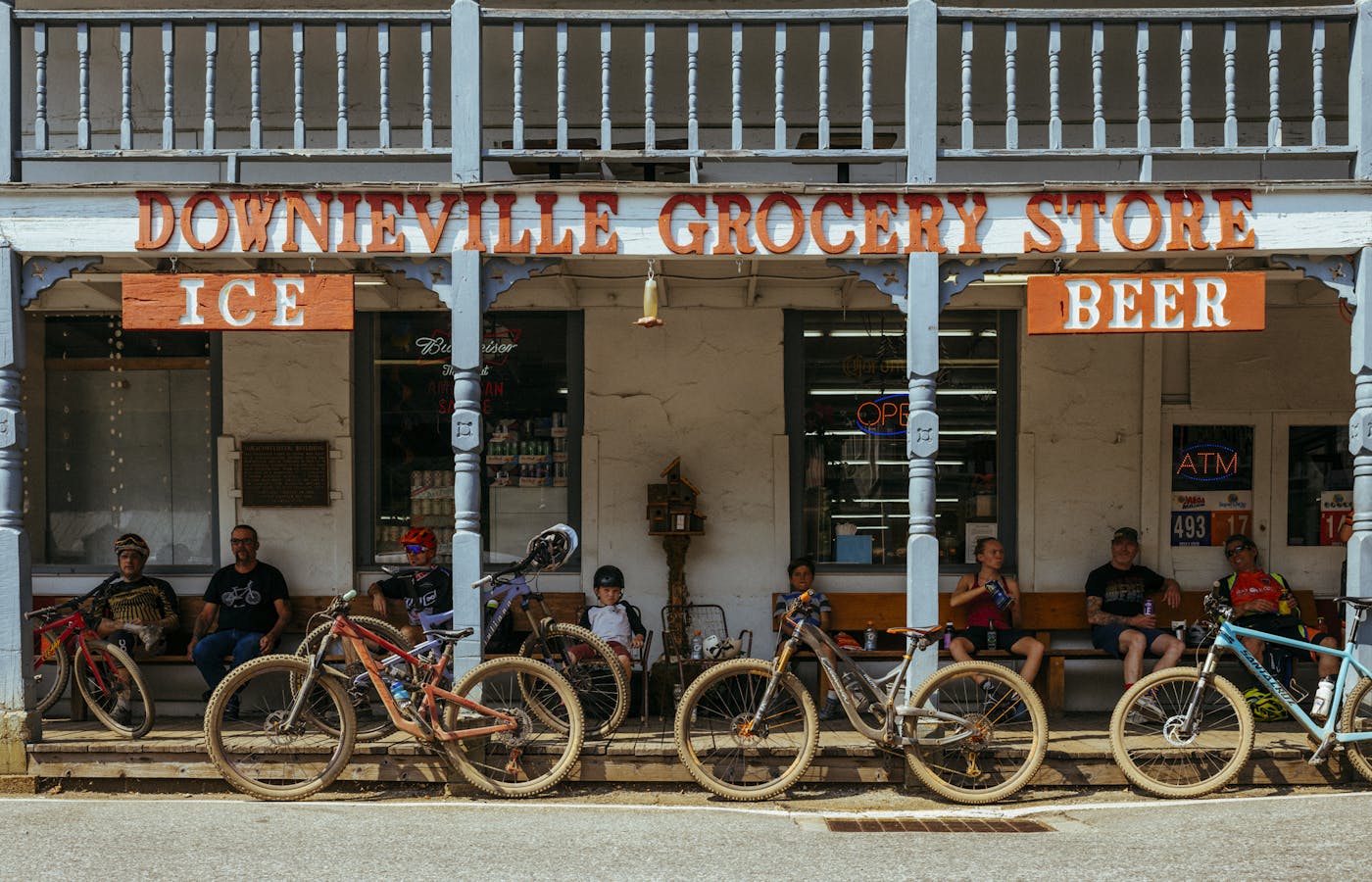
The Lost Sierra Route
August 10, 2022
In Northern California, a planned 600-plus-mile trail will connect 15 mountain towns, bringing economic revitalization alongside new mountain bikers.
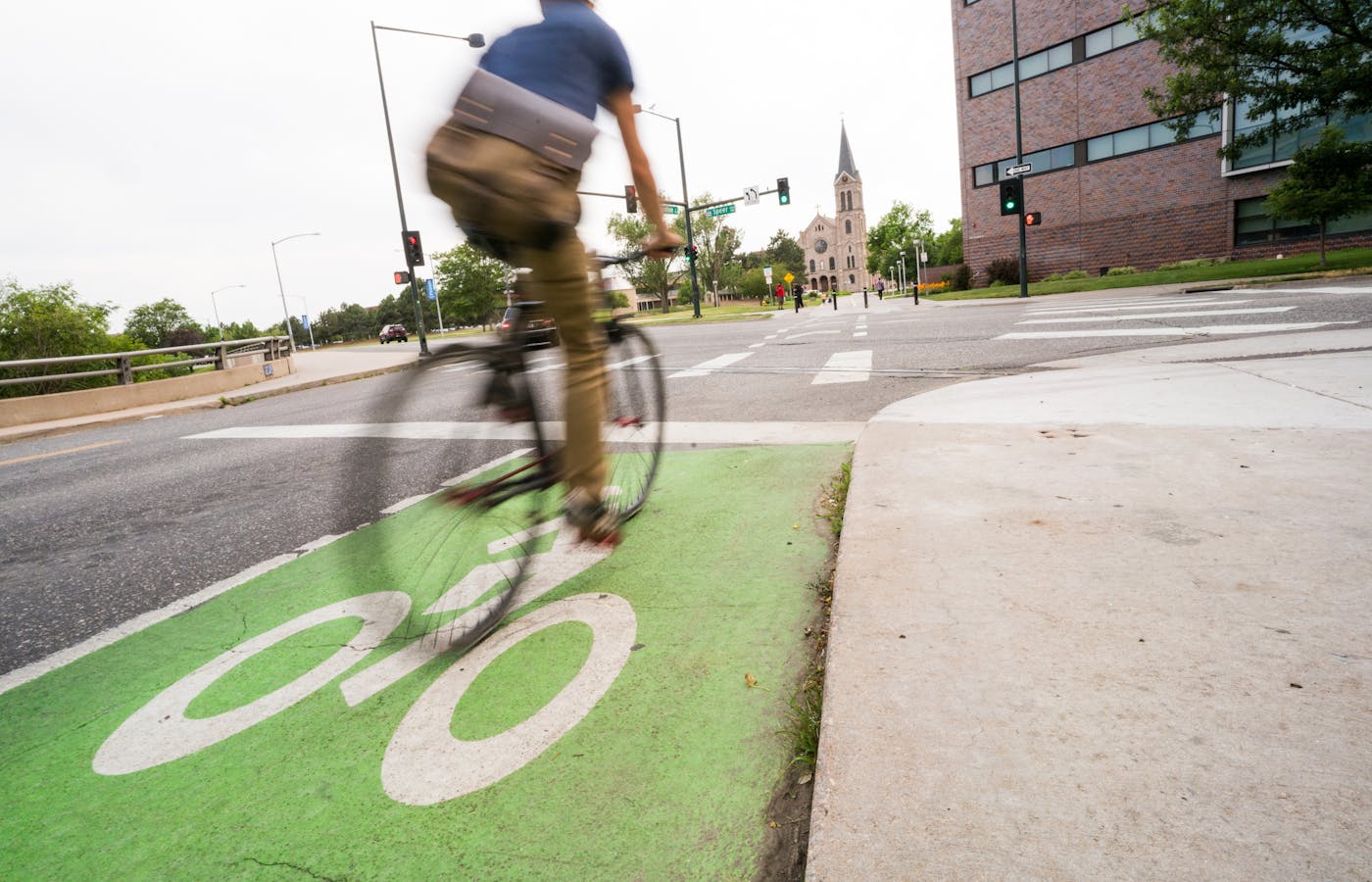
You Can Advocate for Bikes in the Inflation Reduction Act
August 3, 2022
Take advantage of our collection of resources to advocate for critical bike policy in the Inflation Reduction Act of 2022.

Oakland Youth Are Biking Towards a Better Future
July 31, 2022
The California Field School uses the bicycle as a tool for teaching youth about history, the environment and community throughout the state.
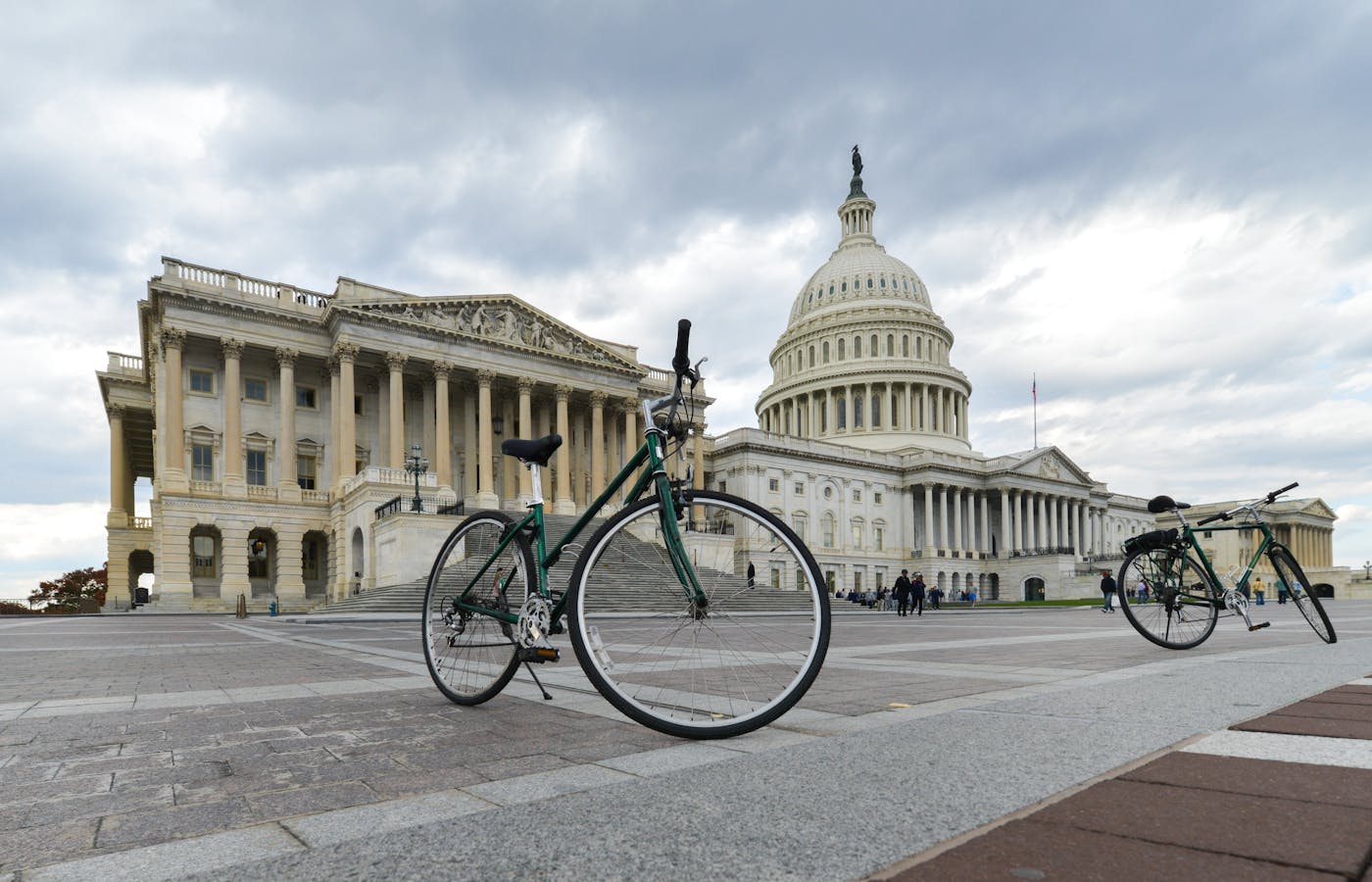
Inflation Reduction Act Falls Short in Prioritizing Bikes
July 28, 2022
PeopleForBikes continues to fight for a federal e-bike tax credit despite a big loss in the Inflation Reduction Act of 2022.

Exploring Climate Action Solutions With Electric Bicycles
July 22, 2022
Attendees at the Electric Bicycle Summit discussed ideas on how to improve the connection between riding an electric bicycle and fighting climate change.
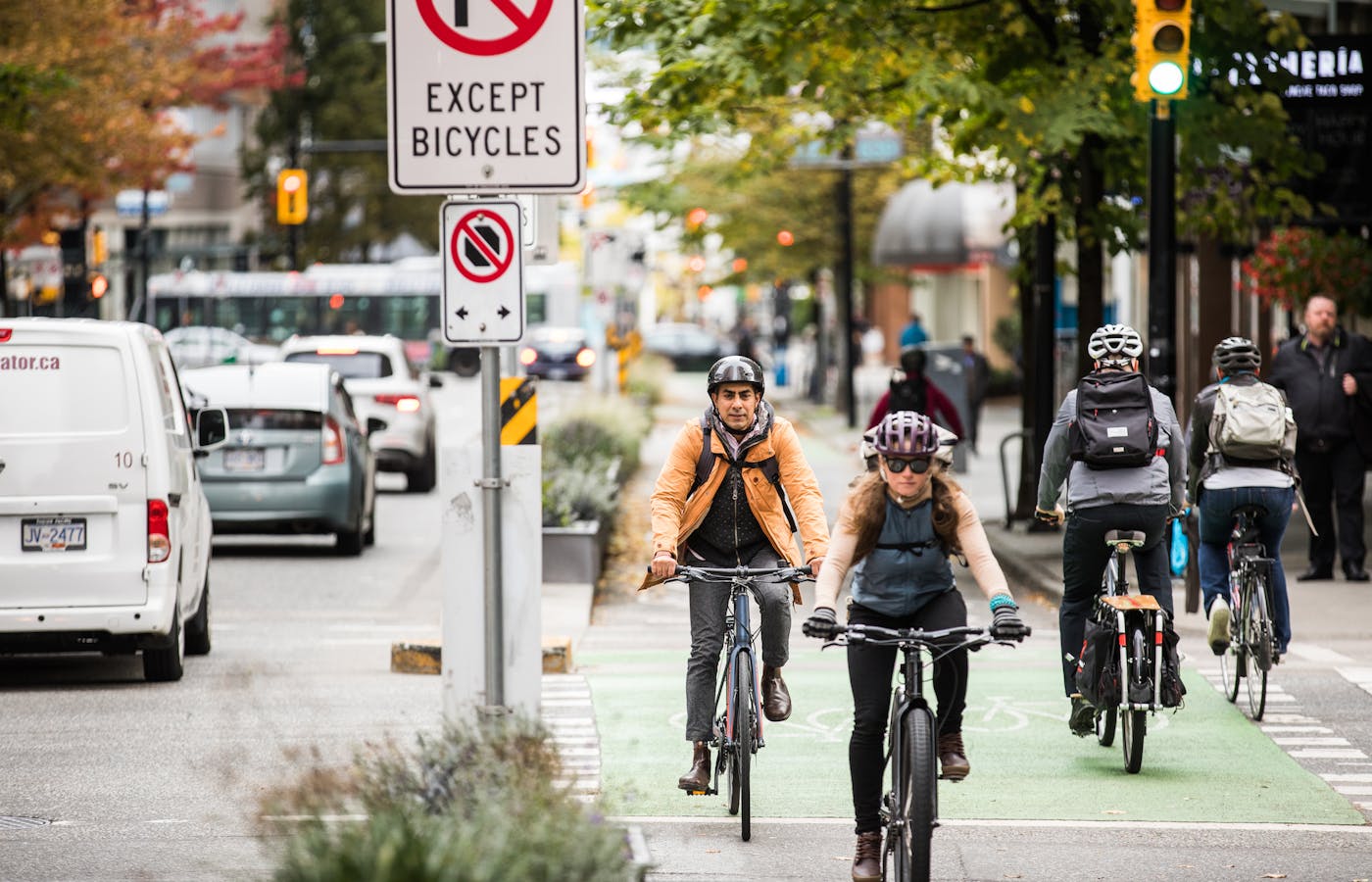
Want to Save Americans Money at the Pump? Invest in Bikes
July 21, 2022
The Biden administration and Congress could quickly lower transportation costs for Americans by investing in bike infrastructure and e-bike purchase subsidies, as well as fight inflation by relieving Section 301 tariffs on bicycle imports.

Join PeopleForBikes at the Electric Mountain Bike Summit
July 6, 2022
PeopleForBikes’ inaugural eMTB Summit will take place September 14-15, 2022, in Lake Tahoe, California. ...

Empowering LGBTQ+ Youth Through Bicycling
June 30, 2022
The Fearless Flyers program goes beyond group rides and bicycle basics to provide community-based education, wellness resources and an inclusive cycling environment.
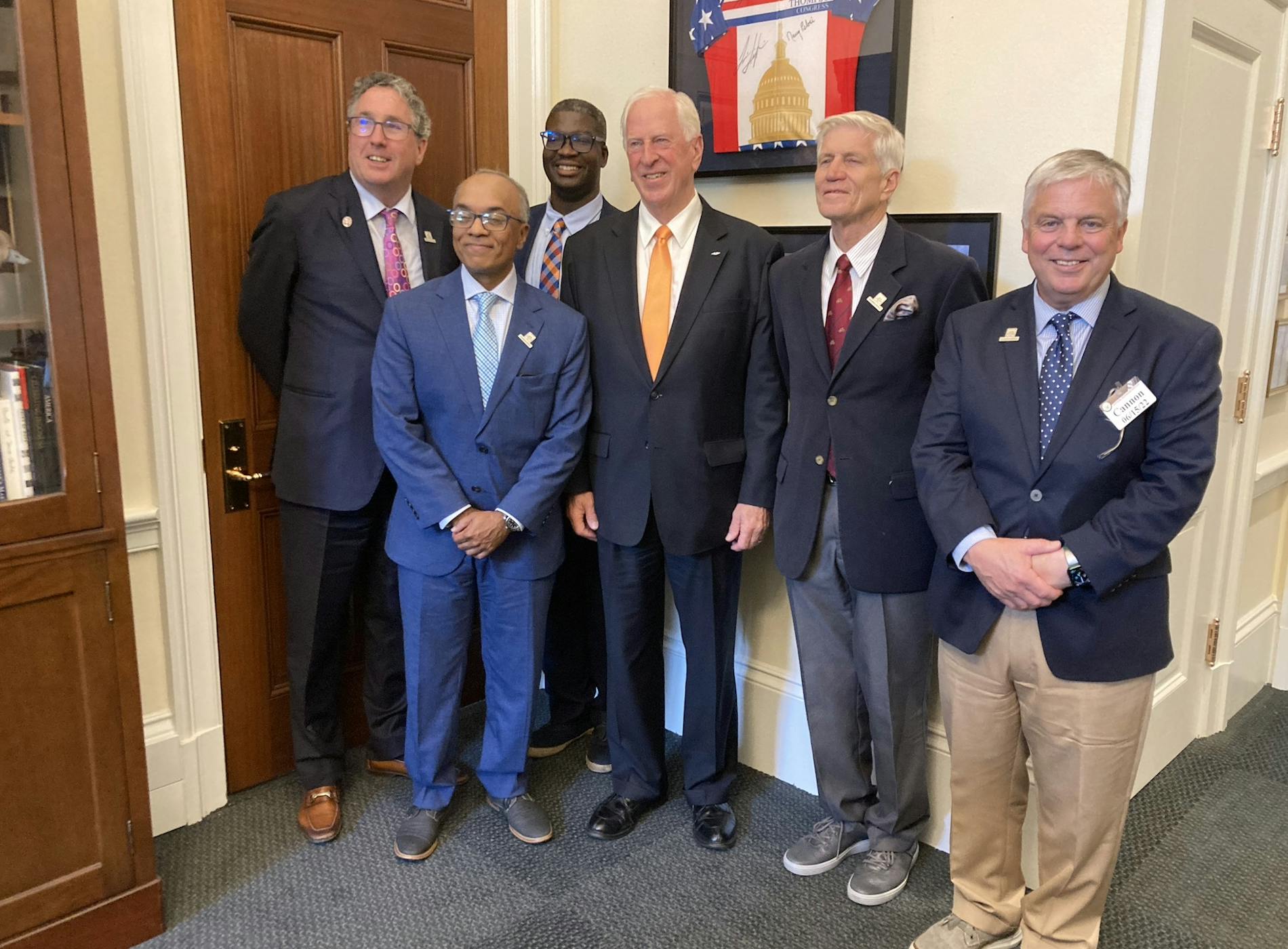
PeopleForBikes’ Fly-In Brings Industry Leaders Back to Washington, D.C.
June 30, 2022
Focused on bikes as a climate policy solution and expanded electric mountain bike access, PeopleForBikes hosted our first industry fly-in since 2019. ...
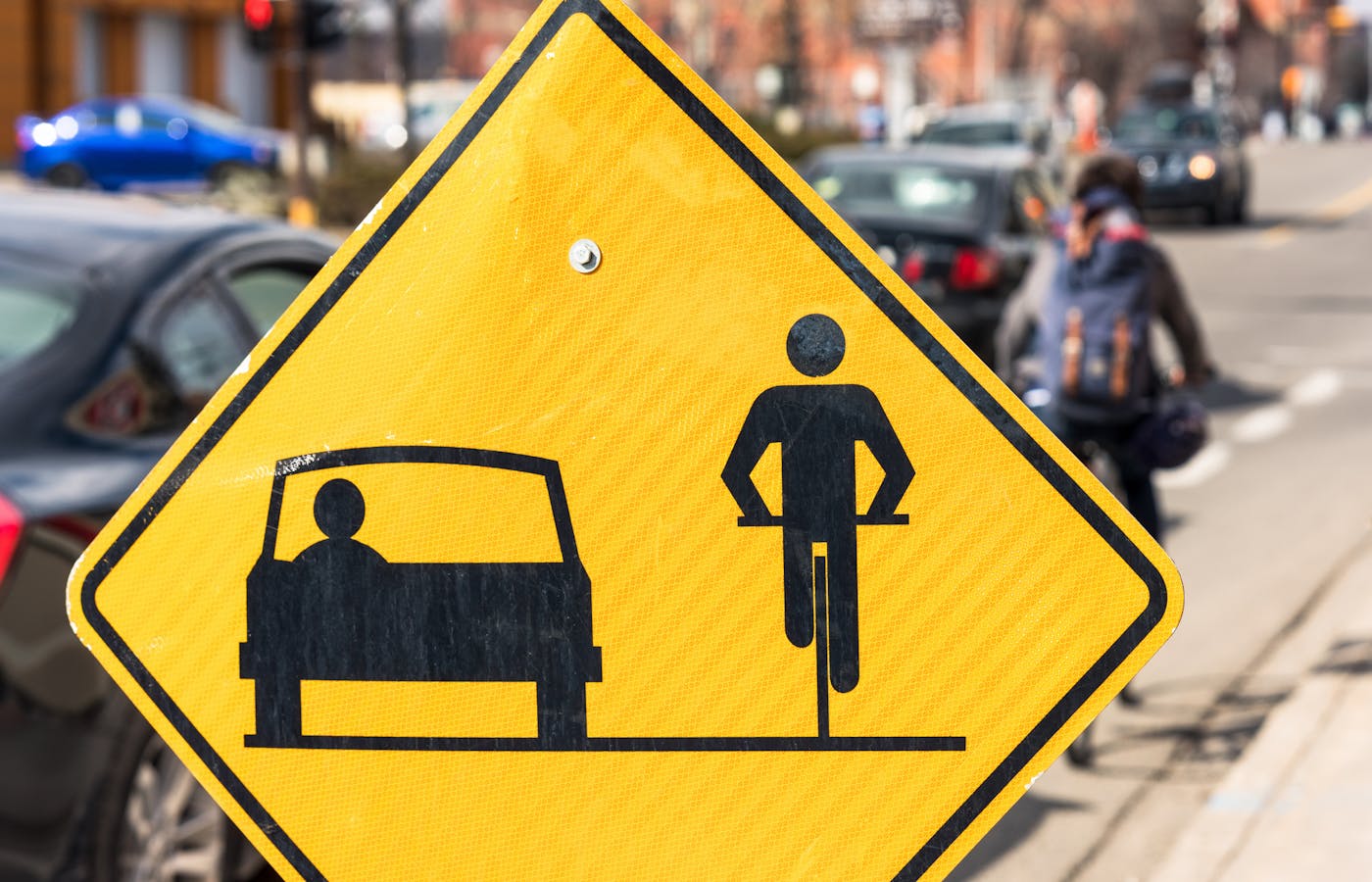
Slow Streets Pave the Way to Better Bike Cities
June 30, 2022
Time and again, we’ve seen that when speed limits fall, safety rises — as do cities’ Bicycle Network Analysis scores. ...

Working to 'Ungap' Seattle's Bike Map
June 30, 2022
Wanting to bring more people to bicycling, nonprofit Seattle Neighborhood Greenways is advocating to close gaps in Seattle’s bicycle network.

Crested Butte’s Answer to Car Dependency? Boots, Bikes and Buses
June 29, 2022
It may be known as one of the birthplaces of mountain biking in the U.S., but Crested Butte’s community of single-speed townie bikes is helping cut off the need for cars. ...

The Secret Behind Bentonville’s Success
June 29, 2022
Twenty years ago, the small, Northwest Arkansas city was relatively unknown. Today, it’s the mountain biking capital of the world. ...
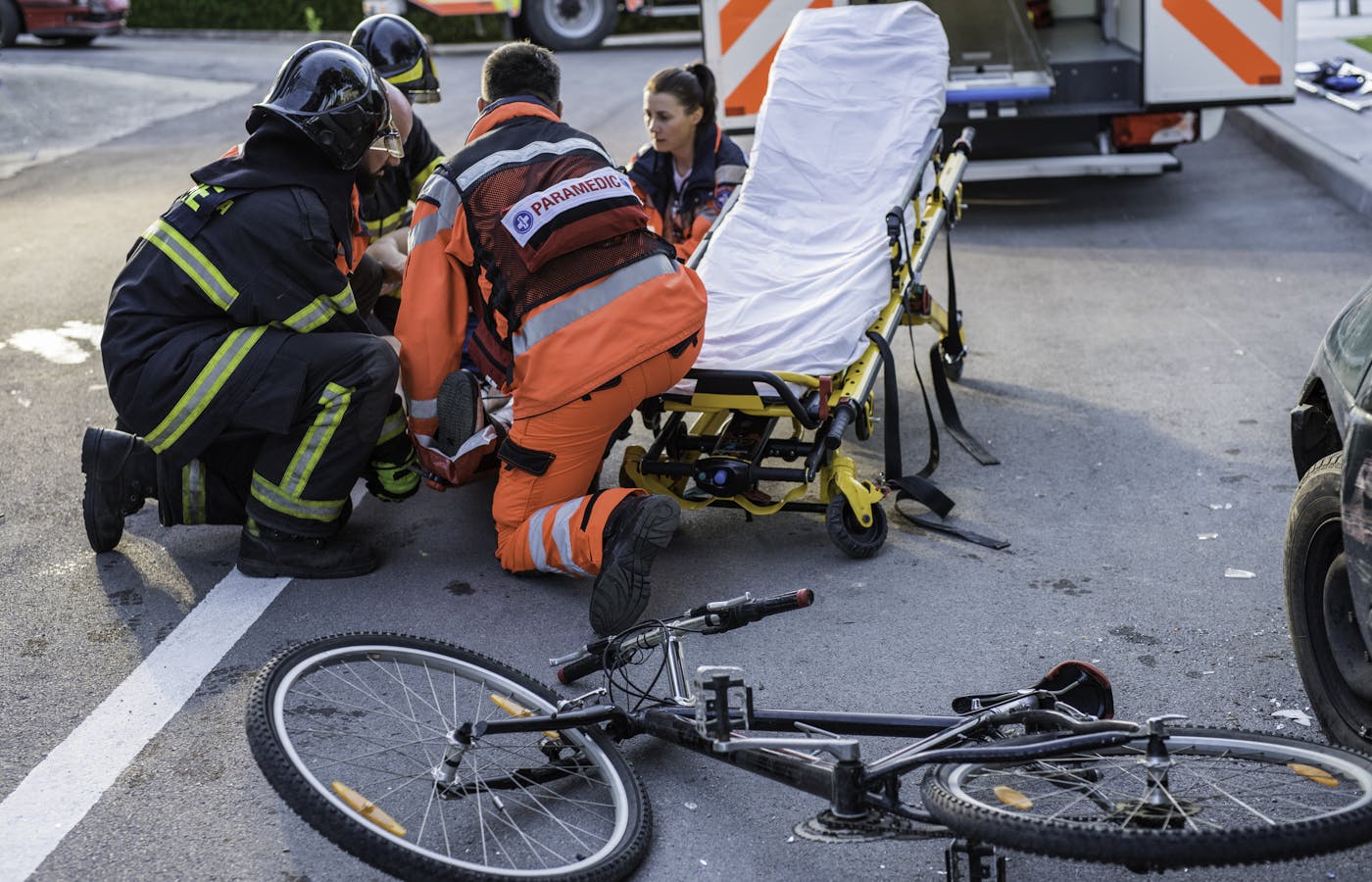
Bike Fatalities Are Worse for Black and Hispanic Americans
June 23, 2022
A new study highlights how Black riders are more than 4.5x as likely to die while riding a bike than white riders on a per-mile basis.

2022 CityRatings: The Best Places to Bike in the U.S.
June 21, 2022
Using extensive research and data collection, PeopleForBikes' City Ratings program highlights communities that embrace the bicycle as a tool for mobility, economic growth and recreation. ...
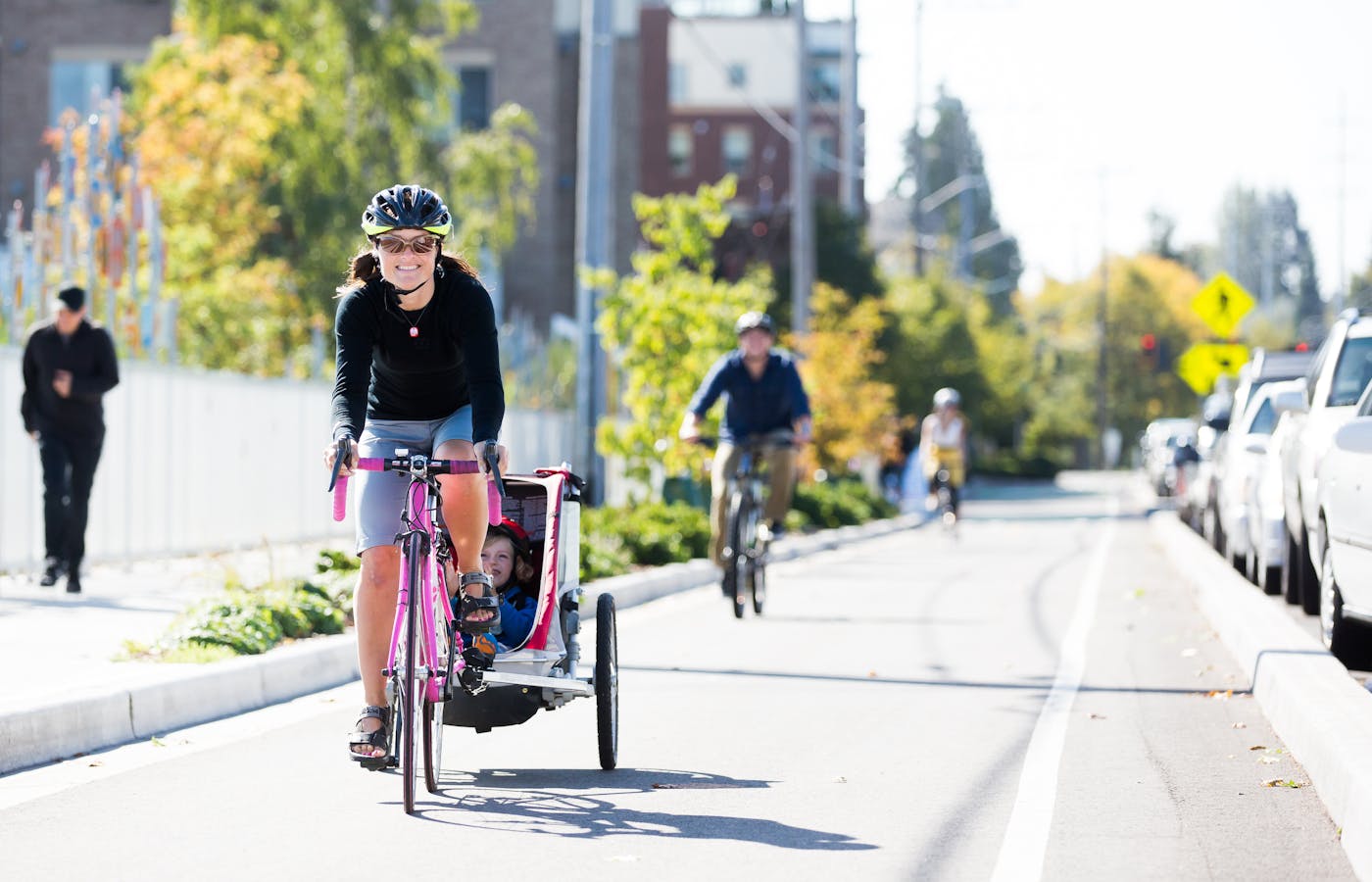
How to Make Any City Better for Bicycling
June 8, 2022
PeopleForBikes’ new SPRINT methodology lays the groundwork for cities looking to improve bicycling locally. ...
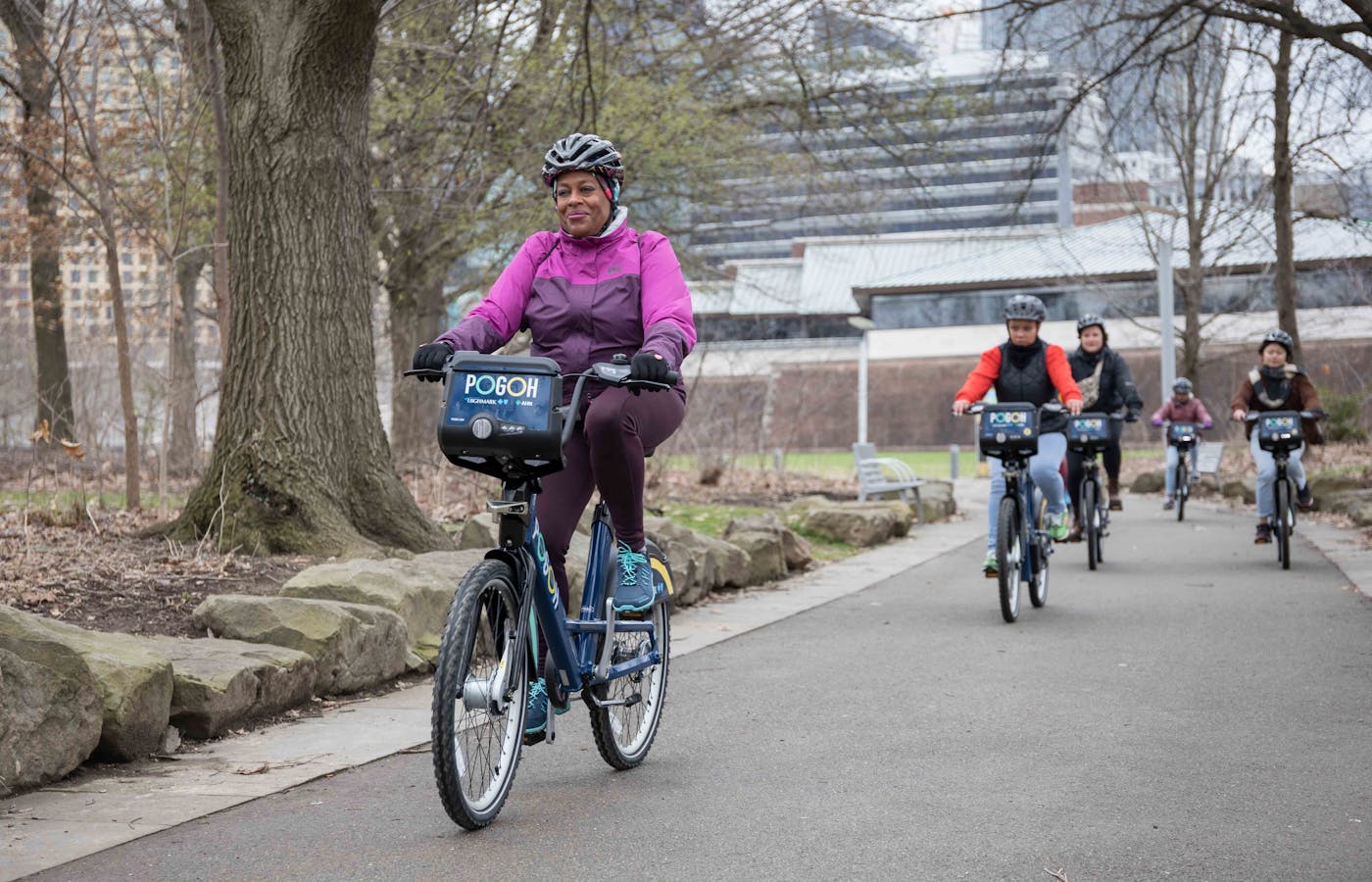
Better Bike Share Partnership Awards $75,000 in Grants
June 7, 2022
These 10 projects will reach and engage traditionally underserved populations through shared micromobility.

Electric Mountain Bike Pilot Project Coming to Vermont
June 7, 2022
New study looks to understand the impacts of allowing Class 1 pedal-assist eMTBs on trails in the Green Mountain State. ...

Morgantown’s Bike Strategy Focuses on Youth
June 7, 2022
While the West Virginia city doesn’t currently have the most impressive City Ratings score, it’s well-positioned to grow into a top spot for bicycling.

Our Top Adventure Biking Destinations
June 6, 2022
We collected a few of our favorite places to adventure by bike, all of which ranked in the top 100 of our 2022 City Ratings.
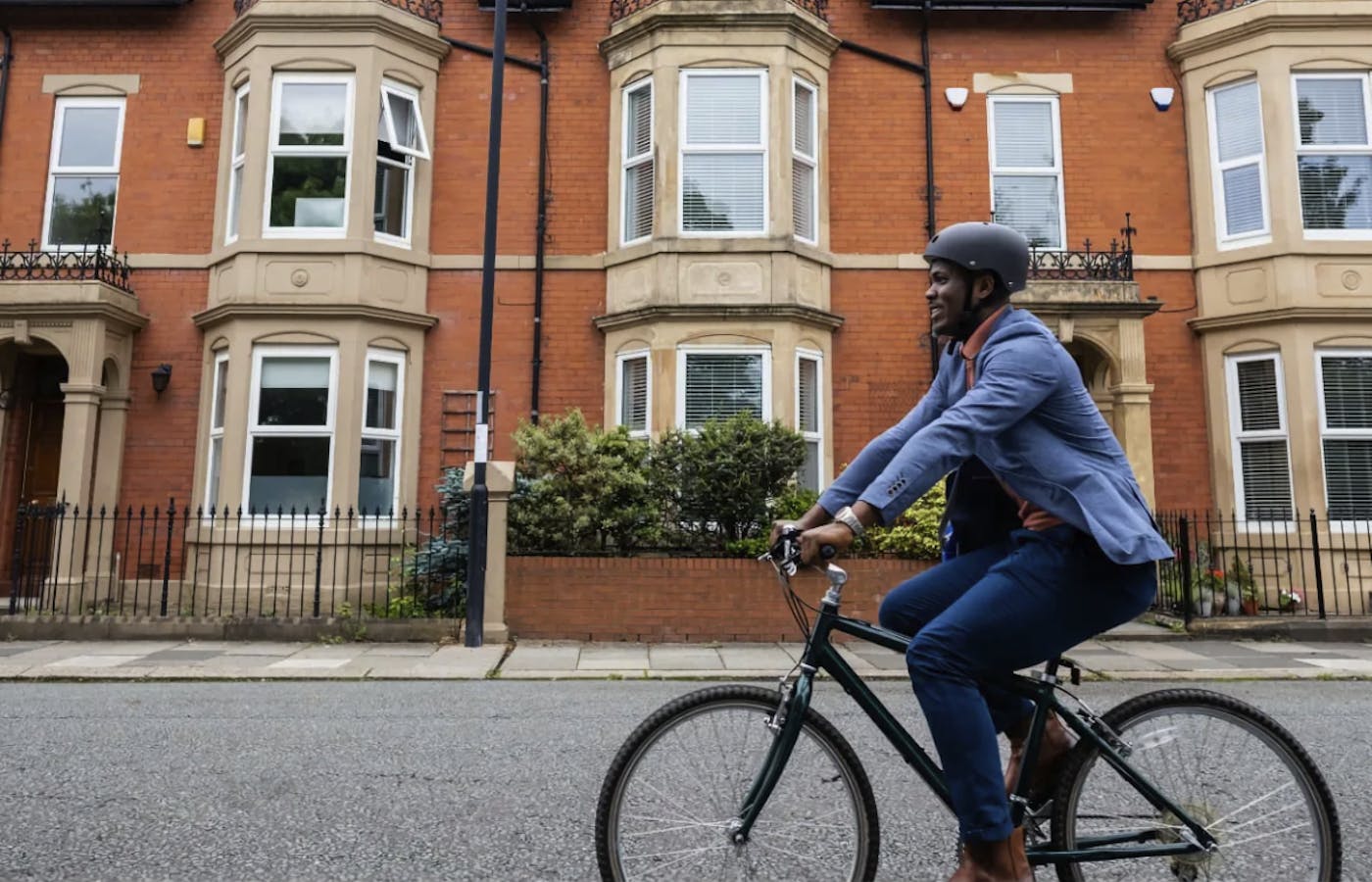
The State of Cycling in the U.K.
June 6, 2022
Thanks to pandemic-era changes and an influx of government funding, the United Kingdom is poised to become a global leader in active transportation.
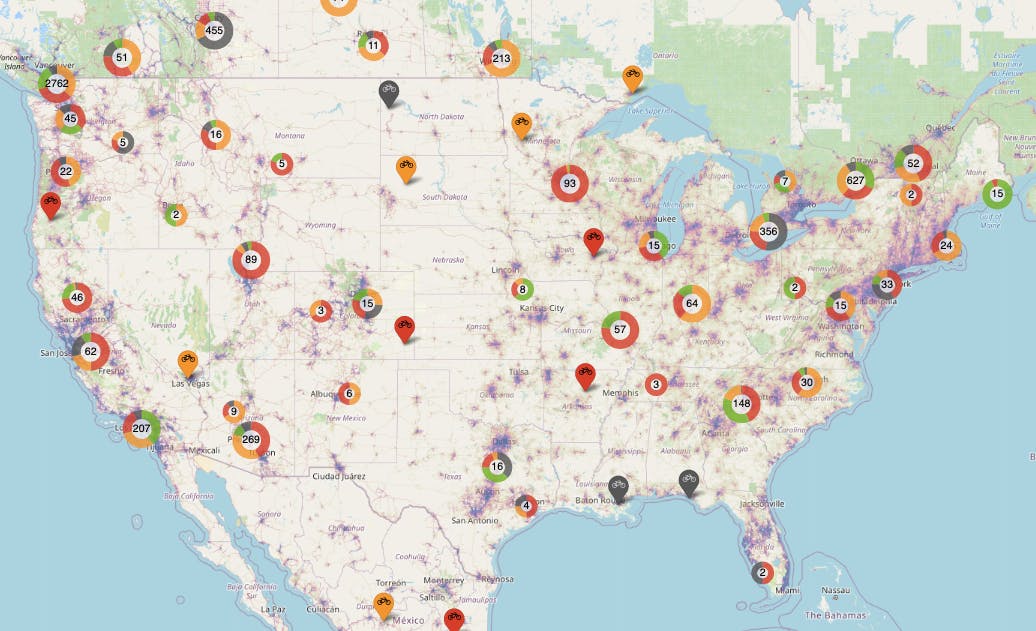
The Importance Of Mapping Bicycling Data
June 3, 2022
Tools like BikeMaps.org and PeopleForBikes’ Bicycle Network Analysis help planners make investment decisions that prioritize safety.

2022's Top-Ranking U.S. Cities for Bicycling
June 3, 2022
For the sixth consecutive year, PeopleForBikes is proud to release our annual City Ratings, a data-driven program to evaluate, identify and compare the best cities and towns for bicycling.

The Best Places for Sightseeing by Bike
June 3, 2022
America is home to some incredibly beautiful destinations — we collected our favorites to see by bike.

Top Up-and-Coming Cities for Biking
June 2, 2022
Looking for a new city to put down roots that’s also great for cycling? We selected some of our favorite performers from this year’s City Ratings.
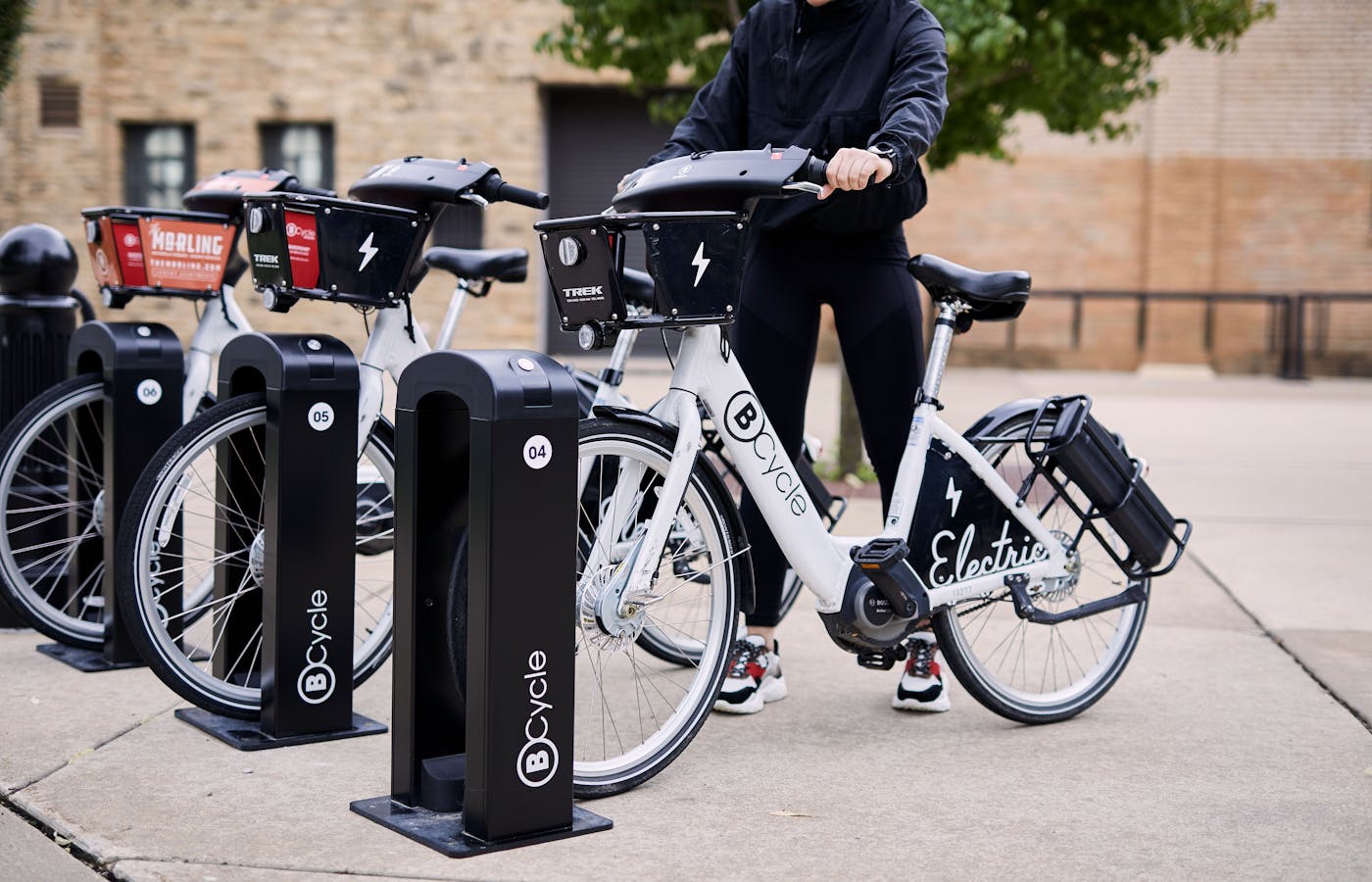
An Electric Bicycle Battery Recycling Program Takes Off
May 31, 2022
BCycle is the first bike share company to participate in Call2Recycle’s landmark, industrywide battery recycling initiative. ...

2022’s Best College Towns for Biking
May 30, 2022
Supported by quality bike networks, high ridership among students and campus-led initiatives to increase bicycling safety, many university towns rated highly in this year’s City Ratings.

Oklahoma Youth Love This Bike Club
May 27, 2022
Bike Club OKC is helping kids build community locally and better express themselves, improving health and academic outcomes along the way. ...
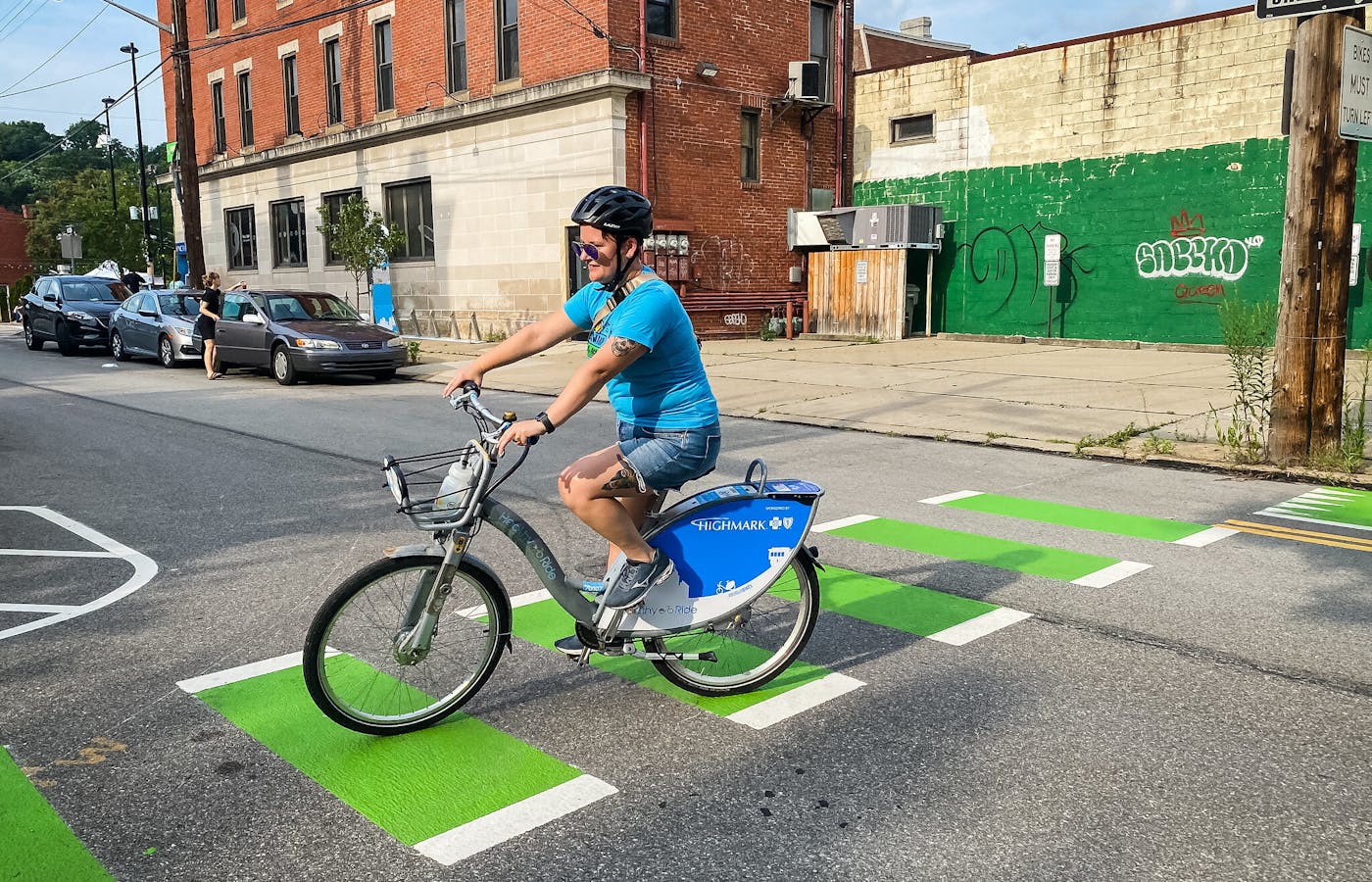
A Proven Model for Accelerating Bike Networks
May 20, 2022
PeopleForBikes, in collaboration with Wend Collective, helped five U.S. cities successfully increase bicycle mobility through the construction of new bike infrastructure.

A Tale of Two Biking Cities
May 20, 2022
Austin, Texas, and Paris, France, both made big commitments to prioritize bicycling. But how do the cities’ efforts compare? ...

Factoring Social and Environmental Responsibility Into Your Supply Chain
May 9, 2022
Alix Armour, head of sustainability at Super73, and Troy Jones, social and environmental responsibility manager at Specialized, serve as co-chairs on the Supply Chain and Social and Environmental Responsibility track within PeopleForBikes’ Sustainability Working Group. ...

Fire on the Mountain
May 3, 2022
In North Carolina, mountain bike trails on Cherokee land are improving citizens’ quality of life and transforming the local economy. ...

New Recreation Policy Package Hits U.S. Senate
May 3, 2022
The first-of-its-kind bill prioritizes recreation and mountain biking on public lands nationwide. ...
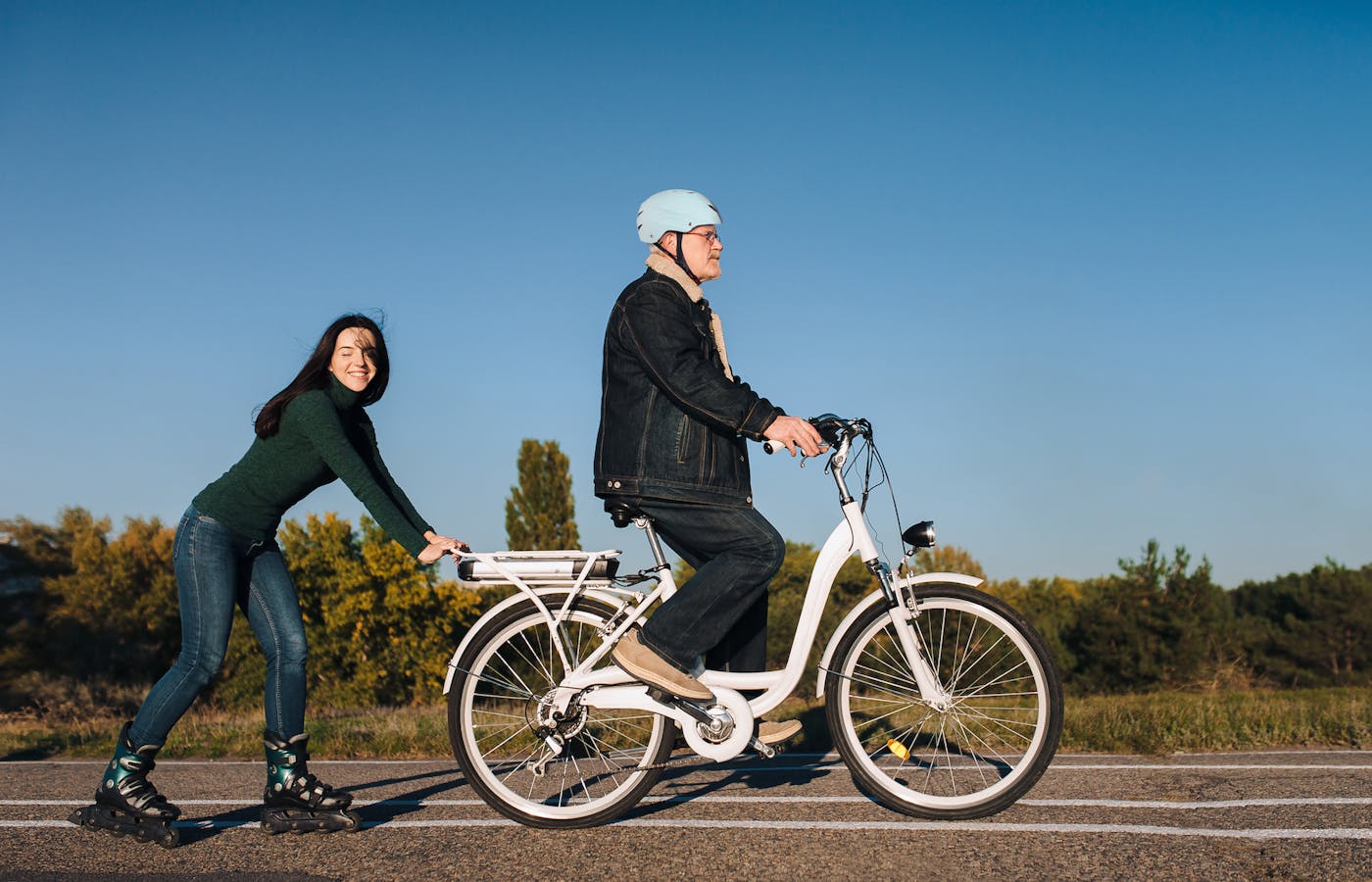
The Health Benefits of Electric Bikes
April 28, 2022
E-bikes are fun, but do they still offer exercise? We surveyed the available data to find out. ...
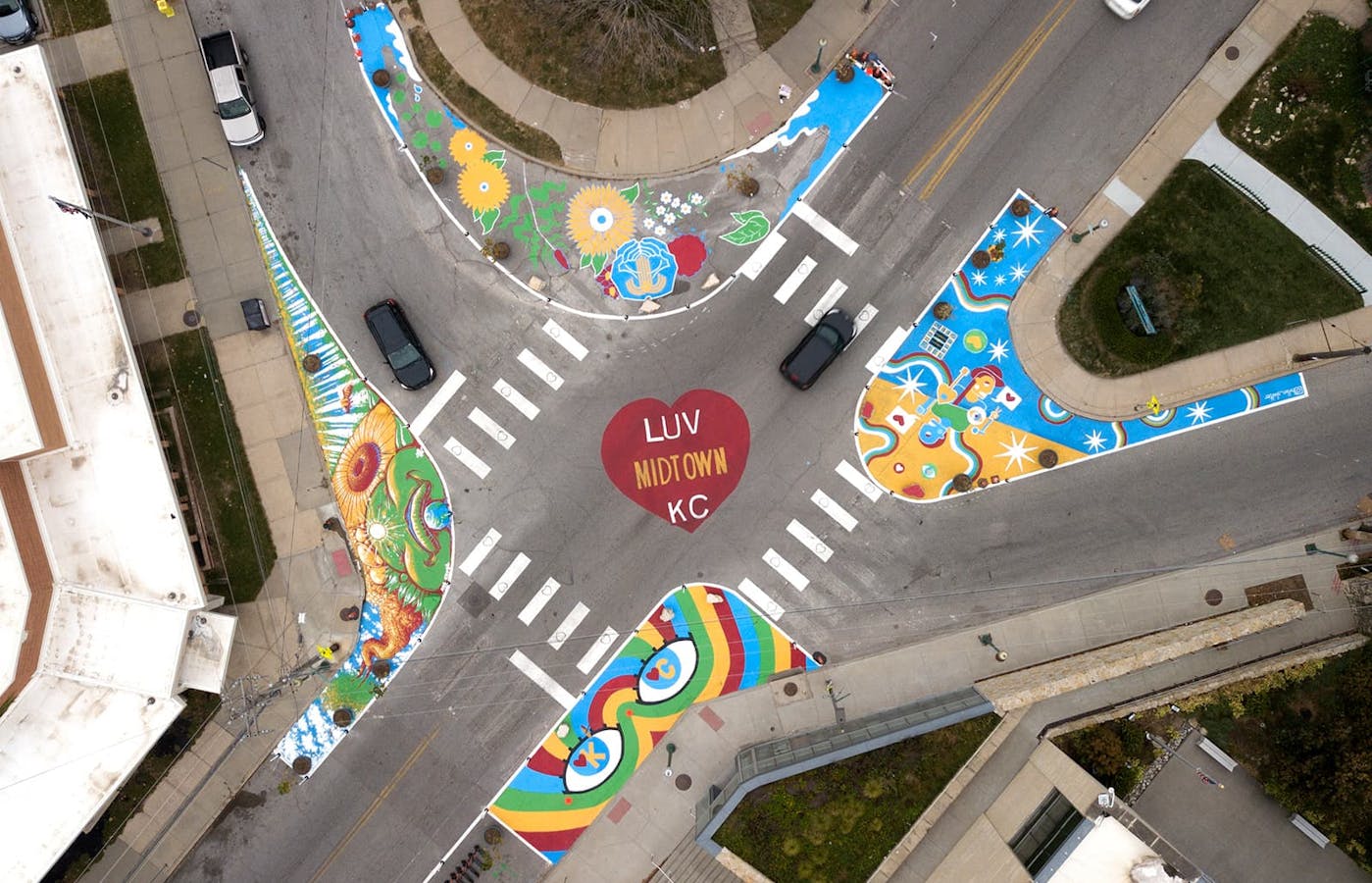
Asphalt Art Can Save Lives
April 26, 2022
A new study found that installing road murals at intersections can cut down on crashes by a whopping 50%. ...
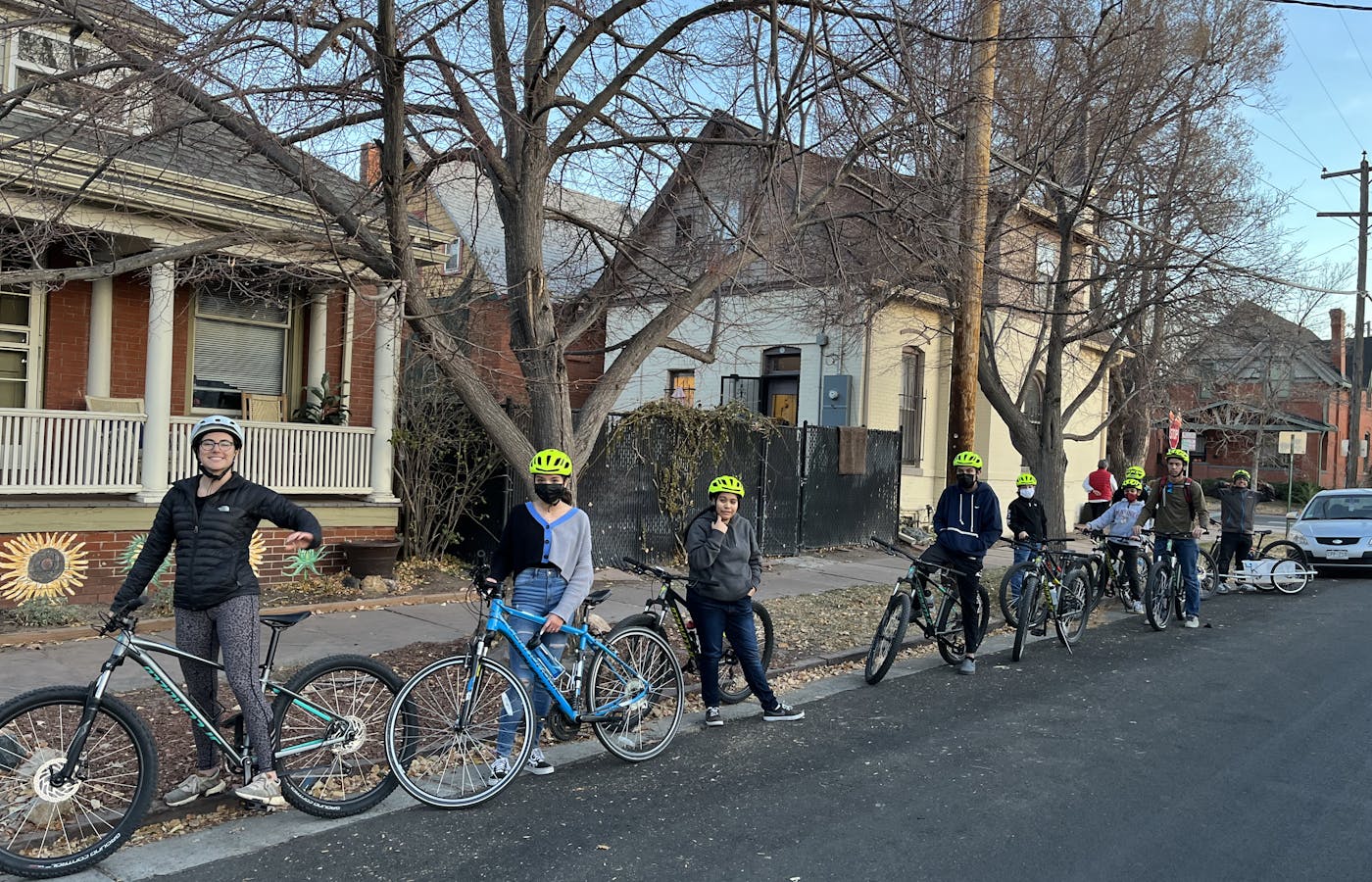
Steering Students Towards Health and Success
April 14, 2022
Mile High 360 is teaching Denver youth to ride, helping them see bicycling and their city in a new light. ...

How to Make Your Biking Habit Stick
April 11, 2022
Fitness instructor Larissa Gaul lends some tips on maintaining a resolution to biking more often. ...
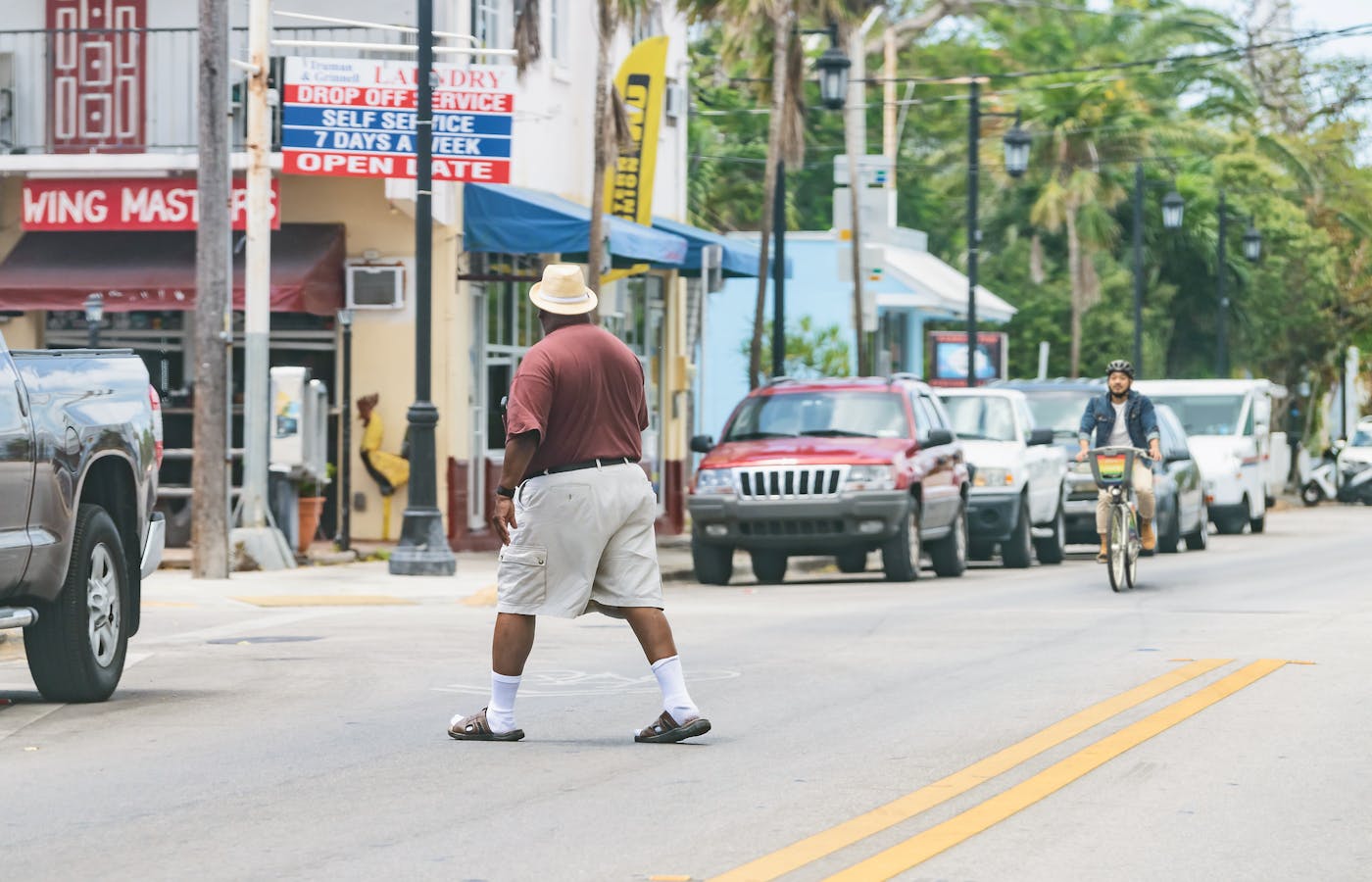
A How-To Guide for Decriminalizing Mobility
April 2, 2022
BikeWalkKC and Safe Routes to School released a new publication designed for advocates that want to repeal and modify unsafe, racialized traffic laws. ...

U.S. Forest Service Finalizes Guidance for Electric Bicycle Access
March 31, 2022
Electric Bicycles will remain classified as motor vehicles, but the guidance offers new tools for land managers to determine electric bicycle access. ...

QBP Scholarships Aim to Diversify the Bike Industry
March 31, 2022
Applications are currently open for four separate bicycle mechanic educational opportunities, all geared towards increasing gender and racial diversity in the bike industry. ...

PeopleForBikes’ Efforts for Electric Mountain Bikes on Public Lands
March 31, 2022
PeopleForBikes is working with federal partners to create and open more off-road trails to electric bicycles. ...

How My Electric Bike Helped Me Heal
March 29, 2022
After breaking a leg skiing, this rider’s e-bike has been instrumental in aiding both her physical therapy and mental well-being. ...

Electric Bicycle Incentives Go Local
March 25, 2022
With Congress at an impasse, states and cities are exploring ways to boost electric bikes. ...

Riding Bikes Is Good For Youth and Research Proves It
March 25, 2022
A new report from the nonprofit Outride showcases how bicycling can transform student’s health and well-being for the better. We spoke with Esther Walker, Ph.D about the new findings. ...
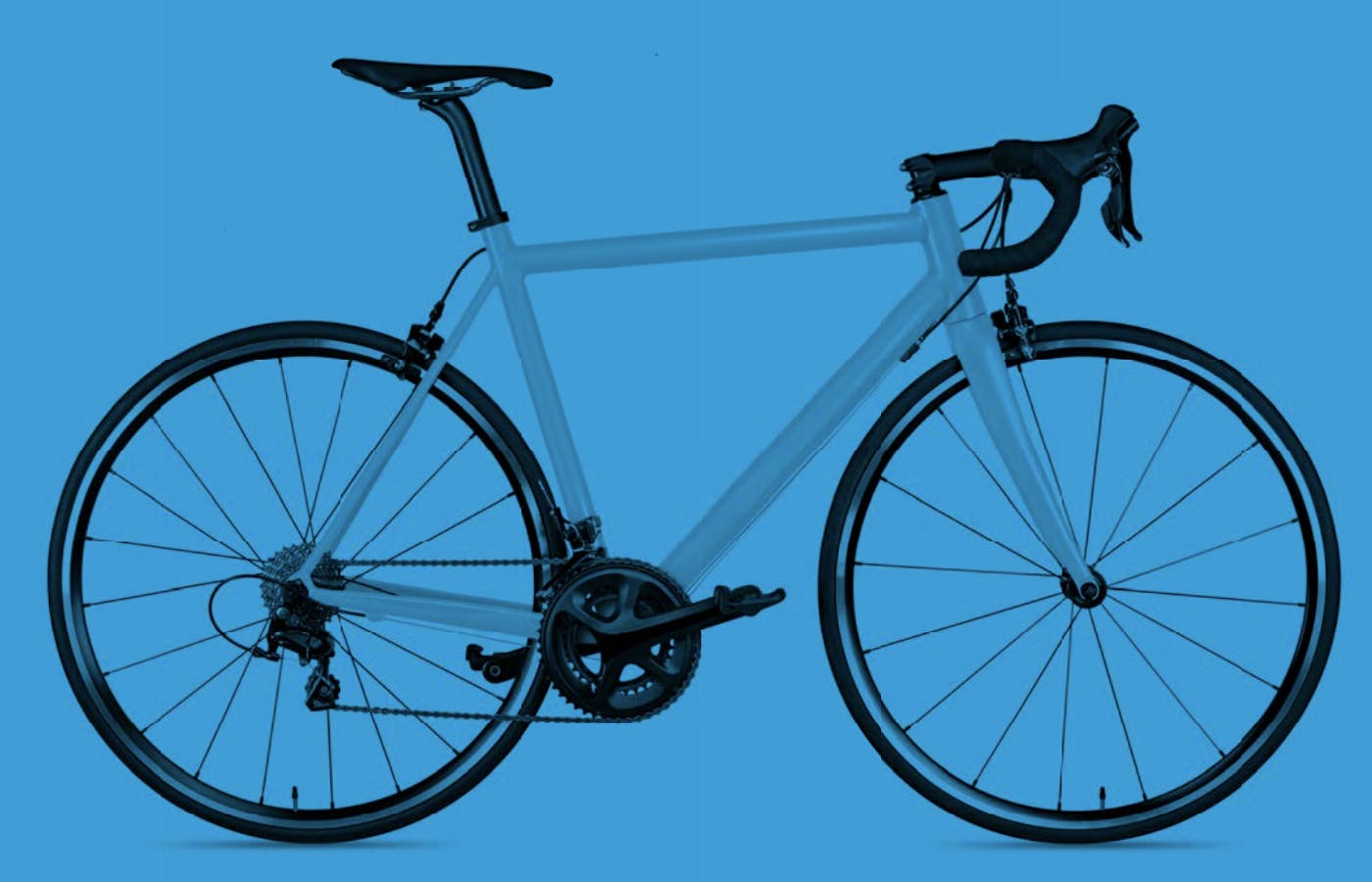
USTR Announces Long-Sought Tariff Relief for Bikes
March 25, 2022
New, retroactive Section 301 tariff exclusions mark a big win for the bike industry. ...
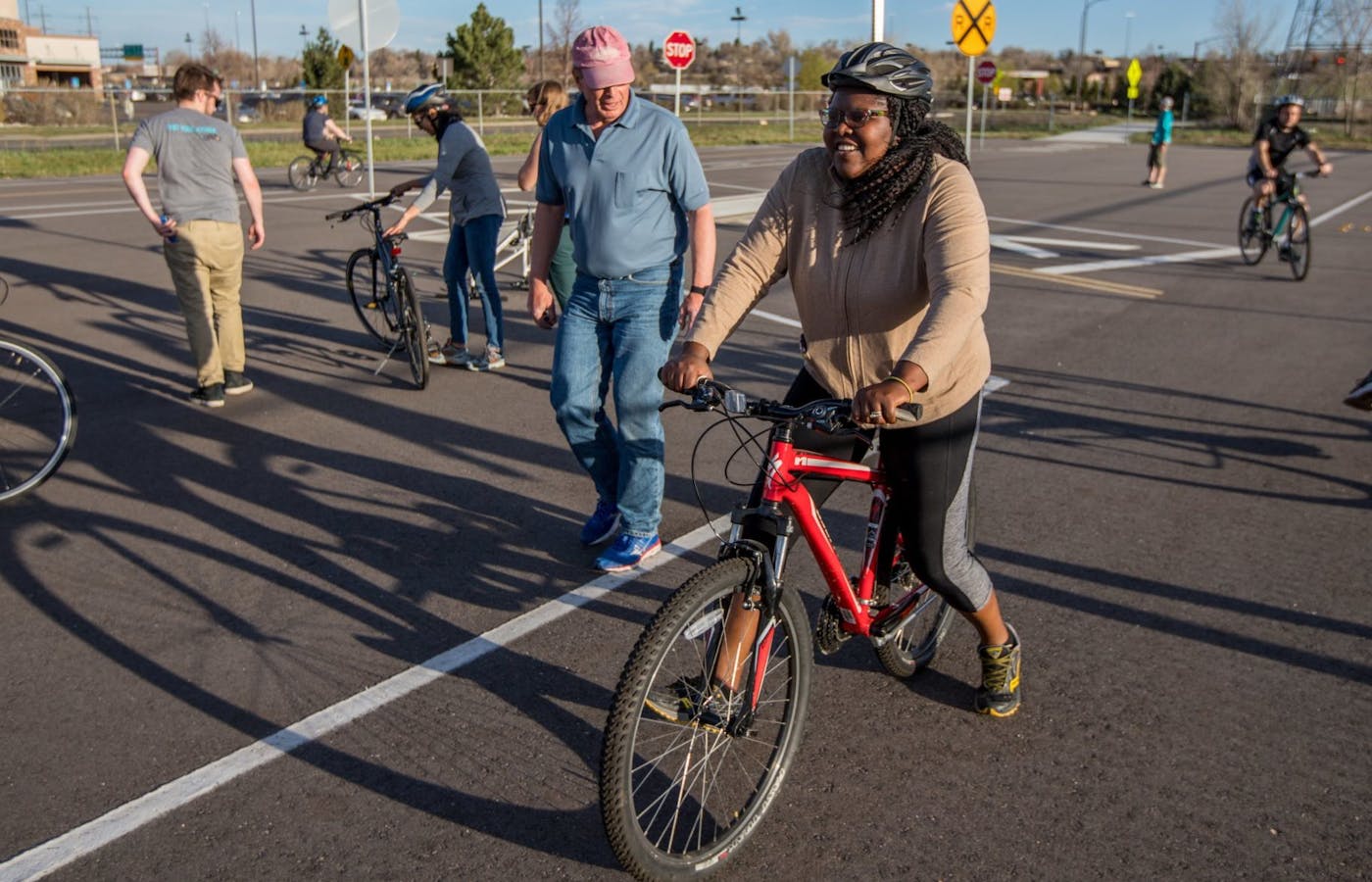
First Ride: Teaching Adults to Bike
March 22, 2022
A new educational series from nonprofit Trailblazers + ETHIC seeks to ensure every adult in Northwest Arkansas can ride if they want to. ...
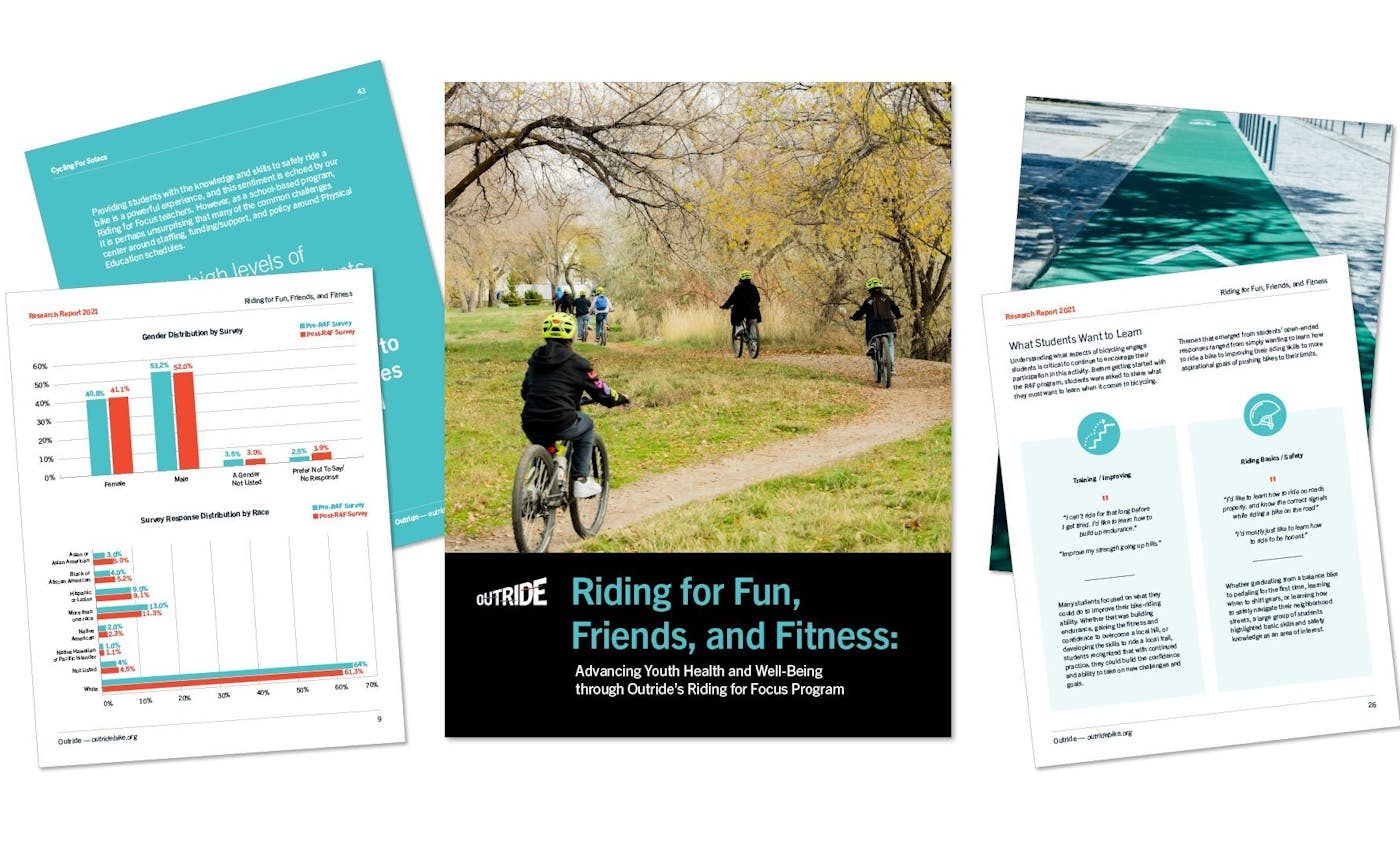
The Health Benefits of Biking for Youth
March 17, 2022
Learn how kids in Outride’s Riding for Focus program are pedaling for social, emotional, and cognitive well-being. ...

What Makes a Good Electric Bike Incentive Program?
March 7, 2022
Researchers created a table tracking every e-bike incentive program in North America, providing a point of reference for new policies and future research. ...
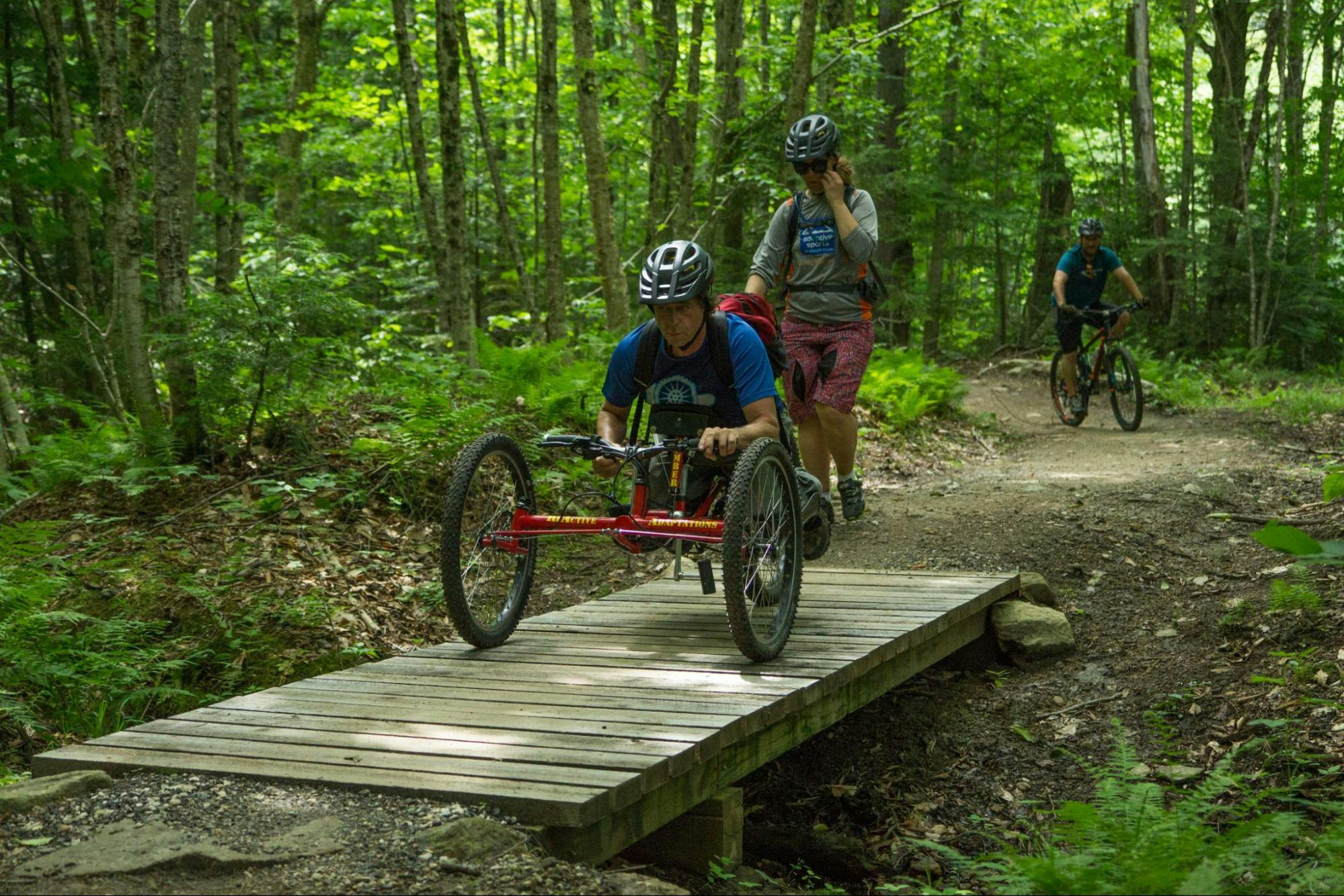
Electric Mountain Bikes Reconnect Riders With Disabilities With the Outdoors
March 2, 2022
Nonprofit Move United is dedicated to improving the off-road experience for riders with disabilities, both with a library of adaptive bikes and improved trail resources. ...

Safe Trails Are Happy Trails
March 2, 2022
The ongoing bike boom underscores the need for more and better places to ride. ...

Centering Youth Voices in Bike Advocacy
February 28, 2022
The National Youth Bike Council, a network of high school-aged advocates from around the U.S., is speaking up on behalf of young bicyclists everywhere. ...

PeopleForBikes Pushes for Trade Policy Relief
February 25, 2022
As Congress works towards a final, sweeping trade policy package, PeopleForBikes urges for the inclusion of tariff relief and other key programs for the bike industry. ...
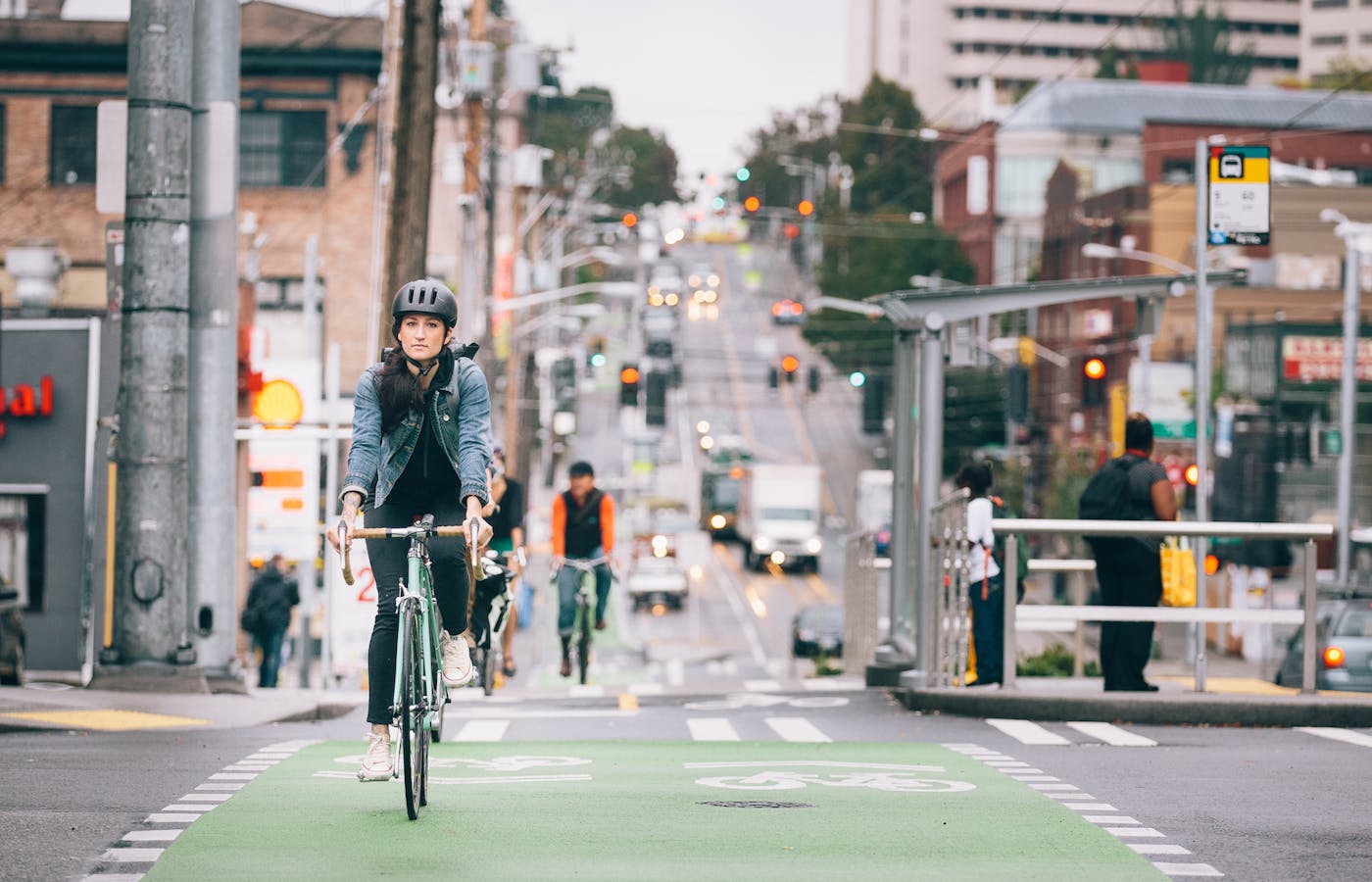
RAISE Grants Present Big Funding for Better Bike Infrastructure
February 25, 2022
U.S. DOT Announces 2022 RAISE Grant Cycle to fund infrastructure projects nationwide. ...

A Pro-Recreation Policy Package Is on the Horizon
February 25, 2022
New legislation in Congress could help identify 10 long-distance bike trails and invest in rural communities’ recreation potential. ...
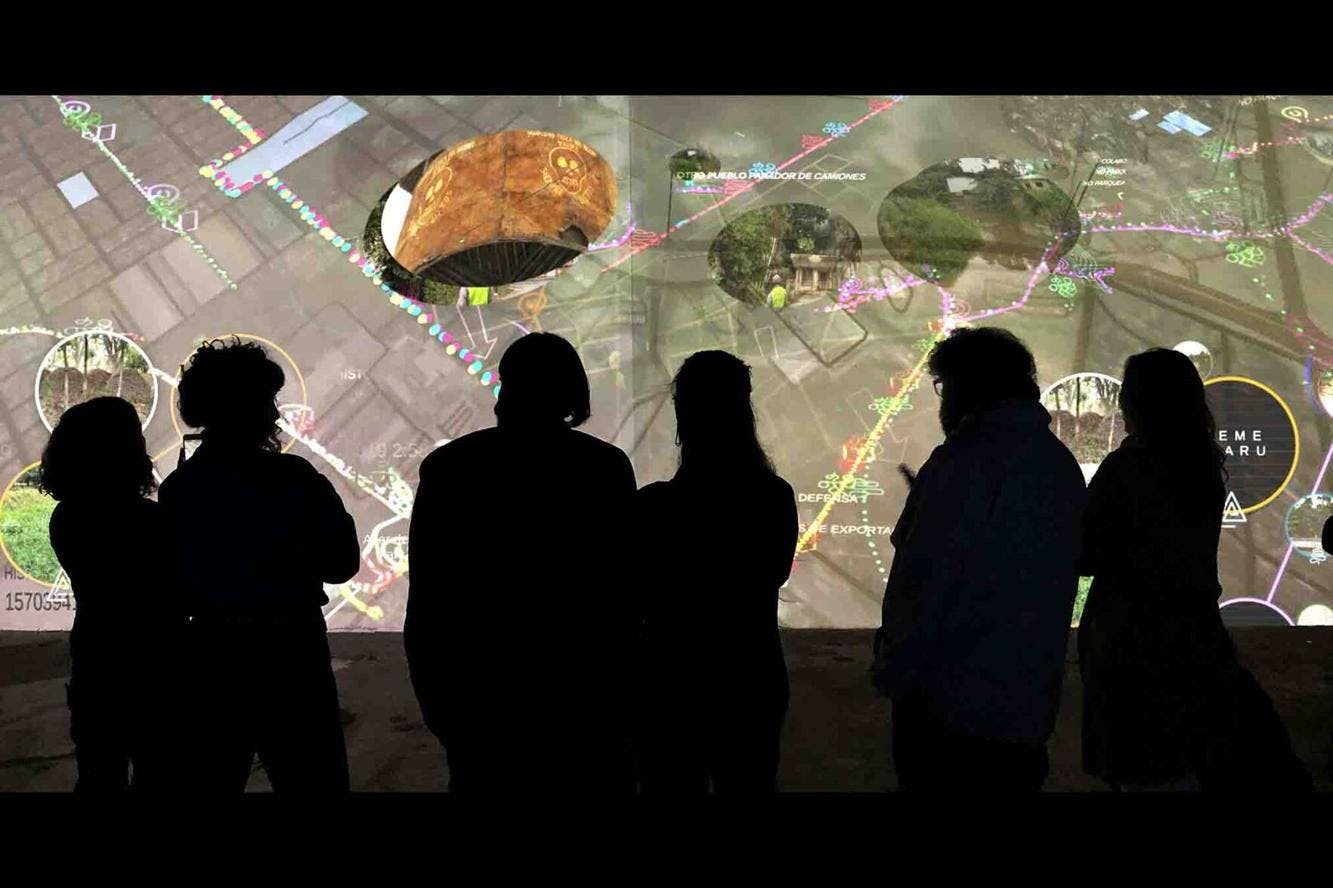
L.A. Researchers Hope to Make ‘Bikepooling’ a Thing
February 24, 2022
A $1 million National Science Foundation grantee aims to bring safety in numbers to underserved bike commuters, creating communal art in the process. ...

A Call to End Support for Pretextual Policing
February 22, 2022
PeopleForBikes and 70 other organizations signed a letter asking the DOT and DOJ to reconsider policies that undermine public safety and racial equity. ...

The History of the Bicycle Leadership Conference
February 11, 2022
For more than two decades, the BLC has gathered bicycling leaders to shape the future of the industry. ...
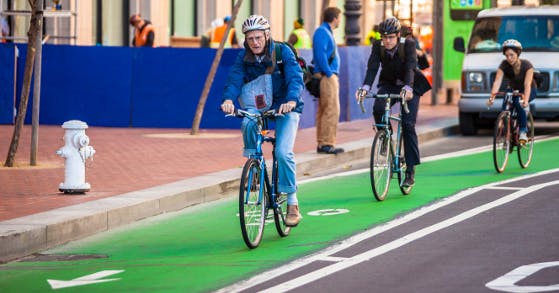
U.S. DOT Doubles Down on Road Safety
February 2, 2022
Transportation Secretary Buttigieg calls for zero road deaths with new National Road Safety Strategy. ...

Lessons From London’s Bike Surge
January 31, 2022
Pandemic-era changes to the built environment dramatically shifted the urban bike landscape. But if equity had been centered, would the numbers be higher? ...

The Wyoming City Centering Kids on Bikes
January 28, 2022
In Laramie, kids learn to ride bikes in middle school, and a combination of research and advocacy work ensures they remain engaged cyclists into adulthood. ...
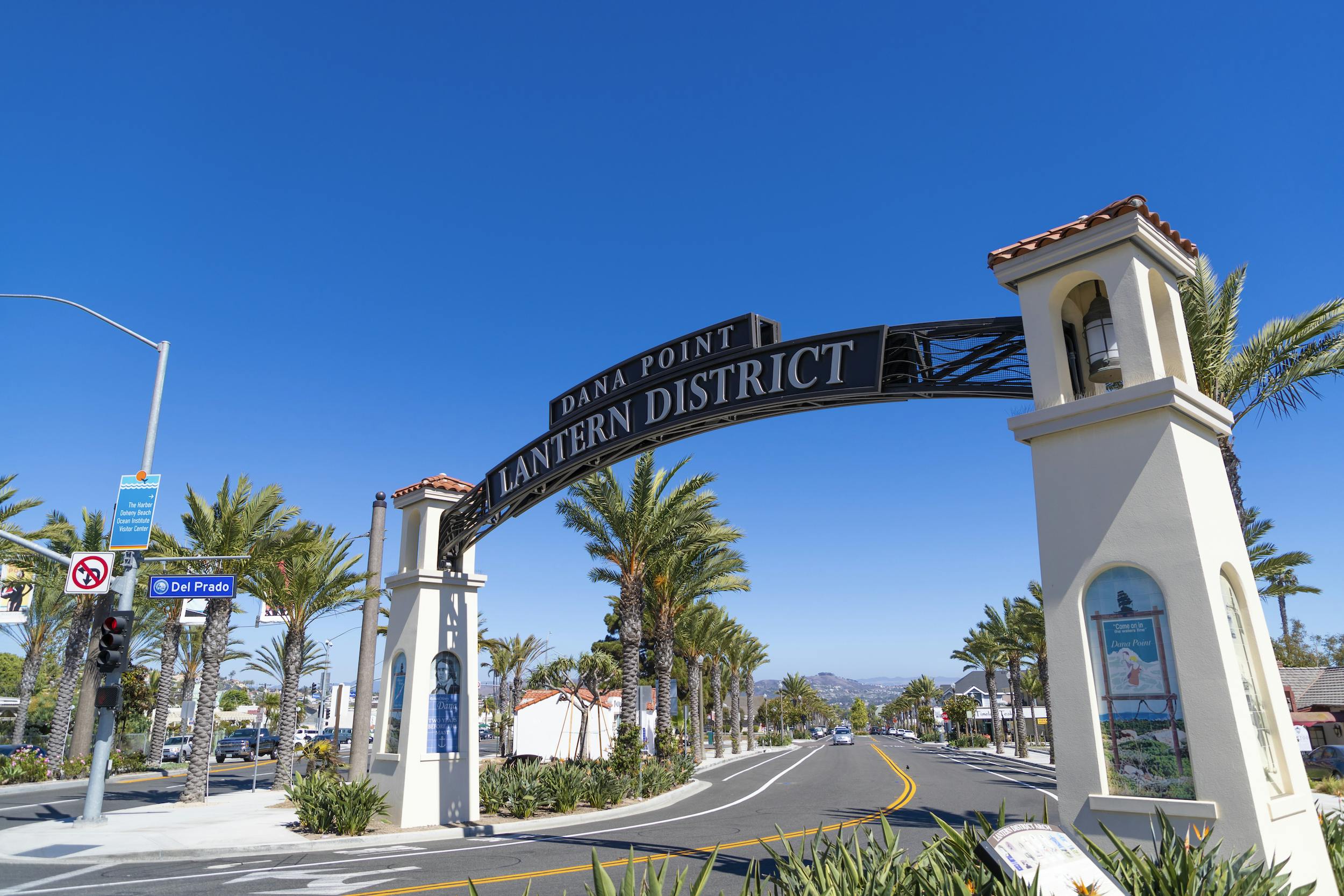
BLC — Dana Point Has Something for Everyone
January 24, 2022
Come early, stay late — Dana Point has it all. ...

Electric Bicycles and Safety Technology Could Shift the Future of U.S. Transportation
January 20, 2022
PeopleForBikes recently presented on the vast potential of electric bicycles at the 2022 CES trade show. ...
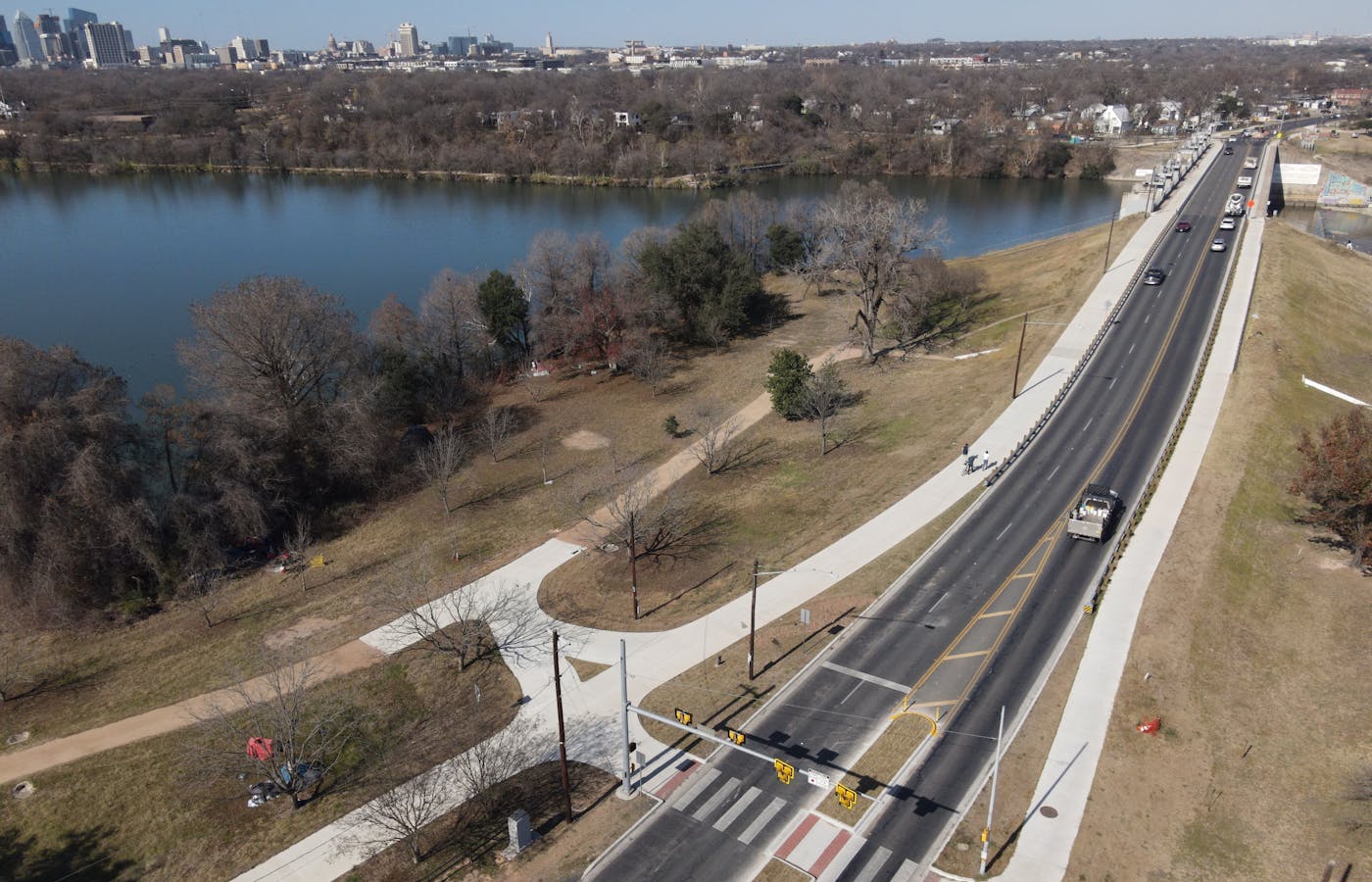
Five of the Best New Bikeways
January 14, 2022
These 2021 builds are all more than just bike lanes — they represent political wins, Complete Streets projects and crucial connections that make up comprehensive bike networks. ...

PeopleForBikes’ 2021 Must-Reads
January 6, 2022
In case you missed them, here are 12 of our most important stories from last year. ...

Exciting Times To Go Even Bigger for Bikes
January 3, 2022
This op-ed was originally published in the January 2022 issue of BRAIN. ...

Five Ways PeopleForBikes Is Working to Boost Recreational Bike Riding
December 17, 2021
Recreational bicycling is an increasingly popular activity and an area in which PeopleForBikes works to grow everyday. ...

PeopleForBikes' Coalition Board Looks to the Future
December 15, 2021
In December, our Board of Directors met to review PeopleForBikes' strategic initiatives for 2022 and beyond. ...

Announcing Our Fall 2021 Industry Community Grant Awards
December 14, 2021
PeopleForBikes’ latest round of Industry Community Grants funded $55,000 for seven different bike projects across the U.S. ...
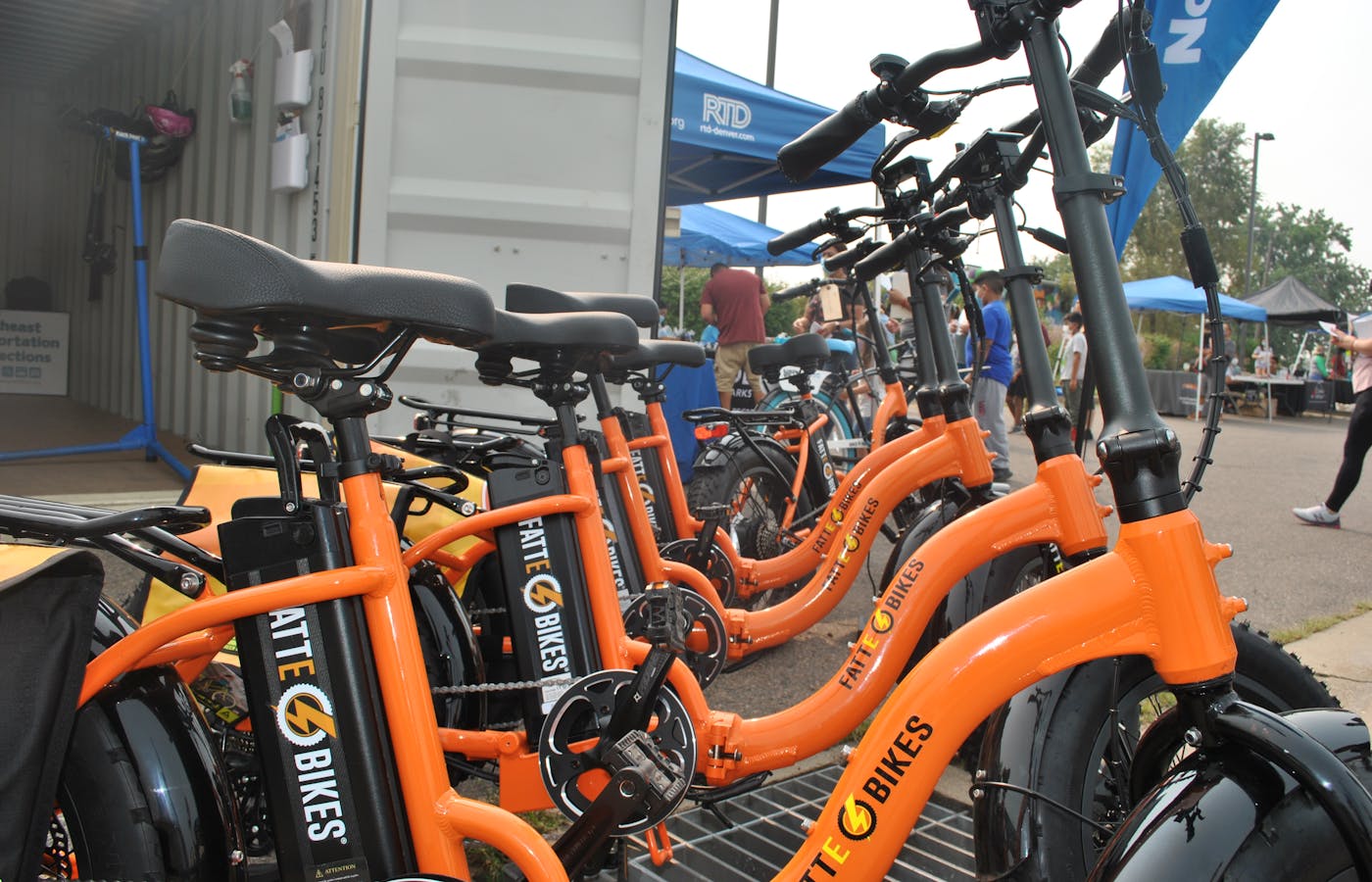
Electric Bicycles for All!
December 14, 2021
From Colorado to Canberra, e-bike libraries are on the rise and helping break down traditional barriers to riding. ...
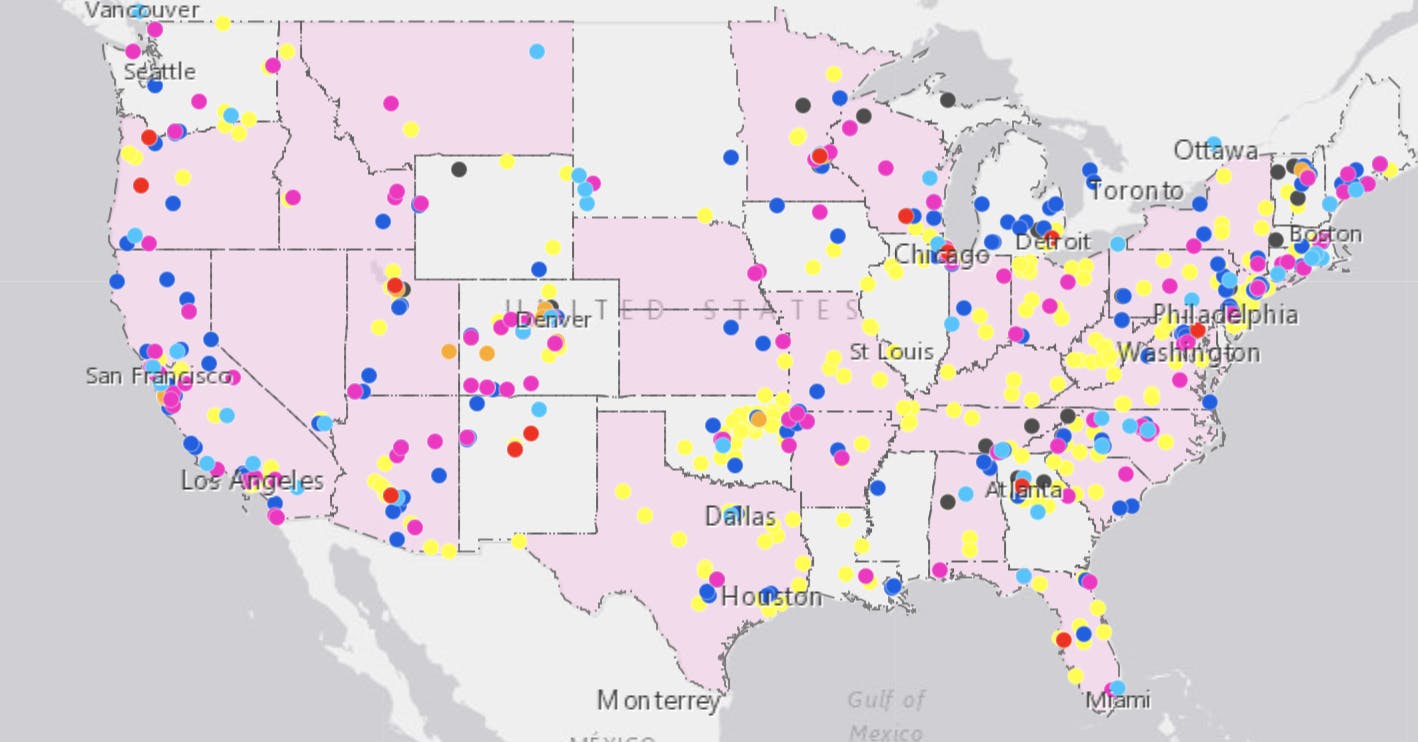
Mapping Youth Bike Programs in the U.S.
December 8, 2021
A new comprehensive mapping project from Outride and PeopleForBikes shows the nationwide locations of eight youth bicycling programs. Is there one near you? ...
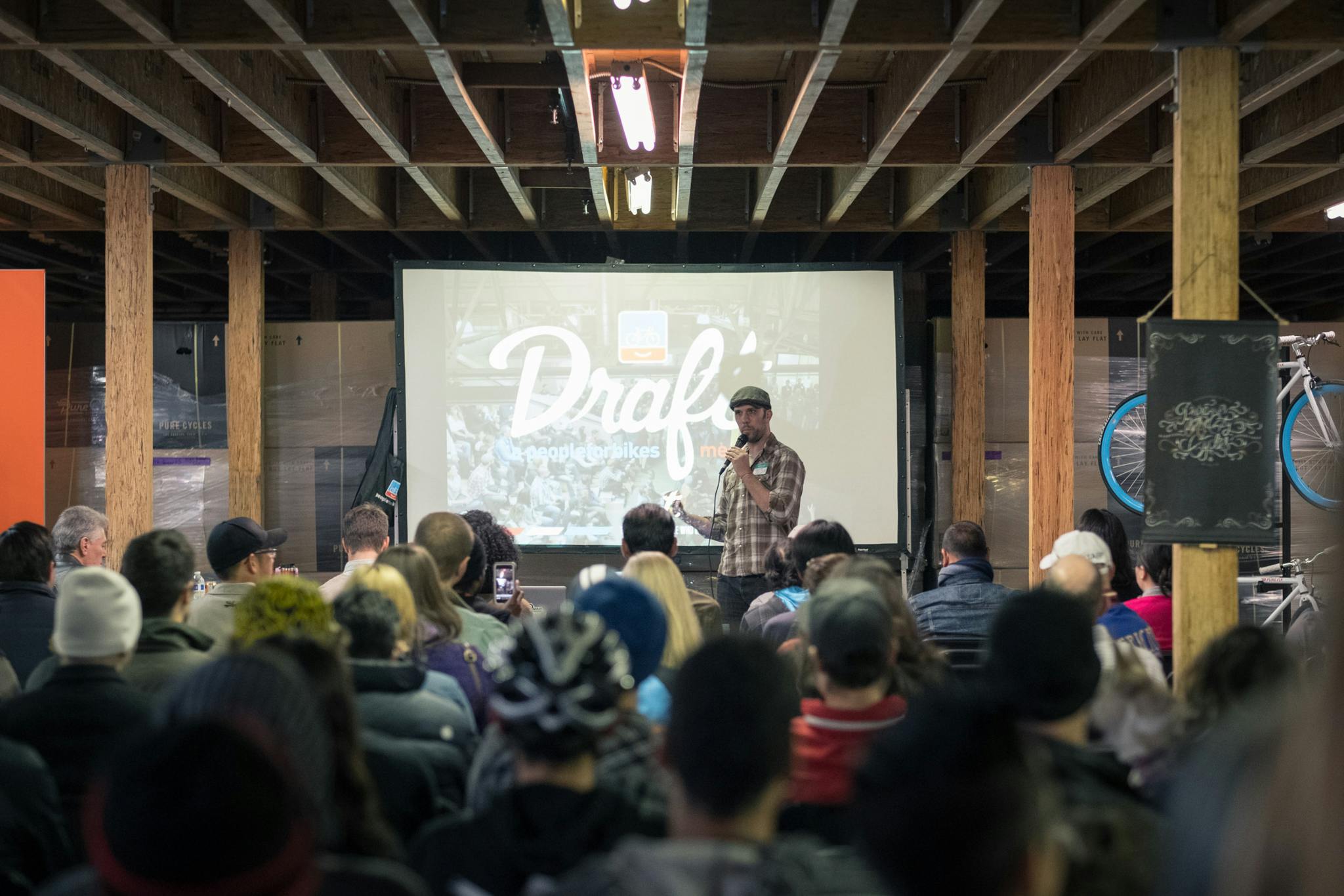
2022 Bicycle Leadership Series: Together, Better Than Ever
December 8, 2021
The 2022 PeopleForBikes' collection of education and networking events is largely in-person, designed to bring the industry together and help shape our collective future. After nearly two years of trying to sustain a sense of community across the bike industry with Zoom breakout rooms, virtual happ ...
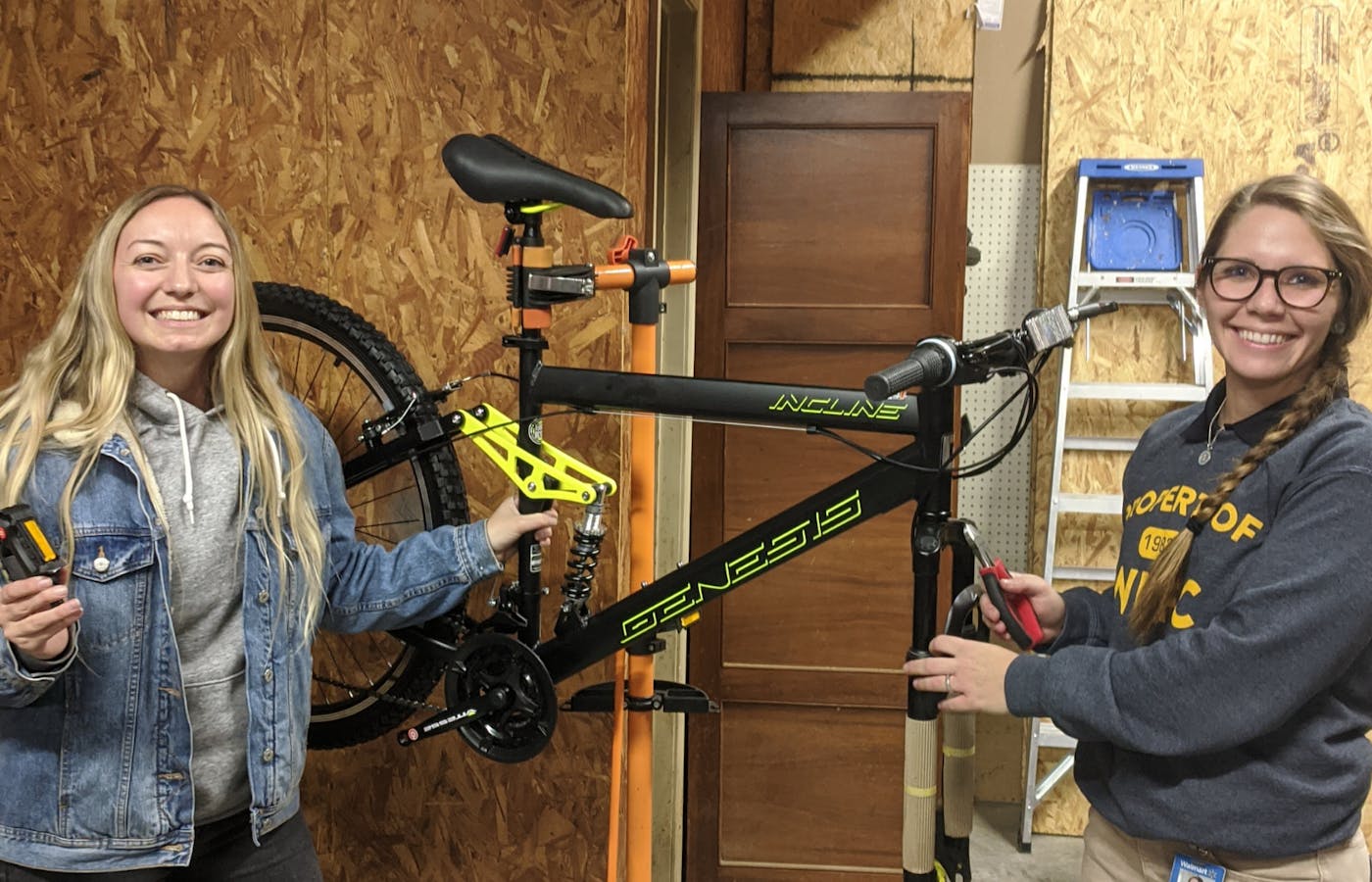
Pedal It Forward
December 7, 2021
In Northwest Arkansas, employees at J.B. Hunt and Walmart are volunteering to fix up bikes for community members in need. ...

The Limits of Rural Mobility
December 6, 2021
Marcela Moreno, a 2021 Transportation Justice fellow, discusses the ways transportation (or lack thereof) impacts rural communities — and what needs to be done. ...

Better Bike Policy Can Prevent Deaths
December 3, 2021
Research out of Colorado State University highlights how comprehensive mode shift could prevent more than 15,000 deaths a year—and not just in crashes. ...

Building Momentum for Pro-Recreation Policy
December 1, 2021
On Dec. 1, the U.S. Senate will hold a hearing to consider a slate of bills that could advance public lands and recreation access, permitting and development, with big opportunities for bikes. ...
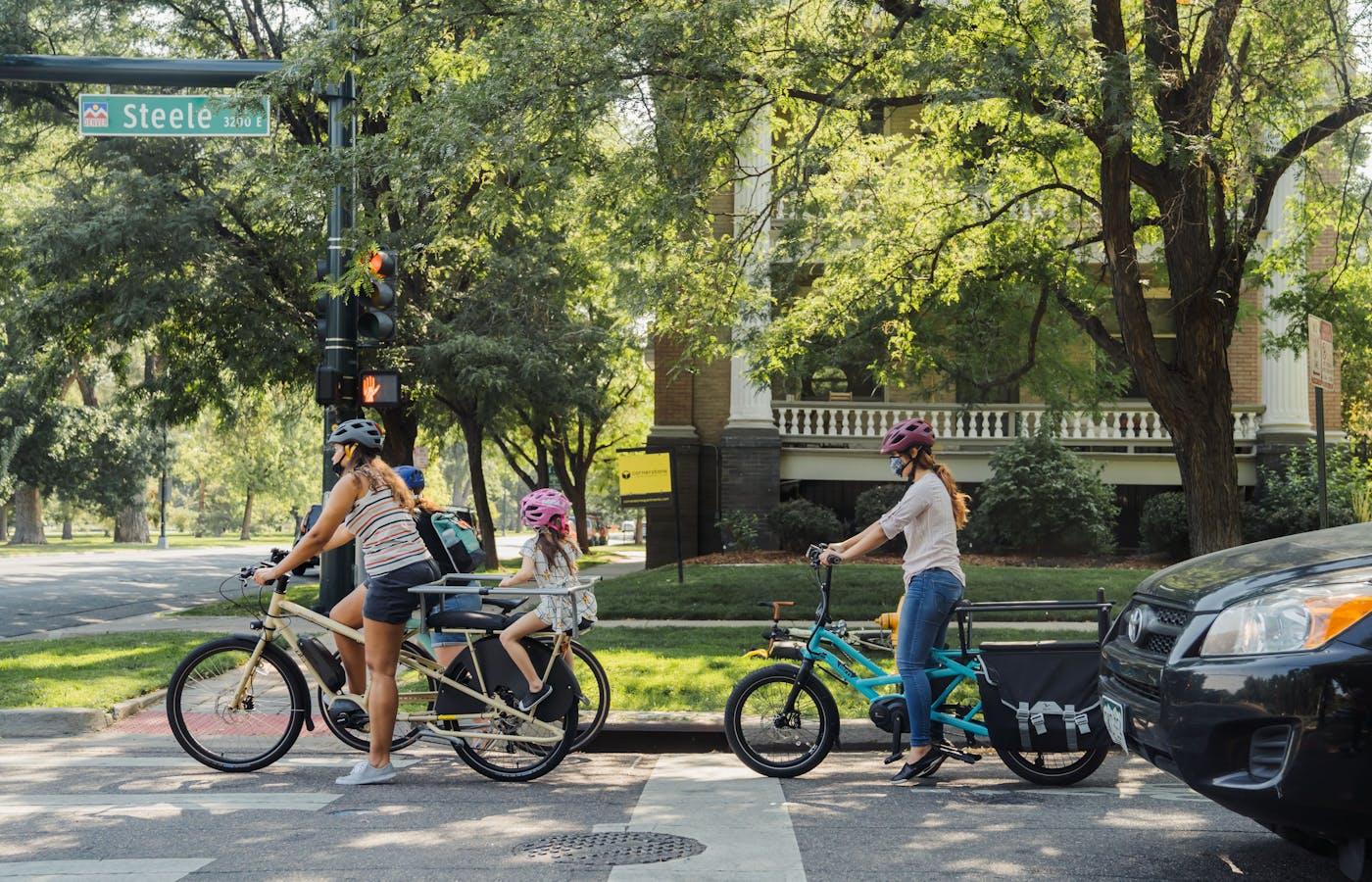
The Argument for Bikes-for-Clunkers Programs
November 30, 2021
Our current environmental predicament demands unconventional ideas and bold action across the board. ...

House Votes YES on Billions for Bike Incentives and Infrastructure in Build Back Better Act
November 19, 2021
A closer look at the bike provisions included in the Build Back Better Act and the political landscape ahead. ...

Ride for Gratitude and the Navajo Nation
November 12, 2021
In celebration of Native American Heritage Month, our November Ride Spot Challenges are raising money for Silver Stallion, a bike nonprofit serving Dinétah. ...
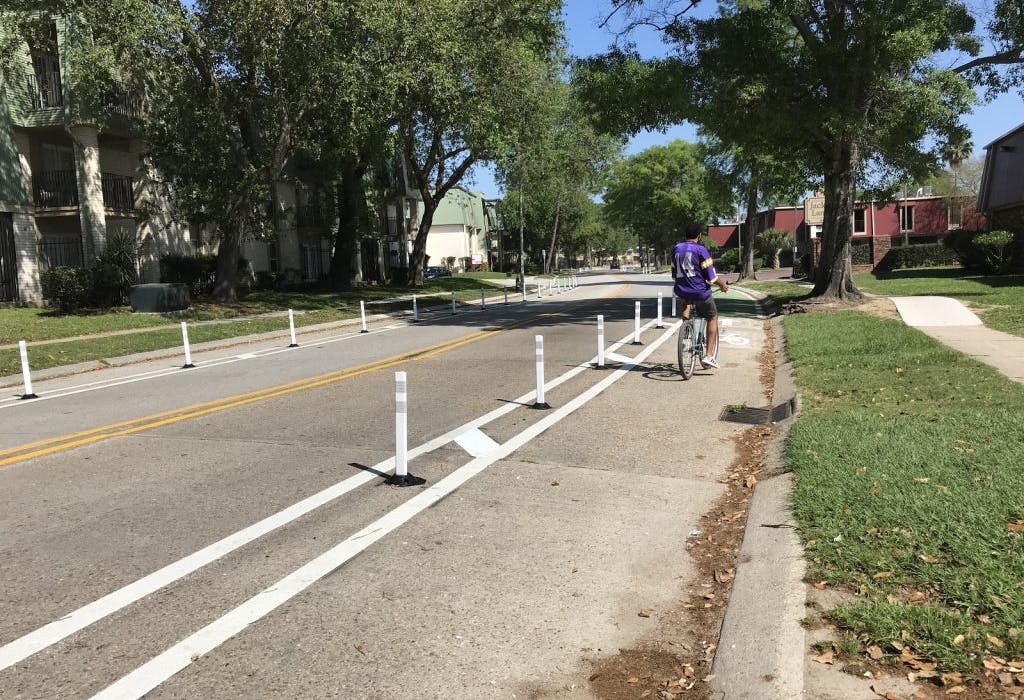
New Orleans' Bicycle Equity Index
November 10, 2021
In 2019, the Crescent City joined forces with Toole Design to let equity lead in the planning of its bike network. ...

Biking Where Black
November 8, 2021
A new study shows that areas with less bike infrastructure experience disproportionate ticketing, compounding the effects of racially biased policing and transportation policies. ...
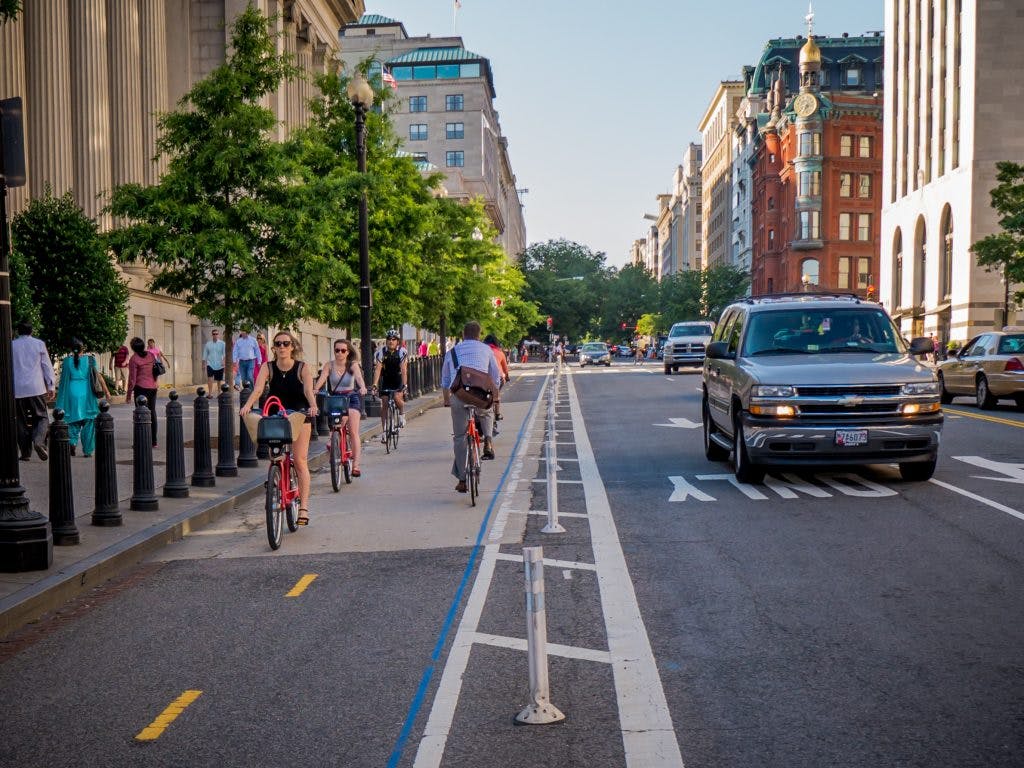
Billions in Funding Advanced for Bikes in Federal Votes on Infrastructure and Reconciliation Bills
November 8, 2021
The $1 trillion Infrastructure Investment and Jobs Act and $1.75 trillion Build Back Better Act offer big funding for bikes nationwide. ...

Austin Will Be America’s Next Great Biking City
November 1, 2021
Over the last two years, the Texas capital accelerated the buildout of its all ages and abilities bike network, building more than 100 new miles with no signs of slowing down. ...
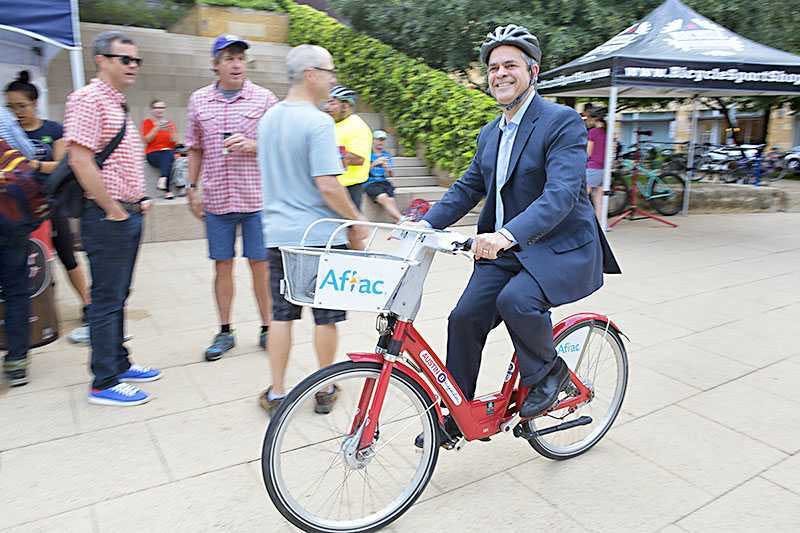
In Texas, A Bike Network Gets Bigger
October 29, 2021
An interview with Austin Mayor Steve Adler on the city’s ambitious, 400+ mile bike network. ...
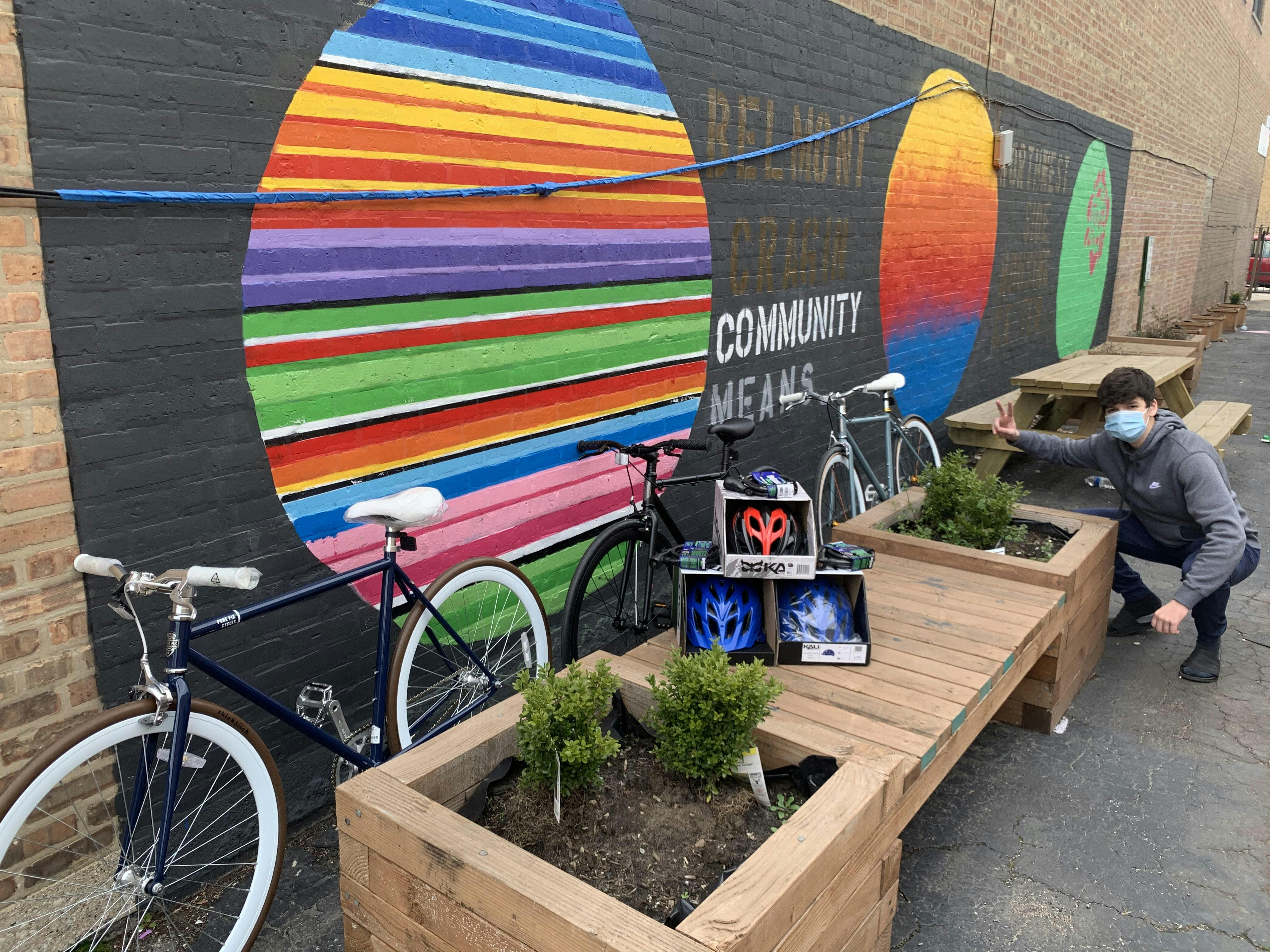
Investing in Community
October 26, 2021
Building inclusive bicycling ecosystems means supporting youth and working from the inside out. Two nonprofits — the Northwest Center and Outride — are committed to doing just that. ...

PeopleForBikes Renews Partnerships With International Mountain Bicycling Association and National Interscholastic Cycling Association
October 24, 2021
PeopleForBikes is the national organization that supports every kind of bicycling. Whether it’s on road or dirt, or for recreation, transportation or competition, in every state across the country, PeopleForBikes works to make biking better for everyone. That’s why we’re delighted to announce our re ...
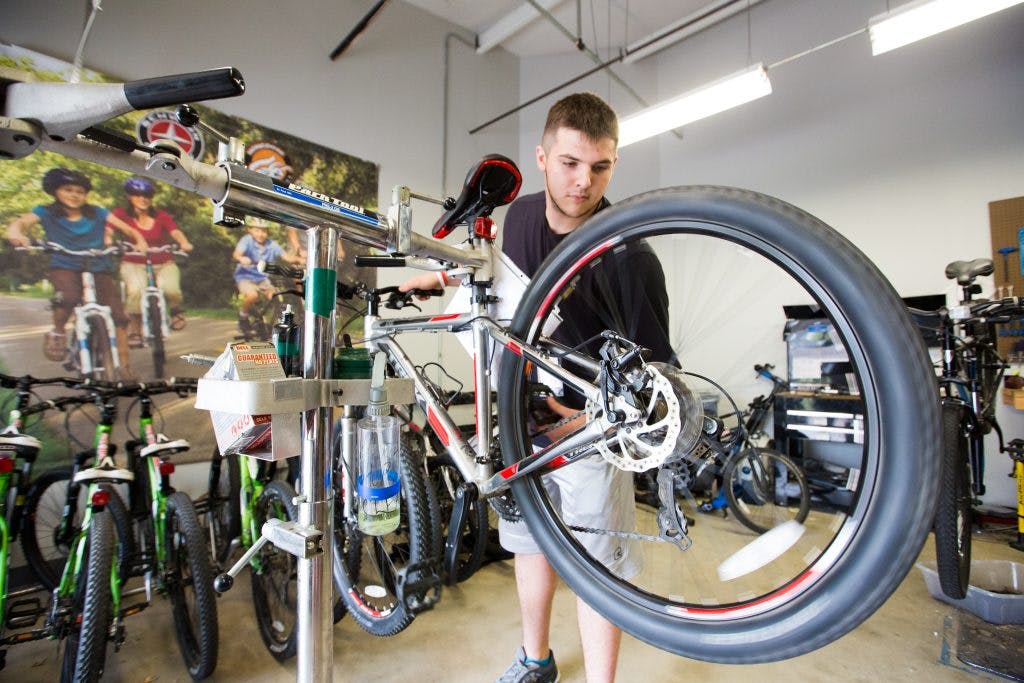
Increasing Awareness and Education About the Benefits of Electric Bicycles
October 13, 2021
PeopleForBikes staff are amplifying the many environmental and social solutions e-bikes offer at several events this fall. ...

Planning’s Disability Blindspot
October 4, 2021
All cities should strive to serve everyone, people with disabilities included. Unfortunately, the latter is all too often left out of the planning process. ...

Meet the Rider Improving Access for Disabled Mountain Bikers
September 29, 2021
Jeremy McGhee is on a mission to ride and document every mountain bike trail in Northwest Arkansas, opening up the landscape for those who can’t ride a traditional bike. ...

Promoting Equity and Climate Action Through Bike Infrastructure
September 27, 2021
A bill advanced in the House Transportation and Infrastructure Committee could provide big dollars for bike infrastructure projects. ...

Climate Change Demands More Bike Advocates
September 21, 2021
When it comes to environmental solutions, all too often the onus is put solely on the individual. It’s time for all bicyclists to become advocates and demand institutional action. ...

Tackling Climate Change One Ride at a Time
September 20, 2021
Research proves that bikes can help lower our carbon emissions, and making a difference might not be as difficult as we think. ...
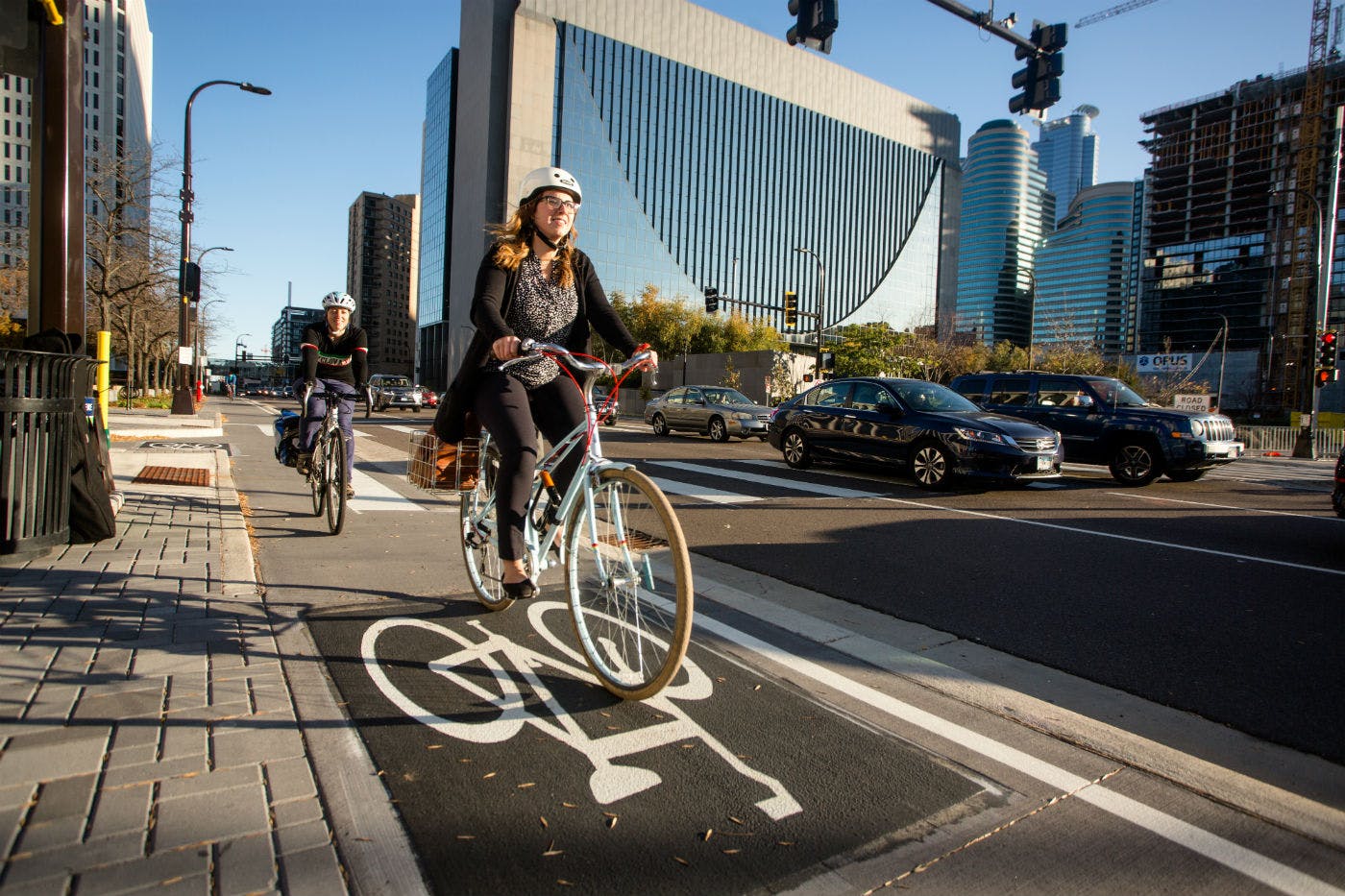
Five New State Laws Seeking to Combat Climate Change Through Bikes
September 16, 2021
New legislation recognizes the power of bikes to help reach climate action goals ...
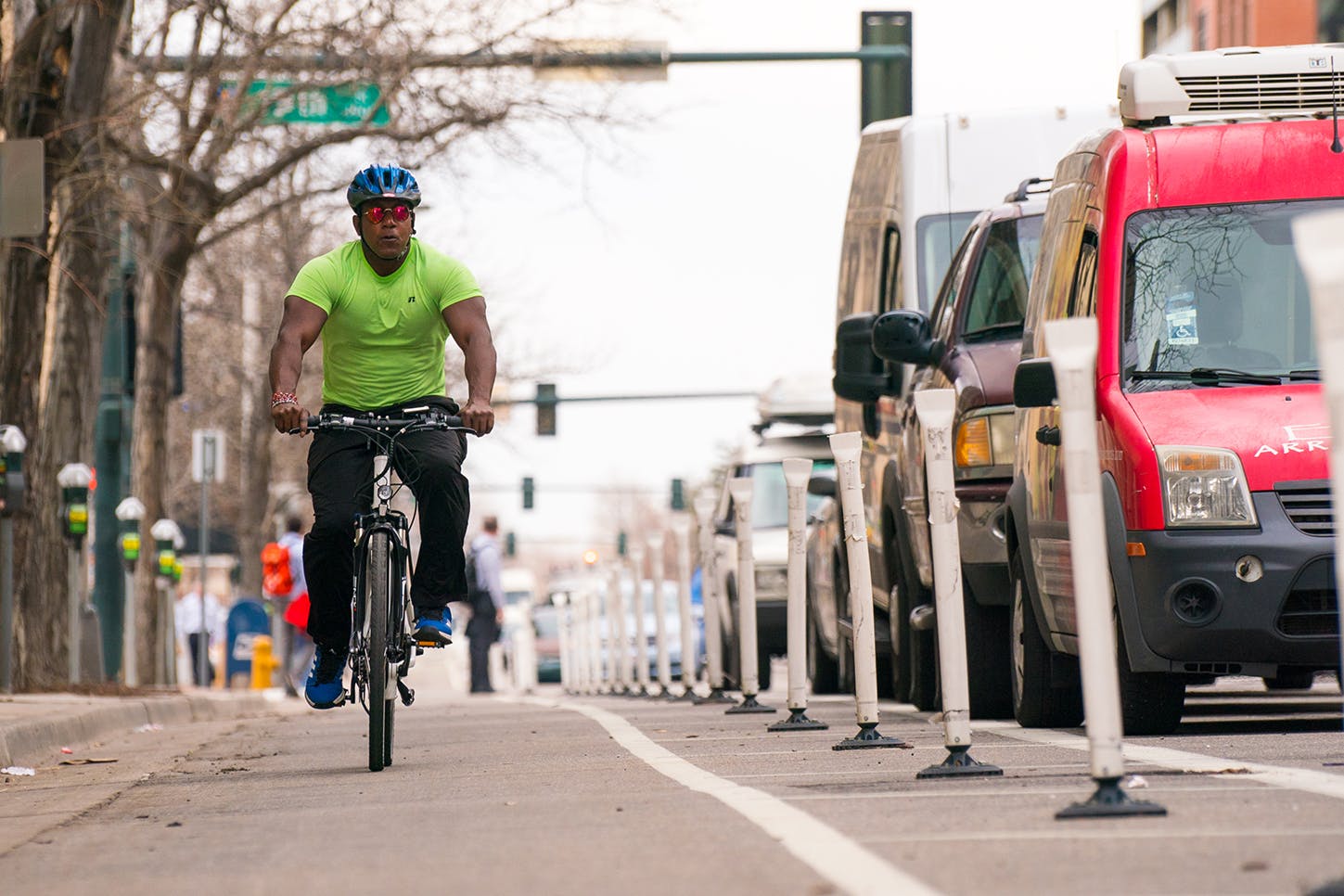
Incentivizing Bicycling Is Climate Policy
September 14, 2021
A consumer rebate for electric bicycles and a commuter benefit for biking to work aren’t just tax policy, they’re climate policy. ...
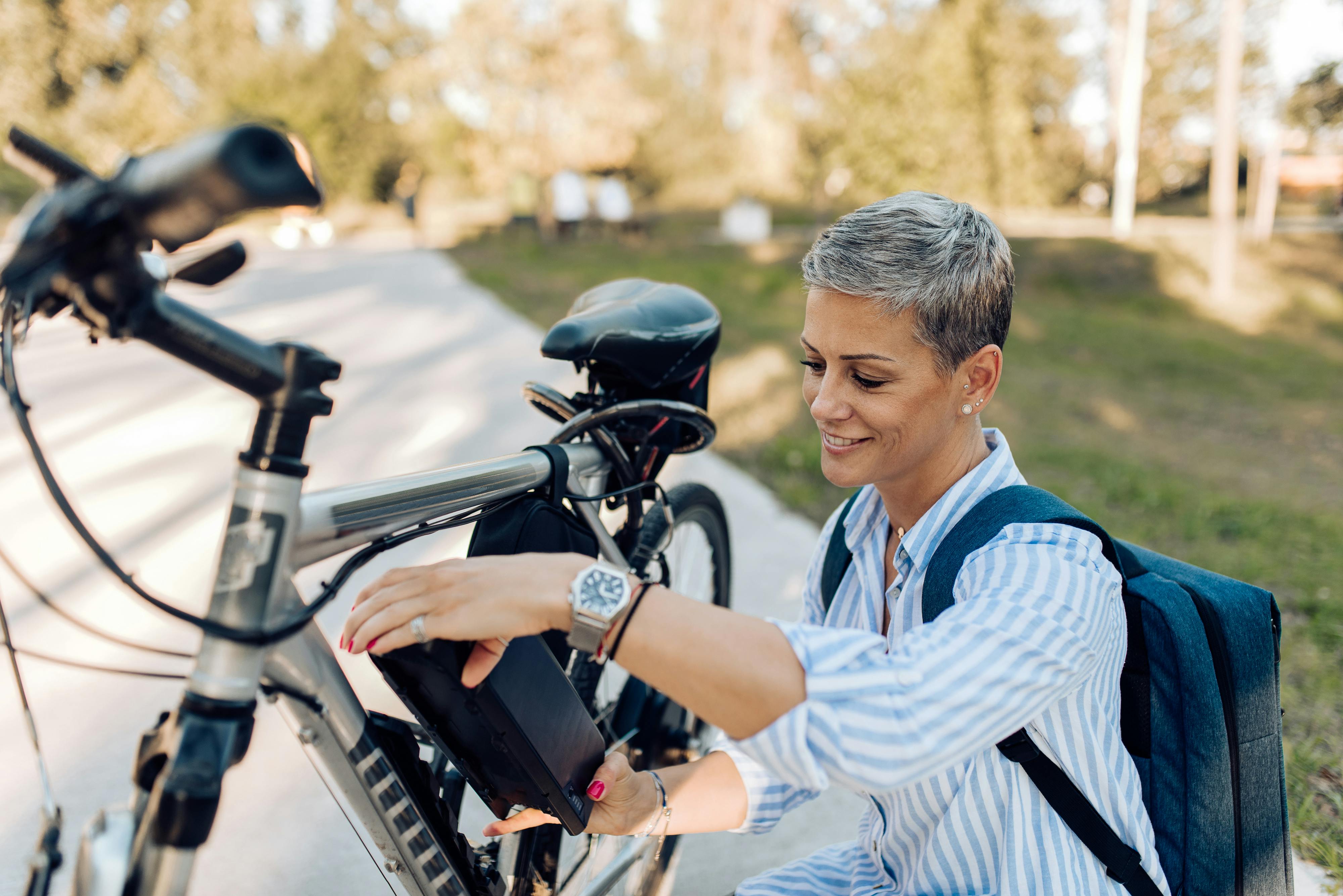
House Committee Advances Electric Bicycle Tax Credit and Bike Commuter Benefit
September 14, 2021
A closer look at the approved bike provisions in the Build Back Better Act and the political landscape that can get them signed into law. ...

Bikes Are a Climate Solution
September 14, 2021
Riding a bike won’t solve the climate crisis alone, but its potential to reduce carbon emissions, improve public health and foster sustainable communities are all big steps towards a cleaner future. ...
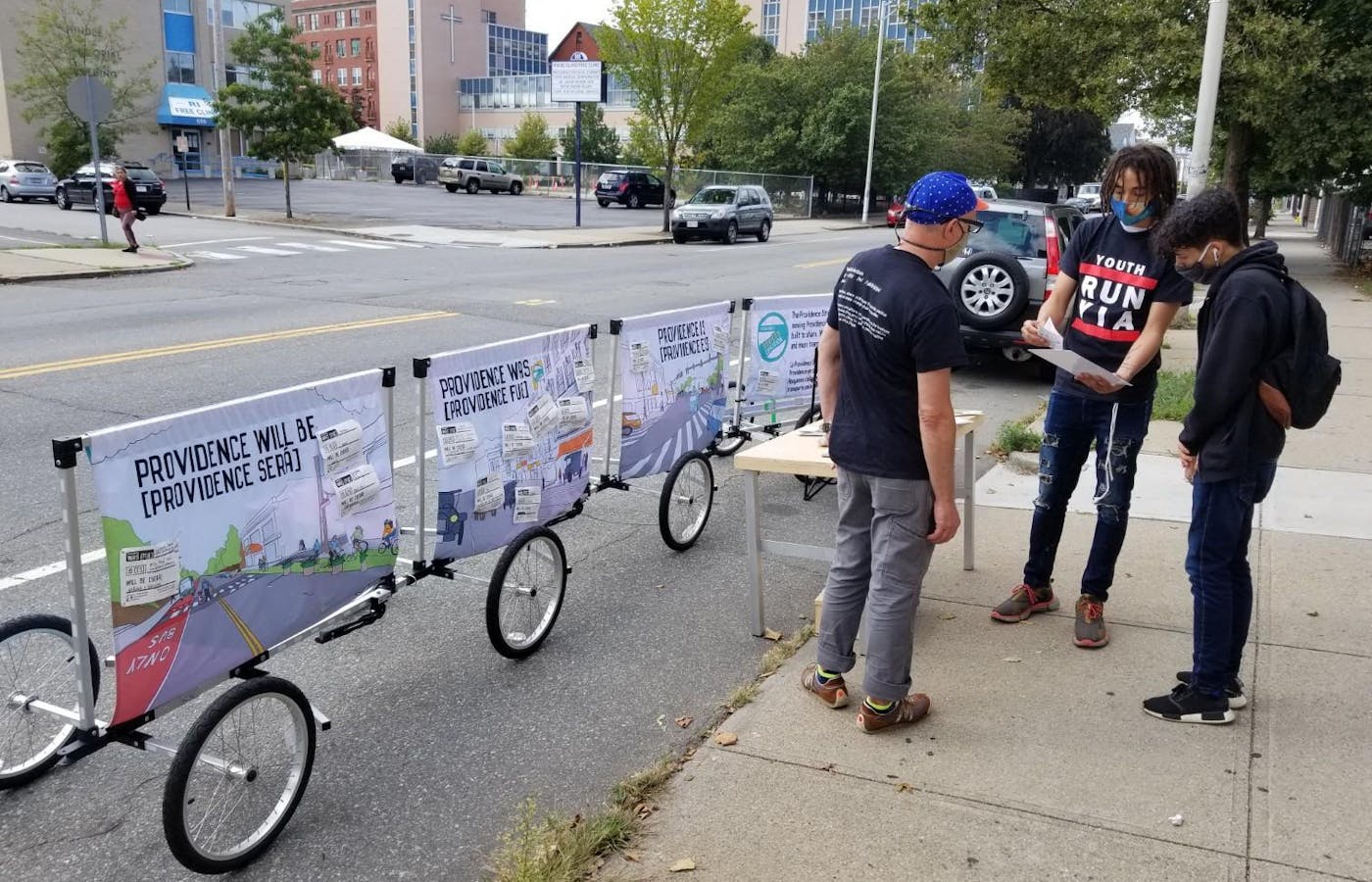
Inclusion on Main Street
September 13, 2021
A 1.5-mile stretch of Broad Street in Providence, Rhode Island, is slated for a holistic mobility upgrade and community engagement is an integral part of the plan. ...

What the Growth of Black Peloton Can Teach Bicycling
September 7, 2021
The stationary bike and exercise company offers potent lessons when it comes to fostering safety, comfort and community for BIPOC riders. ...

The ‘Bike Boom’ Isn’t Just for Adults
September 2, 2021
The future of kids’ bicycling appeared dire until the pandemic hit. Now, a new generation of bicyclists is emerging. ...

How Movement on Trade Policy Is Affecting the Bike Industry
August 25, 2021
An update on PeopleForBikes' federal trade and tariff work. ...

Learnings From the 2021 Outride Research Summit
August 16, 2021
The virtual gathering highlighted evidence-based ways to advance youth and community well-being through bicycling. ...
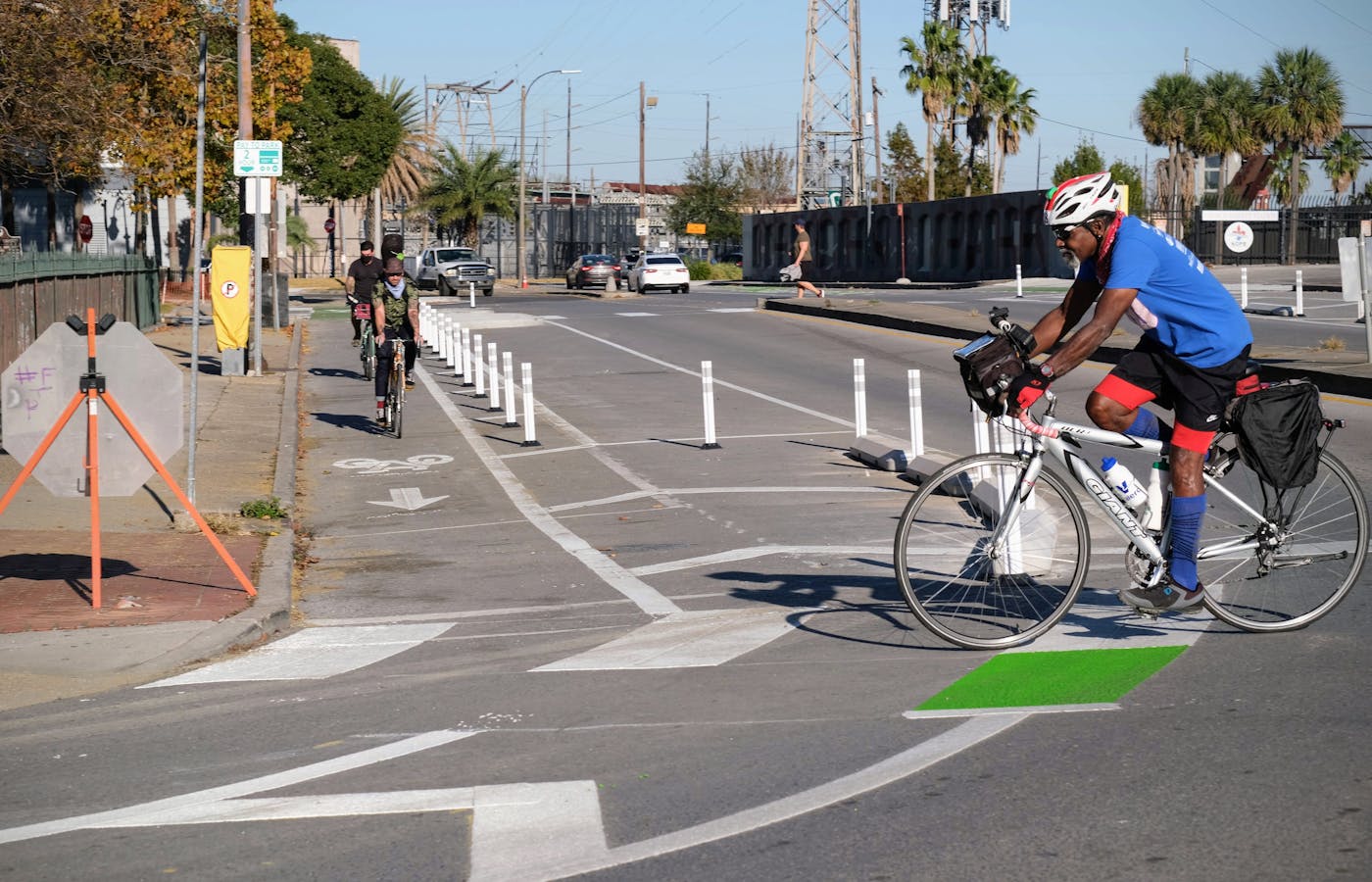
A Snapshot of Bicycling in 78 U.S. Cities
August 13, 2021
We culled the responses from our annual survey for city officials, painting a more nuanced picture of bicycling at the local level. ...

Does America Have a Big Bike Ego?
August 11, 2021
Unlike their European counterparts, Americans appear to have inflated perceptions about the state of bicycling in the U.S. ...

In Northwest Arkansas, You Can Go to College for Bikes
August 10, 2021
A first-of-its-kind program is launching in Bentonville with scholarships available for BIPOC and LGBTQ students. ...

What Is the Bipartisan Infrastructure Bill and What Could it Mean for Bikes?
August 4, 2021
If passed, the bill would advance the state of bicycle policy and funding in the U.S. but leaves opportunities for bold, transformative action on the table. ...
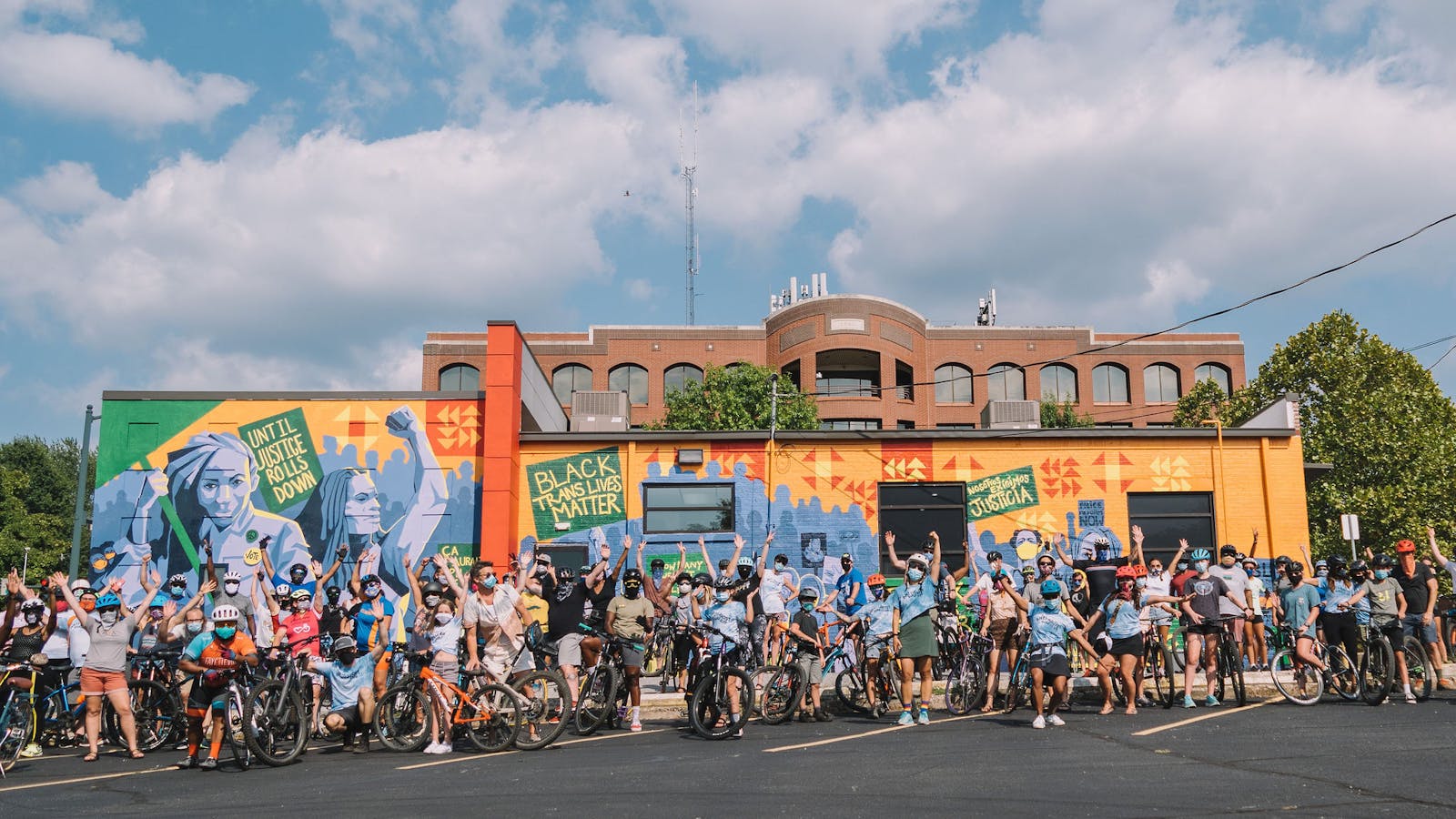
Critical Mass: A Summit Empowering All Women
July 19, 2021
Bicycling organizations in Northwest Arkansas are joining together for this inaugural event, taking place virtually and in-person from July 23-24. ...

The Making of a Bike Ecosystem
July 15, 2021
In Arizona’s Verde Valley, PeopleForBikes and other partners are coming together to create a community hub for mountain biking. ...
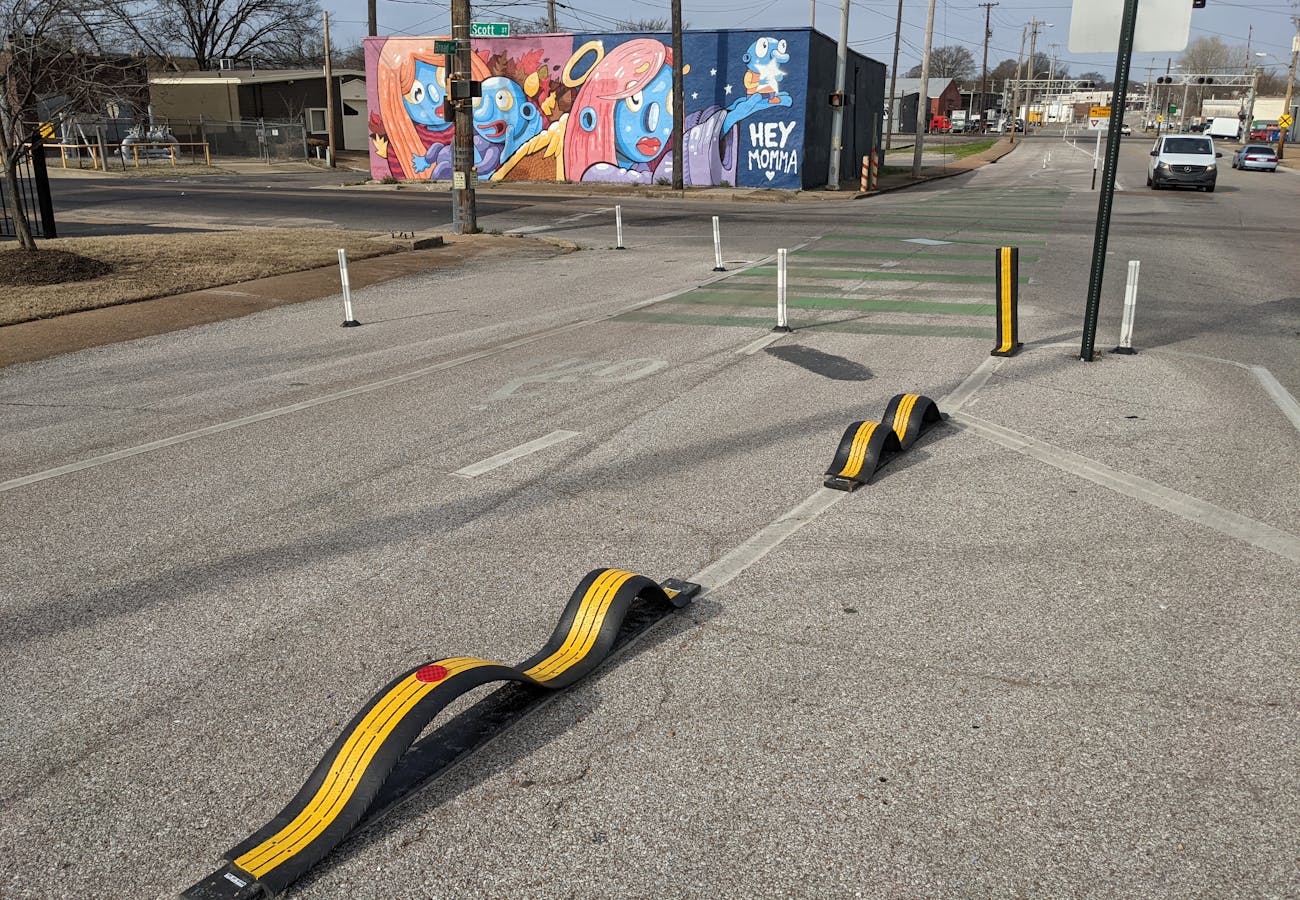
Introducing Our Spring 2021 Community Grants Recipients
July 2, 2021
We recently awarded $50,000 to eight projects across eight states through our spring Industry Community Grants Program. ...

The 2021 Outride Research Summit
July 1, 2021
On July 28, tune in for evidence-based ways to advance youth and community well-being through bicycling. While the event is totally free, registration is required. ...

The Unintended Consequences of Bike Laws
June 25, 2021
In King County, Washington, a coalition of advocates is fighting to repeal a helmet mandate that disproportionately harms BIPOC and homeless cyclists. ...
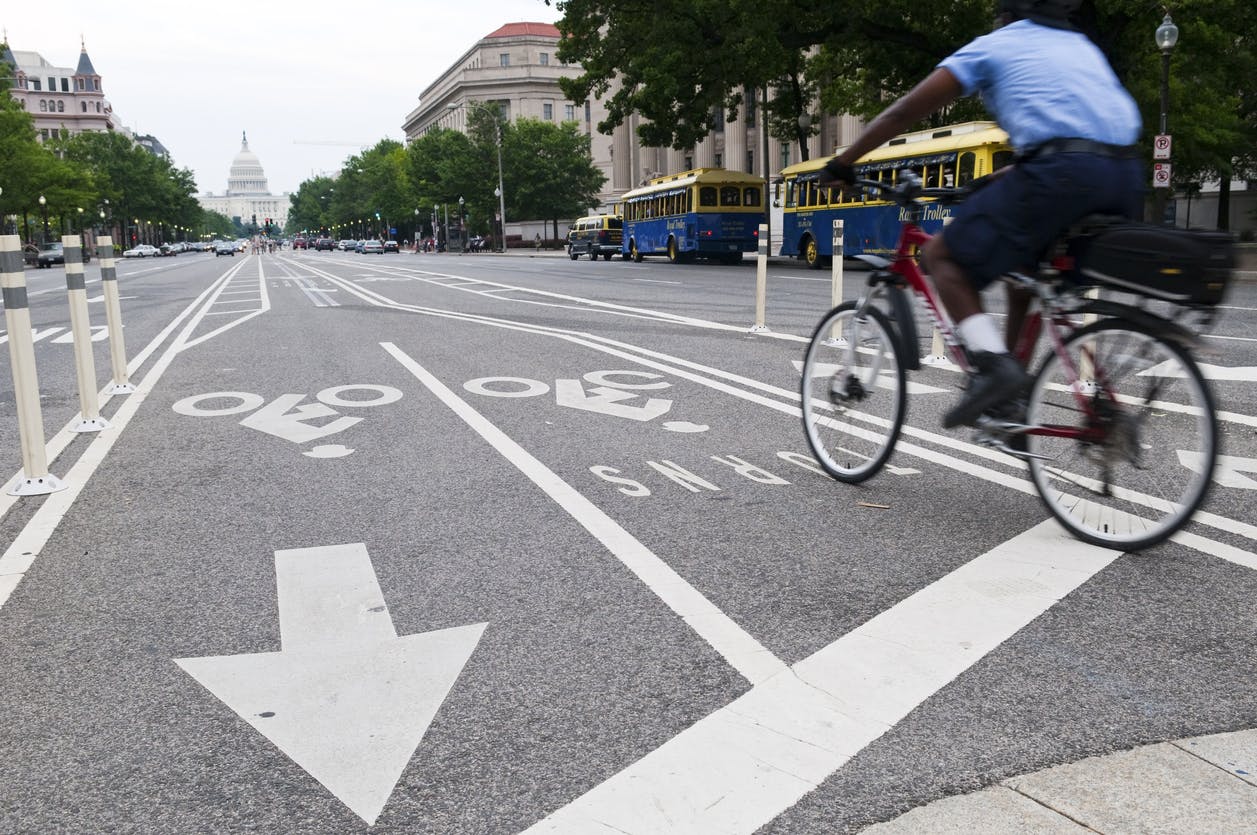
PeopleForBikes’ 2021 Mid-Year Legislative Recap
June 23, 2021
A quick update on pro-bike policies from across the U.S. ...

There's Something for Everyone in the E-BIKE Act
June 23, 2021
Bicyclists and non-riders alike will benefit from the proposed legislation. ...
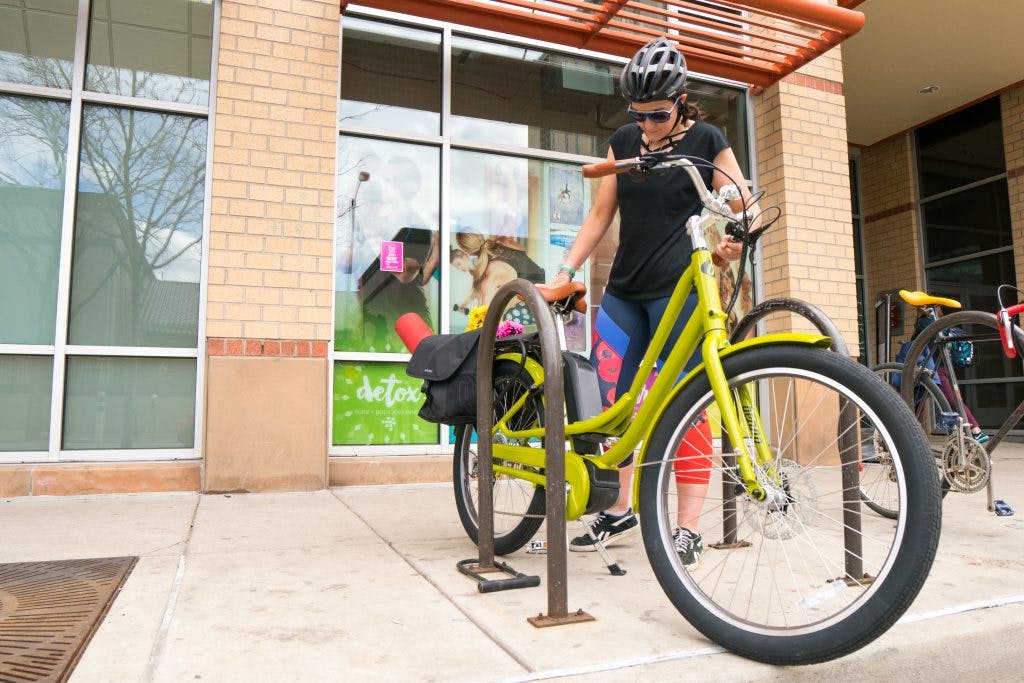
Model Electric Bicycle Laws Now in 36 States
June 23, 2021
Two-thirds of U.S. states now define and regulate electric bicycles in three-class system ...

Pivot Cycles Is Welcoming Refugees to America
June 17, 2021
The Arizona-based mountain bike company partnered with a local nonprofit to refurbish bikes for families in need. ...
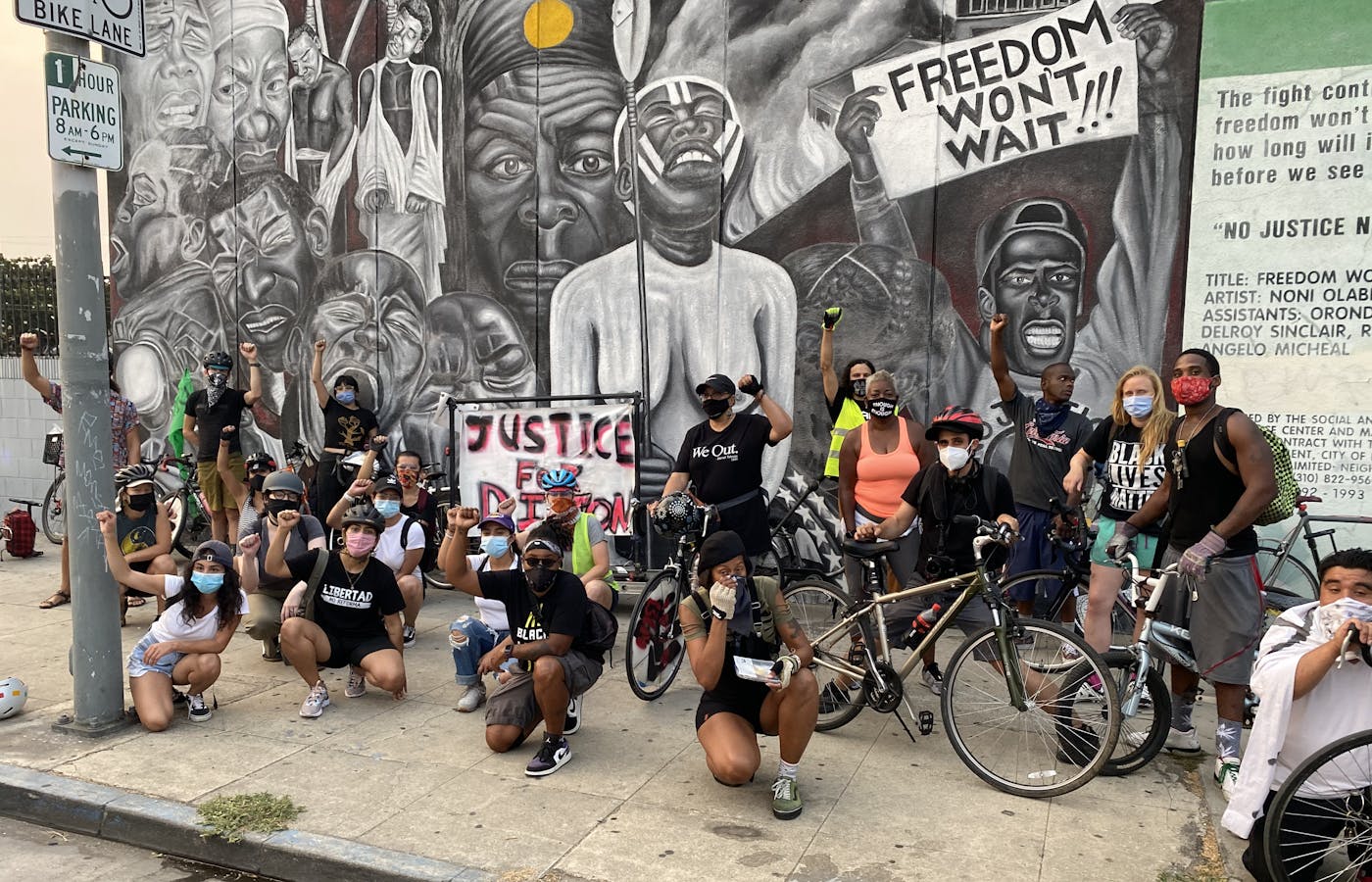
Better Bike Share Partnership Awards $89,970 in Grants
June 15, 2021
The 12 projects utilize everything from community art to electric bikes and span the country from New York to Hawaii. ...
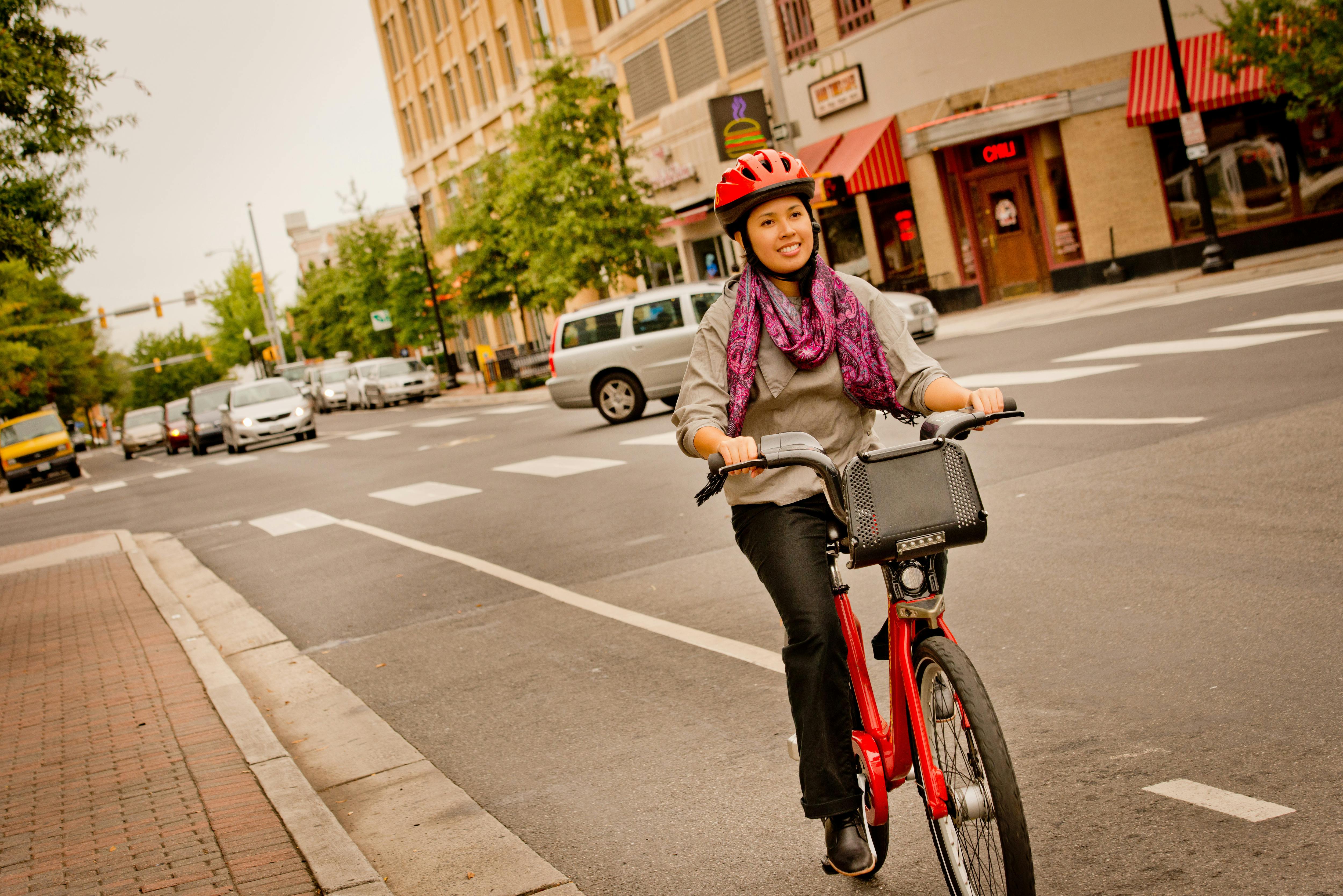
House Committee Transportation Bill Makes Big Strides for Bikes
June 8, 2021
The $547 billion INVEST in America Act offers promising funding for connecting our nation. ...

Good Networks Make Better Bike Cities
June 3, 2021
A focus on safe, connected bike networks helped boost these medium-sized cities to top spots in our 2021 City Ratings. ...

Lessons From Europe
June 1, 2021
These seven European cities are role models when it comes to great bicycling. Here’s what U.S. cities can learn from them. ...
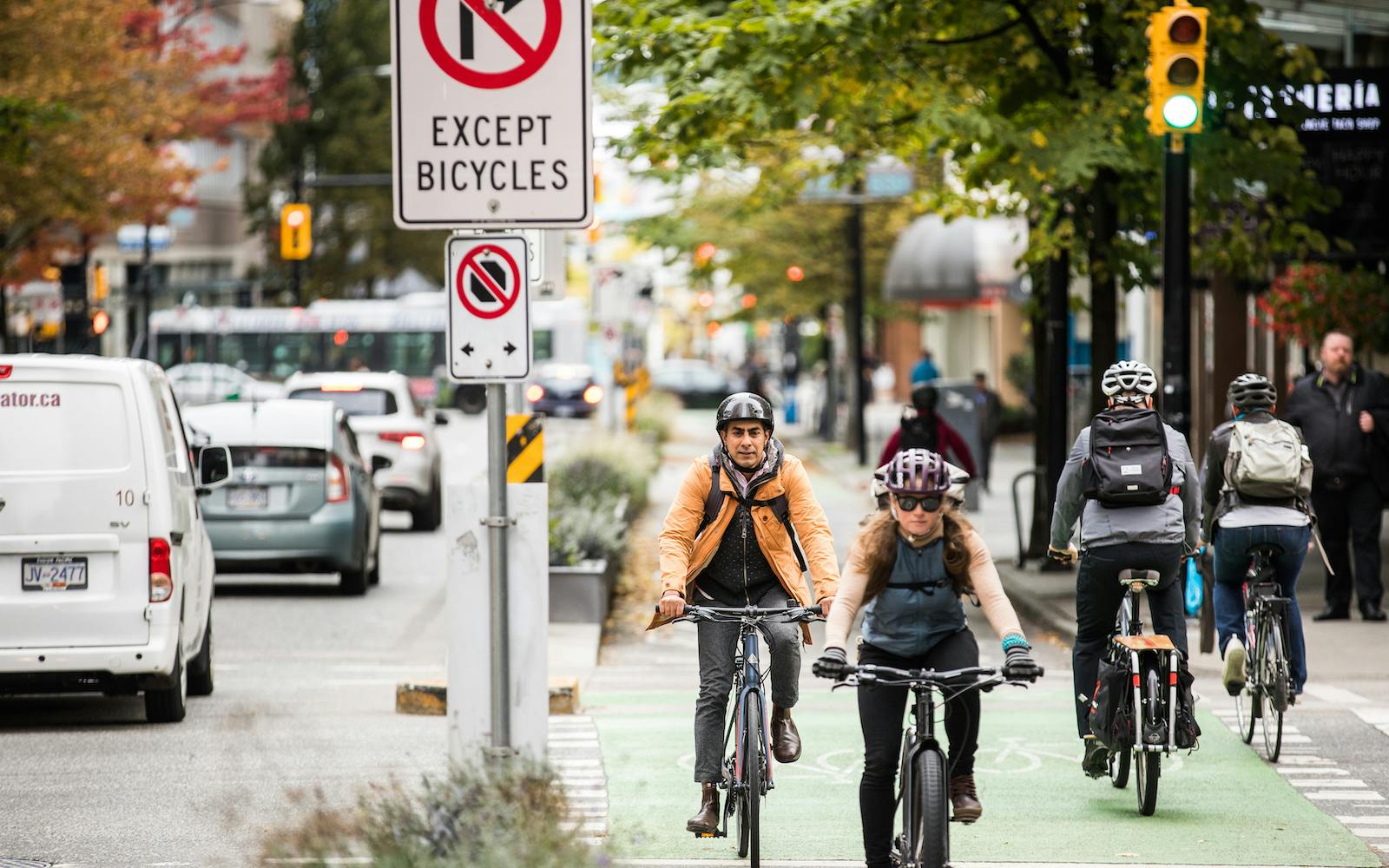
Five Great Canadian Bike Cities
June 1, 2021
Spread out across provinces, these disparate locales showcase what bicycling north of the border is all about. ...
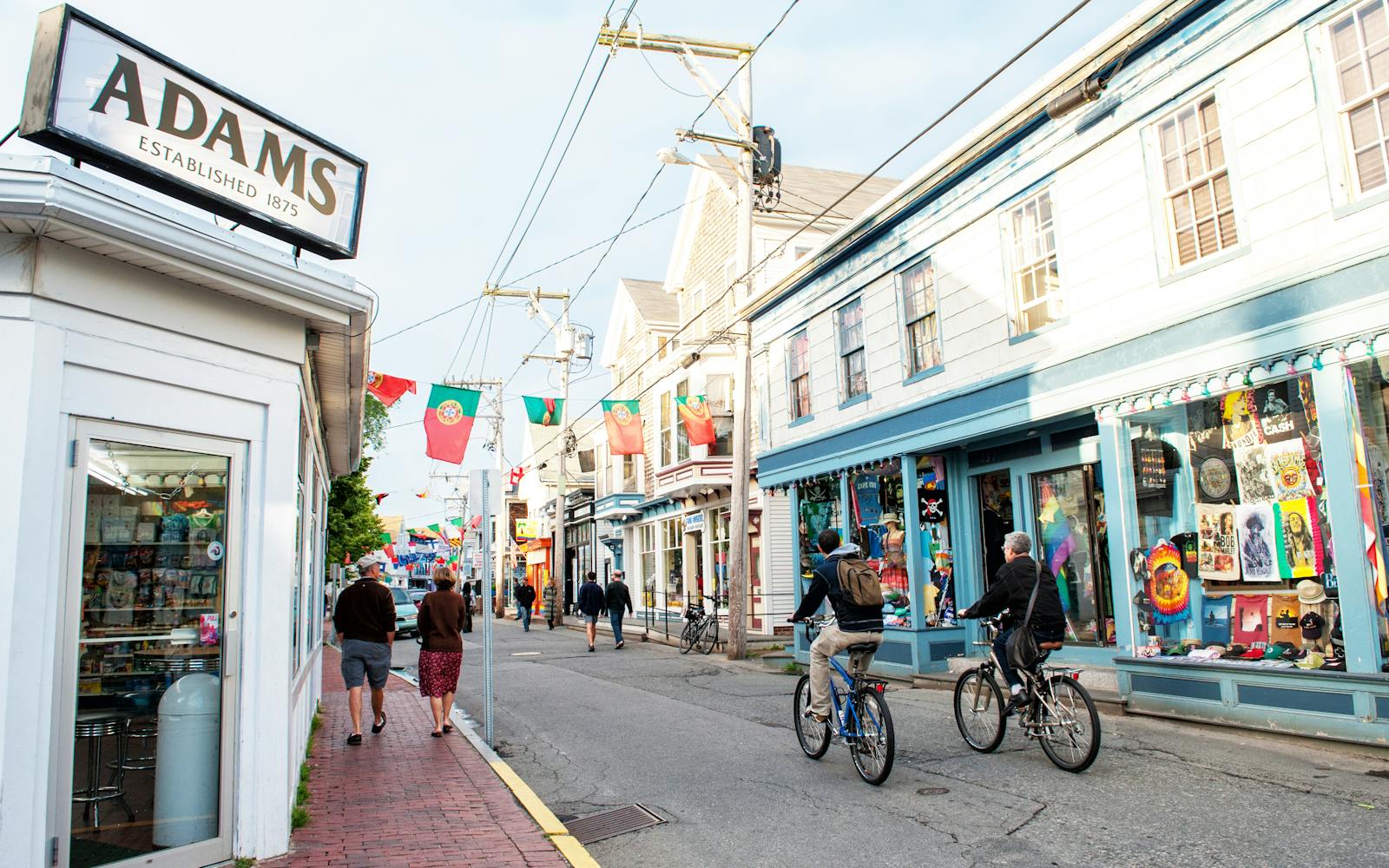
Our Top Vacation Spots for Biking
June 1, 2021
From world-class mountain biking to wine tasting tours on two wheels, don’t forget to bring your helmet the next time you pack your bags. ...
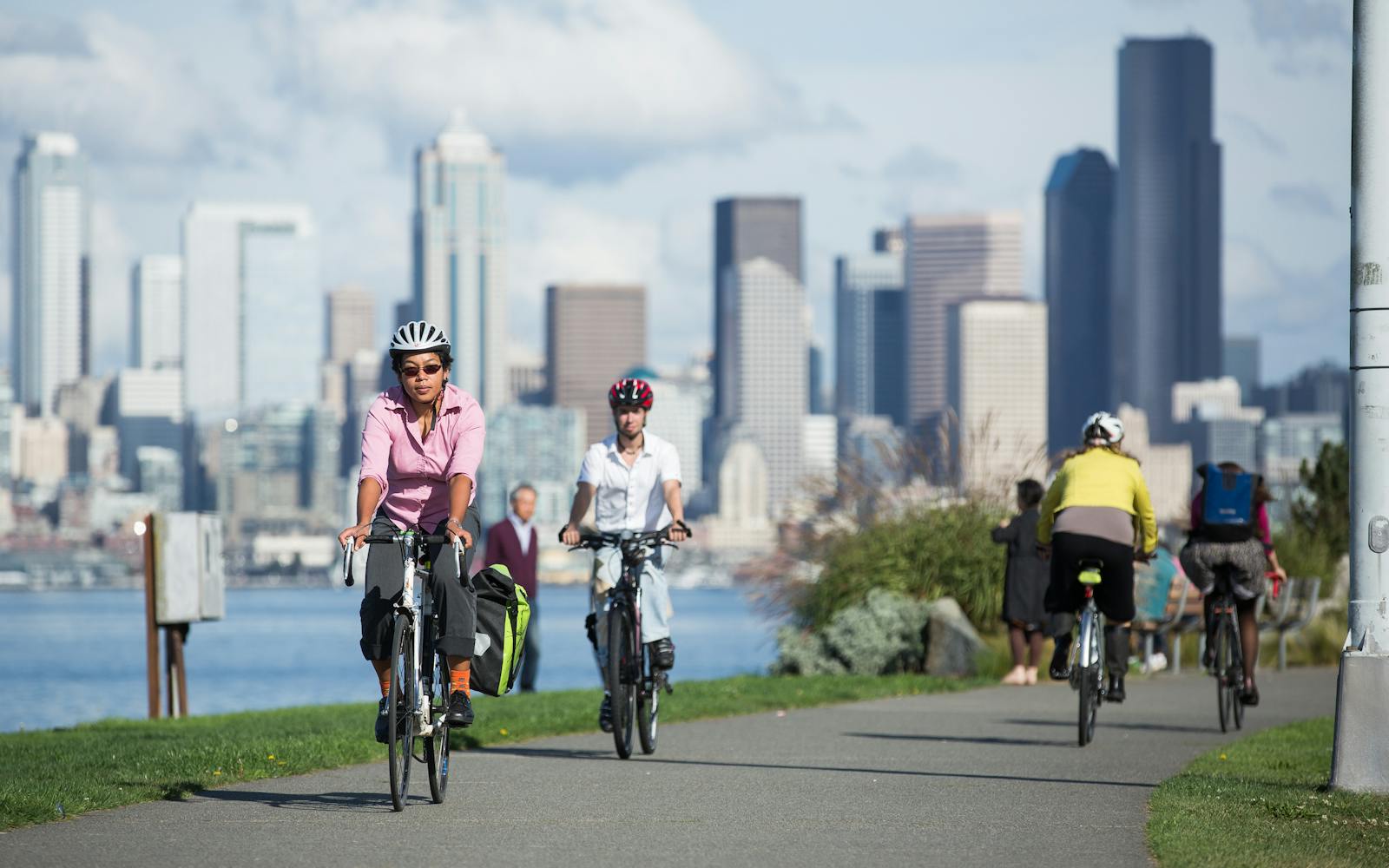
How to Build Big Cities for Biking
June 1, 2021
These six U.S. cities are top of class when it comes to their bike networks, infrastructure and political willpower. ...
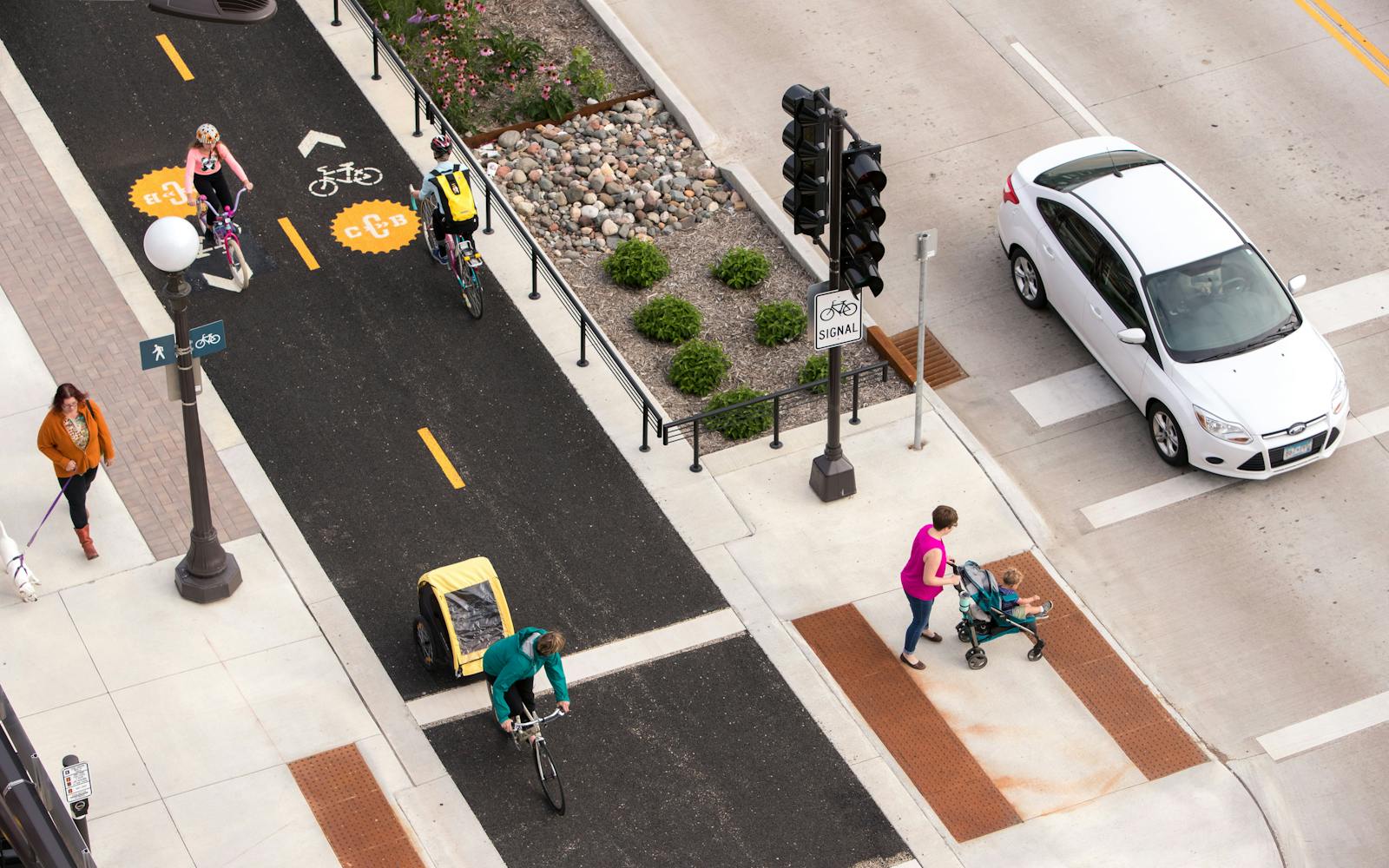
What St. Paul Got Right For Bikes
June 1, 2021
From 2020 to 2021, the Minnesota capital’s City Rating score increased significantly. Here’s why. ...

The Secrets of Small Town Bicycling
June 1, 2021
These four U.S. cities, all with populations under 50,000 people, scored well in the 2021 City Ratings. Here’s what they’re doing right. ...

5 Strategies Every Bike Advocate Needs
May 31, 2021
Want to advance bicycling locally? It’s time to reconsider how we apply our messaging around bicycling and bike infrastructure. ...
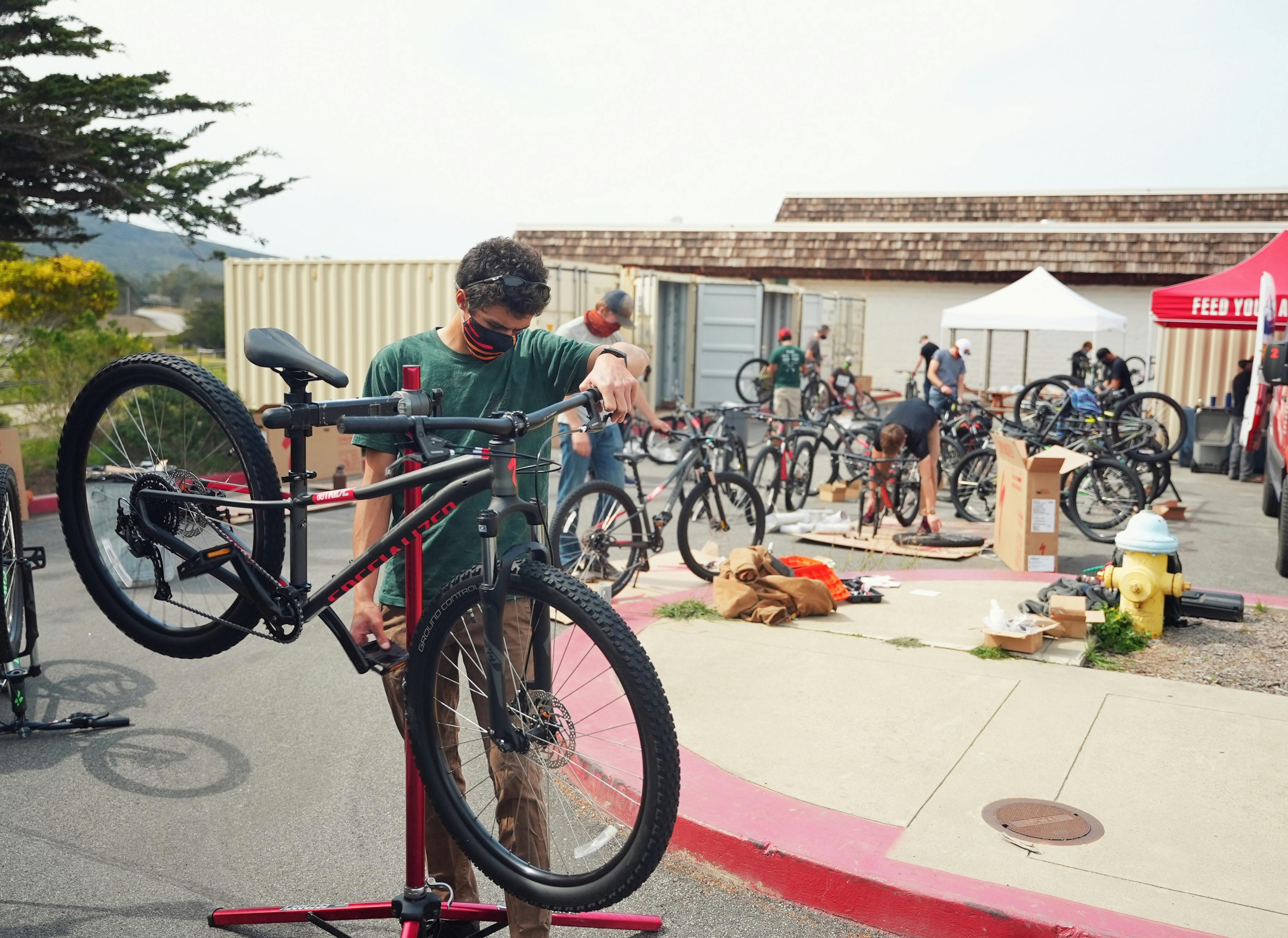
Why Local Bike Shops Should Support Youth Bicycling
May 28, 2021
We spoke with retailers across the country to learn about various initiatives that are boosting business and building community. ...

Senate Transportation Bill Shows Promise for Bikes at the Federal Level
May 26, 2021
New legislation is promising, but still falls short of answering the demand for safe and connected infrastructure. ...

‘Spring Back on Bikes’ Is Increasing Youth Ridership
May 24, 2021
A collaboration between the National Youth Bike Council and Atlanta Students Advocating for Pedestrians is providing free bike tune-ups. ...

New Leadership, New Vision
April 26, 2021
Baltimore’s Mayor Brandon M. Scott has set ambitious goals for his first term, highlighting a commitment to equitable transportation. ...
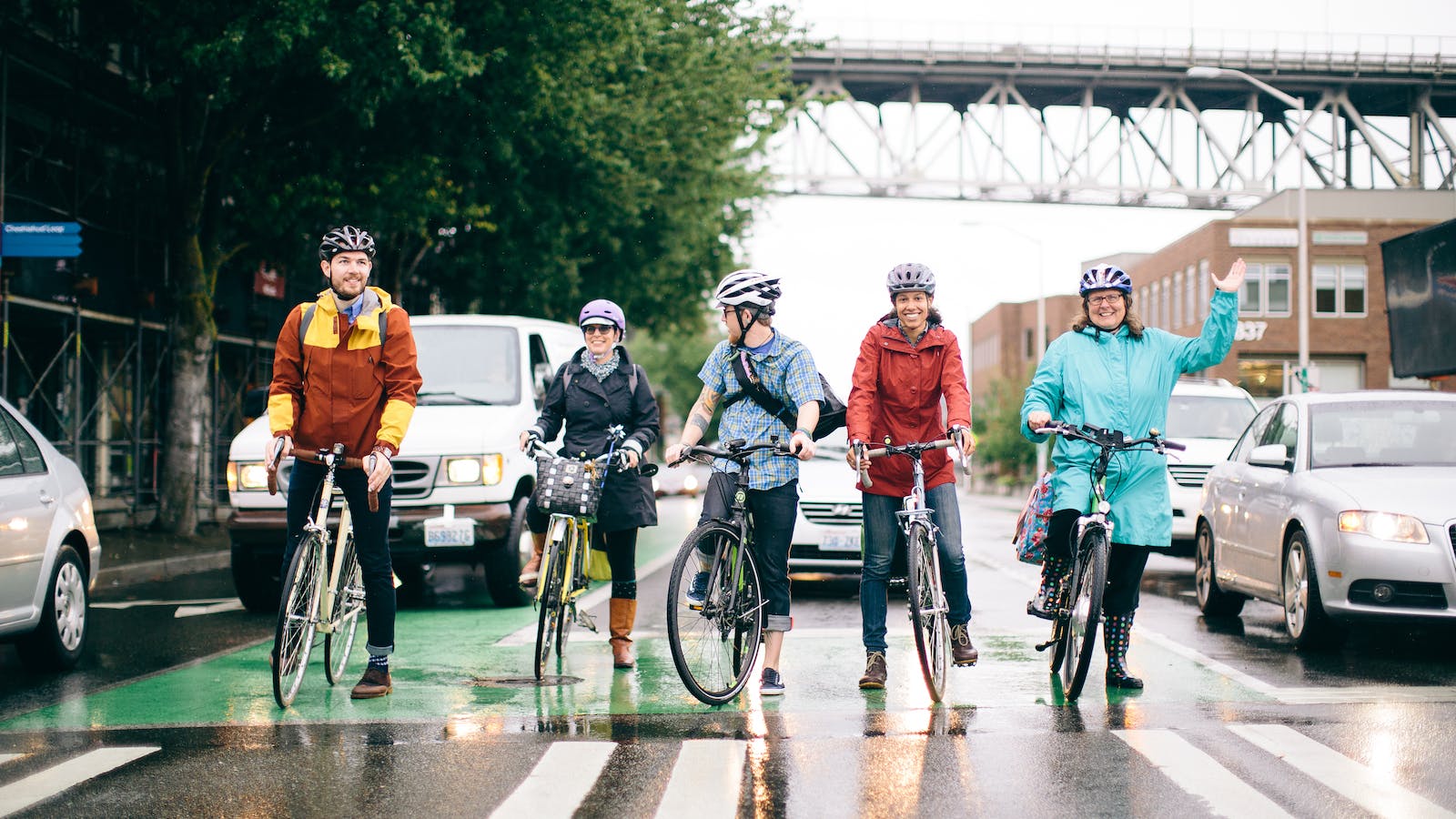
Everything You Need to Know About 2021 City Ratings
April 23, 2021
Answers to the most common questions around our newly revamped ranking system for bicycling cities, now simpler and international. ...
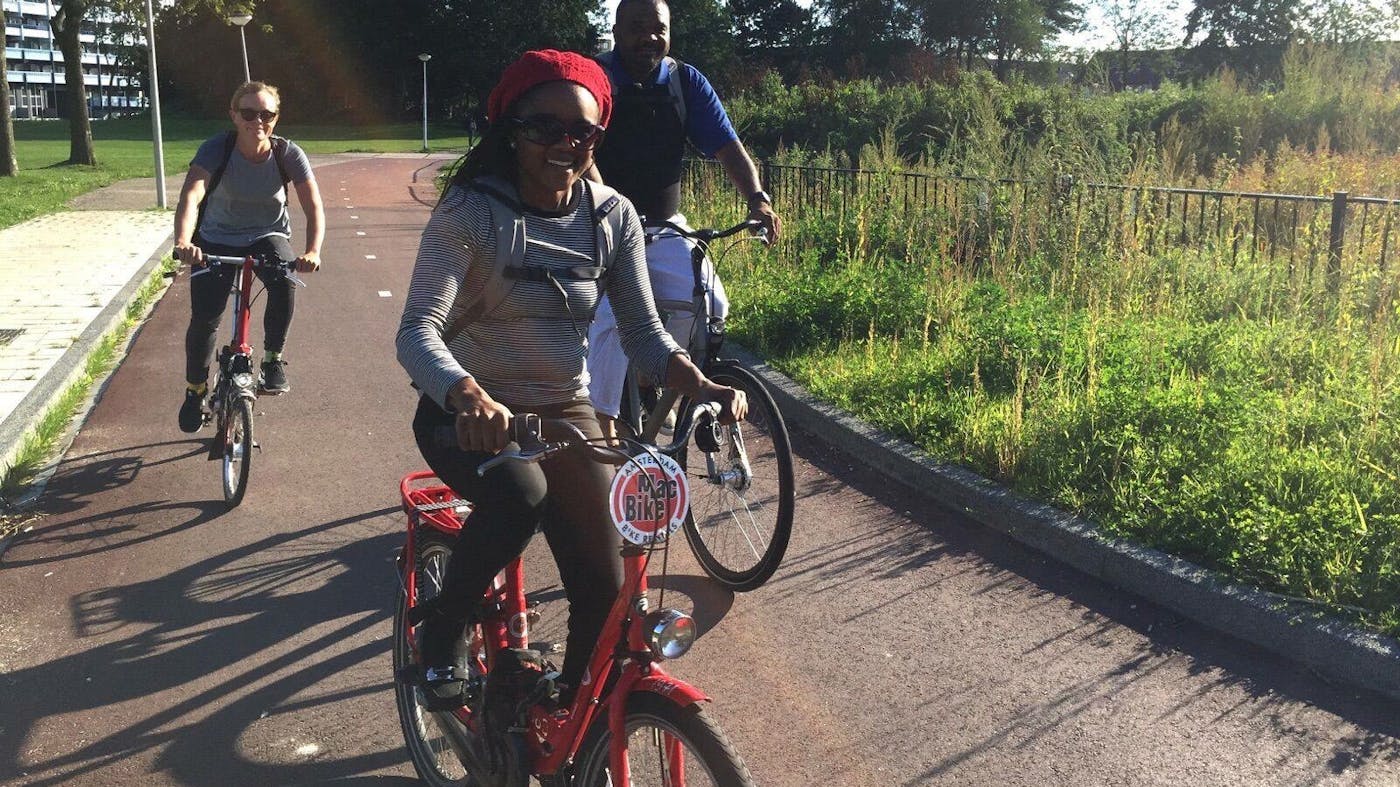
Biking Is (Not Just) for Boys
April 22, 2021
Through the personal bicycle history of Roshun Austin, we highlight the physical, cultural and societal barriers that exist for women in the U.S. ...

What Will You Outride?
April 7, 2021
Outride’s #WhatWillYouOutride campaign sparked a national conversation around the benefits of bicycling. ...
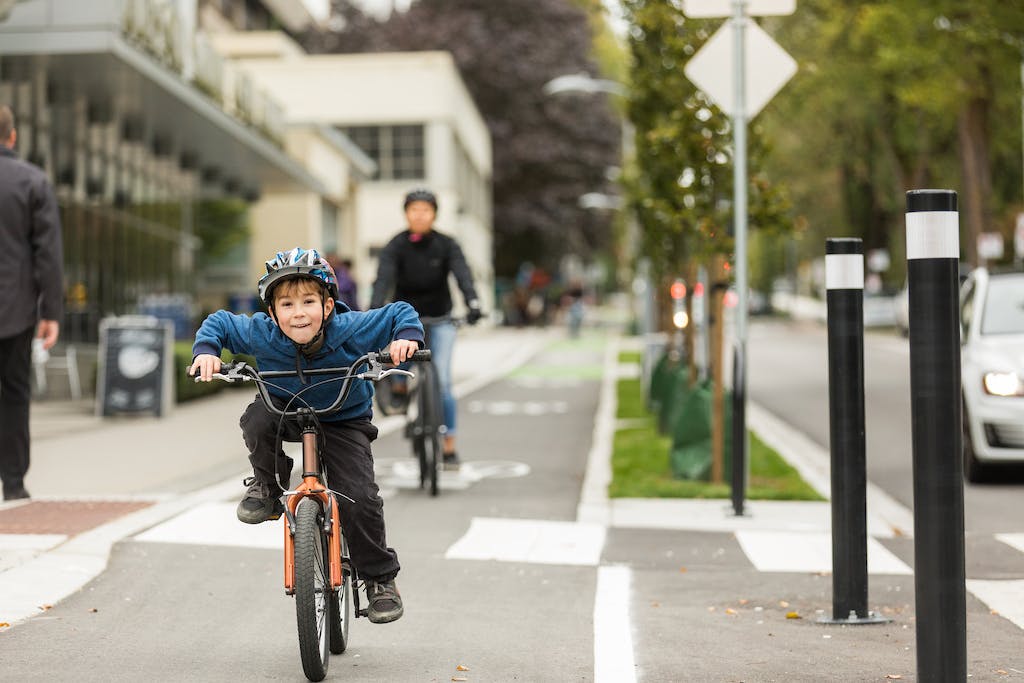
What Could Biden’s Infrastructure Plan Mean for Bikes?
April 2, 2021
On March 31, President Biden released his administration’s $2 trillion infrastructure proposal, the American Jobs Plan, offering a wide-reaching policy and funding package including everything from transportation, broadband, water resources, manufacturing, clean energy and more. The numbers are big ...
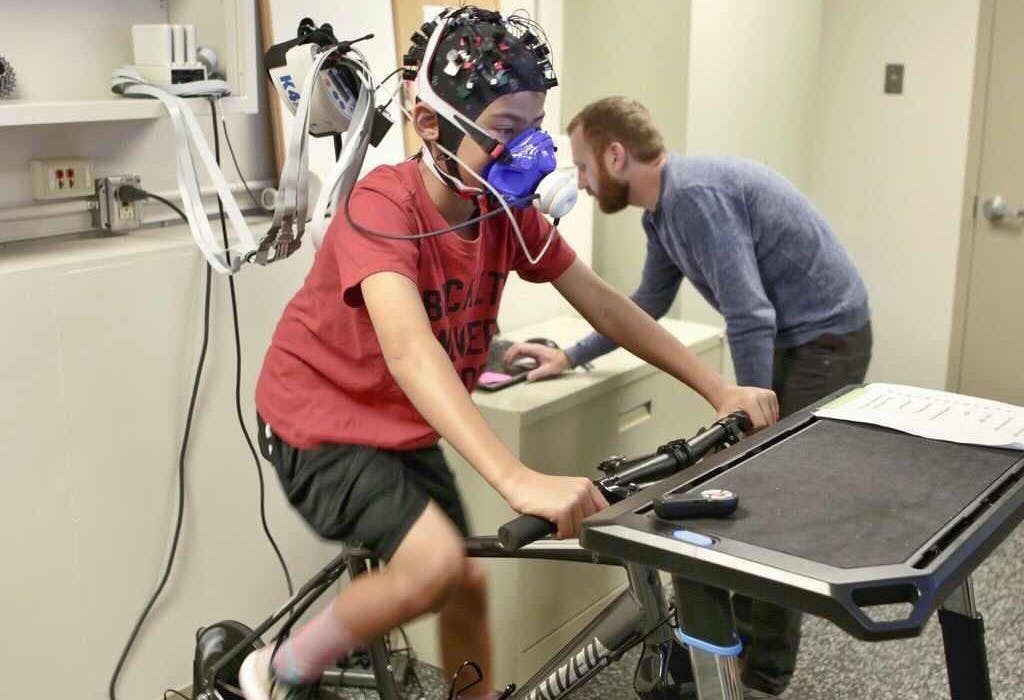
Your Child’s Brain on Biking
March 29, 2021
We spoke with Esther Walker, Ph.D., about the research work Outride and its university partners are doing to advance youth bicycling. ...

How 5 Cities Are Breaking Down Barriers to Biking
March 25, 2021
Bike advocates in Austin, Denver, New Orleans, Pittsburgh and Providence share how they’re already using recent recommendations from Charles T. Brown and other researchers. ...
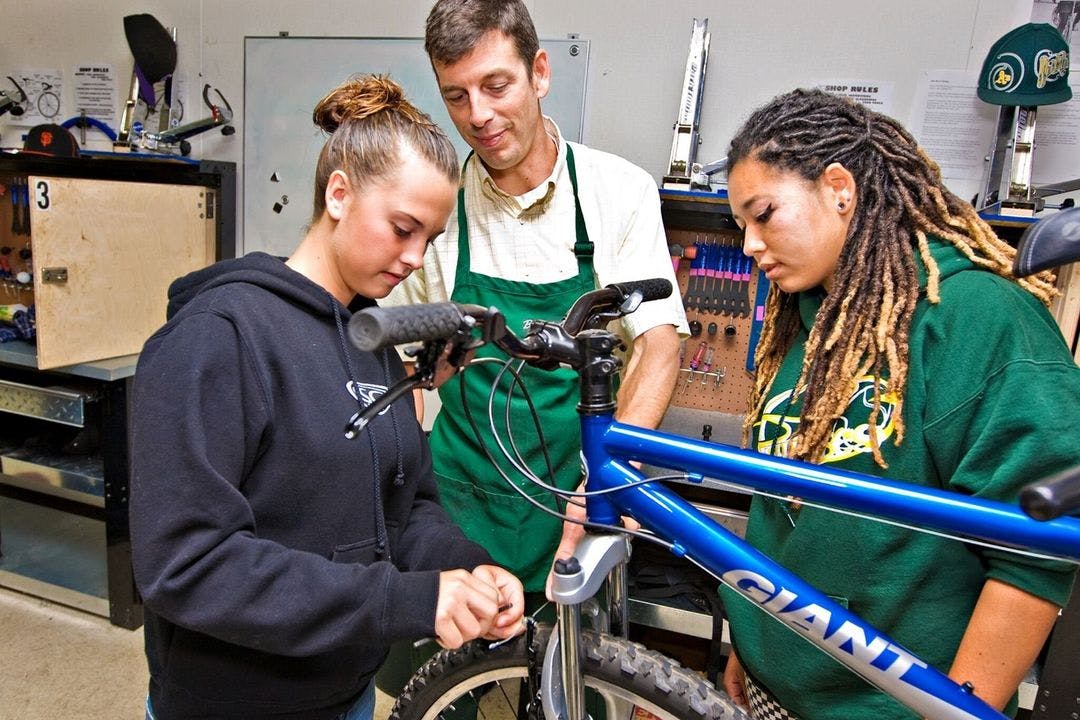
Why Every City Needs Project Bike Tech
March 17, 2021
Like high school auto shop, but for bicycles, this experiential program is helping create a new generation of bike advocates nationwide. ...
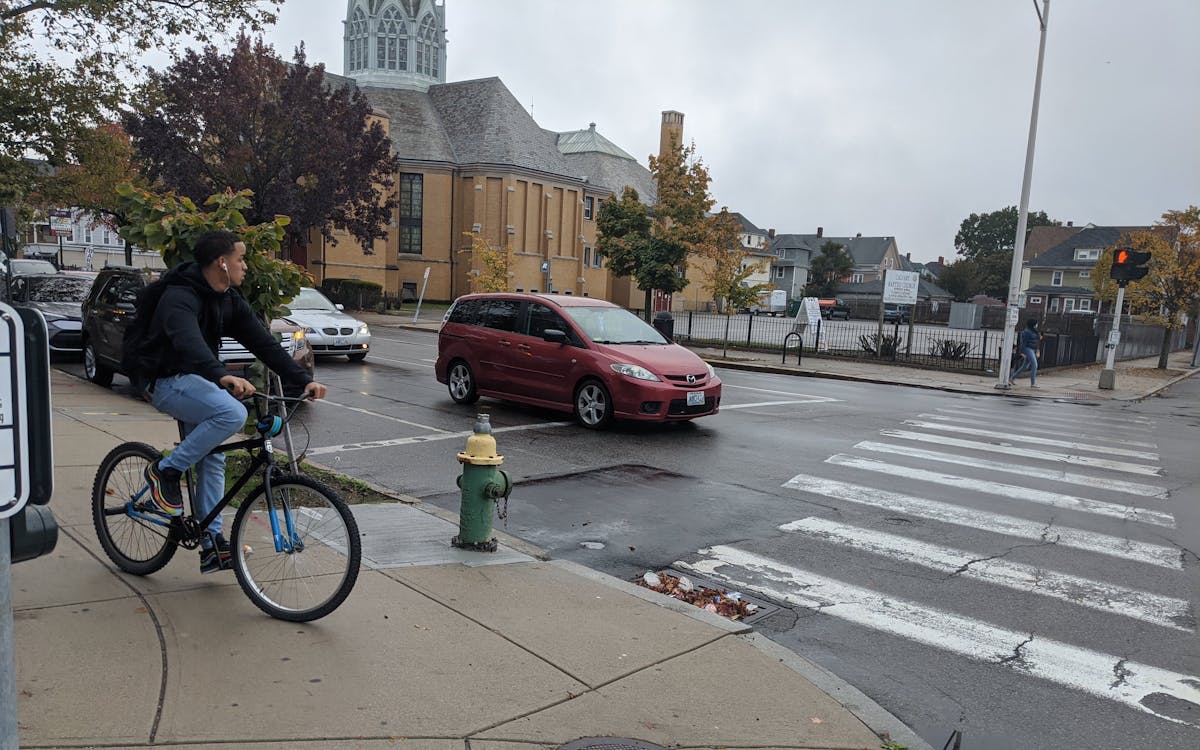
“Where America Fails, So Have We in Bicycling.”
March 4, 2021
A candid conversation with Charles T. Brown, the lead investigator of a new, groundbreaking report on barriers to biking in the U.S. ...
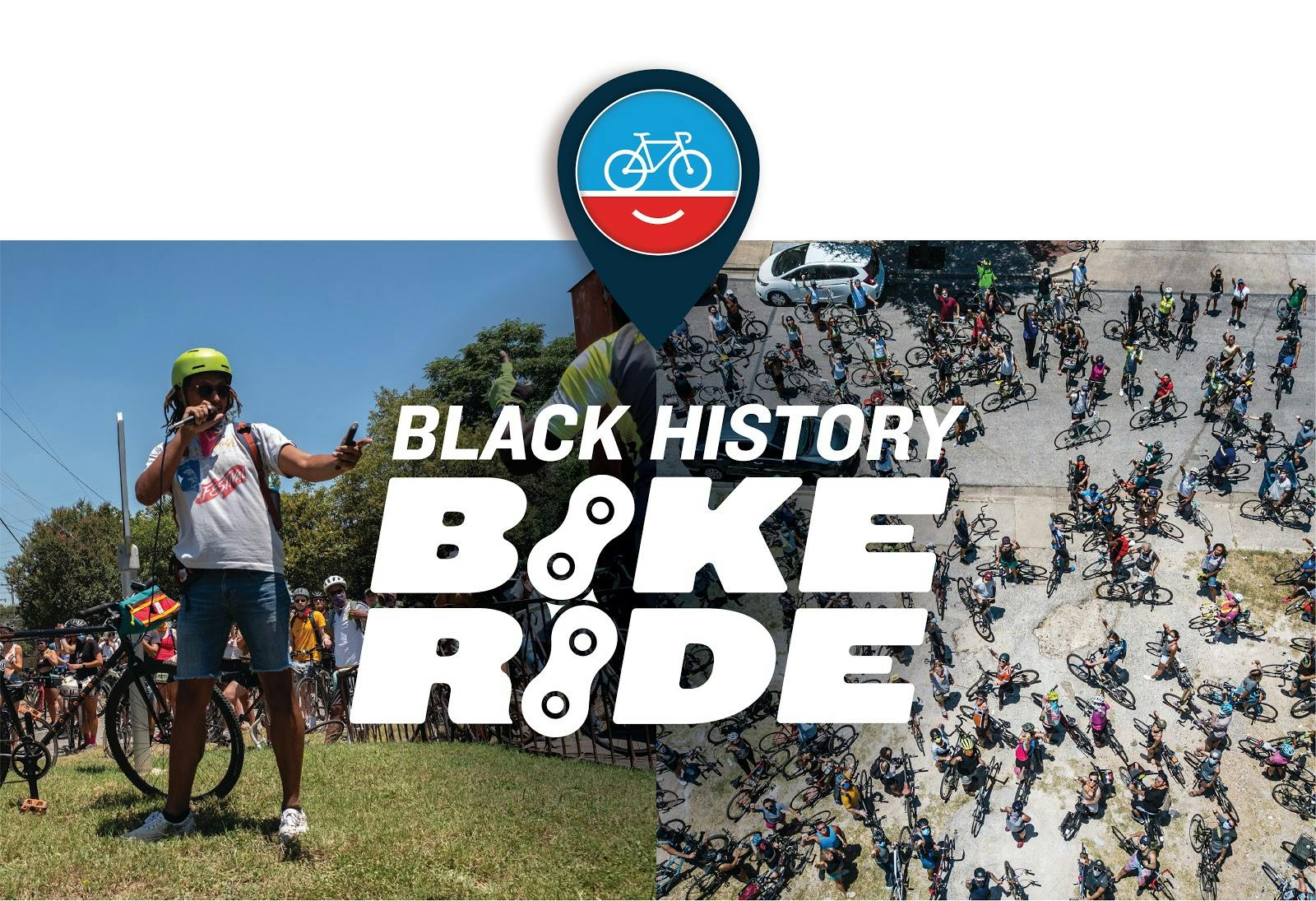
Join the Challenge to Raise Money for Black History Bike Ride
March 3, 2021
AUSTIN, TEXAS (March 3, 2021) — On July 14, 2020, Talib Abdullahi set out to educate a few friends about Black history in Austin with a bike ride around the city. When he first shared his idea for the ride among a few friends on Instagram, Abdullahi never imagined that eventually more than 400 rider ...

Insuring Your Electric Bicycle 101
February 25, 2021
When Tim Pembroke turned 70 back in 2011, he decided it was time to stop riding a motorcycle and start riding an electric bicycle. His son Nick worked for Everett, Washington-based McClain Insurance for a decade, so Tim asked Nick about insurance for his new ride. ...

Electric Bicycles as a Tool for Essential Workers and Low-Income Populations
February 25, 2021
Amid the COVID-19 pandemic, states and municipalities nationwide are recognizing the benefits of electric bicycles more than ever. Electric bicycles can help build sustainable communities that empower their citizens and better prepare them for disaster recovery. Electric bicycles produce low greenho ...

Making Electric Bicycle Purchase Incentive Programs a Top Priority
February 25, 2021
Every day, agencies and businesses across the U.S. are looking to establish electric bicycle incentive programs due to the immense social, environmental and economic benefits they can provide for both individuals and communities as a whole. Electric bicycles are cheaper to own and maintain than a ca ...
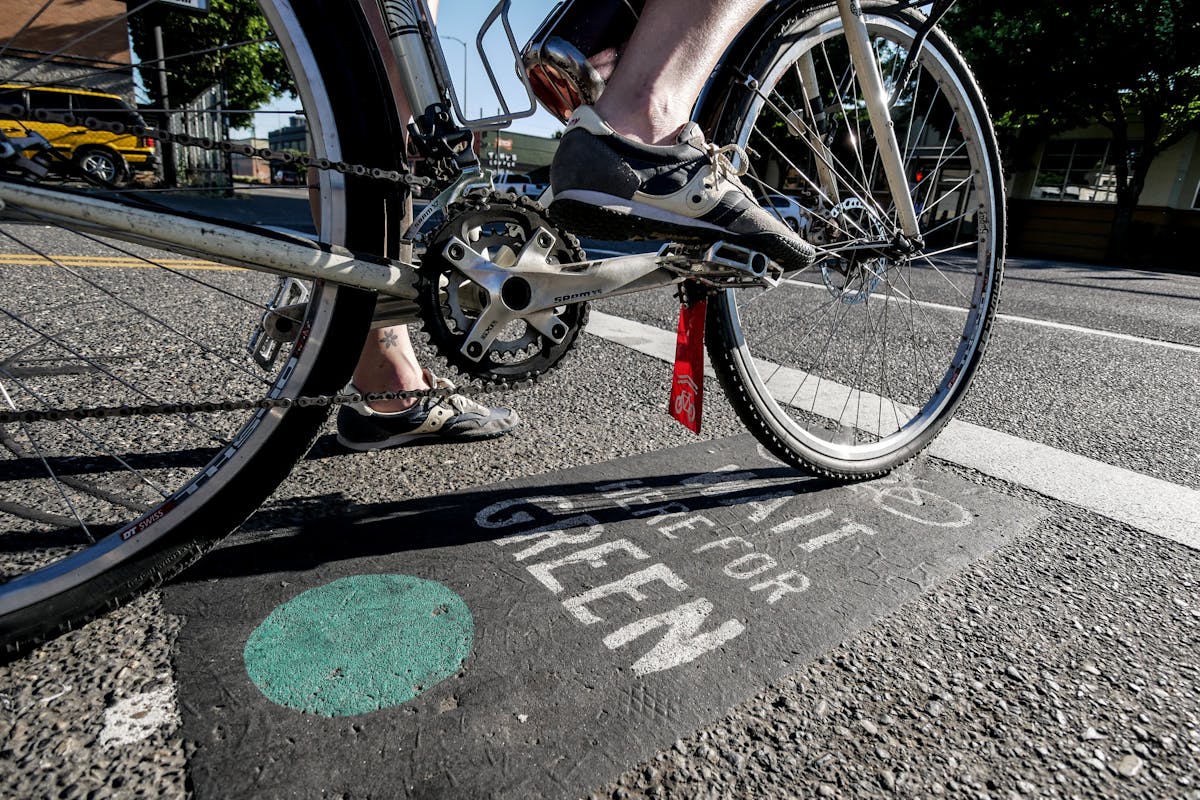
5 Bills Every Bike Advocate Should Care About
February 24, 2021
We’ve combed through every state bicycling bill currently being considered — here are the top five themes that emerged and why they’re important. ...

Youth Cycling Coalition Announces Partners and Launch of Pilot Program
February 23, 2021
The Youth Cycling Coalition (YCC), a partnership of 10 youth-focused bicycling organizations, has announced a commitment to growing youth bicycling through the launch of a pilot program in Morgantown, West Virginia. ...
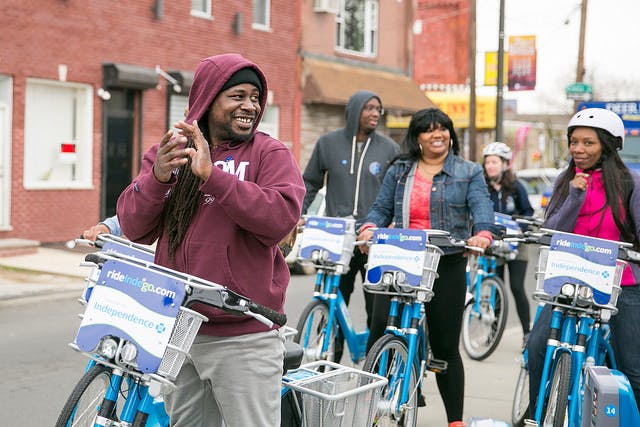
Meet 5 Grantees Out to Transform Bike Share
February 19, 2021
We’re proud to announce our Living Lab winners, all of which will create replicable programs for improving shared micromobility in low-income communities. ...
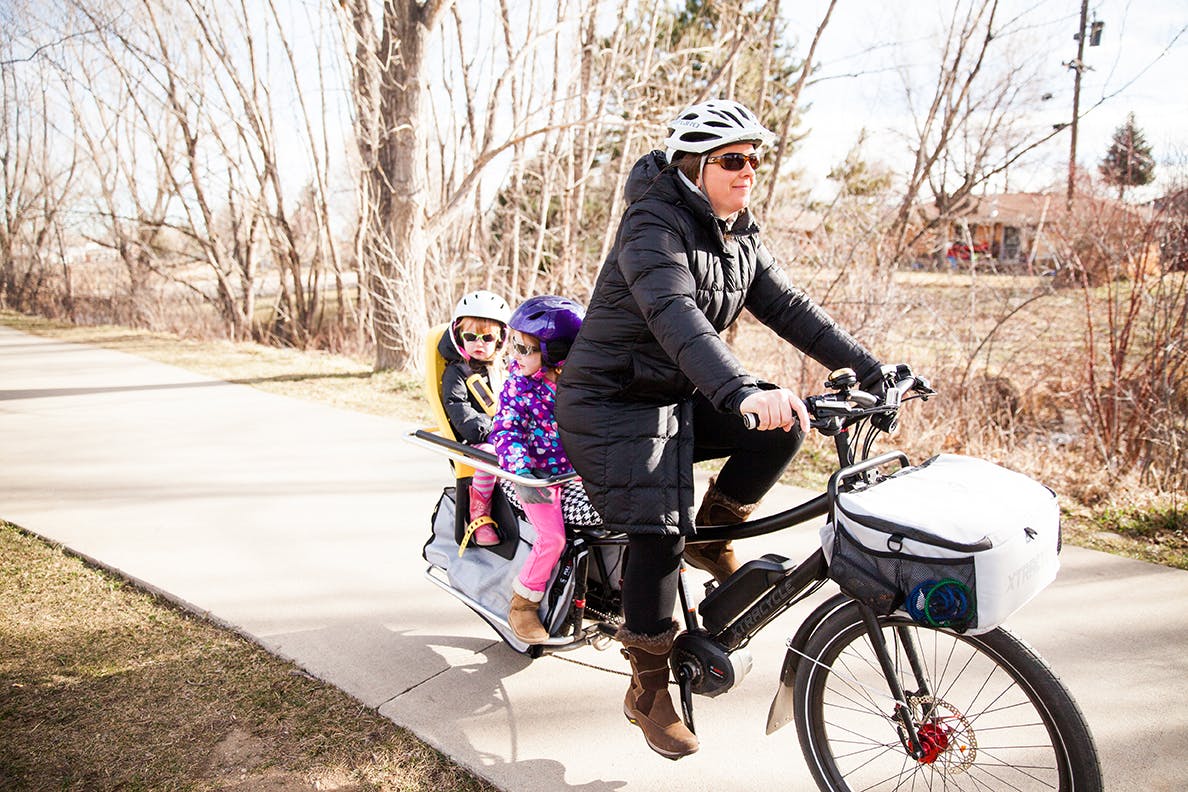
Electric Bicycles Can Play a Big Role in Combating Climate Change
February 16, 2021
Transportation is responsible for 37.8% of all carbon emissions in the United States. Just under 60% of that transportation-related CO2 is generated by passenger cars, SUVs and minivans. Electrification and clean, renewable power are critical tools to reduce transportation emissions in the long run, ...

New E-BIKE Act Would Offer Tax Credit for Electric Bicycle Purchases
February 10, 2021
PeopleForBikes applauds the introduction of federal legislation to offer an electric bicycle tax credit, helping more people easily get out on two wheels. The Electric Bicycle Incentive Kickstart for the Environment (E-BIKE) Act, led by Representatives Jimmy Panetta (D-CA) and Earl Blumenauer (D-OR) ...

PeopleForBikes and Outride Announce Partnership to Support Youth Bicycling
February 3, 2021
PeopleForBikes is proud to announce a partnership with Outride, a non-profit organization dedicated to improving the lives of youth and cultivating inclusive communities through bicycling. Outride is a leader in youth cycling education, community grant giving and research investigating the influence ...

A Data-Driven Pandemic Response
February 2, 2021
Tucson, Arizona, a recipient of our 2020 COVID-19 Mobility Response Grant, used the funding to create an equitable Slow Streets program and build community through socially distanced events. ...
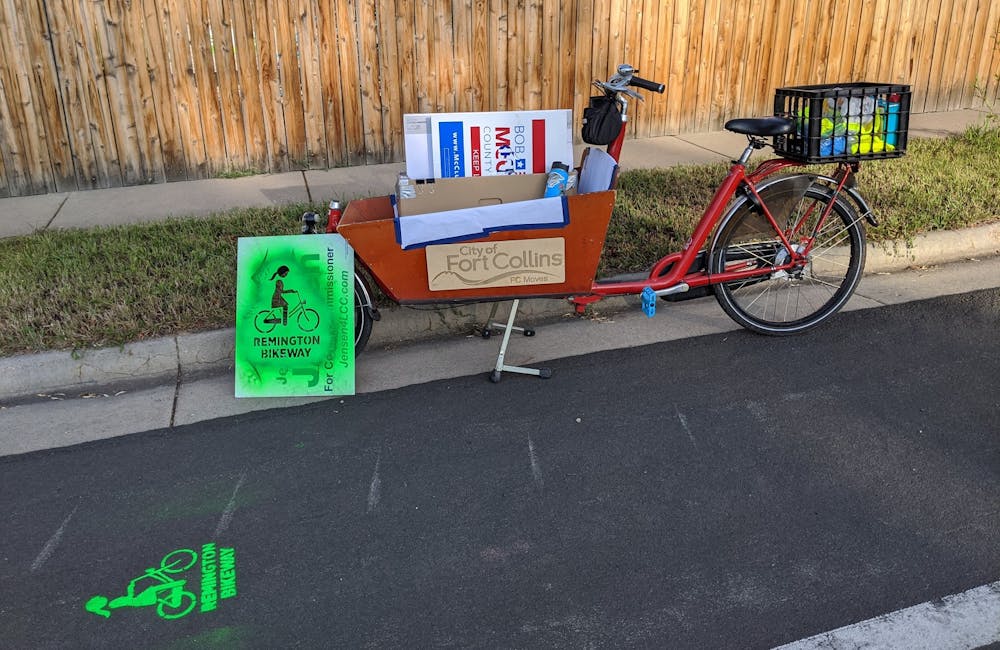
Getting People to Shift Their Ride
February 2, 2021
Fort Collins, a recipient of our 2020 COVID-19 Mobility Response Grant, used the funding to beef up its existing bike network, as well as roll out an extensive marketing campaign. ...

Electric Cargo Bikes Can Be a Key Tool for Freight Mobility
February 1, 2021
Electric cargo bikes proved more efficient than delivery vans for redistributing the inventory of USEFULL, a company that functions like a bikeshare system for to-go containers. However, in seeking secure overnight storage and recharging, Founder and CEO Alison Rogers found that commercial garages’ ...
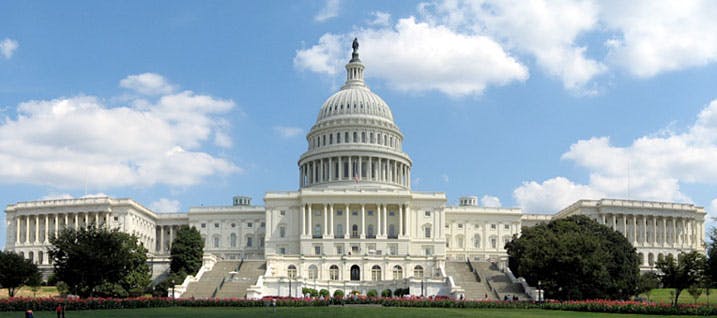
What to Expect in the First 100 Days of the New Administration and Congress
January 26, 2021
The first 100 days of the Biden administration and the start of the 117th Congress will be packed with agency nomination hearings, a Senate impeachment trial, numerous executive orders and a legislative effort to set the agenda of the new Democratic majority. We expect Congress and the Biden adminis ...

What a Modern Civilian Conservation Corps Could Do for Bikes
January 26, 2021
In March 1933, only three weeks into his first term, President Franklin Delano Roosevelt proposed a bill to Congress to create the Civilian Conservation Corps (CCC). Congress funded the CCC in April, and by summer thousands of unemployed young men were enrolled in the program that would put them to ...

Winter Riding Tips
January 25, 2021
We know it can be pretty easy to hang up your helmet for the season once the snow starts falling, but we’re here to tell you that just because winter is here, it doesn’t mean you have to stop riding! ...

Ravi Rajcoomar is Our New Vice President of Business Network
January 21, 2021
PeopleForBikes, the nation’s leading bicycle industry trade association, is proud to announce the addition of Ravi Rajcoomar as the vice president of the organization’s Business Network. In his new role, Rajcoomar will serve on PeopleForBikes’ senior leadership team and guide the organization in cre ...

How Bicycling Changed During A Pandemic
January 20, 2021
The COVID-19 pandemic brought unexpected challenges to the health, livelihood and well-being of communities across the world last year. Working, shopping and getting around fundamentally changed amidst global efforts to control the spread of the virus. ...

Supporting Small Businesses By Bike
January 19, 2021
A big lesson we all learned during the past year is the importance of small businesses in our communities. As the COVID-19 pandemic swept across the U.S., small businesses were hit hard, many unfortunately closing their doors for good. ...

How to Ride Together Even When We're Apart
January 15, 2021
Over the past year, we’ve all learned to do some of our favorite activities a little differently. Happy hours, game nights and even Thanksgiving dinners gone virtual have shown that even though we’re physically apart, it doesn’t mean we can’t spend time together. ...

Thinking About Buying an Electric Bicycle? We’re Here to Help
January 8, 2021
We get this question all the time — “I’m curious about electric bicycles but don’t really know where to start. How do I find the right bike that fits my needs?” ...
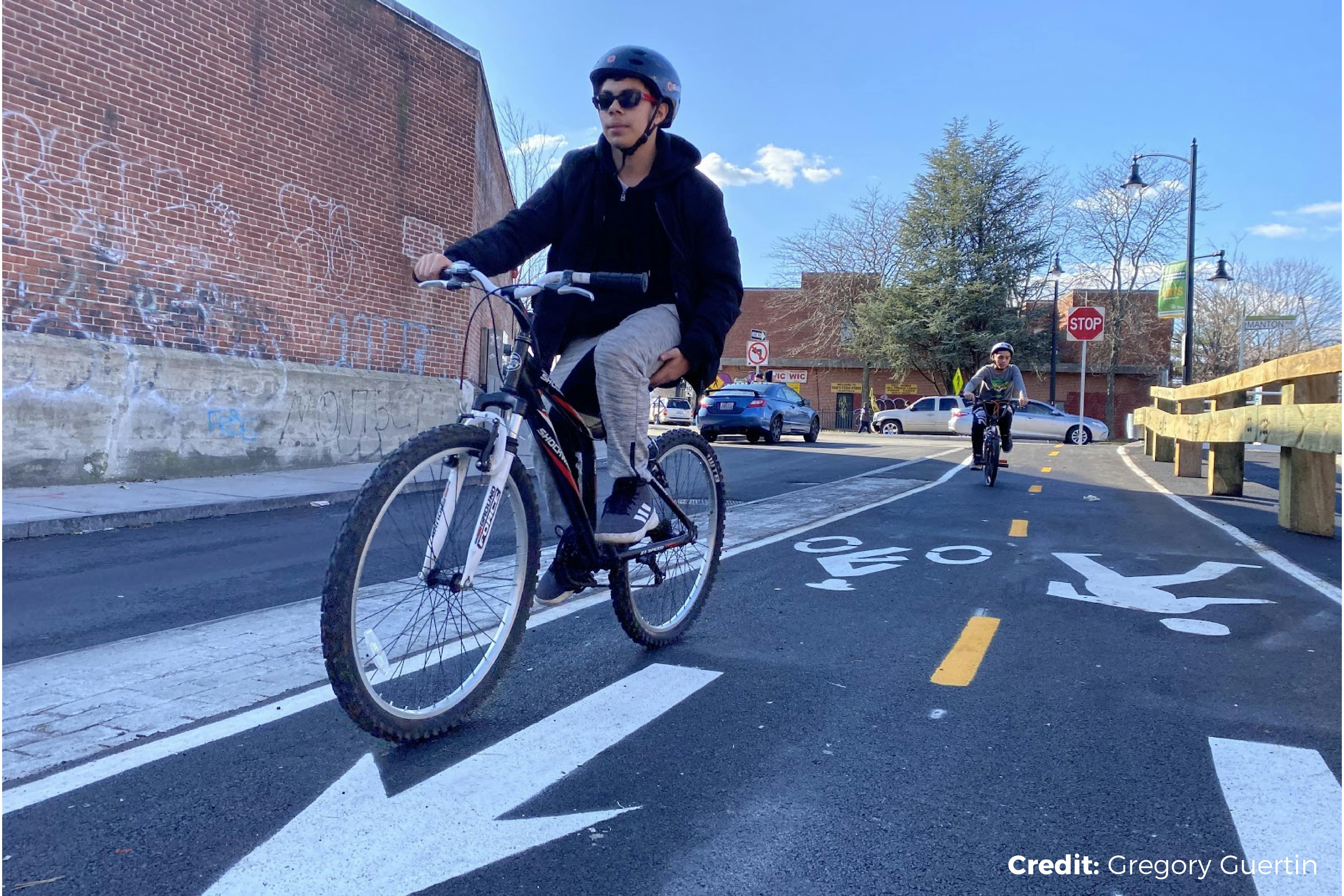
America's Best New Bikeways of 2020
December 18, 2020
We can all agree, 2020 was tougher than anyone anticipated. As the year began, planning for a pandemic could only be described as a fantastical thought exercise, but by March the realities of COVID-19 reached all corners of America, dramatically changing nearly every aspect of people’s lives. ...
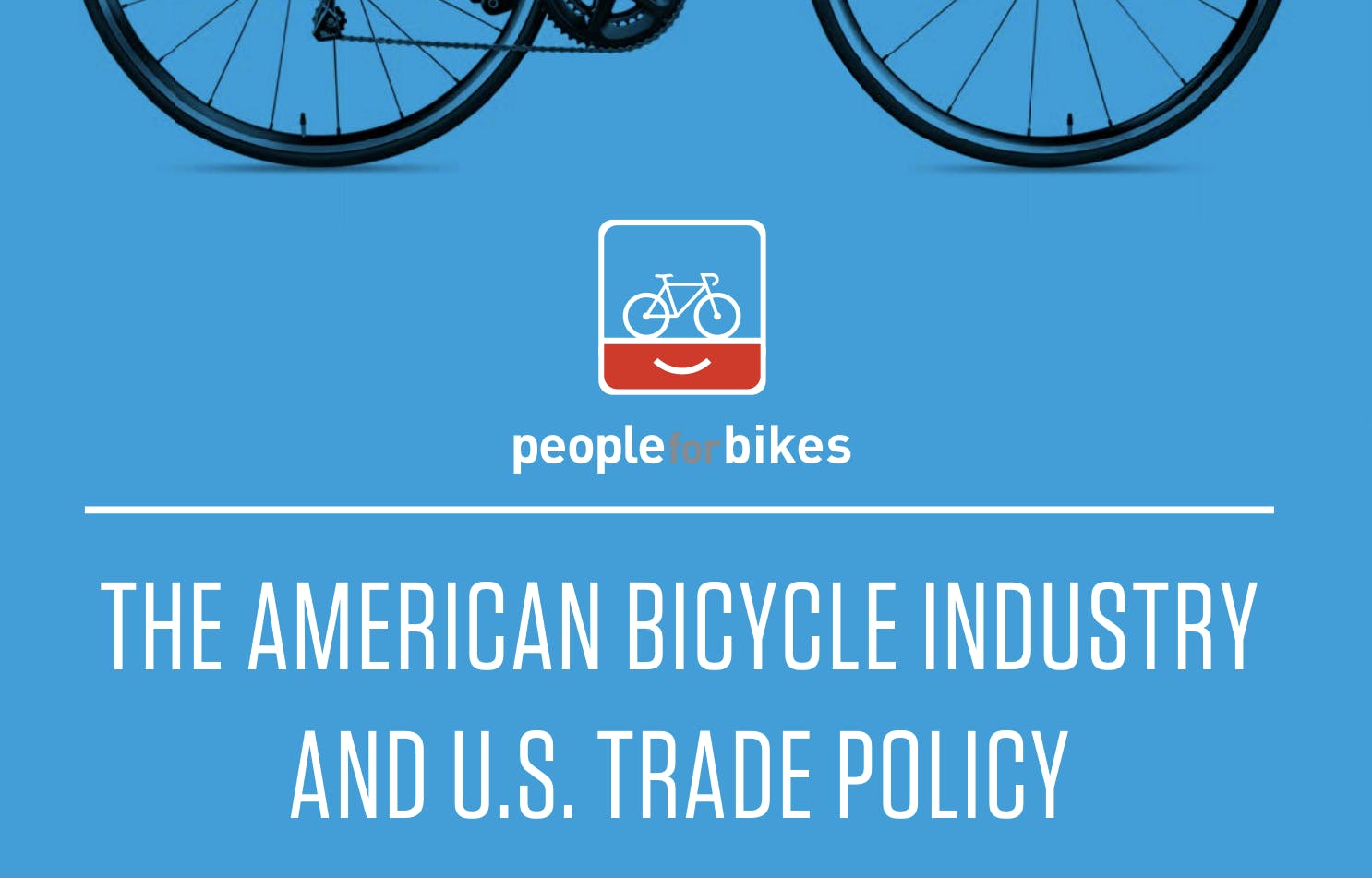
PeopleForBikes is Advancing a Pro-Bike Trade Agenda in Washington, D.C. in 2021
December 18, 2020
PeopleForBikes is dedicated to promoting pro-bike trade policies that support bike businesses, keep Americans riding and make bikes and bike products accessible to as many people as possible. ...

Nearly $300 Million in Federal Infrastructure Grants Include Bikes
December 4, 2020
In September 2020, the U.S. Department of Transportation (USDOT) announced this year’s awards for the Better Utilizing Investments to Leverage Development grants (BUILD, formerly TIGER). Of the $1 billion in grants awarded, nearly $300 million focus on or support bicycle infrastructure and active tr ...

Using the Land and Water Conservation Fund for Local Bike Projects
December 4, 2020
There’s an opportunity to increase funding for cities and states to build new bike projects across the U.S. thanks to the Land and Water Conservation Fund (LWCF). The federal government fully and permanently funded the LWCF at $900 million annually when the Great American Outdoors Act became law in ...
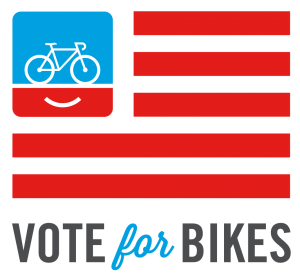
Bikes Won Big at the Ballot Box
December 3, 2020
2020 has been a momentous year for bikes, especially in local and state ballot measures. ...

Electric Mountain Bike Access in State Parks is Improving
December 3, 2020
Every day, individuals are discovering the many benefits of electric mountain bikes (eMTBs) — they allow more individuals to get out and ride, regardless of their age or physical or cognitive abilities. Electric mountain bikes provide a needed boost to make climbing hills easier and going longer dis ...

Busting 10 Myths about E-Bikes
November 30, 2020
In some circles, electric bicycles have an undeserved bad reputation. Like just about anything new, they require an open mind and a positive attitude. As their popularity skyrockets around the world, it’s only a matter of time before e-bikes really take off in the U.S. Fact is stronger than fiction, ...

Senate Committee Votes Yes on Important Public Lands and Recreation Legislation
November 25, 2020
While recent news out of Washington, D.C. may seem singularly focused, members of Congress continue to work steadily to advance priority legislation that preserves public lands and improves recreation opportunities. ...
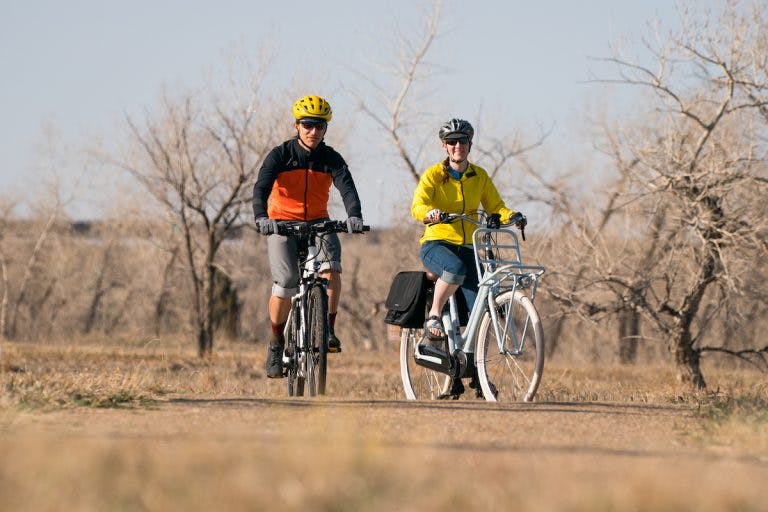
Congress Advances Veterans Bill to Leverage Outdoor Recreation
November 18, 2020
POLICY UPDATE: Amid a hyper-partisan divide in Washington, D.C., lawmakers came together ahead of Veterans Day to approve the Veterans COMPACT Act, a broad legislative package to advance care for veterans and their families, which includes support for women veterans and suicide prevention. The bill ...
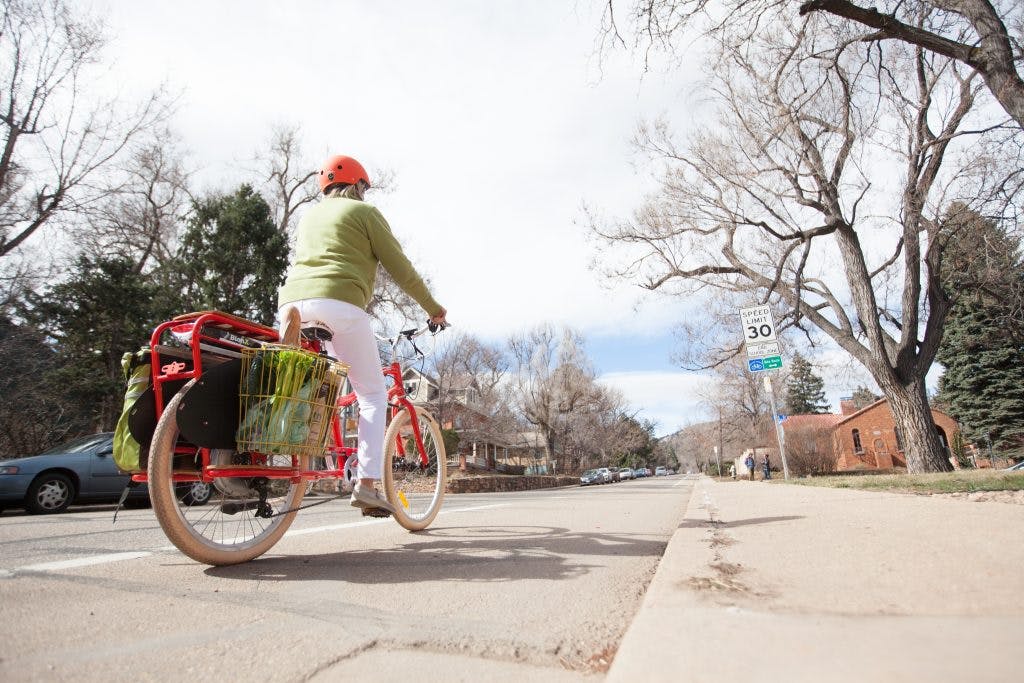
Electrifying the Bike Boom
November 18, 2020
At PeopleForBikes, we’re focusing our energy on maintaining the bike boom. As electric bicycles grow in popularity across the United States, they are becoming the preferred mode of transportation for many Americans in cities large and small. And for good reason: they shorten distances, squish hills ...
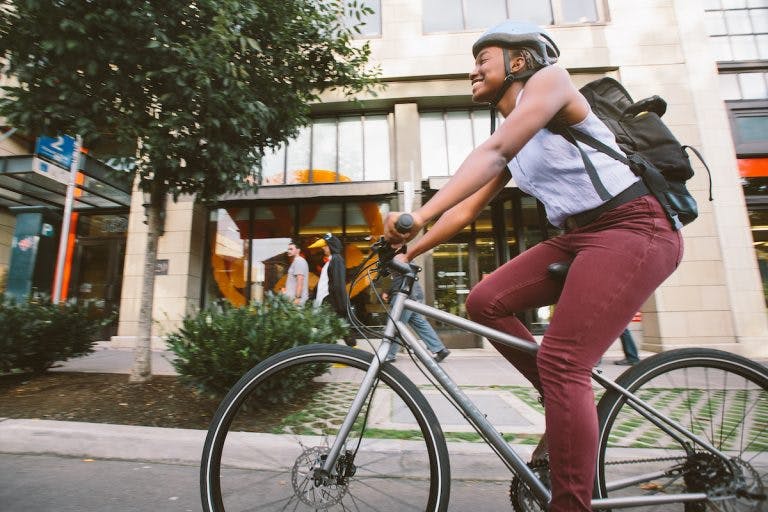
Call For Submissions: America’s Best New Bikeways of 2020
November 16, 2020
Cities are dynamic entities. If you look at photos from 100 years ago, most city streets would be unrecognizable. While preserving history is important, places and infrastructure require constant revision and revitalization to accommodate modern populations — working with the old to build the new. ...

Austin Positioned to Surpass America’s Greatest Biking Cities
November 6, 2020
In decisive fashion, 58% of Austin voters cast ballots on November 2 supporting Proposition A, a $7.1 billion public transit expansion and rail line plan, and 67% supported Proposition B, a $460 million active transportation bond meant to expand walking and biking networks throughout the city. ...

Department of the Interior Issues New Rules on Electric Bicycle Access
November 4, 2020
While electric bicycles have been rising in popularity, access to good trail systems — particularly on federal public lands — hasn’t always been so straightforward. However, swift changes are coming as several federal land management agencies have taken steps to modernize electric bicycle management ...

A Conversation with Tamika Butler on Race and Bicycling
October 30, 2020
Earlier this year, PeopleForBikes hosted our annual Bicycle Leadership Conference (BLC), the world’s largest gathering of bike industry leaders and executives. For this year’s virtual conference, day two was dedicated entirely to mobility justice and anti-racism in the bike industry. Among many amaz ...

Stay Safe, Stay Seen, Stay Pedaling: Helpful Tips to Keep Riding
October 23, 2020
There were a lot of reasons people got on their bikes this year. No matter what reason you had for experiencing life on two wheels, we’re here to help keep you riding through 2020 and for years to come. We’ve collected a few tips to assist you in staying safe, staying seen and staying pedaling, no m ...
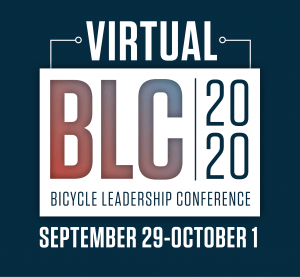
Highlights from the 2020 Virtual Bicycle Leadership Conference
October 20, 2020
From Sept. 29 to Oct. 1, nearly 500 attendees gathered for the PeopleForBikes’ 2020 Virtual Bicycle Leadership Conference (VBLC) to discuss and learn about diversity, equity and inclusion in the bike industry, e-bike market adoption, sales and ridership data, and continuing the momentum of the curre ...

Six Tips to Carry Your Summer Biking Habit into Fall
October 17, 2020
The leaves are turning, the air is crisp — fall is officially here. But the beauty of fall also means cooler temperatures, earlier sunsets and sometimes less than ideal weather. For the many of you who picked up biking for the first time or returned after a long hiatus this summer, the thought of br ...

The Gift of Gravel: Why You Should Take Your Bike Off Road This Fall
October 12, 2020
As gravel riding continues to surge in popularity, every unpaved road opens up a door to new exploration. Still uncertain about taking your next ride off the pavement? Here are five reasons why you should. ...

New to Biking? How to Ride Safely and Courteously Through 2020 and Beyond
October 12, 2020
Millions of Americans found joy on two wheels this year. Bike paths and trails are the busiest they’ve been in decades, and with more people sticking close to home, less cars on the road has allowed many riders to feel safer biking on the street. ...
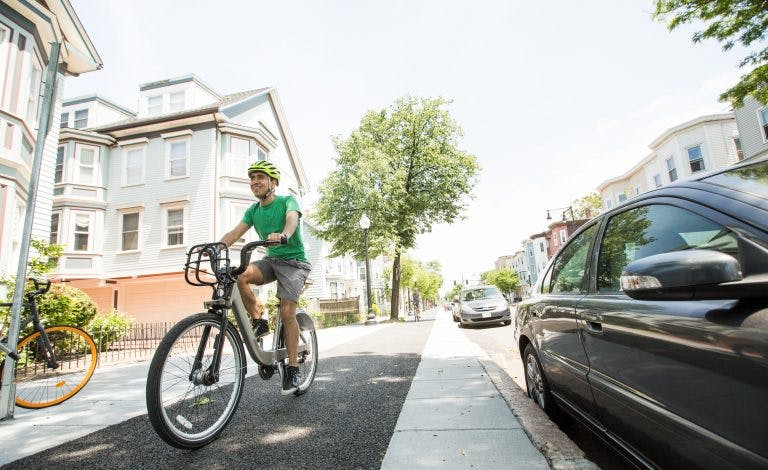
The Power of a Neighborhood Ride
October 6, 2020
This year, life has been different. Putting on a mask has become almost second nature and we’ve all been spending a lot more time close to home. Thankfully, when it comes to getting out on two wheels, a world of adventure is waiting right out your front door. ...

Meet the Bicyclist Who’s Riding the Underground Railroad
September 30, 2020
For Washington, D.C. native John Shackelford, riding a bike has always been about making a difference within himself. Growing up in Southeast Washington, D.C.’s predominantly African American quadrant, Shackelford got into bicycling in his teens after seeing some local bike messengers working around ...

PeopleForBikes Renews Partnership With National Interscholastic Cycling Association
September 24, 2020
PeopleForBikes is proud to announce a renewed partnership with the National Interscholastic Cycling Association (NICA) to promote and grow youth cycling across the U.S. ...

Lyft’s Vision For the Future of Cities
September 21, 2020
We believe cities should be built around people, not cars. Since Lyft’s inception, we’ve thought about how our vision would require us to compete with the convenience of car ownership to end traffic congestion, inspire a transportation revolution, and lead an equitable, scalable approach to shared b ...
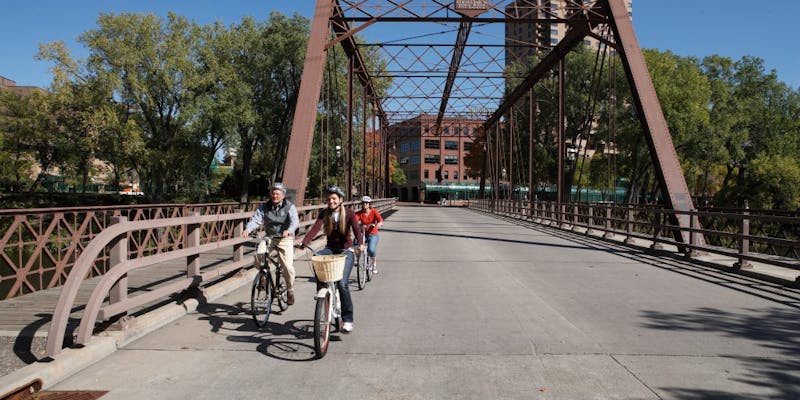
Moving Forward for Federal Transportation, Infrastructure and Recovery Funding
September 10, 2020
As Americans demand more resources for COVID-19 recovery efforts, Congress faces several funding deadlines on September 30, 2020. These deadlines include decisions on appropriations (Treasury funds used by federal agencies) to keep the government running, as well as our national transportation polic ...

Challenge Meets Potential: Children are the Future of Cycling
September 2, 2020
2020 has taught us many lessons, and one of the biggest things we’ve learned is that the world is widely connected and so are its challenges. Many of them are BIG challenges — the kind we might often think a bicycle has nothing to do with. ...

PeopleForBikes Creates Sustainability Working Group for a Better, Cleaner Bike Industry
September 1, 2020
The bike is often seen as a sustainability tool to help lower emissions rates in people’s personal lives. For example, choosing to ride a bike saves 250g/km of CO2 compared to driving a car. While the benefits of going by bike are clear, the bike industry overall still struggles to unpack what susta ...
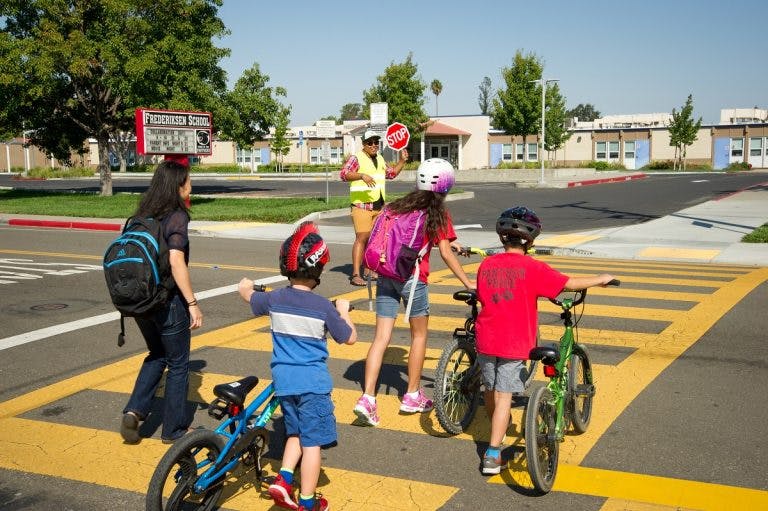
Safe Routes Partnership Centers Equity and Adaptability in Getting Back to School in 2020
August 31, 2020
While everyone is talking about kids returning to school this fall in the midst of a pandemic, there needs to be more discussions on the topic of how they will get there. Addressing increased and complicated transportation needs is necessary for a safe return to school in 2020. Many school districts ...

Find Your Next eMTB Adventure – Arkansas
August 21, 2020
PeopleForBikes’ eMTB map is your one-stop shop to find eMTB-friendly trails near you. We’re highlighting the best eMTB trails from coast to coast to make planning your next mountain biking adventure easy and accessible. ...

Helping America Recover and Move Forward with Bikes
August 11, 2020
COVID-19 has become a universal forcing function across all aspects of American life. Its devastating effects are making us reexamine how we work, gather, learn, shop, dine, access basic services and move around our cities and communities. We have changed our habits, are staying closer to home, reco ...

New Policy Proposals Recognize Bikes as a Solution to Climate Change
July 27, 2020
We’ve long known that bikes are a low-cost, easily implemented solution to combat climate change. Recent government studies reported that the transportation sector (cars, trucks, commercial aircraft, trains, etc.) is the largest source of climate change causing greenhouse gas (GHG) emissions in the ...

Find Your Next eMTB Adventure – North Carolina
July 21, 2020
PeopleForBikes is tracking eMTB access nationally and publishing the data on our eMTB map. This map is your one-stop shop to learn where eMTBs are allowed and find e-bike friendly trails near you. ...

E-Bikes an Asset for Recreational Trail Programs
July 16, 2020
David (Blake) Baker, an Outdoor Recreation Planner at the Bureau of Land Management’s Price Field Office in Utah, recently received e-bike loans, coordinated by PeopleForBikes, for him and his colleagues to see how their day to day jobs may be different with the use of e-bikes as a tool for daily tr ...
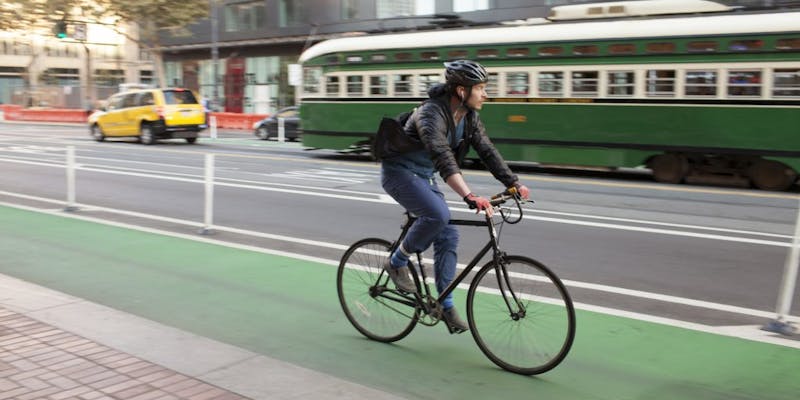
Cities Turn to Bike Networks For Recovery
July 14, 2020
By April 2020, more than 200 U.S. cities changed the layout of their streets by eliminating through traffic, slowing cars and opening roadways for people of all ages and abilities to comfortably enjoy the outdoors while city parks, fitness centers and schools were closed due to the COVID-19 pandemic ...

Find Your Next eMTB Adventure – Florida
July 2, 2020
Electric mountain bikes (eMTBs) allow for all members of the family to join in on the fun of mountain biking. Trail policies around the country are slowly being updated to allow some e-bikes in areas where traditional bikes are permitted, increasing access for eMTB riders looking for a great trail e ...


Senate Approves Long-Sought Deal for Recreation and Public Lands
June 17, 2020
UPDATE: On July 22, the Great American Outdoors Act cleared final passage in the U.S. House of Representatives and headed to the President’s desk to be signed into law. After decades of debate, the policies put forth in this bill- fully funding the LWCF at $900 million annually and addressing the gr ...

House Transportation Bill Proposes Major Increases for Federal Bike Programs
June 10, 2020
UPDATE: On July 1, the U.S. House of Representatives approved a sweeping $1.5 trillion infrastructure package. The broader package addresses American infrastructure needs ranging from energy, water resources, housing, telecommunications and the $494 billion transportation bill outlined below. Includ ...
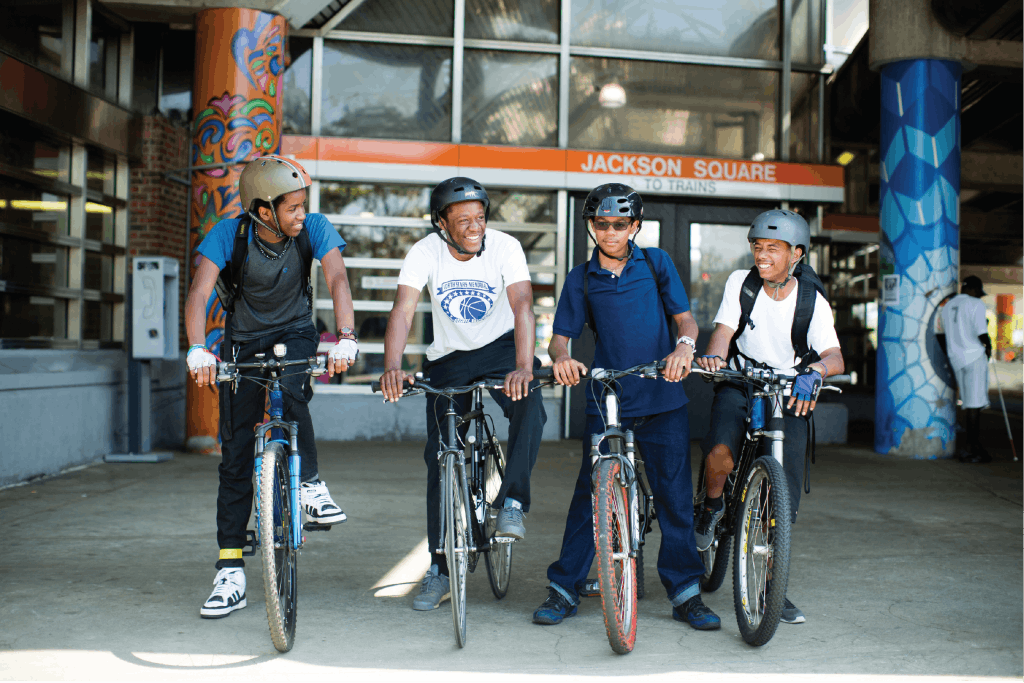
2020 City Ratings: Top 5 U.S. Cities for Bikes
June 9, 2020
Due to the constantly changing dimensions of the COVID-19 crisis, we encourage you to follow all current CDC guidelines as well as local travel advisories and recommendations. Take care of yourselves and loved ones. We’re all in this together. ...
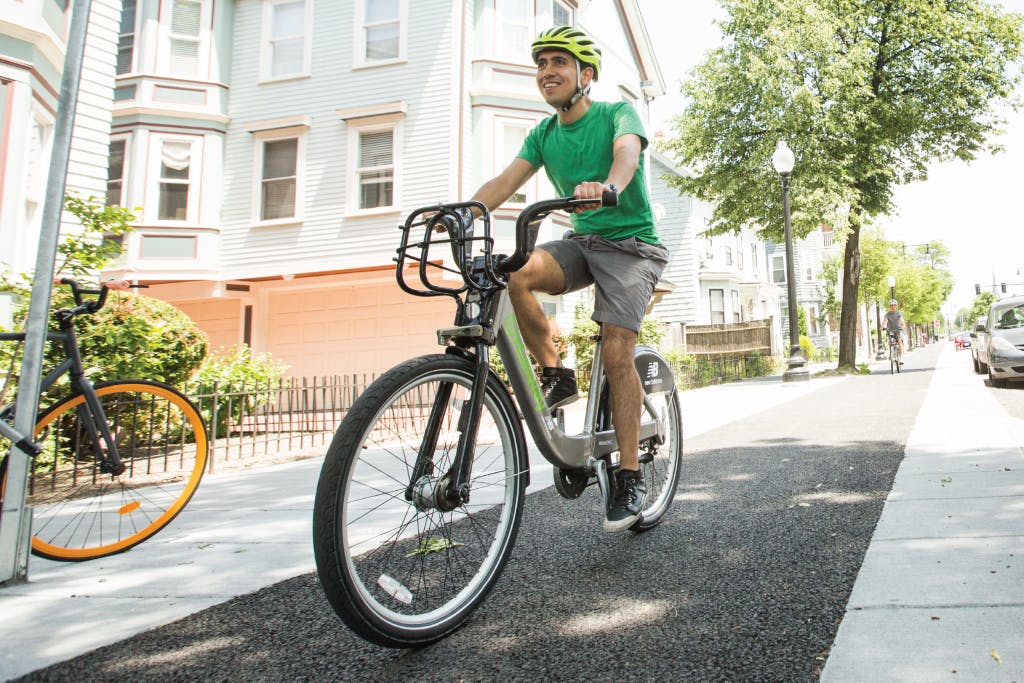
2020 City Ratings: Ridership
June 9, 2020
Due to the constantly changing dimensions of the COVID-19 crisis, we encourage you to follow all current CDC guidelines as well as local travel advisories and recommendations. Take care of yourselves and loved ones. We’re all in this together. ...
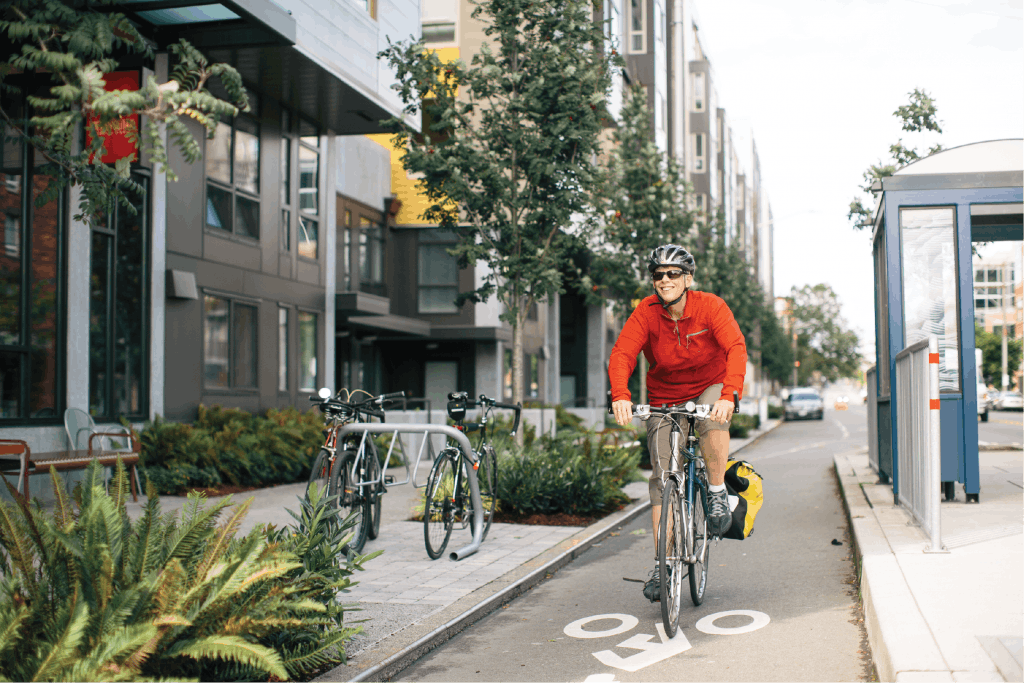
2020 City Ratings: Network
June 9, 2020
Due to the constantly changing dimensions of the COVID-19 crisis, we encourage you to follow all current CDC guidelines as well as local travel advisories and recommendations. Take care of yourselves and loved ones. We’re all in this together. ...
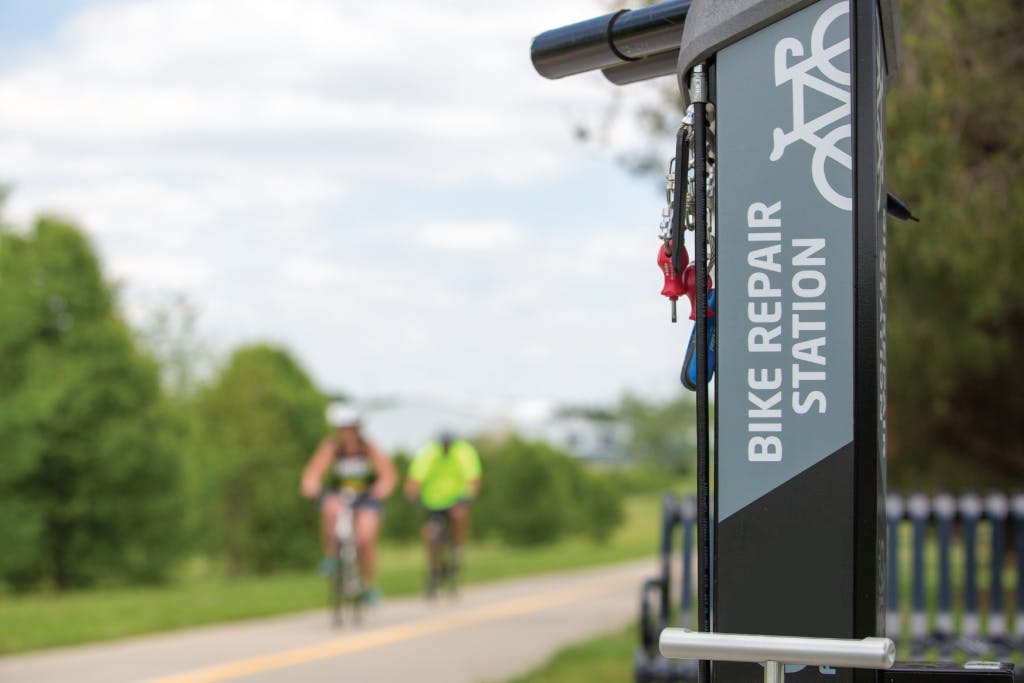
2020 City Ratings: Acceleration
June 9, 2020
Due to the constantly changing dimensions of the COVID-19 crisis, we encourage you to follow all current CDC guidelines as well as local travel advisories and recommendations. Take care of yourselves and loved ones. We’re all in this together. ...

2020 City Ratings: Safety
June 9, 2020
Due to the constantly changing dimensions of the COVID-19 crisis, we encourage you to follow all current CDC guidelines as well as local travel advisories and recommendations. Take care of yourselves and loved ones. We’re all in this together. ...
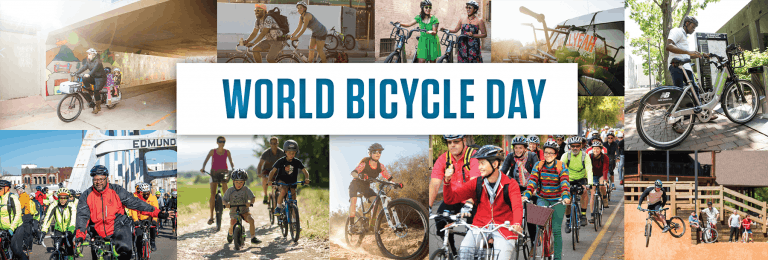
Celebrating The Rise of Bicycling
June 3, 2020
Due to the constantly changing dimensions of the COVID-19 crisis, we encourage you to follow all current CDC guidelines as well as local travel advisories and recommendations. Take care of yourselves and loved ones. We’re all in this together. ...

Prioritizing Bikes in Post-Pandemic Policies in Washington, D.C.
May 21, 2020
Regulations and policies for essential business and other activities are changing rapidly county-by-county, state-by-state and at the federal level. PeopleForBikes is continuing to advocate for bikes nationally and pulling together resources to offer you, your business and your bike riding some much ...

E-Bike Pilot Programs Can Inform Data-Driven Policy Making
May 20, 2020
On Thursday, May 14, PeopleForBikes hosted an industry webinar, Using pilot programs to navigate e-bike use on the trail, where both members of the bike industry and land managers learned more about the use of e-bike pilot programs to inform data-driven e-bike management decisions. ...
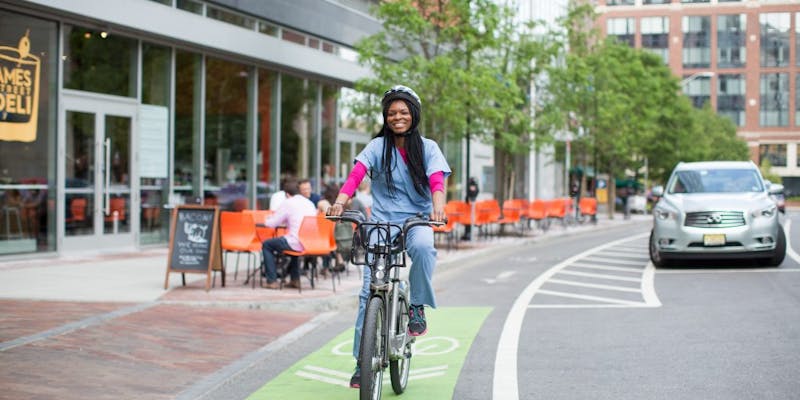
The Importance of Bikes in the Future of Urban Mobility
May 19, 2020
Due to the constantly changing dimensions of the COVID-19 crisis, we encourage you to follow all current CDC guidelines as well as local travel advisories and recommendations. Take care of yourselves and loved ones. We’re all in this together. ...

How You Can Help Improve E-bike Access Across the nation
May 7, 2020
Federal land management agencies have historically defined electric bicycles (e-bikes) as motor vehicles and therefore restrict their usage in many of the places we love to ride bikes on public lands. These long-standing laws do not recognize what a modern day, low speed e-bike is and the benefits i ...

Some Good News for Bicycling
May 1, 2020
This op-ed was written by PeopleForBikes COO Jenn Dice for Bicycle Retailer and Industry News. View the original story here. ...
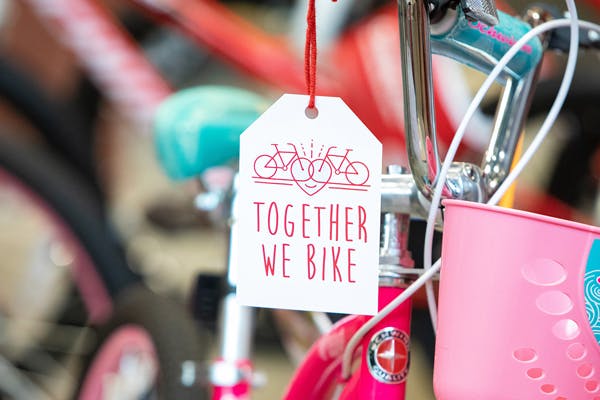
How COVID-19 Has Impacted the Foster Care Community and What Bikes Can Do to Help
April 30, 2020
In a time of crisis, the bicycle shines bright as a potential solution. For the large group of individuals living within the foster care community, the bike can mean the difference between personal independence and feeling trapped within the pressures of our current situation. ...

An Earth Day Different From the Rest
April 21, 2020
Due to the constantly changing dimensions of the COVID-19 crisis, we encourage you to follow all current CDC guidelines as well as local travel advisories and recommendations. Take care of yourselves and loved ones. We’re all in this together. ...
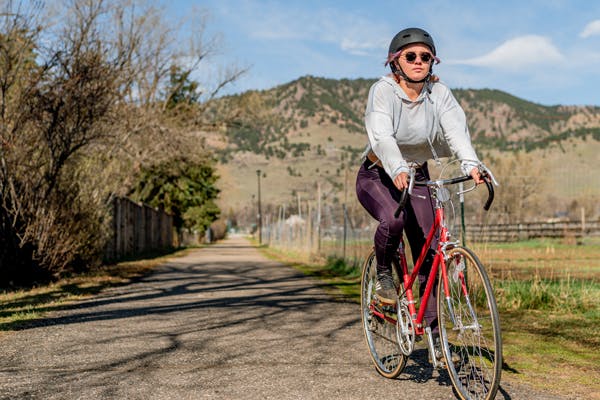
Safe Cycling During Social Distancing
April 16, 2020
Due to the constantly changing dimensions of the COVID-19 crisis, we encourage you to follow all current CDC guidelines as well as local travel advisories and recommendations. Take care of yourselves and loved ones. We’re all in this together. ...

Study Finds Bike Lanes Can Provide Positive Economic Impact in Cities
April 15, 2020
According to a new study released by Portland State University’s Transportation Research and Education Center in Oregon, bicycle lanes and infrastructure can produce tangible economic benefits for cities. ...

Pedaling Through The Pandemic: Staff Rides
April 15, 2020
While we’re working from home, PeopleForBikes staff members have found a multitude of ways to stay mentally and physically active. We’ve done puzzles, walked our dogs, walked our dogs again, started doing at-home yoga classes, learned new recipes — did we mention puzzles? Despite all of the day-to-d ...

What a $2 Trillion Federal Stimulus Package Means for You and Your Business
March 27, 2020
PeopleForBikes is closely monitoring the consequences of COVID-19 on the health and economic security of the United States, especially for those in and around the bicycle industry. We are working hard in Washington, D.C., where relief packages that could benefit bicycling are rapidly moving through ...

What a $2 Trillion Federal Stimulus Package Means for You and Your Business
March 23, 2020
PeopleForBikes is closely monitoring the consequences of COVID-19 on the health and economic security of the United States, especially for those in and around the bicycle industry. We are working hard in Washington, D.C., where relief packages that could benefit bicycling are rapidly moving through ...
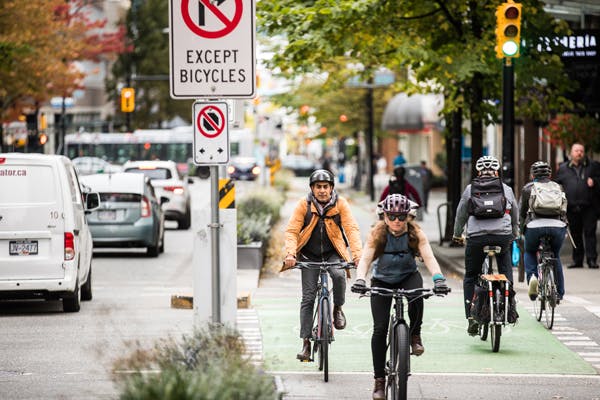
Riding More Now? Just Starting? We’re Here to Help
March 20, 2020
Social distancing measures are taking public transit and rideshare out of the equation for many commuters. More people are riding bikes now, and not just to work. Here’s some helpful tips for those looking to go by bike in the weeks ahead. ...

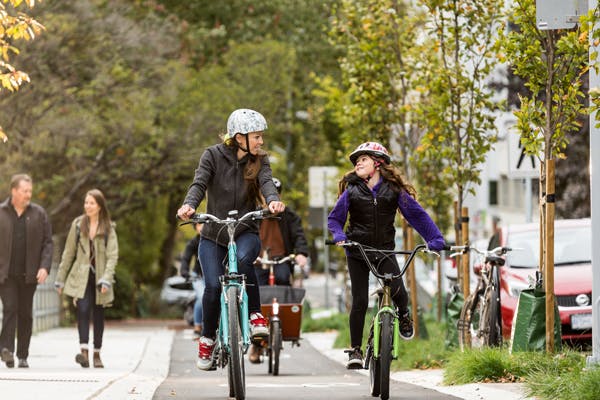
How Paris Raised Bike Ridership 54 Percent in One Year
March 5, 2020
As a part of the French government’s mission to combat climate change, Parisian Mayor Anne Hidalgo announced her Plan Velo in 2015. The specific goals: double cycling lanes in the city from 700km to 1,400km by the end of 2020 and triple the number of cycling commuters by 2024. While the increased la ...

America Is Becoming an Indoor Nation: What Can We Do About It?
February 18, 2020
Over the last week of January, a number of PeopleForBikes staff attended the Outdoor Retailer Snow Show in Denver. In addition to being a convention center packed full of next year’s drool-worthy outdoor gear, it’s also one of the largest national gatherings of outdoor industry professionals, provid ...

A Dozen Bucket List Rides for 2021
January 28, 2020
We hope you’re gearing up to take some great rides in 2021. From oceanside coastal rides in the Pacific Northwest to gravel epics in Colorado to country road cruises in New York, we’ve compiled a list of 12 can’t-miss rides from 2020. Our new Ride Spot app will get you to each and guide you to great ...
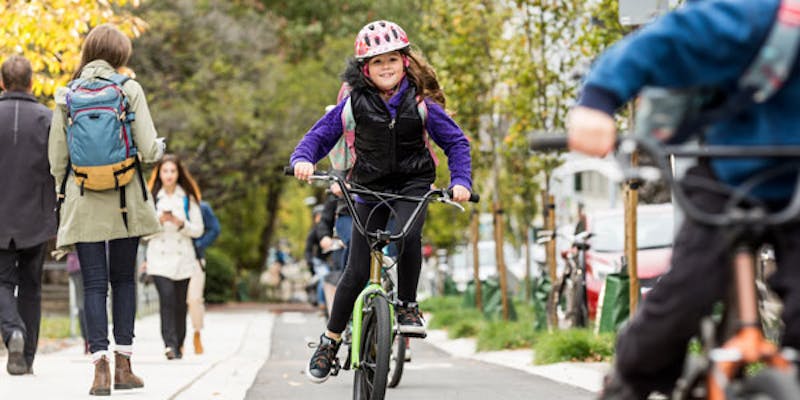
Tariff relief for kids’ bikes – a big win for young riders, family budgets and the bike industry
January 23, 2020
Our goal at PeopleForBikes is to get more people riding bikes more often. Usually, this means working with communities, states, or the federal government to provide safer, more accessible places to ride so that every American has the opportunity and ability to bike where they live. ...
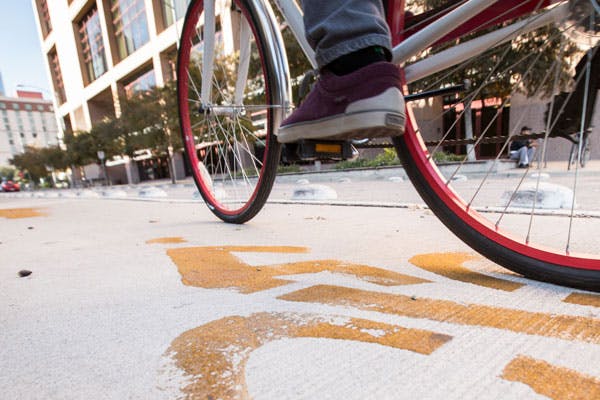
Bike Rider Safety: Thoughts on the National Transportation Safety Board Recommendations
January 23, 2020
Bike rider safety moved to the front of the national transportation policy debate in November 2019 when the National Transportation Safety Board (NTSB) commissioned its first study on bicycling safety in 47 years. ...

Bureau of Reclamation’s emerging e-bike policies
January 4, 2020
Thanks to the Department of Interior’s Secretarial Order 3376, more places to ride an e-bike are around the corner. The Bureau of Reclamation (BOR) was one of four federal agencies instructed to update their e-bike policy for their recreational areas in August 2019. ...

Riding on BLM lands? What you need to know
December 18, 2019
On Oct. 22, 2019, the Bureau of Land Management (BLM) implemented the Department of Interior’s Secretarial Order 3376 with its interim electric bicycle (e-bike) policy. ...
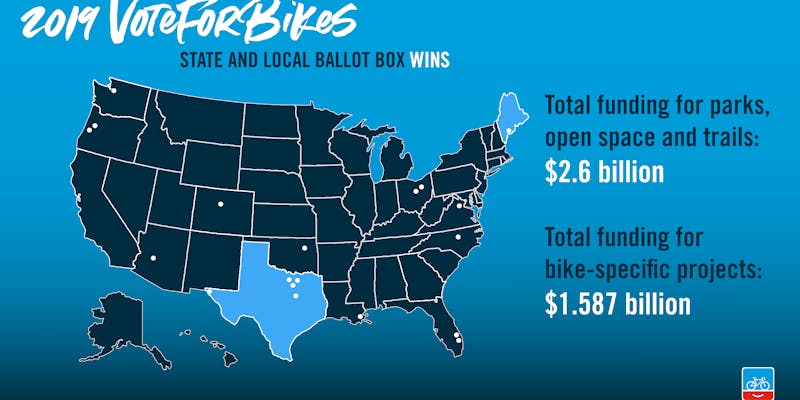
Voters Approve Bike Funding Nationally at the Ballot Box
November 26, 2019
In 2019, voters across the country supported bikes at the ballot box. From funding for bike lanes to new trails, it’s clear that Americans want to improve places to ride bikes. ...

Department of Interior Agencies Issue Interim E-bike Policies
November 8, 2019
On Oct. 22, The U.S. Department of Interior issued a press release regarding Secretarial Order 3376. The statement provided an update on the order’s directive for the Bureau of Land Management (BLM), Bureau of Reclamation (BOR), Fish and Wildlife Service (FWS) and the National Park Service (NPS) to ...
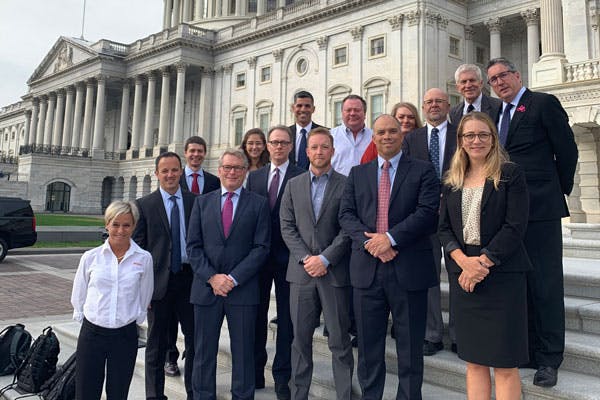
PeopleForBikes Connects Bike Executives with Federal Lawmakers
November 4, 2019
On Wednesday, Oct. 30, PeopleForBikes hosted bicycle industry leaders from across the nation in Washington, D.C. to advance the industry’s priorities at the federal level. Through our executive fly-ins, business owners become policy leaders, and show lawmakers the connection between ridership, busin ...

E-Bikes Can Now Access 200+ National Wildlife Refuges
October 23, 2019
On Oct. 22, The U.S. Fish and Wildlife Service (FWS) announced its policy for electric bicycle (e-bike) use on National Wildlife Refuge System Lands. Director’s Order 222 is in response to the Department of Interior Secretary David Bernhardt’s Aug. 29 Secretarial Order 3376 directing the Bureau of L ...

PeopleForBikes Welcomes New Marketing Director Jose Maldonado
October 8, 2019
Jose Maldonado, a widely respected marketing leader forBackcountry.com and Competitive Cyclist (CC), will join the PeopleForBikes (PFB) staff team Oct. 14 as marketing director. Maldonado was selected from a pool of 250 applicants. He will guide all of PFB’s marketing projects, including the further ...
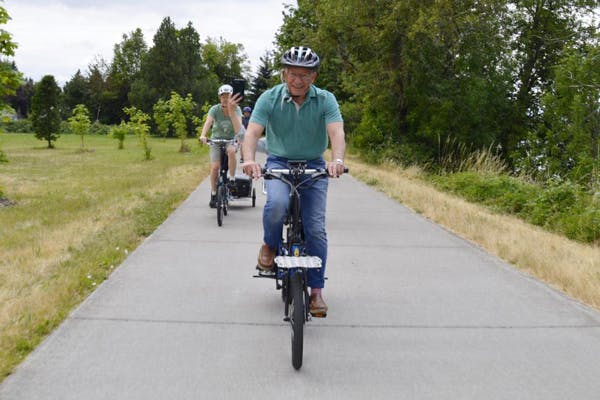
Bike Businesses Roll Out the Welcome Mat for Congressional Leaders
September 13, 2019
Taking advantage of the annual summer recess in D.C., PeopleForBikes arranged five August in-district meetings between bike business leaders and members of Congress (and their staffers) to talk infrastructure funding, public lands policies and tariff relief. Members of the House and Senate were invi ...
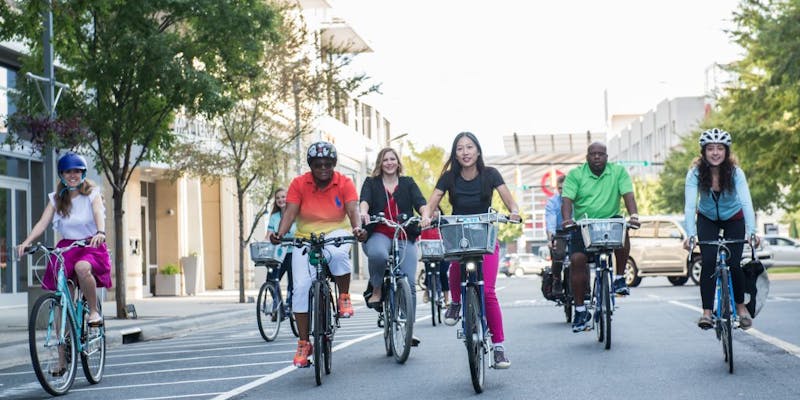
New California Law Provides Funding for E-bike Purchases
September 11, 2019
On Friday, Sept. 6, California’s Governor Gavin Newsom signed Senate Bill 400 (SB 400) into law. This bill provides funding for low-income and disadvantaged communities to purchase an e-bike or use a bikeshare program, making e-bikes and bikeshares more accessible means of transportation. ...

Keeping Momentum Alive for Recreation 2.0
July 19, 2019
Across most of America, the snow has melted, the sun is shining, and here at PeopleForBikes, we can’t get enough rides out on our public lands to soak in it all. We’re on two wheels celebrating and enjoying the success of the public lands package (the John D. Dingell Jr. Conservation, Management, an ...
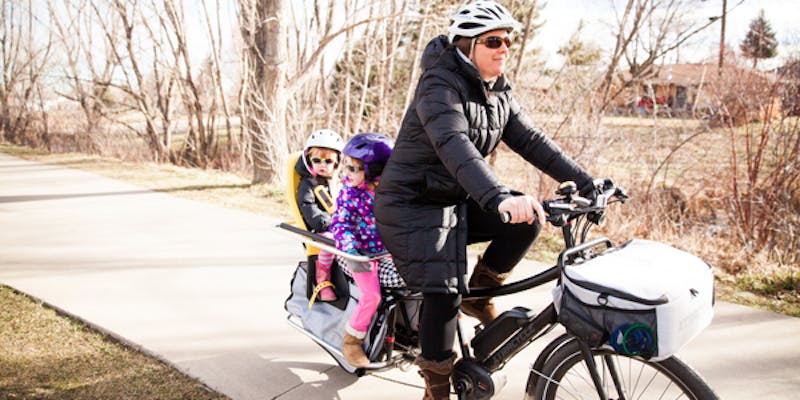
22 States Now Follow the Three Class E-bike System, Doubling Total in Six Months
July 19, 2019
2019 started with 11 states using the model three-class e-bike definitions. As of June 19, 22 states now define e-bikes within the three classes, effectively doubling the total in just six months. These eleven new states are: Georgia, Idaho, Indiana, Maine, Maryland, New Hampshire, New Jersey, Oklah ...

How to Grow the Bike Community: 3 Ideas from Bicycle Advocacy Consultant Courtney Williams
June 20, 2019
At PeopleForBikes, we believe we can all do more to grow the cycling community. We’ve been doing the work for nearly 20 years and we want to keep the momentum going. We’re committed to improving inclusiveness in our messaging, broadening the audiences we reach, and increasing our staff diversity. Jo ...
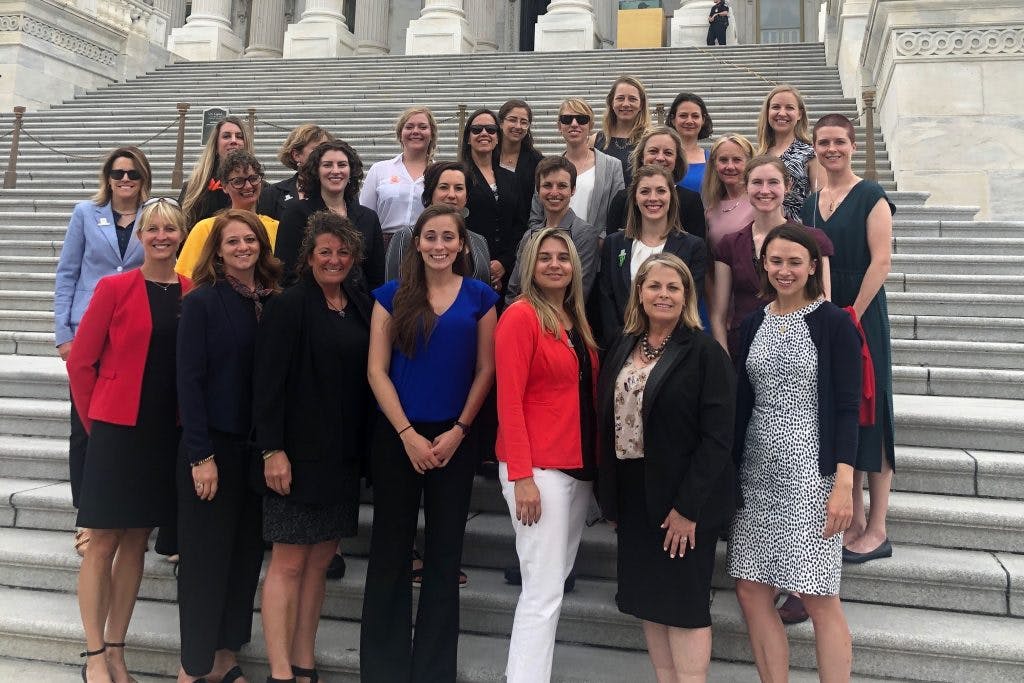
Bike Industry Leaders Roll into Washington for Women’s Fly-in
June 17, 2019
Earlier this month, 24 women representing the U.S. bike industry converged in Washington, D.C., for the annual PeopleForBikes women’s fly-in. Our largest fly-in yet presented a valuable opportunity to work with industry peers to promote federal funding for bike infrastructure policies. ...
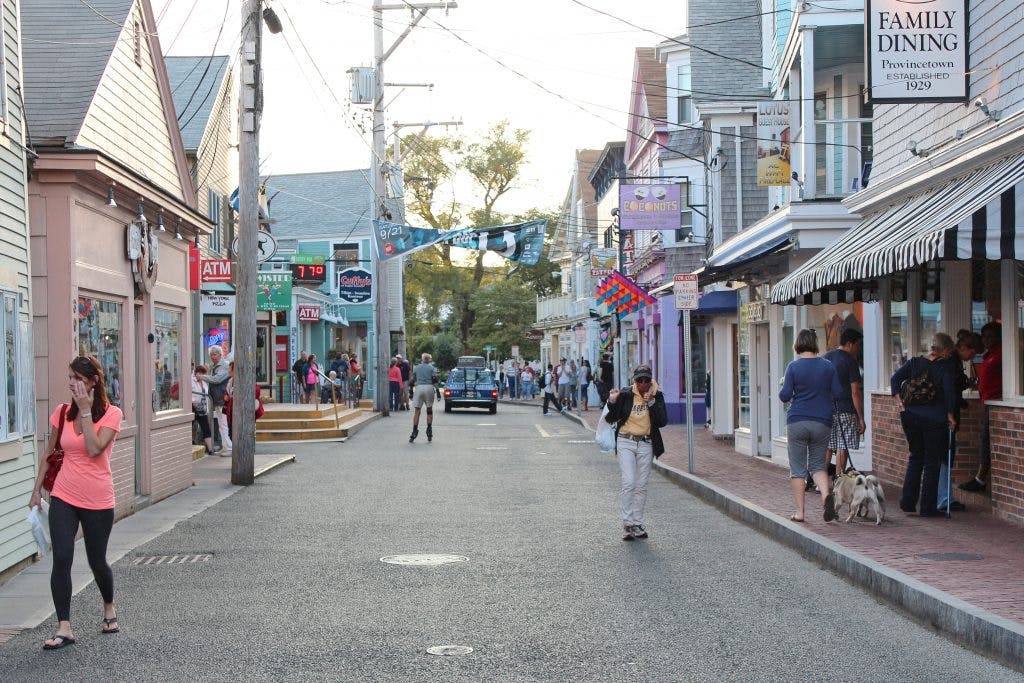
Unlock Your Community’s Potential Using the Bicycle Network Analysis
June 12, 2019
How can you get a more detailed picture of the bike network in your town or city? Help us help you by improving the accuracy of the The Bicycle Network Analysis. Your input aids us in making sure that the constantly evolving and improving BNA project is a useful tool that provides actionable insight ...

How to Grow the Bike Community: 3 Ideas from Bike Shop Owner Beth Morford
June 12, 2019
At PeopleForBikes, we believe we can all do more to grow the cycling community. We’ve been doing the work for nearly 20 years and we want to keep the momentum going. We’re committed to improving inclusiveness in our messaging, broadening the audiences we reach, and increasing our staff diversity. Jo ...
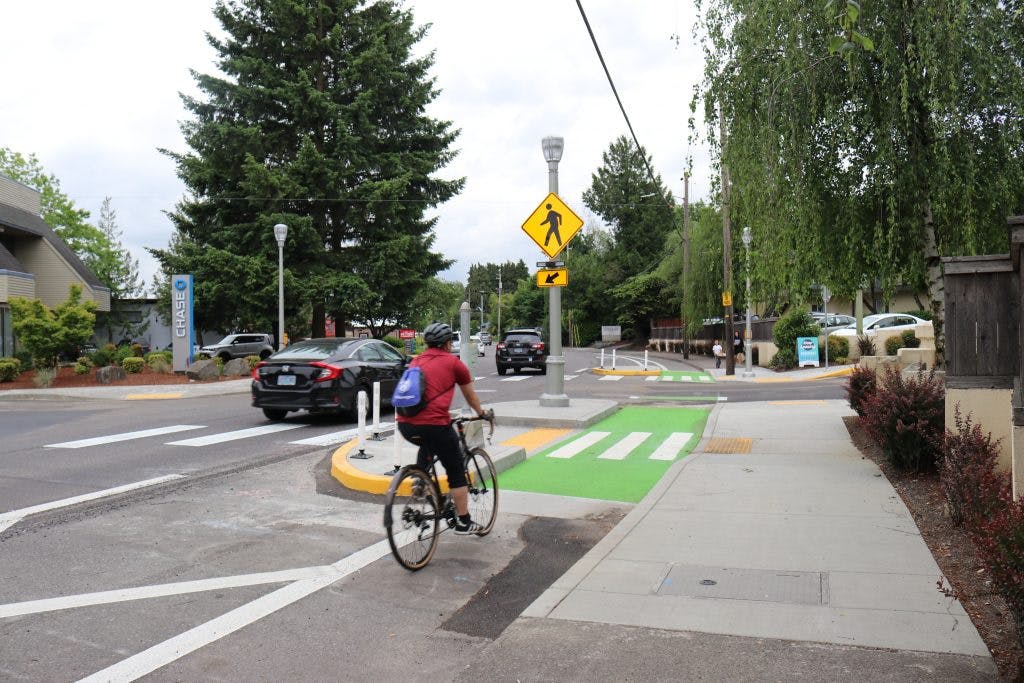
Protected Bike Lanes Make Northeast Portland Safer and More Inviting
June 10, 2019
How can a city stimulate the local economy and create a safer neighborhood? Northeast Portland is proving that protected bike lanes do both. ...

How to Grow the Bike Community: 3 Ideas from Cycling Tips Editor James Huang
June 5, 2019
At PeopleForBikes, we believe we can all do more to grow the cycling community. We’ve been doing the work for nearly 20 years and we want to keep the momentum going. We’re committed to improving inclusiveness in our messaging, broadening the audiences we reach, and increasing our staff diversity. Jo ...
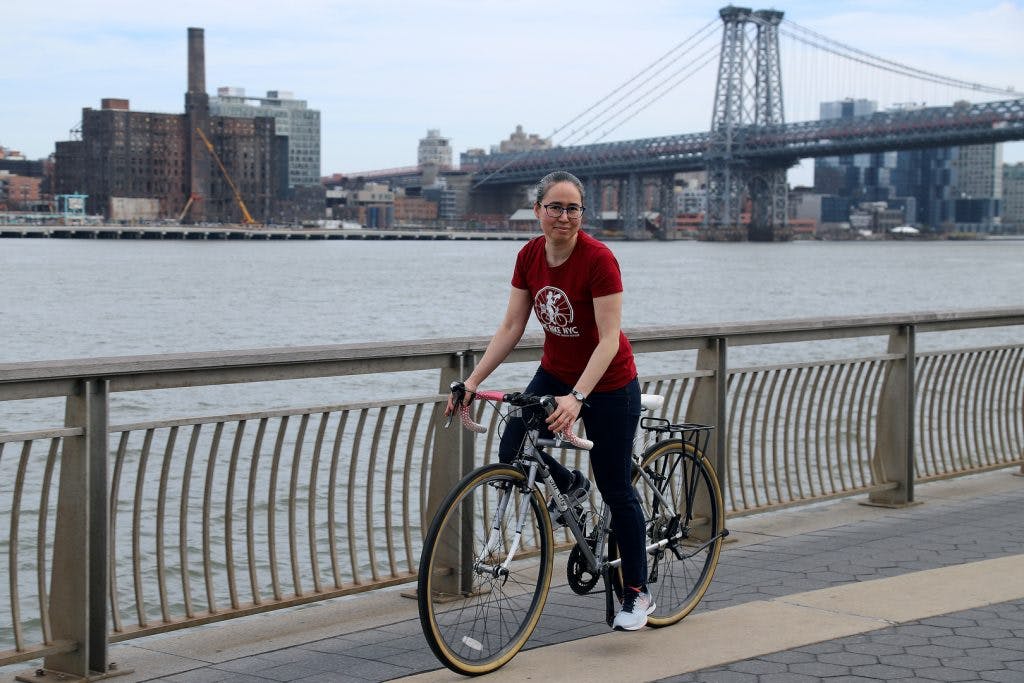
How to Grow the Bike Community: 3 Ideas from Bike Advocate Chantal Hardy
May 30, 2019
At PeopleForBikes, we believe we can all do more to grow the cycling community. We’ve been doing the work for nearly 20 years and we want to keep the momentum going. We’re committed to improving inclusiveness in our messaging, broadening the audiences we reach, and increasing our staff diversity. Jo ...

Growing Youth Participation: How Do We Get More Kids on Bikes?
May 23, 2019
Last month, PeopleForBikes hosted a DRAFT event — our industry meetup series — during the Bicycle Leadership Conference in Monterey, California. Speakers focused on discussing strategies for increasing youth participation in outdoor and physical activities, sharing their experience and knowledge wit ...

How to Grow the Bike Community: 3 Ideas from Top Triathlete Max Fennell
May 16, 2019
At PeopleForBikes, we believe we can all do more to grow the cycling community. We’ve been doing the work for nearly 20 years and we want to keep the momentum going. We’re committed to improving inclusiveness in our messaging, broadening the audiences we reach, and increasing our staff diversity. Jo ...

Building for Tomorrow
May 15, 2019
“Infrastructure Week” may not be the most alluring phrase you’ll ever read, but it certainly is one of the most important. Infrastructure is the framework on which our nation operates — the networks of highways, streets and roads that connect us to jobs, businesses and our homes; the trails and path ...

2019 Most Complete Network Scores
May 14, 2019
Network is the category that cities have the most direct influence on — the one where big changes can actually be made. A more complete network leads to a higher level of safety and more ridership. Building a complete low-stress network is not fast or easy work. It’s not just sharrows and paint. It’ ...
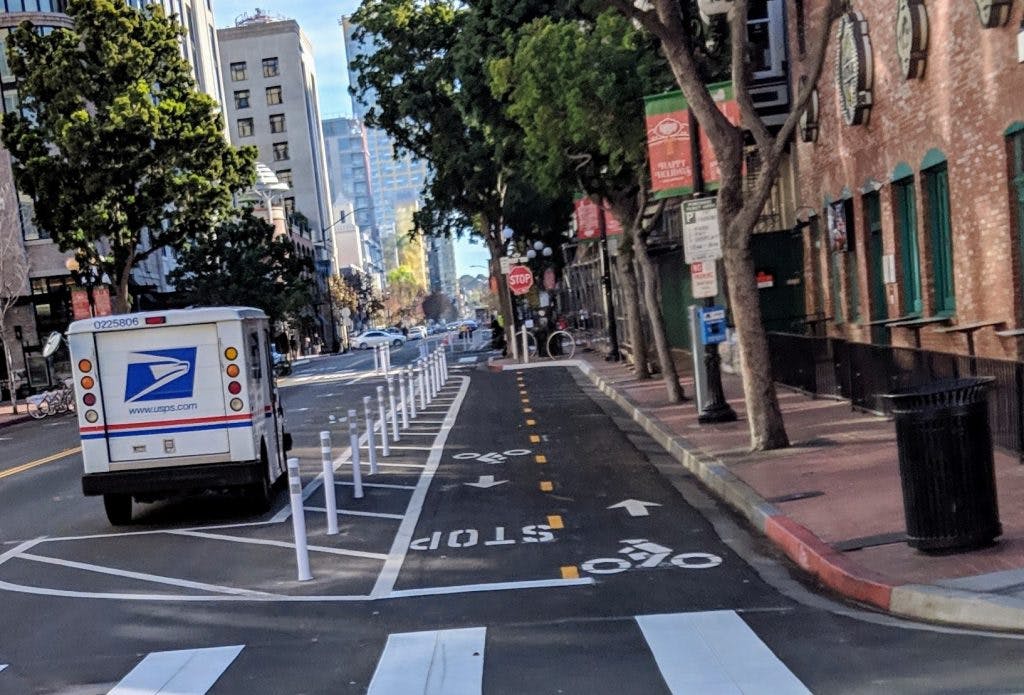
2019 Safest Cities
May 13, 2019
The characteristics of any sized city that scores well in Safety are people feeling safe, low fatality rates and low rates of injuries from traffic crashes. We know that more people ride — specifically more women ride — when they not only are safe, but also feel safe. Overall, a high safety score re ...

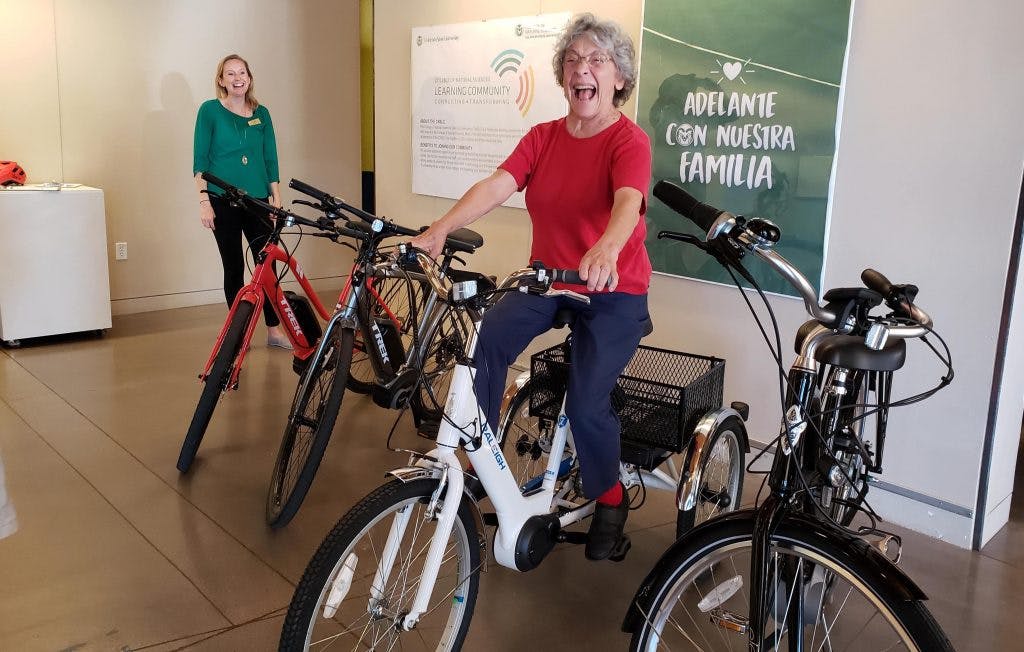
The Power of E-Bikes in Fort Collins, Colorado
May 9, 2019
One way that any community can improve biking is to encourage more people to ride. Slow-roll events and demos allow people to try something they’ve never done before — and that they might be intimidated about — in a safe environment. ...
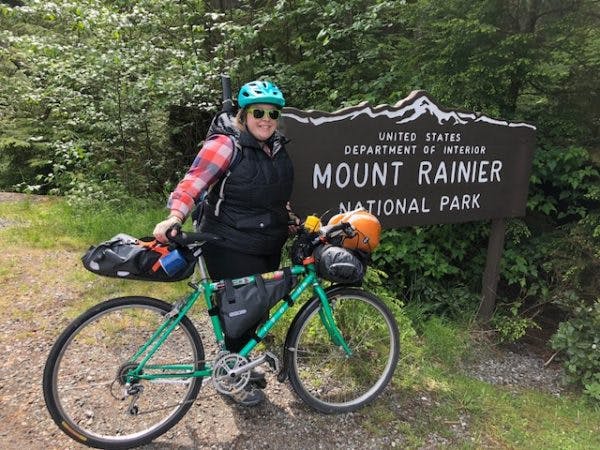
How to Grow the Bike Community: 3 Ideas from Marley Blonsky
May 8, 2019
At PeopleForBikes, we believe we can all do more to grow the cycling community. We’ve been doing the work for nearly 20 years, and are proud of our Better Bikeshare partnership. But we want to keep the momentum going. We’re committed to improving inclusiveness in our messaging, broadening the audien ...
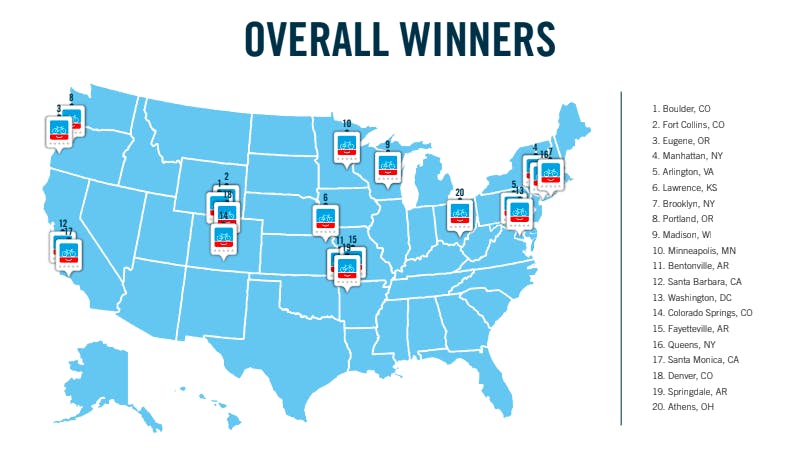
2019 City Ratings: Top Overall Cities
May 5, 2019
We’re pleased to release the 2019 PlacesForBikes City Ratings. Overall this year we saw a much higher rate of participation in our Community Survey and City Snapshot. This means we collected better data and have an improved picture of bicycling in the United States. ...

How to Grow the Bike Community: 3 Ideas from Gloria Liu
May 2, 2019
At PeopleForBikes, we believe we can all do more to grow the cycling community. We’ve been doing the work for nearly 20 years and we want to keep the momentum going. We’re committed to improving inclusiveness in our messaging, broadening the audiences we reach, and increasing our staff diversity. Jo ...

Two-Way Protected Bike Lane Critical Link in LA’s Downtown Bike Network
May 2, 2019
The newly opened Spring Street two-way protected bike lane is the first half of a project that will provide a major north-south connector for downtown Los Angeles this year. Collectively called the Main & Spring Forward Project, both streets will connect to 11th, which has a new green bike lane goin ...

How to Grow the Bike Community: 3 Ideas from Tamika Butler
April 25, 2019
At PeopleForBikes, we believe we can all do more to grow the cycling community. We’ve been doing the work for nearly 20 years and we want to keep the momentum going. We’re committed to improving inclusiveness in our messaging, broadening the audiences we reach, and increasing our staff diversity. Jo ...

How to Grow the Bike Community: 3 Ideas from Athlete and Advocate Ayesha McGowan
April 19, 2019
At PeopleForBikes, we believe we can all do more to grow the cycling community. We’ve been doing the work for nearly 20 years and we want to keep the momentum going. We’re committed to improving inclusiveness in our messaging, broadening the audiences we reach, and increasing our staff diversity. Jo ...

How bicycle retailers can help grow ridership: foster the community
April 10, 2019
Creating and marketing safe, convenient places to ride isn’t just good for the community, it also boosts a bicycle retailer’s bottom line. Sales increase when cities make streets, paths and trails better for people on bikes. In fact, we know that retail sales through the Independent Bicycle Dealer c ...
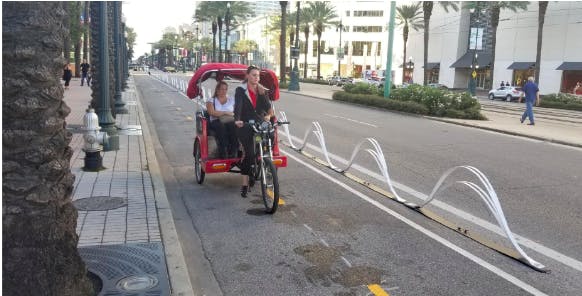
New Orleans’ Connect the Crescent: Final Report
April 3, 2019
Last year, local advocacy organization Bike Easy, the City of New Orleans, and other community partners installed Connect the Crescent, a three-month demonstration project that added 3.5 miles of protected bikeways, improvements for people walking and taking transit, art installations, and open stre ...
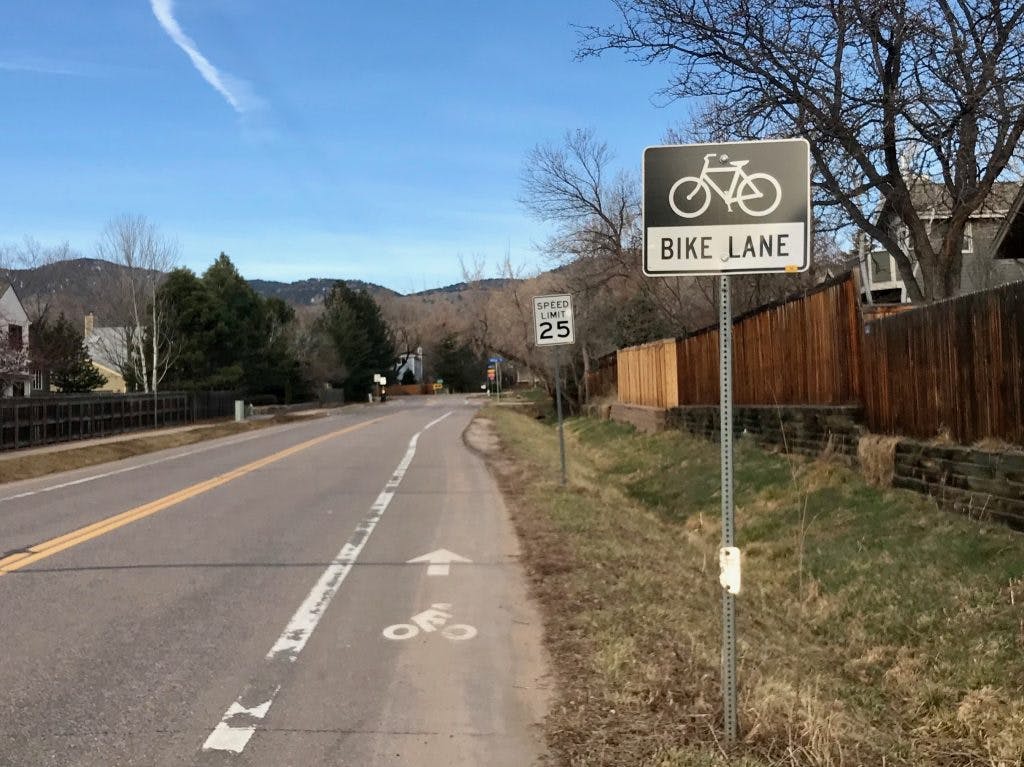
Speed Limits Directly Impact the Quality of a Bicycle Network
March 29, 2019
Starting this year, the BNA no longer assumes that all residential streets are set at a 25 mph speed limit. Unless updates are made in OpenStreetMap, the BNA now assumes speed limits according to the street type, and state laws. We’ve recently identified 10 states that have residential street speed ...

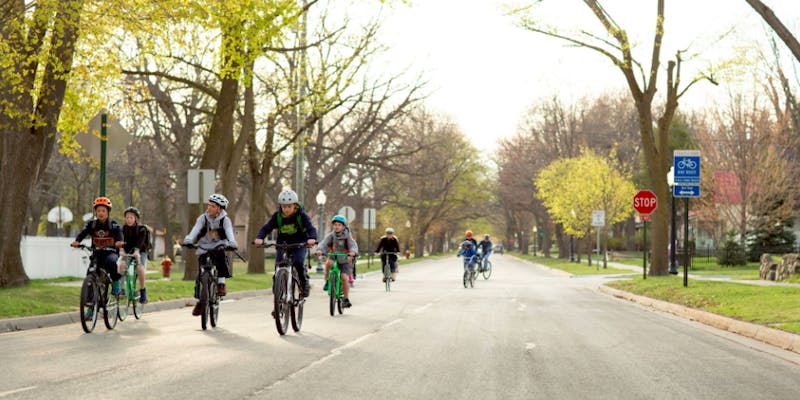
How to Get Kids Involved: Be Flexible, Be Creative
March 4, 2019
Start with an idea, and just let it keep growing. When Ty Schmidt’s oldest son started elementary school, Ty was bothered by the ordeal of dropping him off in the morning, and the fact that no one was riding a bike or walking. He decided there was another way. Ty and his wife Johanna started a routi ...

Wyoming Lawmakers Pass E-bike Bill
February 22, 2019
UPDATE 2/26: On Tuesday, Feb. 26, Governor Gordon signed the e-bike bill into law. ...
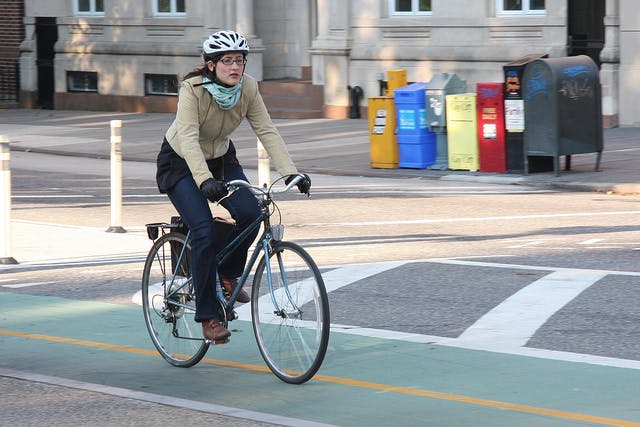
Bike Commuting: Growing or Shrinking in the United States?
January 23, 2019
Data can be used to tell a number of different stories. But statistics from short periods of time are often unstable, if not unreliable. What we know is that in places committed to and producing better bike infrastructure, the number of people on bikes has increased across the board. ...

A Dozen (Plus One) Bucket List Rides for 2019
January 10, 2019
Great bike rides can start anywhere, but sometimes it’s worth the extra travel to race to a backdrop of breathtaking coastal landscapes, glorious mountain peaks or rugged desert terrain. We’ve highlighted 13 bike events that we think are worth the trip in 2019 — including some old favorites. ...
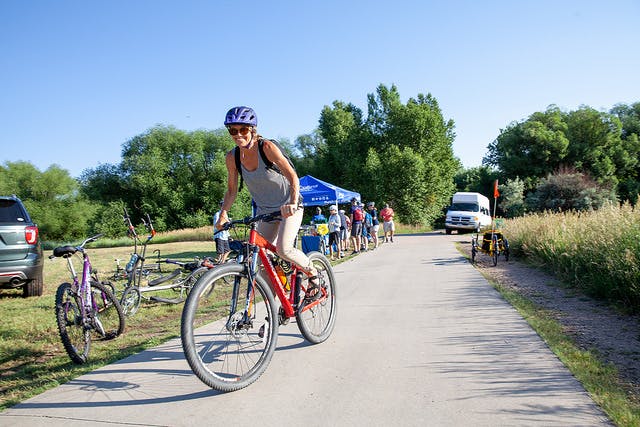
Fort Collins’ Programming Shines
January 7, 2019
Fort Collins, Colorado, is working full speed ahead toward a more complete network, with even more people on bikes. In addition to new infrastructure on the ground, they’ve also focused on outreach and programming. Tessa Greegor, manager of FC Bikes, says that the outreach is really the activation p ...
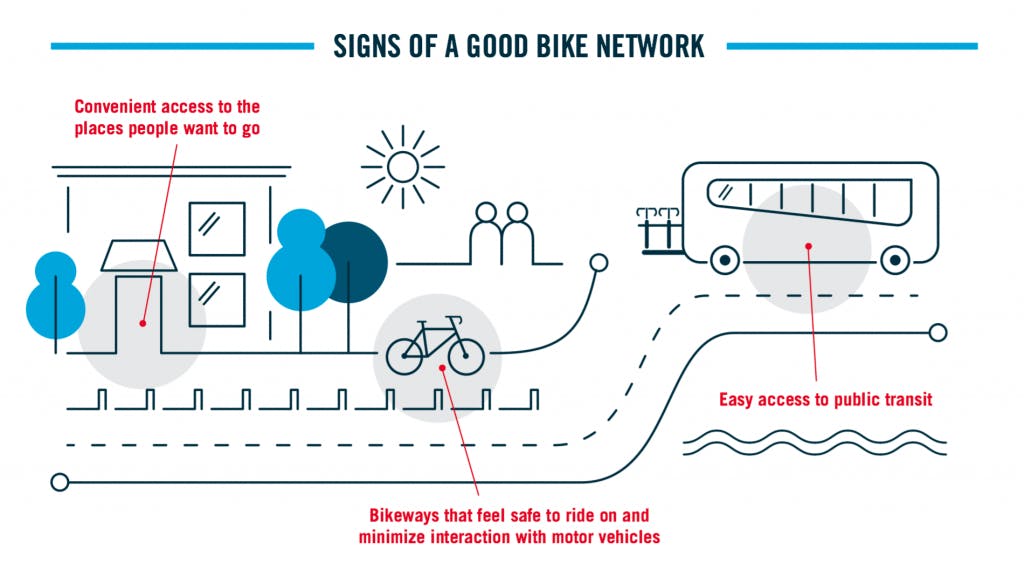
Biking in the US: 2018
December 28, 2018
The PlacesForBikes City Ratings provide a data-driven picture of what it’s like to ride bikes in the US — with a focus on what we can do to improve the experience. We look at all aspects of bike riding: from safety, to how smoothly a bike network connects people to the places they want to go, to how ...

Making Changes Takes Support
December 27, 2018
PFB’s Big Jump Project continues to provide resources for cities pushing boundaries to accelerate the rate of change. This year, our collaboration with local governments and non-profit organizations yielded big results in a handful of cities. ...
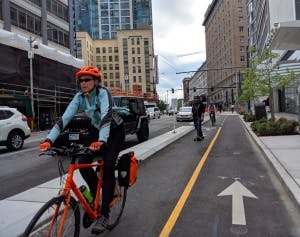
America’s 10 Best New Bikeways of 2018
December 18, 2018
Since we first started our annual look back at great new bikeways five years ago, we’ve noticed an evolution in progress. First, bike infrastructure has continued to make its way from the big cities to smaller towns and communities. Next, networks have become better connected — more complete. Also, ...

Colorado Bike Retailer Hosts Staff of U.S. Senator
December 18, 2018
In early November, Wheat Ridge Cyclery hosted members from the staff of U.S. Senator Cory Gardner (R-CO). The Denver-area bike shop is known for its wide-ranging inventory, selling everything from cruisers to highly technical mountain bikes. Gardner’s staff — including Regional Director Annie Larson ...

Chasing Youth (on an eMTB)
December 12, 2018
When I started coaching high school mountain bike racing, I was 39 and fairly fast. I could keep the elite high school riders in my sights. Nine years later, with more coaching wisdom, experience and patience than ever, I can’t even ride alongside half the team to offer advice or keep riders within ...

Mobility for All
December 11, 2018
Most Americans drive cars to work only to sit at a desk all day with little activity required. No wonder we don’t get enough exercise. This has been true for a long time, but there is a solution, and it’s linked to infrastructure. Instead of trying to figure out when and how to get to the gym more o ...
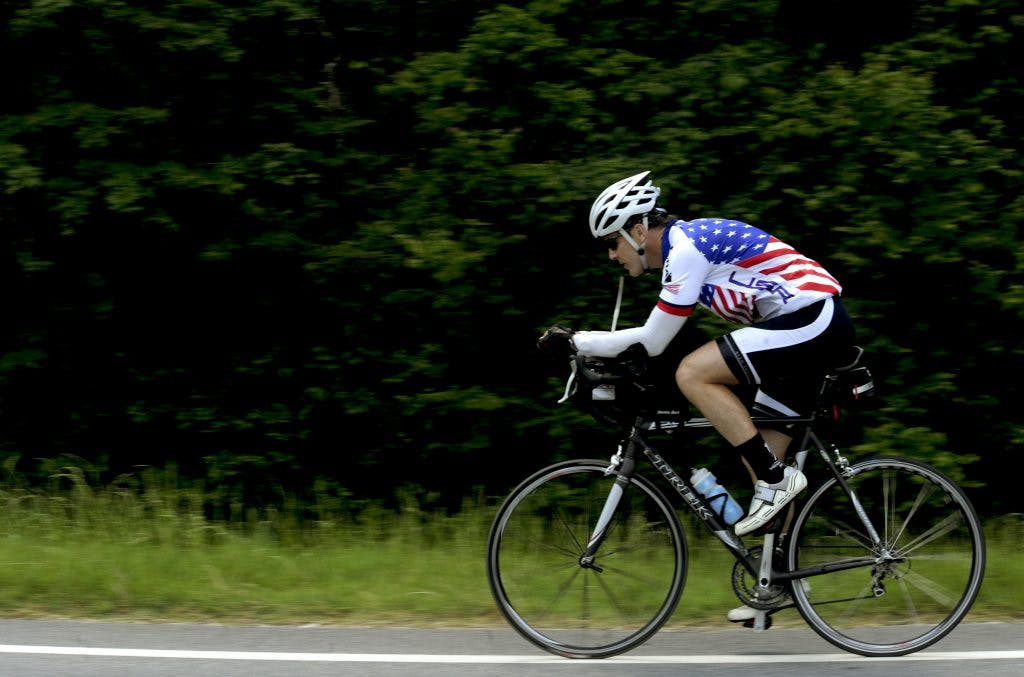
Empowering Veterans Through Outdoor Recreation
December 6, 2018
UPDATE: In September 2020, amid hyper-partisan divide and national unrest, the U.S. House of Representatives approved the Accelerating Veterans Recovery Outdoors Act as part of a broader package addressing veterans' health and well-being. PeopleForBikes, along with our partners in recreation and vet ...

Pittsburgh Youth Host Solidarity Ride Following Tree of Life shooting
December 5, 2018
On Sunday, November 18, twelve members of Congregation Dor Hadash and 6 members of the Pittsburgh Youth Leadership group set out for a 60-mile bike ride from Pittsburgh to Connellsville on the Great Allegheny Passage. Our fearless leader, Mark, assured us it was only 50 miles, the wind would be at o ...

Pros Dish the Dirt on Winter Bike Racing
November 30, 2018
Thanksgiving is past, holiday decorations brighten dark winter days, snow dusts towns across the nation — and many bike riders are hanging up their helmets and spandex for the season. But for some bike racers, the fun is just beginning: Cyclocross season is in full swing and landmark mountain bike e ...

European Strategies on Rural Memphis Streets
November 21, 2018
Going to the Netherlands on a study tour to learn about bike infrastructure is exciting and inspiring. At times, it’s also overwhelming — especially when the infrastructure at home seems far from ideal. How do you even start making improvements? ...

A New Racing Class
November 20, 2018
For mountain bikers who want to compete, half the challenge is choosing which races to do. From the local XC series to multi-day stage races abroad, there are disciplines and a destinations for every rider. Electric mountain bike (eMTB) options are also beginning to appear on the race calendar: a se ...
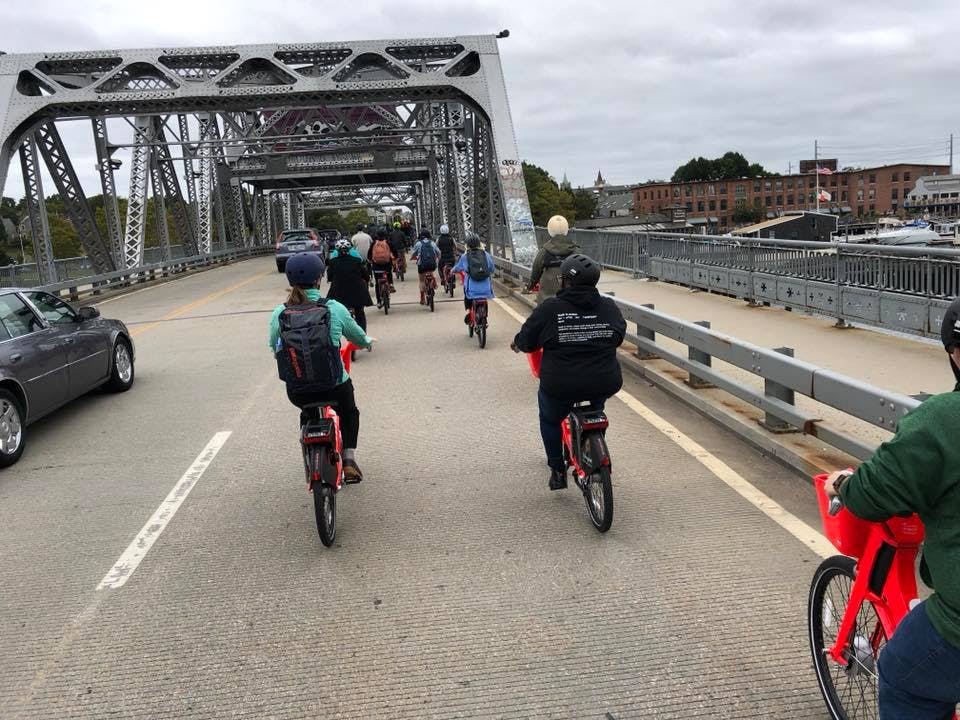
In Providence, City Development Relies on Bikes
November 20, 2018
Cities evolve. Like people, they grow and change. Providence, Rhode Island, is one place undergoing serious and exciting changes, many of which have to do with bike infrastructure and bike sharing. ...

Call for Submissions: America’s Best New Bikeways of 2018
November 15, 2018
Cities are dynamic entities. If you look at photos from 100 years ago, most city streets have undergone serious transformation. While preserving history is important, places also need revisions and revitalization to accommodate modern populations. ...

PeopleForBikes — and public lands, too
November 12, 2018
You won’t be surprised to learn that the PeopleForBikes team is comprised of bike enthusiasts who love to ride scenic roads, explore mountain trails and venture into the backcountry. It also shouldn’t come as a surprise that our love of bikes goes hand in hand with a passion for the outdoors. Our co ...

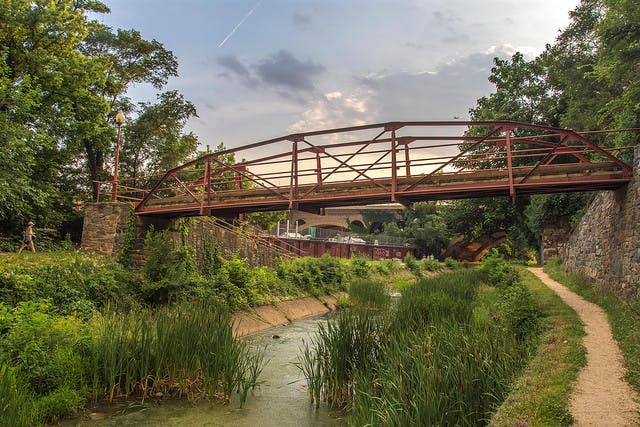
Virginia’s Fastest-Growing County Makes Room for Bicycles
November 7, 2018
fficially, Loudoun County’s motto, “I byde my time,” comes from the family coat of arms of John Campbell, the fourth Earl of Loudoun and a commander of British forces in North America. Until recently, it was also a fitting description of the region’s approach to bike infrastructure. ...
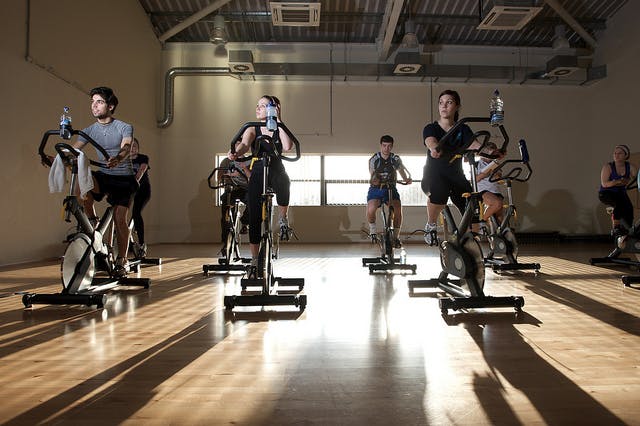
Seven Ways to Maintain Your Bike Fitness This Winter
November 1, 2018
When snow-packed roads and single-digit temperatures keep you off your bike, maintaining fitness requires some creativity. We’ve compiled our favorite ways to raise your heart rate and get your legs moving during the chilliest parts of the year. ...

A bipartisan effort to increase funding for recreational trails
November 1, 2018
This post was originally released by the Coalition for Recreational Trails. ...
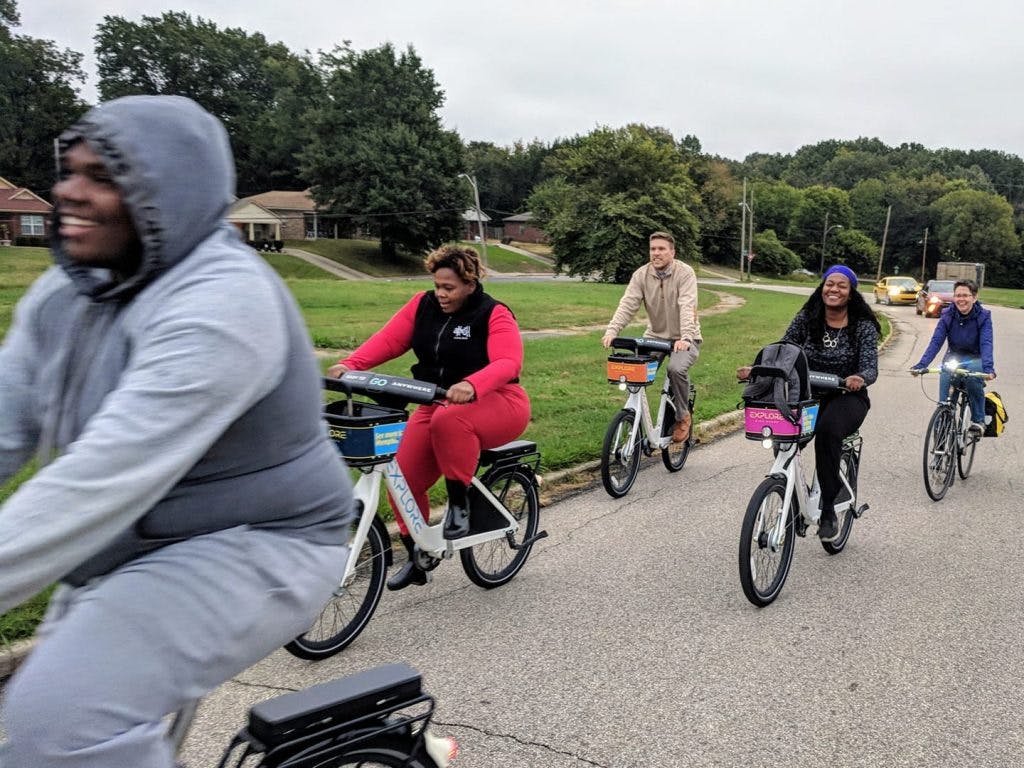
Cities on the Rise
October 23, 2018
A handful of U.S. cities consistently top the bike-friendly rankings, but some unexpected places are also rising through the ranks. A pack of upstart cities — including Memphis, Tennessee; Las Vegas, Nevada; and Ferndale, Michigan — are speeding toward better biking futures and could challenge bette ...

From Mentee to Mentor: Lauren Hall Reflects on Her Professional Cycling Career
October 10, 2018
Lauren Hall didn’t grow up with a bike, and didn’t get into cycling until after college. Her first exposure to professional riding came as a result of some crafty Googling by a friend, who found a team offering guests spots for a race. Though Hall entered the sport through a less traditional avenue ...

Racing in Dara-e Azhdahar: Mountain Biking Gains Popularity in Afghanistan
October 5, 2018
At 8,300 feet above sea level, the yellow-rock canyons of Dara-e Azhdahar (“Dragon Valley”) provide a stark yet stunning backdrop for visitors in the Bamiyan Province of central Afghanistan. Last Friday, Sept. 28, locals gathered in the canyon to watch one of the country’s first-ever mountain bike r ...

Taking the Scenic Route: Long-Distance E-Bike Adventures
October 4, 2018
Pedaling along city paths or winding country roads, bicycle tourists are rewarded with unique vantage points and stunning views — it’s a travel experience unlike any other. And, as networks of bike trails continue to expand and connect, more journeys destinations than ever are safely accessible by b ...
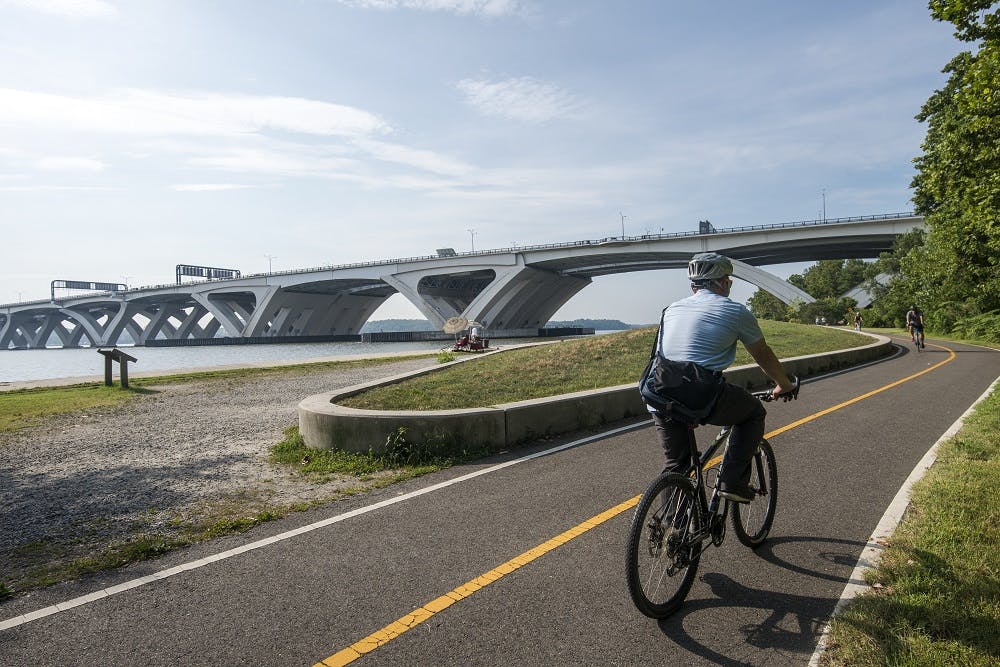
America’s Best Medium Cities for Biking
October 2, 2018
Some of the very best cities for bicycling in the nation are relatively compact —that’s one of the findings from the PlacesForBikes City Ratings, a data-driven comparison of cities based on factors such as the connectivity of their networks, cities’ investment in growing bicycling, ridership and saf ...

The Results are In: The US Outdoor Industry is an Economic Powerhouse
September 27, 2018
Just how big is the outdoor industry? In 2016, the outdoor recreation economy represented $412 billion, 2.2 percent of the U.S. gross domestic product and 4.5 million jobs. It’s a big economy — and it’s getting bigger. ...
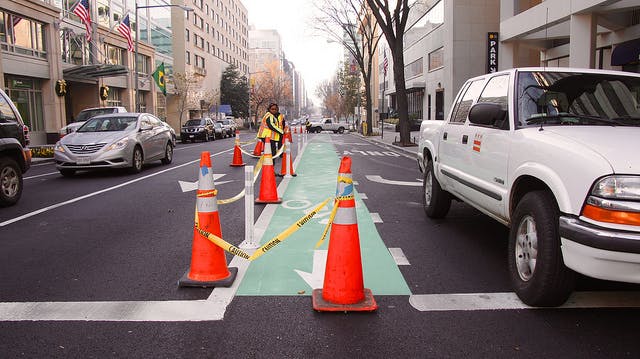
For Many States, Budget Mismanagement Blocks Bike Projects
September 26, 2018
Bike infrastructure delays tend to be blamed on a lack of funding, but there’s often more to the story. Even when funds are made available, states must follow through to ensure that the money is actually used. ...
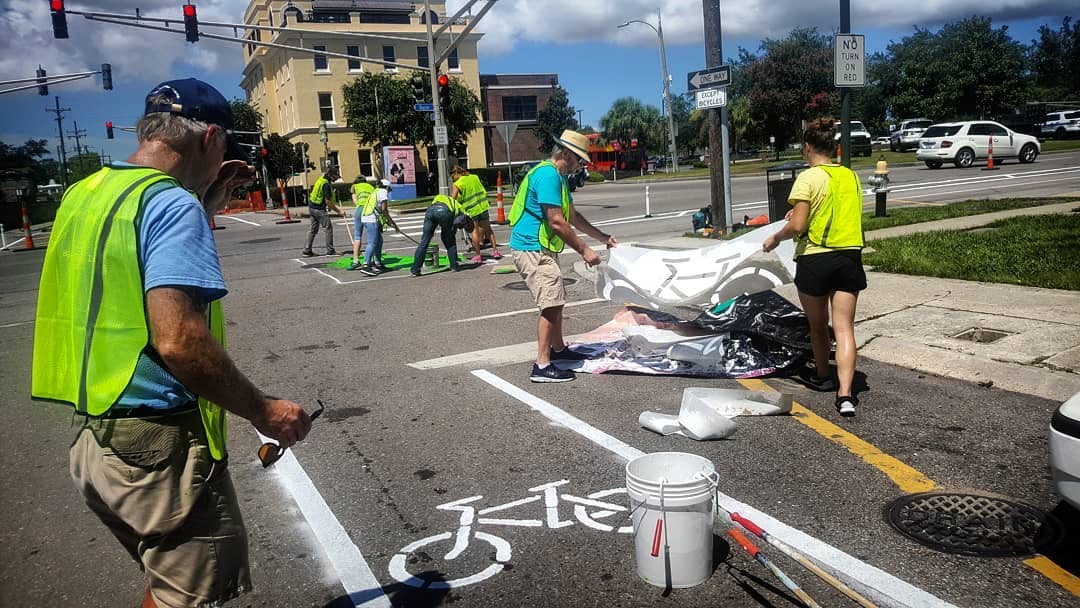
New Orleans’ Growing Bike Culture
September 18, 2018
New Orleans is known more for its beignets than its biking. But that could soon change. The city is making strides toward building out a connected network and engaging citizens in a burgeoning bike culture that’s as colorful as a Mardi Gras parade. ...
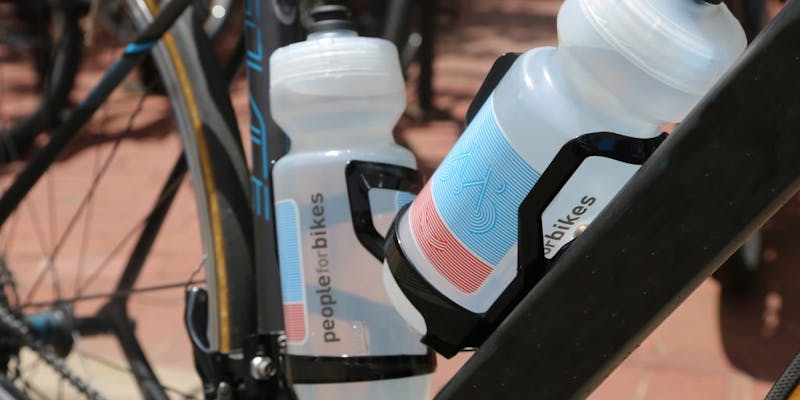
Amidst Trade War, Some Good News on Tariffs
September 18, 2018
Despite newly implemented tariff increases on e-bikes imported from China and recently confirmed tariff increases on Chinese bicycle products, there’s good news on the trade front. ...

America’s Best Large Cities for Biking
September 14, 2018
What does it take to stand out as one of the nation’s best biking cities? We looked at our top-scoring large cities in the PlacesForBikes City Ratings — Portland, Oregon; Tucson, Arizona; San Diego, California; Madison, Wisconsin; and Washington, D.C. — to find out. ...

Every Kid Outdoors Act Passes House of Representatives
September 13, 2018
Our public lands are some of the best venues for children to experience the outdoors and outdoor recreation. A new program may soon be available to help more kids visit and experience our public lands — including exploration by bike. ...
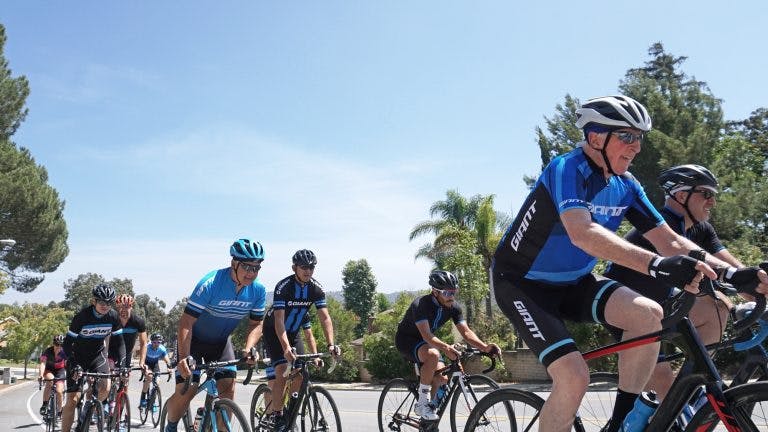
Giant USA Rides with Rep. Mike Thompson
September 10, 2018
U.S. Representative Mike Thompson (D-CA-5) isn’t just a bike supporter — he’s a rider, racer and enthusiast. Last week, Rep. Thompson arrived at Giant USA offices north of Los Angeles “with an eagerness and excitement we’ve all felt entering a cool bike shop — eager to see the latest and greatest mo ...
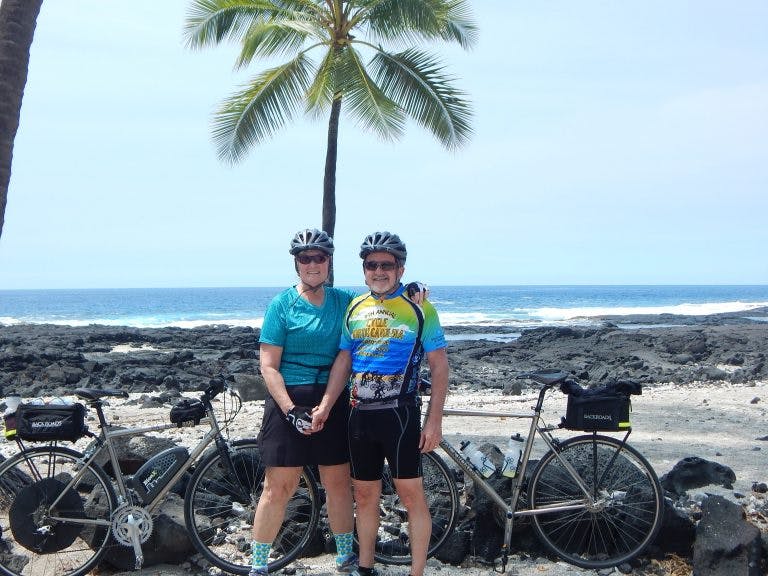
How E-Bikes are Changing the Active Travel Business
August 22, 2018
Nothing beats exploring new places from the seat of a bicycle. But when health issues made it difficult for my wife to bike, we thought our bike touring days were over. Then we discovered e-bikes. They’ve been a total game changer, opening the door to active travel opportunities that otherwise would ...

Long Island Bike Path Will Be a Science Lover’s Dream Ride
August 20, 2018
In 2012, cartoonist Matthew Inman, creator of The Oatmeal, heard that a nonprofit organization in Suffolk County, New York, was raising money to buy Serbian-American scientist Nikola Tesla’s last remaining laboratory. If the organization could raise $850,000, New York State would match the funds, gi ...
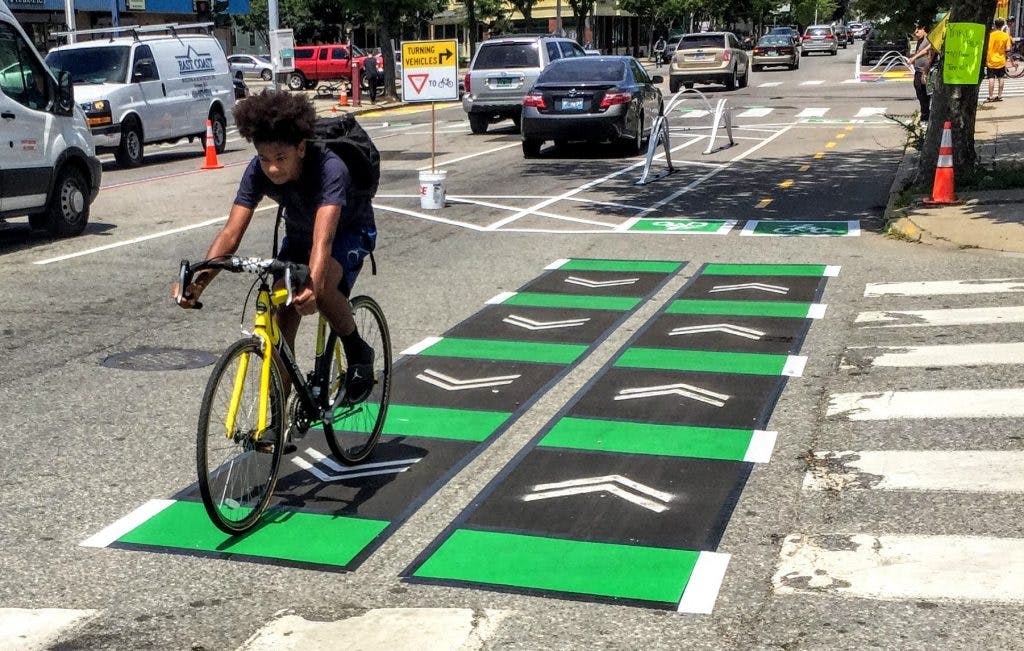
Providence Uses Creative Outreach to Build Support for Better Biking
August 10, 2018
How can a city build community support for a sweeping overhaul of its streetscape that spans eight diverse neighborhoods, crosses private property and lays down a network of protected bike lanes? ...
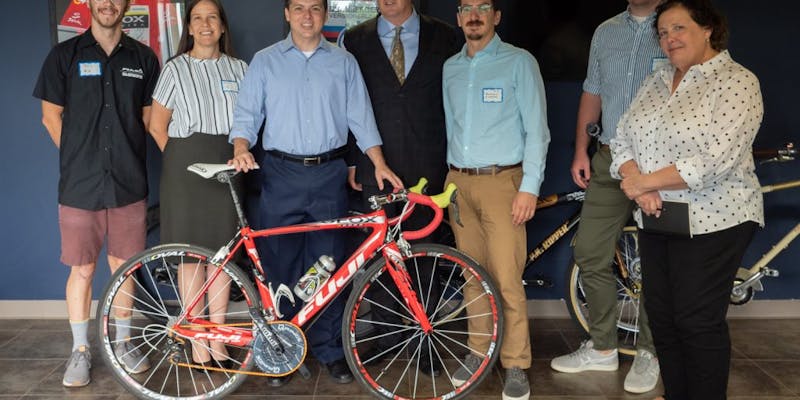
Rep. Boyle talks tariffs with Advanced Sports Enterprises
August 7, 2018
On Thursday, Aug. 7, U.S. Representative Brendan Boyle (D-PA-13) visited Advanced Sports Enterprises (ASE) headquarters in Northeast Philadelphia. His timing was perfect. Rep. Boyle’s visit came just days after the Trump administration announced they are considering increasing a proposed tariff on ...

Bikes Score in Baltimore
August 6, 2018
After recent bicycling infrastructure setbacks, Baltimore scored a big win for accessibility and connectivity. ...
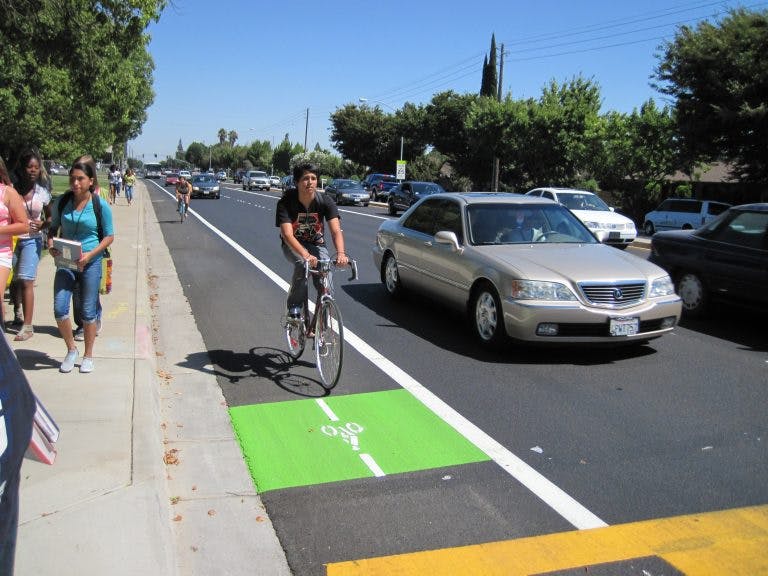
Becoming a Bike Town: Modesto’s Cruising Culture Redefined
July 23, 2018
In 2015, Streetsblog asked if Modesto, California — the inspiration for “American Graffiti,” George Lucas’ celebration of cruising culture — could become a model for a bicycle-friendly city. ...

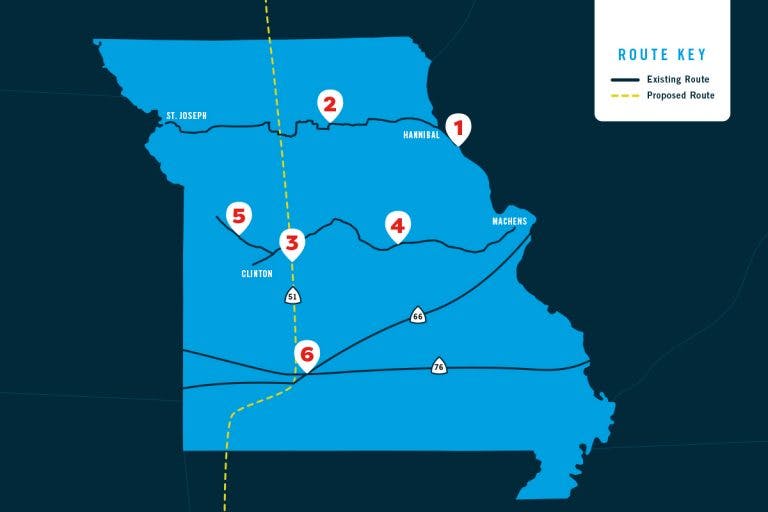
Could Northern Missouri Become the Midwest’s Next Great Bicycling Destination?
June 28, 2018
Brent Hugh couldn’t quite believe what he was seeing. ...
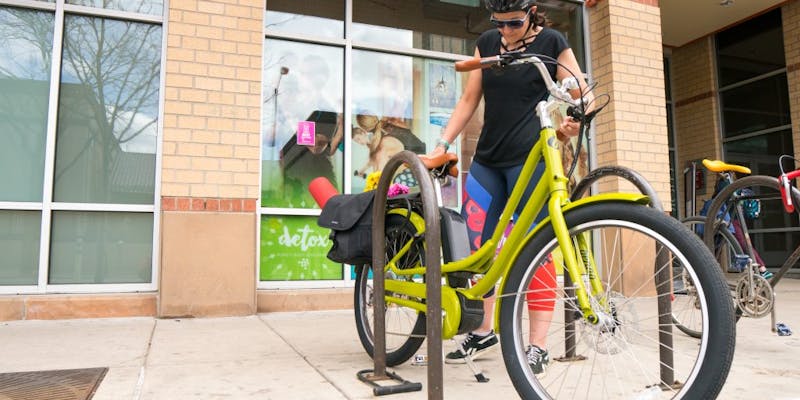
Proposed Tariff Increases Mean Bad News for E-bikes
June 28, 2018
E-bikes are the fastest-growing segment of bicycle sales in the United States. During the last 12 months, e-bike unit sales jumped 112 percent.* Ridership and engagement is increasing, and people across most demographics are using e-bikes to replace motor vehicle trips or augment existing bicycle tr ...
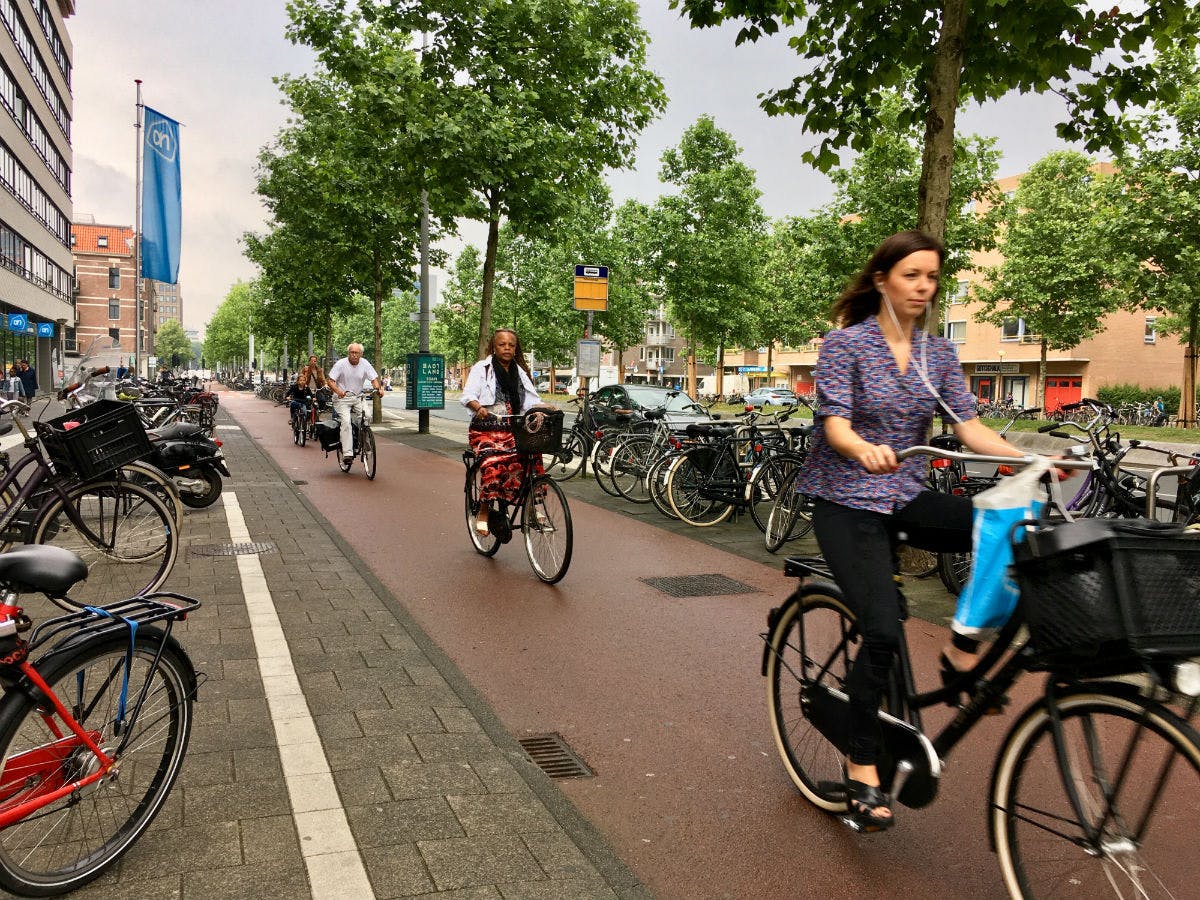
More Great Places to Read about Dutch Biking Wisdom
June 11, 2018
All good things come to an end. Last week’s study tour is done and almost all of us have headed home. ...
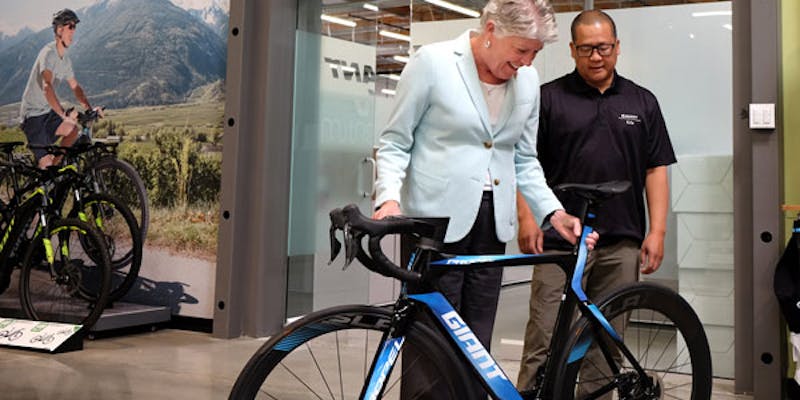
California Congresswoman Julia Brownley visits Giant USA
June 11, 2018
This May, U.S. Representative Julia Brownley (D-CA-26) and members of her staff visited Giant Bicycles’ United States headquarters in Newbury Park, California. Brownley, who sits on the House Transportation and Infrastructure Committee, toured the Giant facility with An Le, global marketing director ...
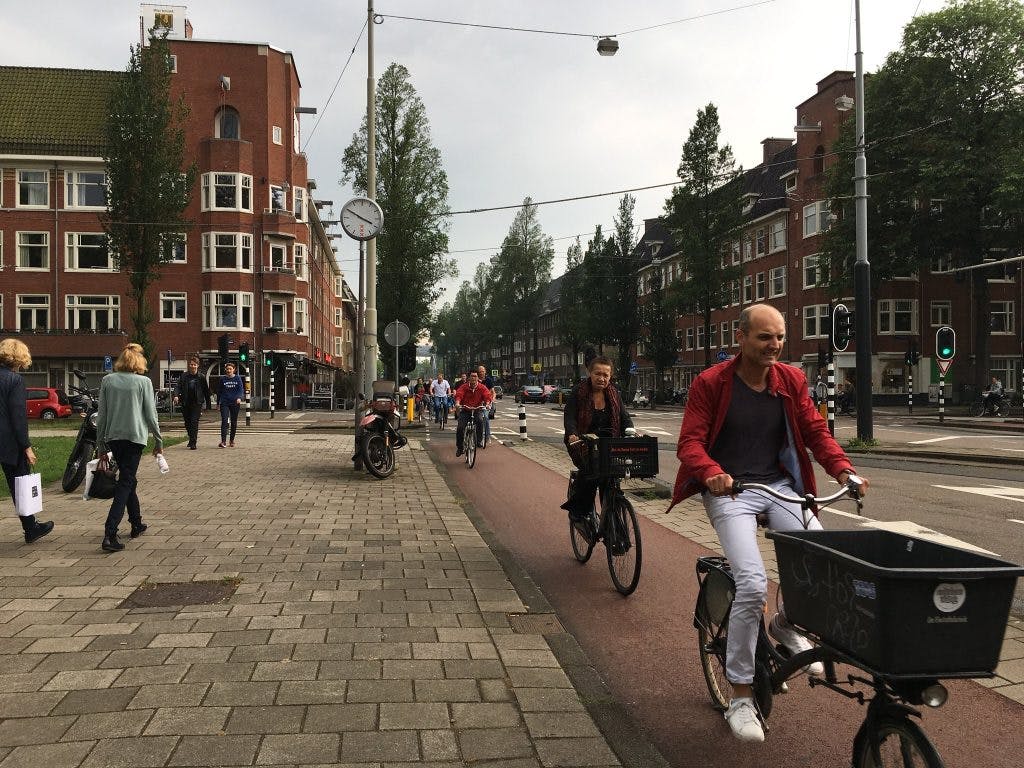
The Best-Kept Secret of Dutch Biking: The Dutch Hardly Bike at All
June 11, 2018
Here is perhaps the most shocking chart in all of Dutch transportation: ...
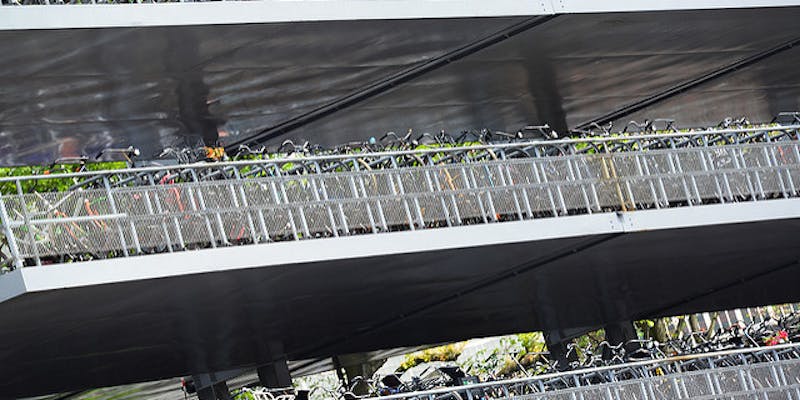
Bike and Transit Together Tackle Cars
June 8, 2018
If you’re not putting transit connections at the heart of your bike planning, you’re not doing it right. ...
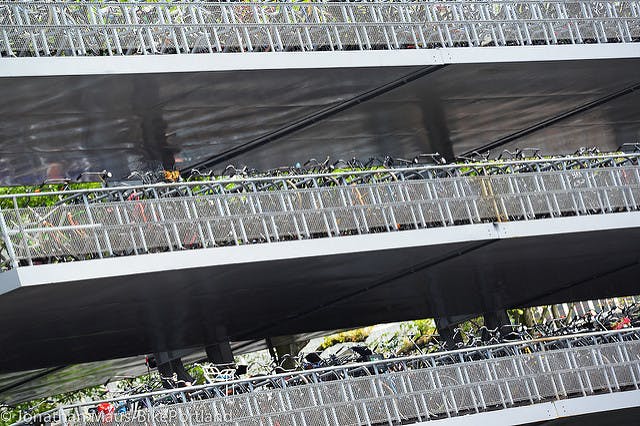
Chart: Bike and Transit are Better than Driving … When They Team Up
June 8, 2018
If you’re not putting transit connections at the heart of your bike planning, you’re not doing it right. ...
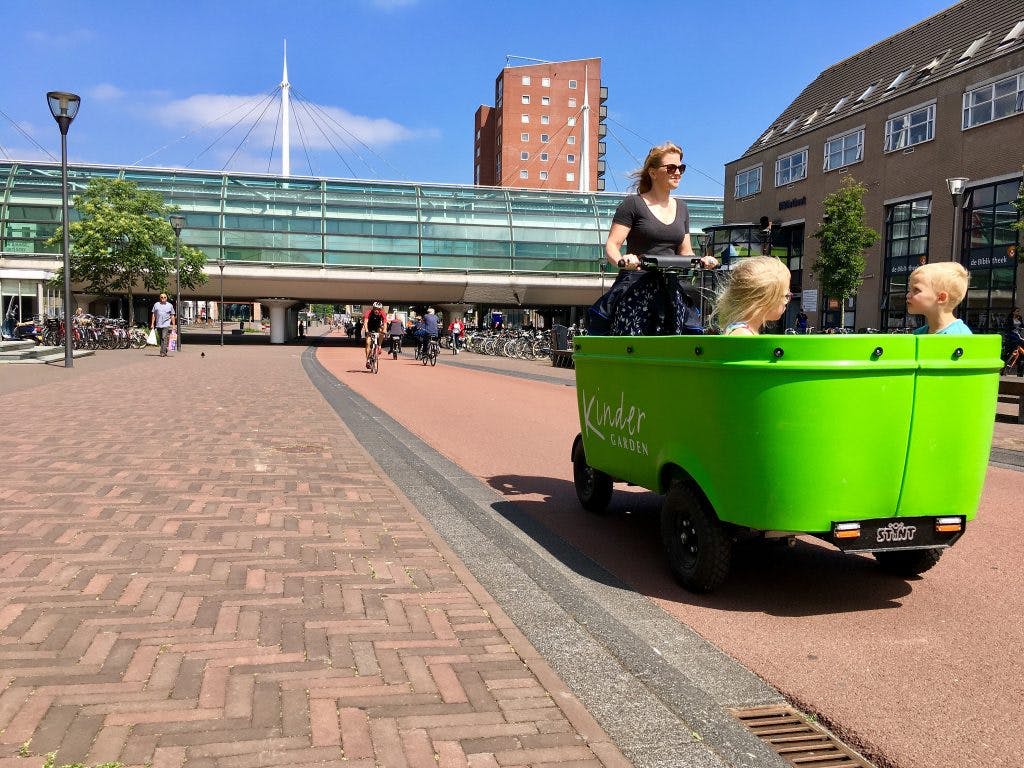
Suburbia Reimagined: An Afternoon in Houten, Netherlands
June 6, 2018
Dutch cities are famous for re-orienting their larger cities around bicycle transportation since the 1970s. What’s somewhat less known is that some of their newer suburban communities have never been auto-oriented. ...

Electric Mountain Bikes at Ski Areas
June 6, 2018
After brief seasonal hiatus, many ski area chair lifts are about to start spinning again. Lift-serviced bike parks continue to grow in popularity, both with summer ski area tourists and locals who use the parks to hone their skills. While most users prefer the unique geometry and suspension of downh ...
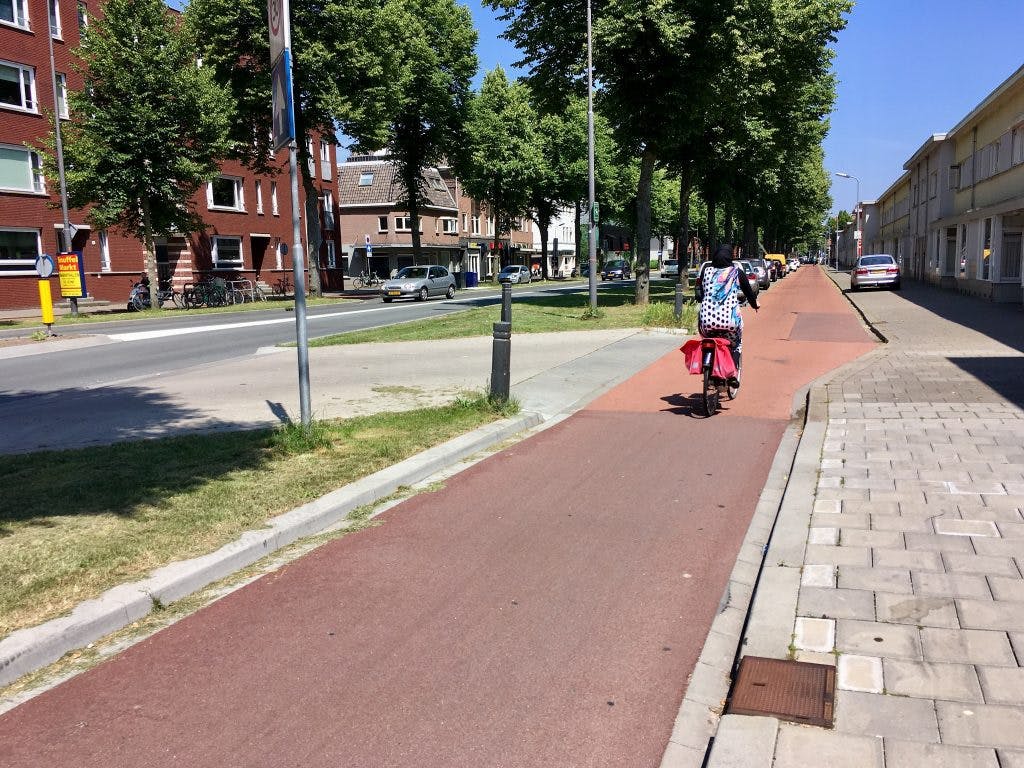
Den Bosch Keeps its Arterials Tidy with Low-Stress Access Roads
June 6, 2018
Here’s a small but effective way to solve one of the biggest problems with arterial streets. ...
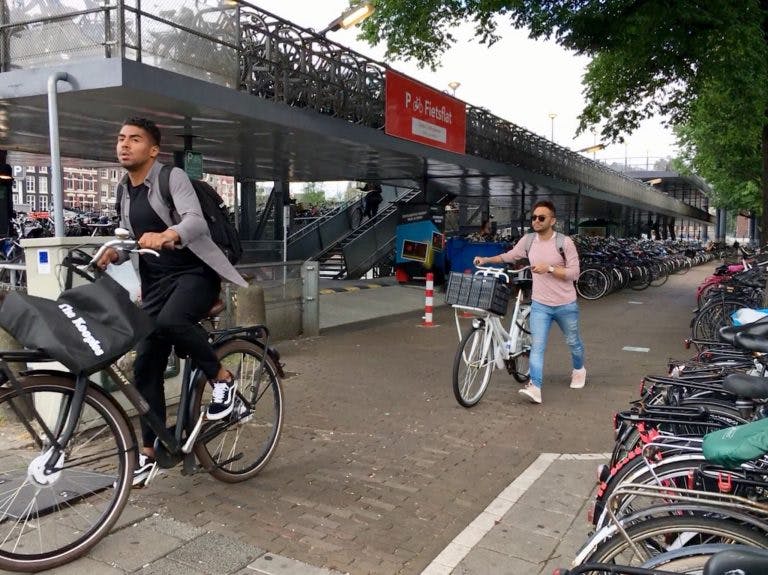
A Week of Great Ideas from the Netherlands
June 5, 2018
Welcome to the Netherlands: 17 million people, 22.5 million bicycles. ...
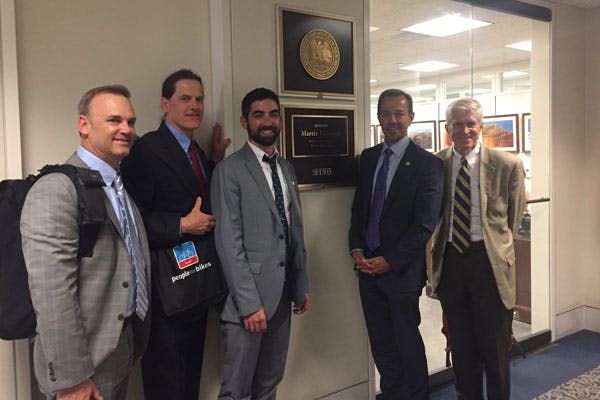
The Bike Industry Takes to Capitol Hill to Support Recreation Not Red Tape
June 4, 2018
PeopleForBikes led a group of 12 influential leaders from the $88 billion bike industry to Capitol Hill this week in support of the Recreation Not Red Tape Act. This bill aims to improve and break down the barriers to recreational riding opportunities on our public lands. ...

PeopleForBikes Holds Second Annual Congressional Bike Fest
June 4, 2018
They came for the tacos, but they stayed for the bikes. ...
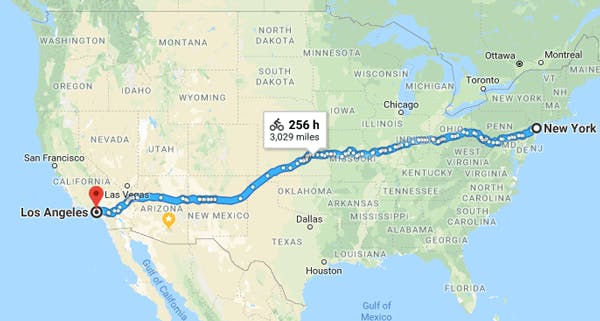
Five Ways to Optimize Your Bike Commute
May 18, 2018
Whether you’re just starting out as a bike commuter, or an old hand at it, there are always things you can do to make your ride smoother. There are steps you can take before you leave, small improvements you can make to your bike, and gear that will prepare you for the elements. We asked our friends ...
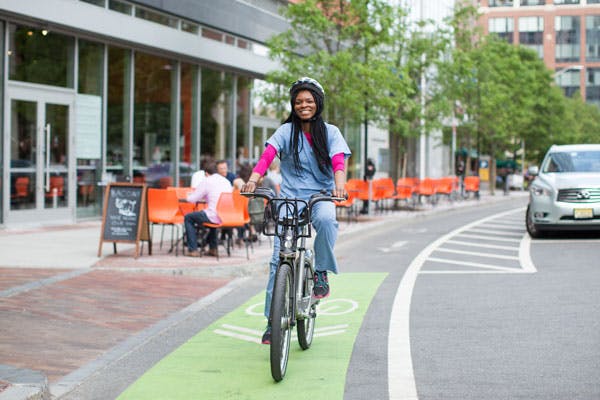
Three Ways to Make the Bike to Work Case to Your Boss
May 11, 2018
We’re celebrating National Bike to Work Day on May 18, but in our opinion most days could be bike to work day—you just need to get the right people on board. Leadership from the top is important in any workplace, and having your boss or HR manager promote biking to work could be the jumpstart your c ...

Chicago Biking Advocates Have Big Hopes for Valerie Jarrett and the Obama Foundation
May 7, 2018
Chicagoans living and working on their city’s south side have fought for decades for their fair share of transportation investments. Now, with former President Barack Obama’s presidential center and foundation putting down roots in Jackson Park, some see an historic opportunity. ...
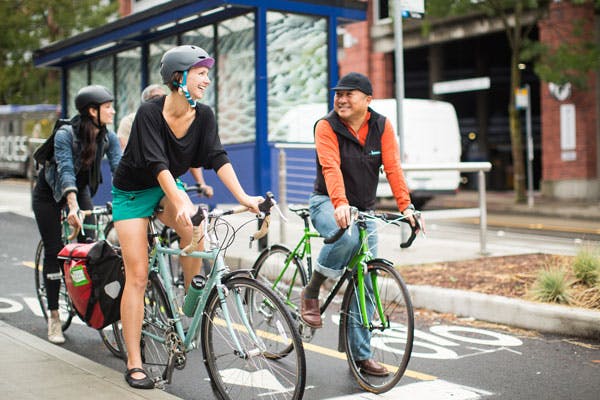
Be a Bike to Work Ambassador
May 7, 2018
Commuting to work by bike can be easier said than done. There can be a lot of hurdles that keep people in their cars. You can’t move people closer to work or control the weather, but that doesn’t mean you’re helpless. You can start by telling your colleagues how much better your life is as a bike-to ...
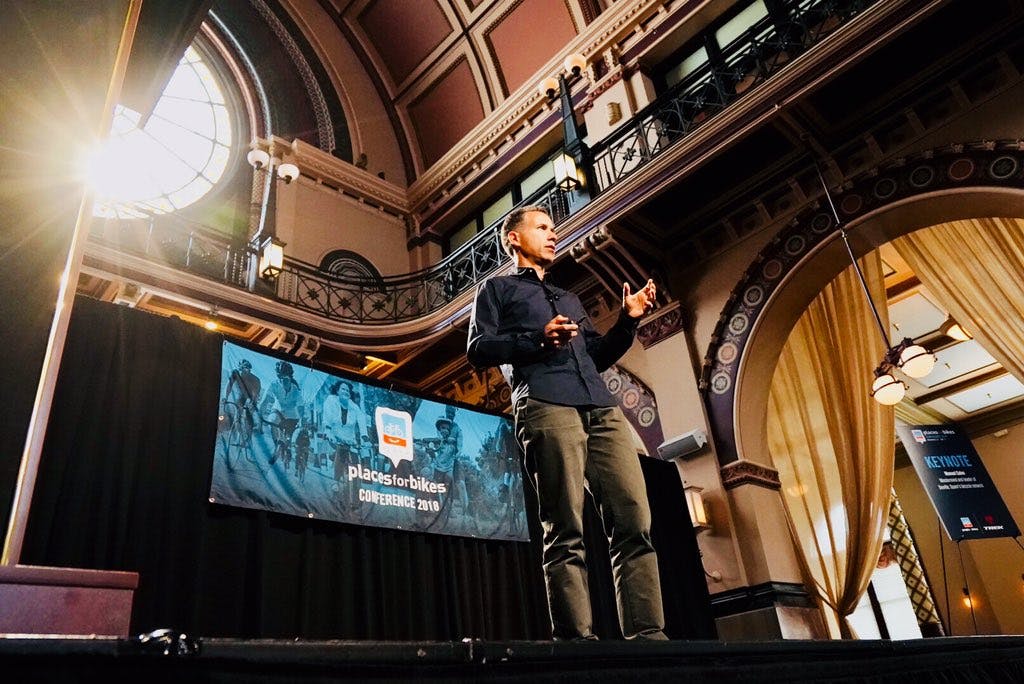
Six Secrets from the Man who Planned Sevilla’s Lightning Bike Network
May 7, 2018
Here’s one way to understand the story of biking in Sevilla, Spain: It went from having about as much biking as Oklahoma City to having about as much biking as Portland, Oregon. ...
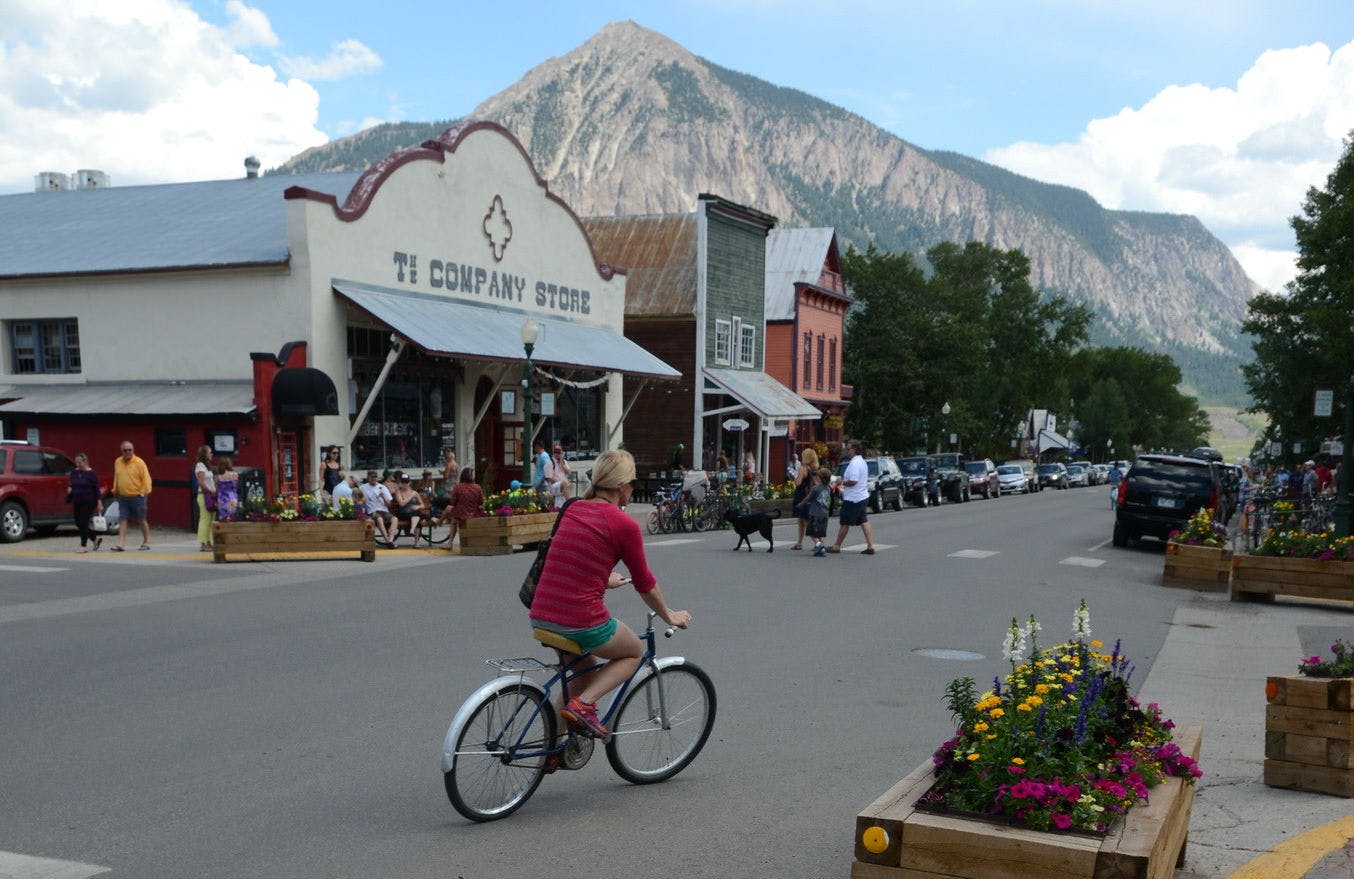
America’s Five Best Small Cities for Biking
May 3, 2018
Could a bunch of the country’s best cities for biking be towns that most Americans have never heard of? ...
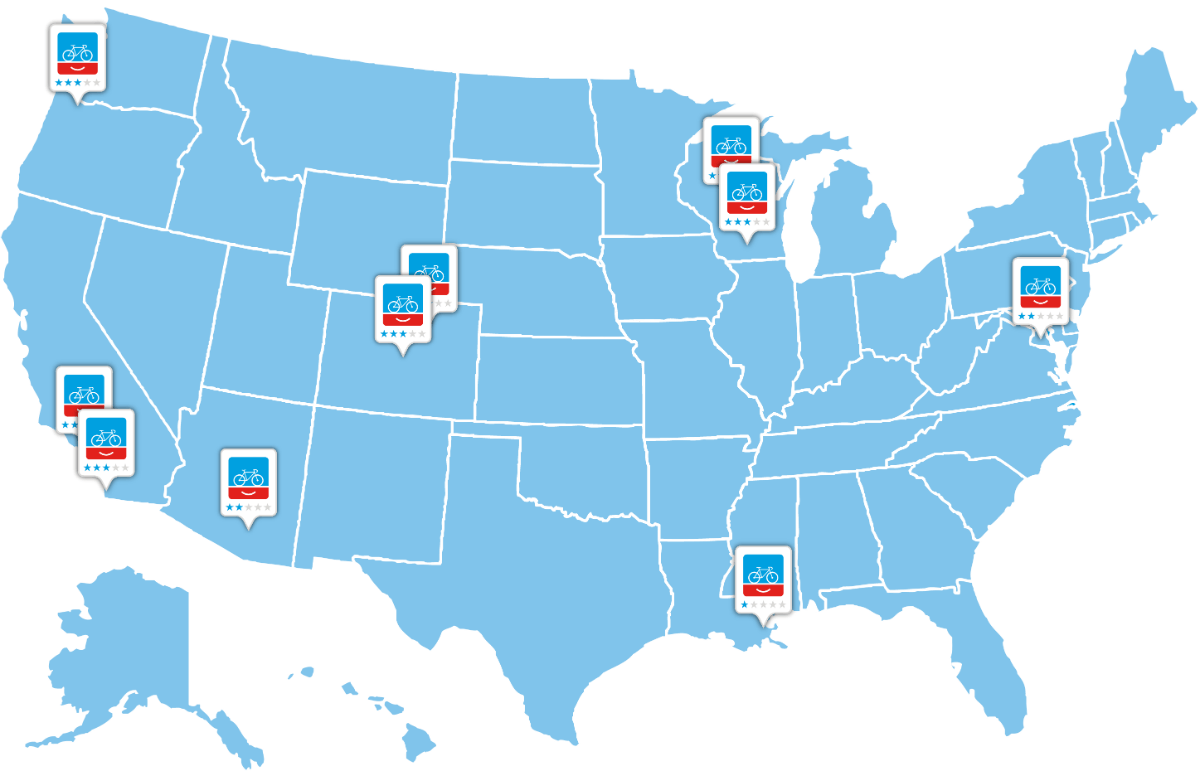
America’s Best Places for Bikes: Our New System Rates 480 U.S. Cities
May 2, 2018
The future of American bicycling is already here. It’s just that some cities are living it right now, and some aren’t yet. ...
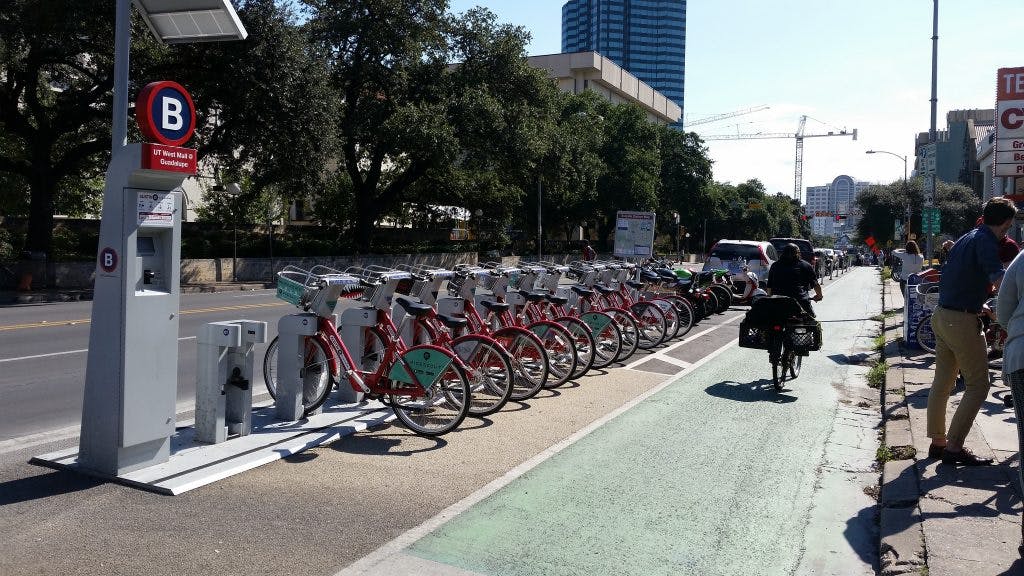
Texas Just Blew the Lid Off Campus Bike Share Launches: Three Reasons Why
April 2, 2018
Campus bike sharing in the United States seems to have hit a new high water mark on the flagship campus of the University of Texas. ...

Section 301 Tariff Investigation
March 29, 2018
This month, the Trump administration announced two changes to trade policy that may affect a wide range of companies that manufacture or import bicycles, parts and accessories. The first change relates to new tariffs on imports of raw steel and aluminum, while the second is focused on new tariffs on ...

Bicycling provides $137 million in economic benefits to northwest Arkansas
March 29, 2018
With an increasing number of locals and tourists taking advantage of its network of natural-surface trails and shared-use paved paths, bicycling provided $137 million in economic benefits to Northwest Arkansas in 2017. According to three new studies from the Walton Family Foundation, the region has ...
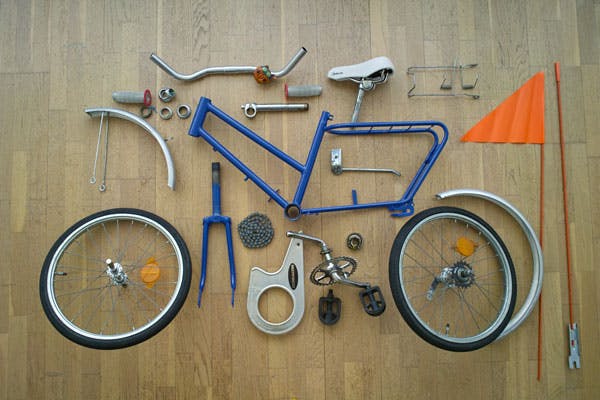
President Makes Major Trade Announcements
March 29, 2018
This month, the Trump administration announced two changes to trade policy that may affect a wide range of companies that manufacture or import bicycles, parts and accessories. The first change relates to new tariffs on imports of raw steel and aluminum, while the second is focused on new tariffs on ...
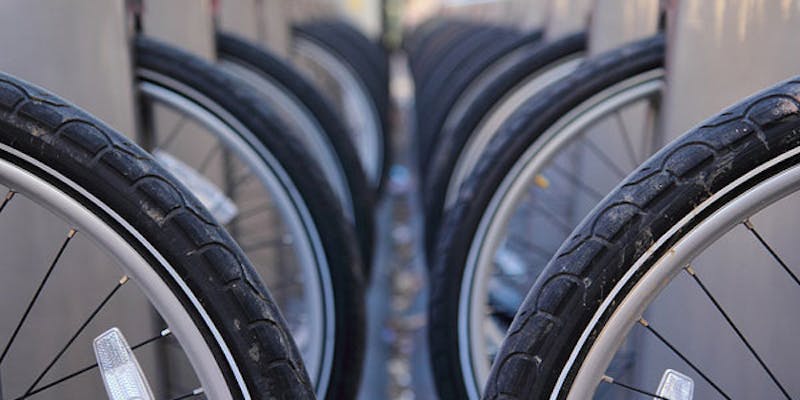
Omnibus Package a Big Boost for Bikes
March 28, 2018
Congress passed a spending bill on March 23 that includes significant support for funding bike infrastructure projects across the nation. ...

Colorado Lottery Grows Bike Industry and Recreation Economy
March 27, 2018
Like many Coloradans, I discovered myself outside. I moved here 22 years ago and immediately fell in love with the mountains and trails. From snowboarding in winter to mountain biking in summer, outdoor recreation has helped me make lifelong friendships and even meet someone always happy to join me ...
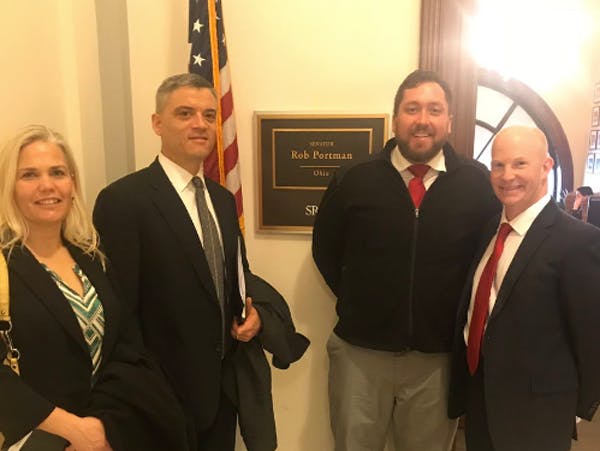
Bike Retailers Head to Capitol Hill to Advocate for Bike Infrastructure Funding
March 22, 2018
Kicking off another year of bike business leader advocacy efforts on Capitol Hill, PeopleForBikes hosted the National Bicycle Dealers Association executive fly-in on March 20 and 21. ...
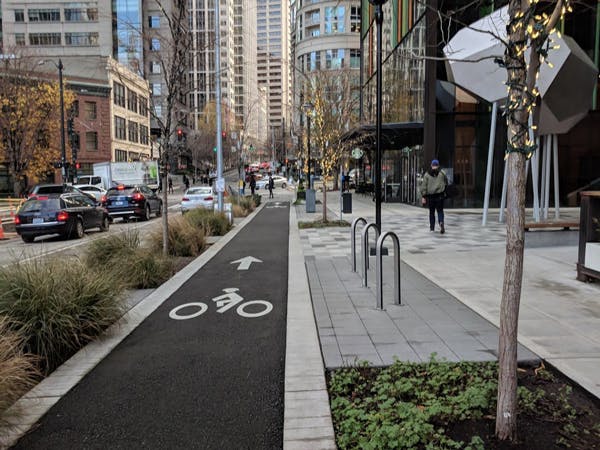
Four Ways to Go Beyond Bike Friendly
March 20, 2018
Mobility and smart connections are more than just buzzwords. Even as many social and business transactions have moved online, transporting goods and people will always be fundamental to commerce. The limitations of geometry are clear: only so many cars can use highways and streets at peak hours, and ...

eMTB Demo Program Part Three: Todd Seliga, Grand Canyon National Park
March 13, 2018
Tucked into a far western corner of Grand Canyon National Park lies the Tuweep area, a place for remote experiences and uncrowded landscapes. Similar to the rest of the park, it offers a combination of magnificent scenery and rich history, something well worth the effort to get there. ...
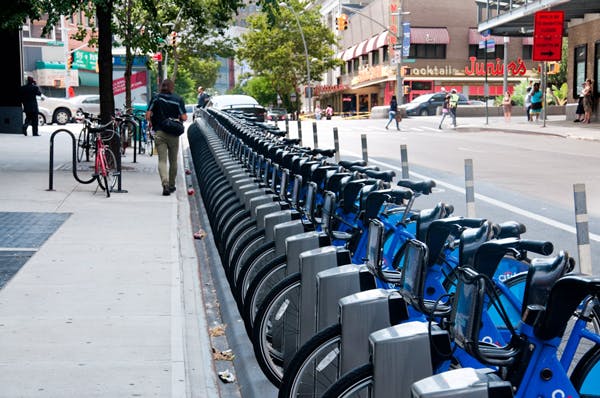
Closer to Bike Share is Better for Business
March 13, 2018
A new study from researchers at New York University (NYU) shows that restaurants closer to bike share stations do more business than those farther away. Stansilav Sobolevsky and Constantine E. Kontokosta led the research team, using anonymized transaction data from Mastercard’s Retail Location Insig ...
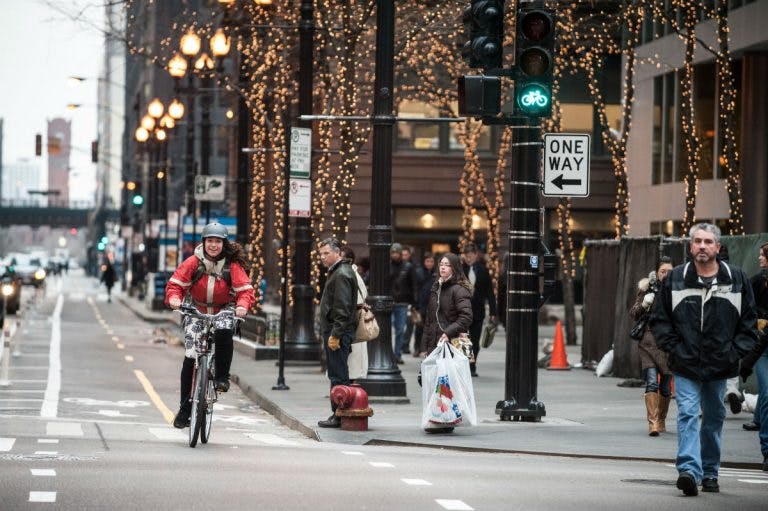
‘Buffalo is Missing Out’: When Good Bike Cities Get Better, It Helps Everyone
March 12, 2018
If you live in an important, underrated but perhaps economically beleaguered U.S. city, you’ve probably seen a local news website like Buffalo Rising: upbeat, opinionated and really, really into its hometown. ...
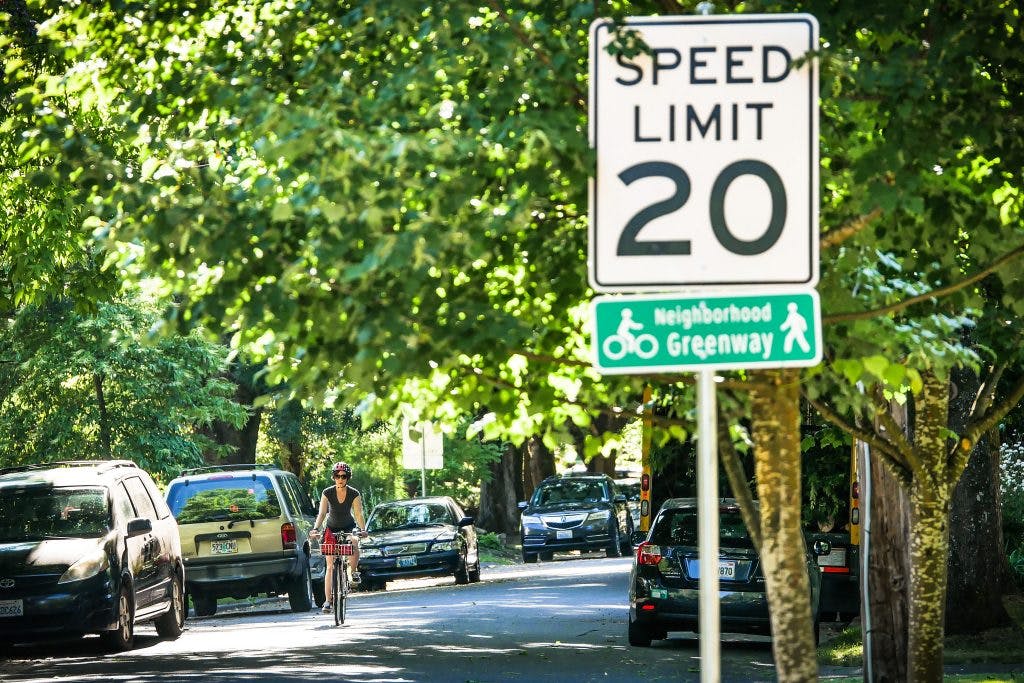
How Should Speed Limits be Set? A Powerful Committee is Asking
March 9, 2018
This doesn’t happen very often: The obscure but hugely influential National Committee on Uniform Traffic Control Devices is asking for direct feedback from ordinary transportation pros. ...
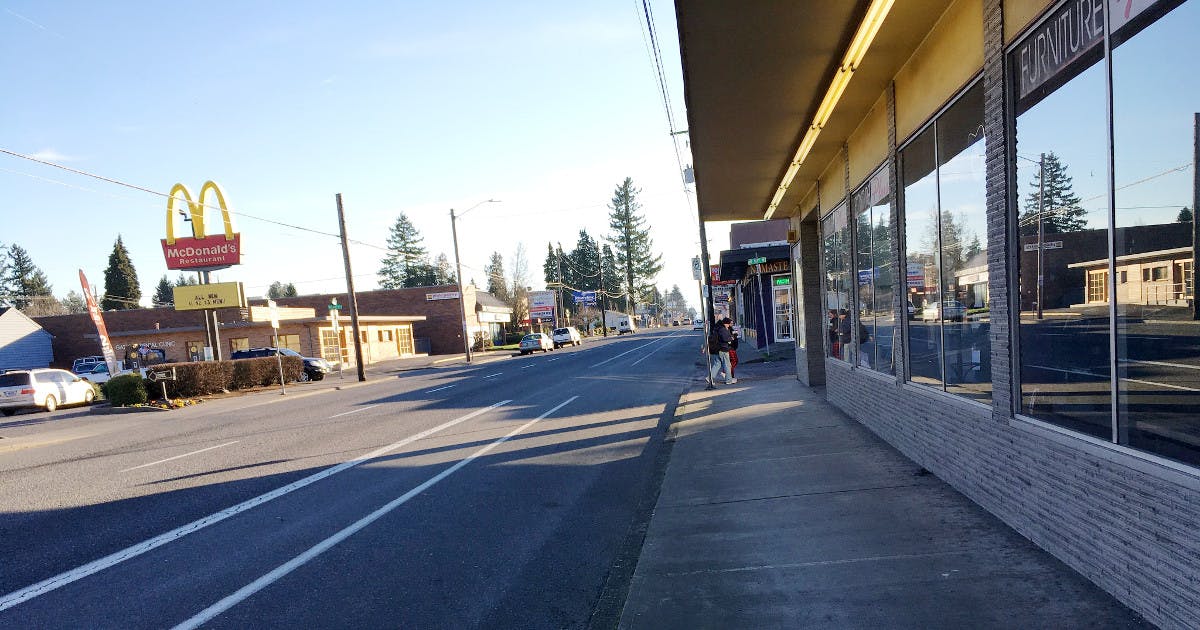
Bike to the Future: Portland Uses Bikes to Rethink 70 years of Strip Malls
March 7, 2018
Portland built its fame as a U.S. bike capital on one crucial discovery: It is fairly cheap and easy to make biking desirable in neighborhoods that were originally built for horses and streetcars. ...

How Better Biking Conditions Can Help Bike Shops
March 1, 2018
“It is super simple to jump on your bike and literally ride six blocks to downtown,” says Tom Johnson, Shop Manager at Owenhouse Cycling in Bozeman, Montana. He credits a strong downtown, a small urban grid, low traffic volumes, friendly people, and the Gallagator Linear Trail with Bozeman’s easy ri ...
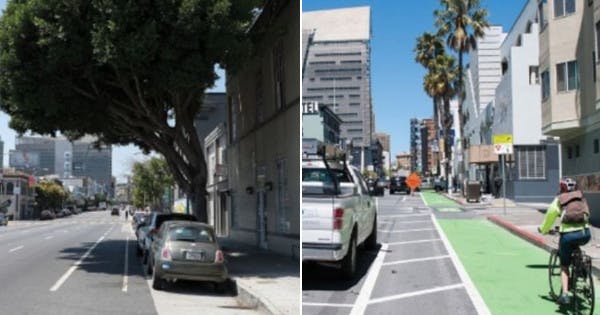
Five Tips from SF’s Lightning-Fast, Dirt-Cheap Protected Bike Lane Projects
February 26, 2018
If you’d like to cut the project time of a new protected bike lane by 90 percent and the cost by 75 percent, Mike Sallaberry has some advice. ...
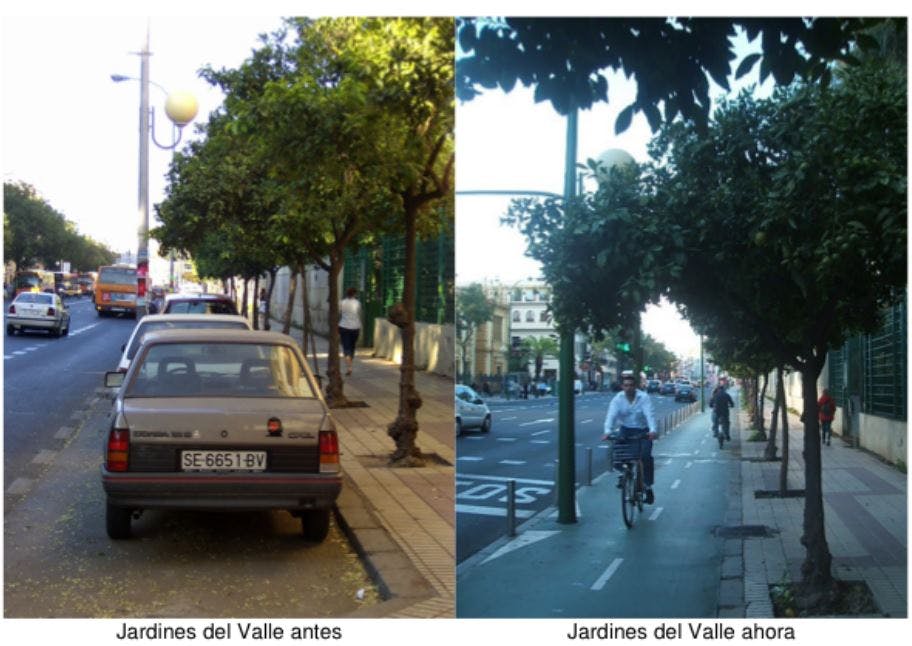
A Secret Strength of Sevilla’s Amazing Bike Network: Legibility
February 18, 2018
Bike wonks know Sevilla, Spain, as home to one of the fastest bike-infrastructure investments in world history. But installation speed isn’t the only lesson U.S. cities can draw from this wildly successful low-stress biking network. ...
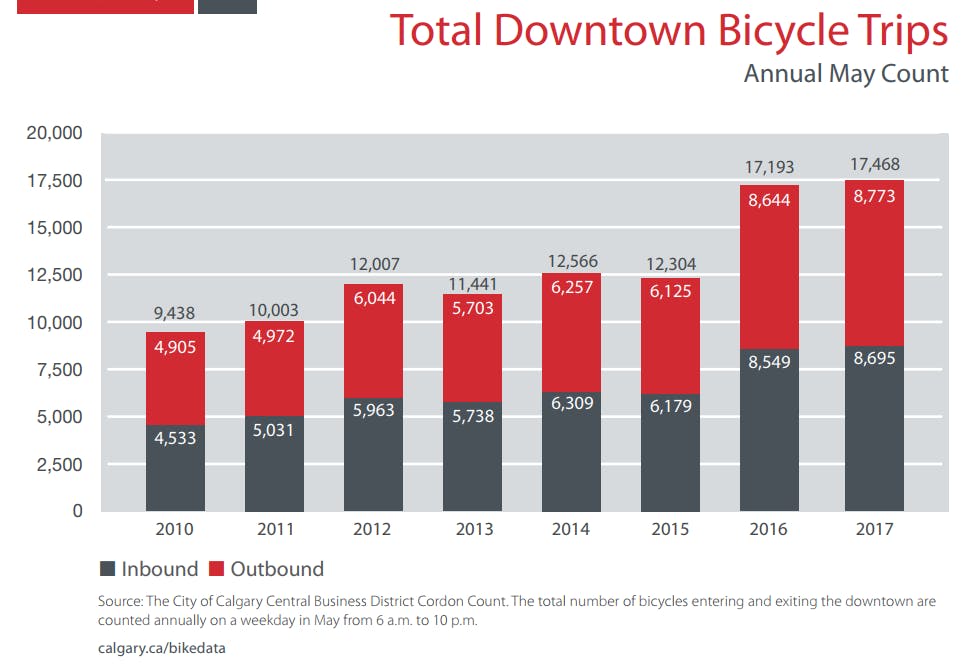
Don’t Let Anyone Tell You that Biking Can’t be Increased in a City
February 14, 2018
Anyone who says no one knows how to rapidly boost the use of bicycles for transportation is wrong. ...
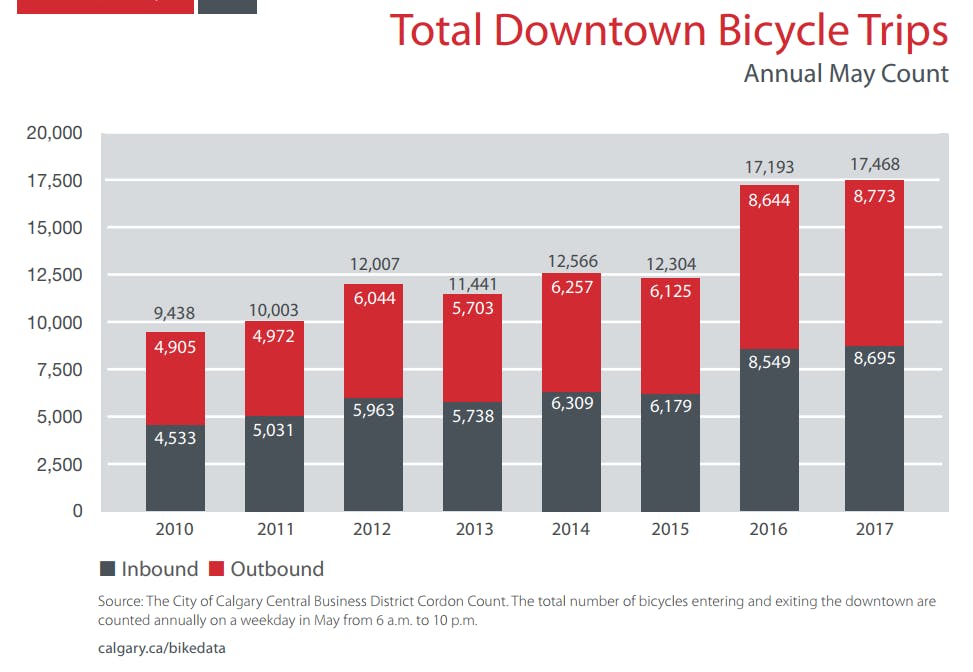
Don’t Let Anyone Tell You that Biking Can’t Be Increased in a City
February 14, 2018
Anyone who says no one knows how to rapidly boost the use of bicycles for transportation is wrong. ...

Show Your Bike Some Love
February 14, 2018
Valentine’s Day isn’t everyone’s favorite. If you don’t have that special someone, you spend the whole day bombarded with lovey dovey imagery wherever you look. And if you’re lucky enough to be in a relationship, you’re under pressure to get the right gift or plan the perfect day. Our suggestion? Sk ...
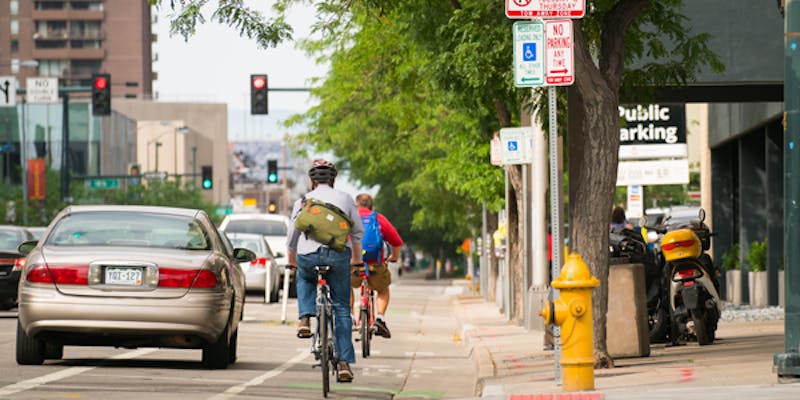
Trump and Congress Differ on Infrastructure Spending
February 12, 2018
Today the Trump Administration rolled out its Fiscal Year 2019 budget proposal, which includes the elimination of the TIGER Program and a transportation infrastructure package that largely leaves bicycle infrastructure on the sidelines. Both proposals are expected to face significant opposition in C ...

Bikes Have Helped Puerto Ricans Survive Maria. Will the Habit Stick?
January 31, 2018
The hurricane that tore across Puerto Rico on Sept. 20 led to hundreds of deaths and billions in damage. But a band of local biking advocates say one change, at least, has been for the better: It’s opened people’s minds. ...
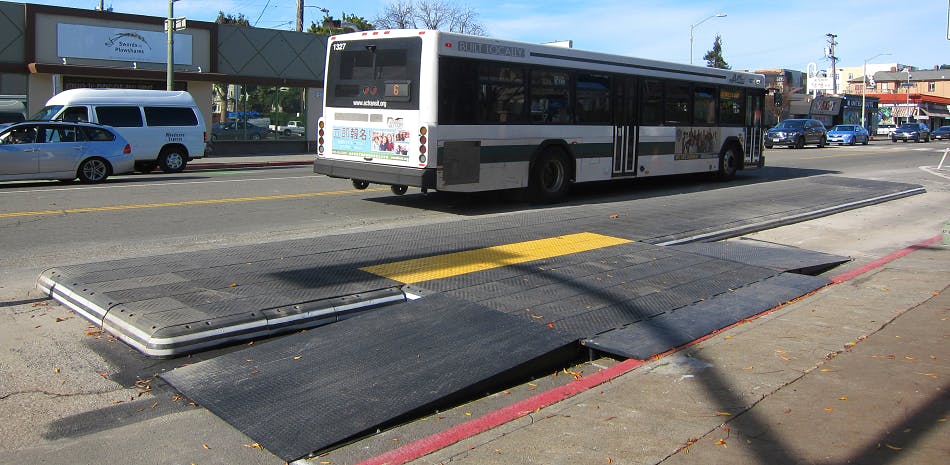
‘Floating’ Bus Stops Made of Plastic Panels Hit the Street in Oakland
January 26, 2018
The “floating bus stop” has been part of streets around the world for years. This month, a new twist is helping it spread in the United States, too: mass production. ...

To Elevate the Sport, Lower the Bar
January 25, 2018
“We broker suffering.” That’s one way Todd Sadow describes Epic Rides, the company he founded to produce mountain biking events. Epic is now in its nineteenth year of sharing the joy, as well as the pain, of mountain biking. “We give people the chance to show up at a start line where they know they ...

A Dozen Bucket List Bike Rides for 2018
January 16, 2018
We know that sometimes the best bike ride of your life can take place right outside your front door, on your local neighborhood streets and trails. Then there are those other times—when the wanderlust kicks in and the need to travel with your bike just overwhelms you. For those moments, here are a d ...
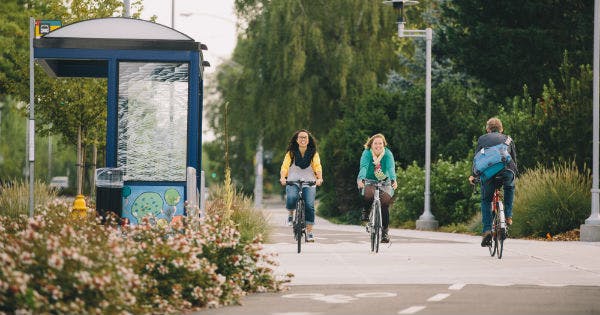
2017: The Year America’s Institutions Got Into All-Ages Bike Networks
December 29, 2017
Almost all cultural change relies on a three-step process: ...

Tax Cuts Will Help the Bike Biz; Loss of Commuter Benefits Will Hurt
December 20, 2017
The new Tax Cuts and Jobs Act, soon to be signed by President Trump, will reduce federal taxes for most bike businesses. But the new legislation also eliminates the Bicycle Commuter Benefit tax credit—a pro-bike tax rule that has been in place for nine years. ...
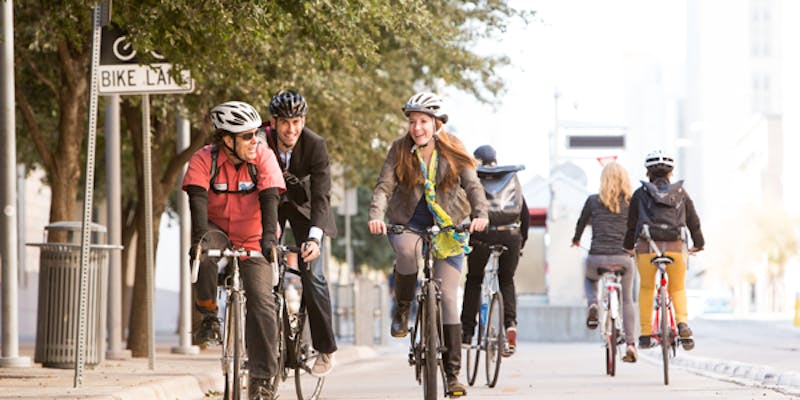
PeopleForBikes Reaction to Senate Vote to Eliminate Popular Bike Tax Benefit
December 18, 2017
UPDATE: ...

New Proclamations Dramatically Shrink Two National Monuments in Utah
December 4, 2017
On Monday, December 4, President Trump visited Salt Lake City to make an unprecedented announcement regarding two National Monuments in Utah. The president signed new proclamations that will dramatically reduce the area of the Bears Ears and Grand Staircase-Escalante National Monuments. This announc ...

Recreation Not Red-Tape Act and What It Means for bikes
October 17, 2017
The bipartisan Recreation Not Red-Tape (RNR) Act was introduced in both the U.S. House and Senate in late July by Rep. Rob Bishop (R-UT) and Sen. Ron Wyden (D-OR). It provides a plan for improving and enhancing recreation opportunities on public lands by creating a unified system of National Recreat ...

Senate Eliminates Bike Tax Benefit in Tax Plan
October 14, 2017
The U.S. Senate majority leadership removed the bike commuter benefit from the tax plan they released in late November. The bike commuter benefit is a $20-per-month tax-free reimbursement that employers can pay their employees for expenses related to bicycle commuting. ...

An Executive Order that Could Unwind Land Protection
August 25, 2017
The executive order mandating that the Department of the Interior review 27 of our National Monuments required a report to the White House by August 24. Yesterday, a summary of the report was released. The summary indicates that the Department will likely recommend that several of our national monum ...
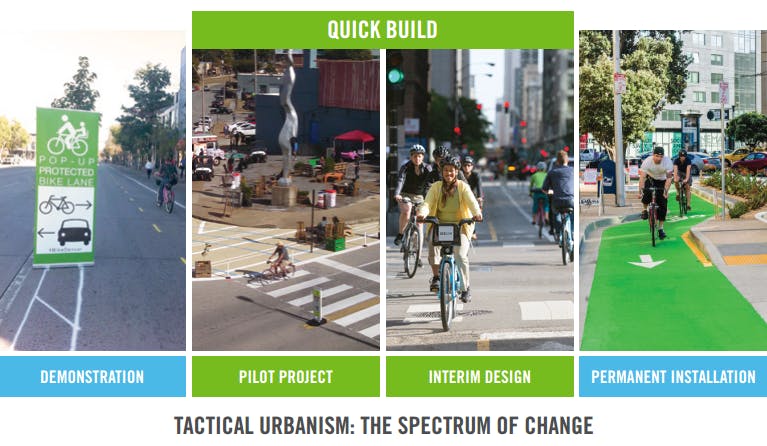
No, Protected Bike Lanes Do Not Need to Cost $1 Million Per Mile
May 16, 2017
Putting protected bike lanes on both sides of a street can cost $1 million per mile. The country’s most physically beautiful protected bike lane network, the Indianapolis Cultural Trail, cost several million dollars per mile. ...

Sample News
February 8, 2017
This is the article deck, where we summarize all of the great things that will be in the article. In this particular article, we're going to learn Latin, see some stock imagery and push Prismic's lackluster WYSIWYG customization options as far as they can go.
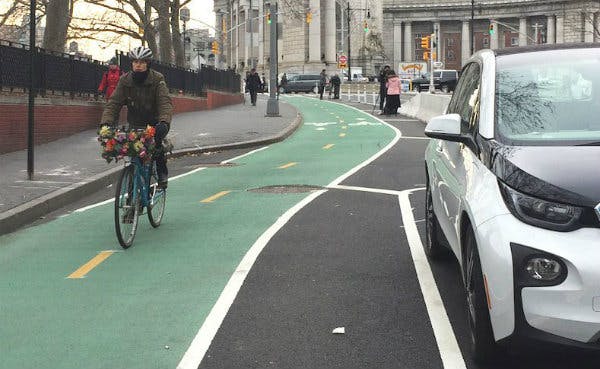
New York's network: Nine miles of protected biking from Brooklyn to Bronx
December 27, 2016
A few years ago, New York City showed us the power of vision. These days it shows us the power of persistence. ...
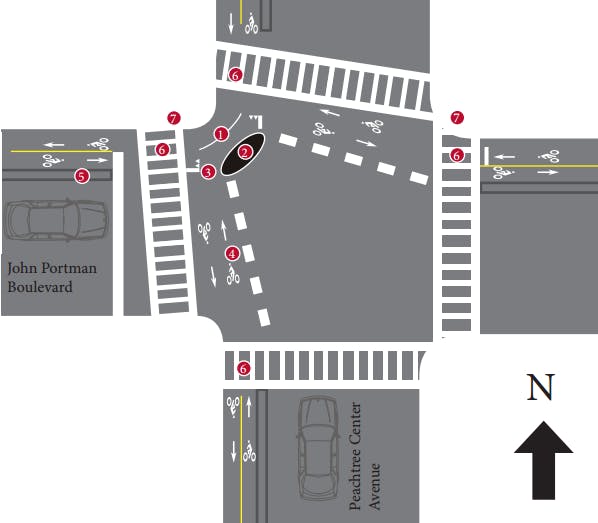
A milestone in Atlanta: Two bidirectional protected bike lanes intersect
July 19, 2016
Bidirectional protected bike lanes, which put both directions of bike traffic on the same side of a street, may not be ideal. But they can be useful in a pinch. Like all protected bike lanes, well-designed bidirectionals are more comfortable to more riders than having no bike lanes on busy streets. ...

Pedaling prosperity: For Boston's council president,'safe streets' aren't enough
July 18, 2016
Few of the great cities of the United States have more potential for biking growth than Boston. ...
Great bikeways only work if they connect to great bikeways
May 26, 2016
It’s fun to take a photograph of a beautiful protected bike lane. But a photograph won’t get you safely to the store. ...
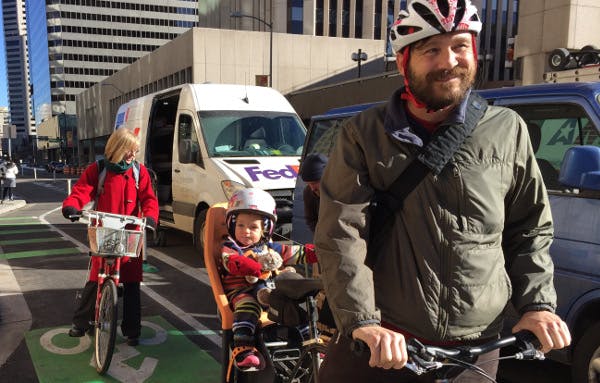
How Denver improvised a new contracting model to deliver change fast
May 11, 2016
When Denver first set out to build a parking-protected bike lane couplet on two miles of downtown streets in 2015, it thought the work would just involve some restriping. ...
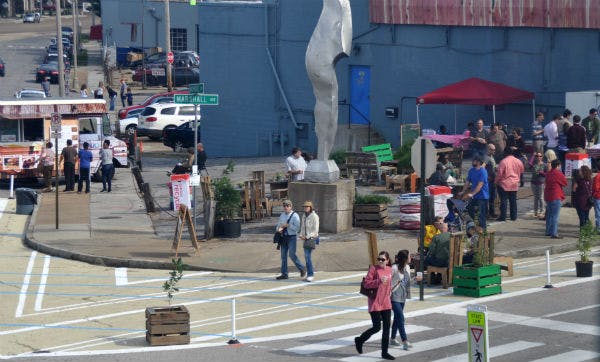
How Memphis created a rolling festival of street redesigns
March 31, 2016
In substance, Memphis’ MEMFix program is similar to other cities delivering quick-build street improvements. But its grassroots origin and abiding participatory nature supports the idea that any city that can mark its streets can complete a quick-build project. ...

How Seattle's mayor gave planners the fire to make improvements fast
March 29, 2016
In 2014, Seattle used the simplest possible system for seizing an opportunity on its streets: an unexpected mayoral mandate. ...
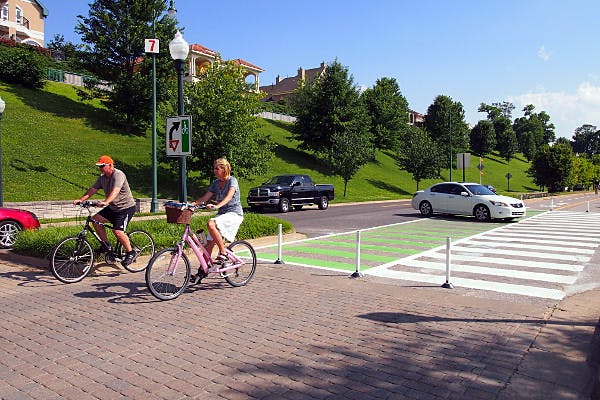
Engineering an innovation: The inside story of the Green Lane Project
March 25, 2016
It was 2012, and Leah Golby was sitting in a meeting she’d been looking forward to for three years. ...
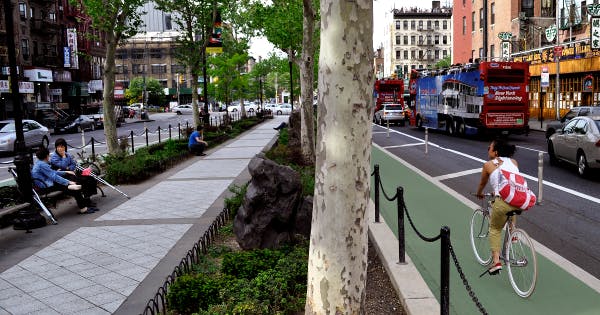
NYC says 2016 will set yet another record for new protected bike lanes
February 29, 2016
The city that brought modern protected bike lanes to the U.S. is still at it. ...
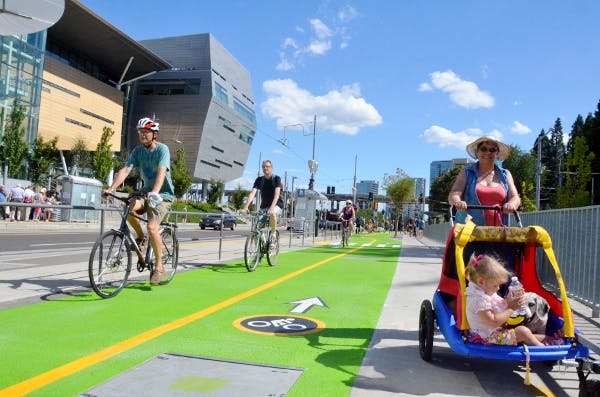
Portland is first U.S. city to make protection the default for all new bike lanes
January 28, 2016
Sometimes, the most important question in the world is “why not?” ...

Denver's two newest protected bike lanes: From zero to finished in one year
December 4, 2015
Of all the reasons Denverites had to get excited about the two protected bike lanes their city opened Thursday, the most underrated was a feat that you maybe will only fully appreciate if you’ve ever worked in government. ...
These two videos about biking in Pittsburgh are actually worth watching
October 16, 2015
Pittsburgh is one of our favorite cities in the country, and it’s not just the sandwiches; it’s the Pittsburghers. They tend to have that special sauce that gives a city the chance to be truly great: they really care about the place they live. ...
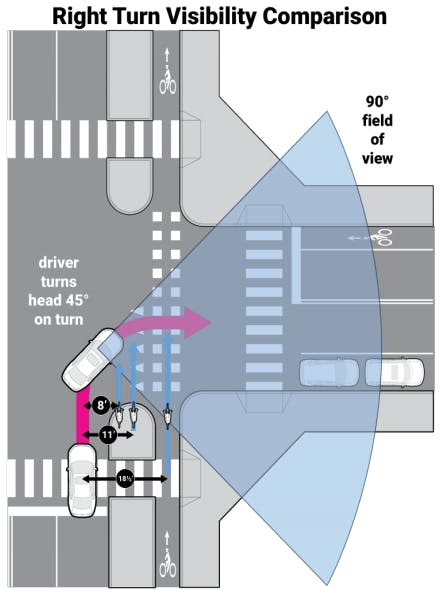
Massachusetts is about to release a new bikeway guide and it's going to be awesome
September 18, 2015
Images from MassDOT Separated Bike Lane Planning and Design Guide and from this slideshow. ...
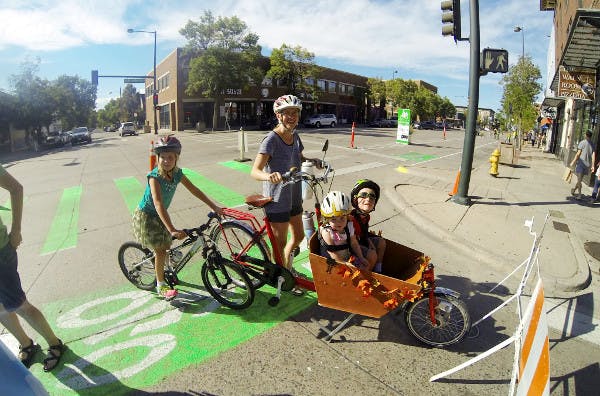
Denverites say they'd shop more on Broadway with a protected bike lane
September 15, 2015
From Portland to New York to Salt Lake City, the story is the same: the less a street resembles a freeway, the likelier people are to spend money there. ...
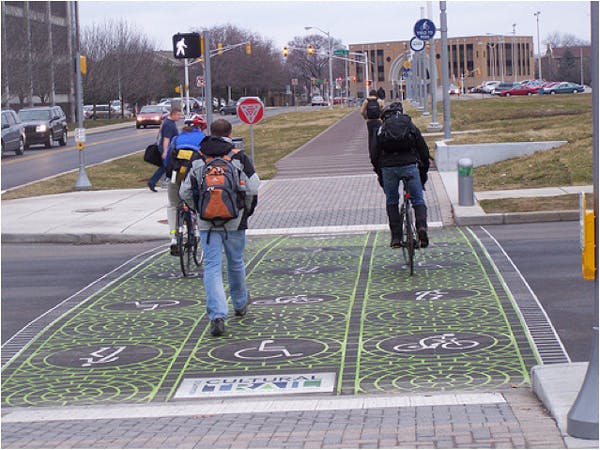
A new future for bicycling in Indianapolis
August 5, 2015
Why is the city best known as the home of the biggest car race in the country investing in bicycling? Hmmm. We’ll make this multiple choice: ...
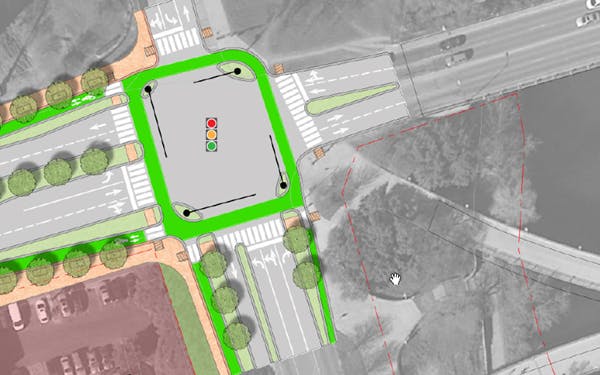
Austin plans two more protected intersections just outside downtown
June 11, 2015
Austin, already one of the nation’s leaders in the use of protected intersections, announced this week that it’s considering two more. ...
In Seattle, fold-down posts can take a punch while protecting bike lanes
June 11, 2015
As American cities have looked for simple, cheap ways to get physical barriers between bikes and cars, they’ve been reminded of a sad truth: you get what you pay for. ...
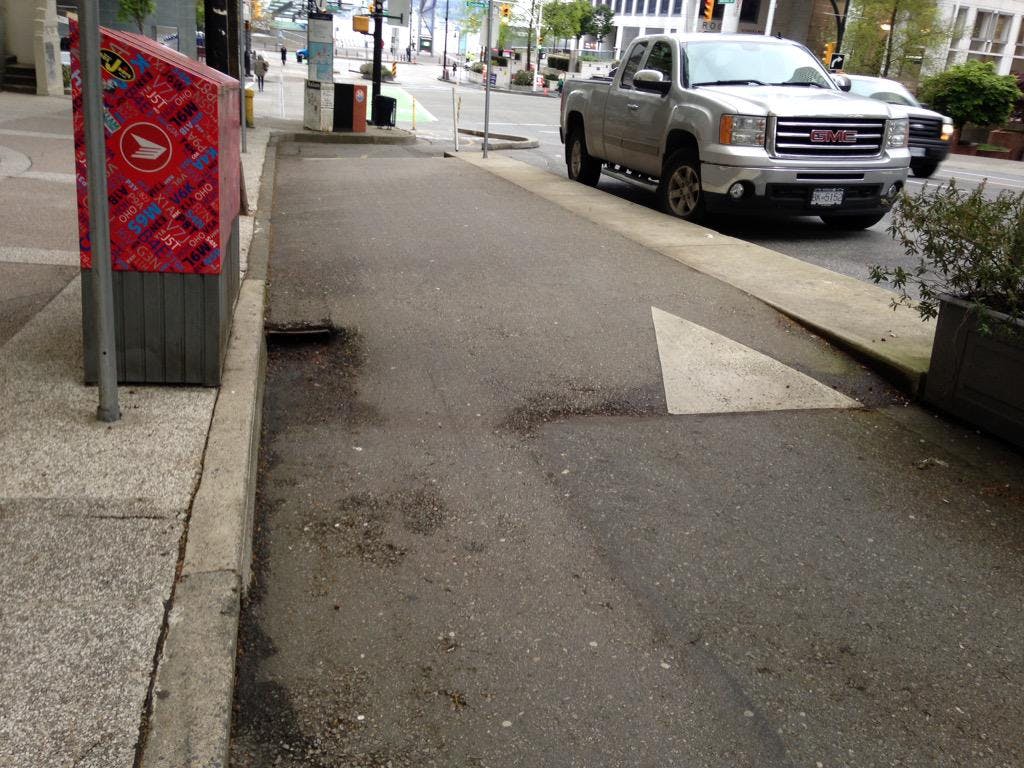
Tech Talk: Drainage on an elevated protected bike lane
May 13, 2015
Though puddles can occasionally have their upsides, generally speaking they’re one of the ancient enemies of the bike lane. ...

Queens teens push for protected bikeway to reconnect their peninsula
March 25, 2015
When Jocelyn Dicent walks home from school, she has a choice between two streets. ...
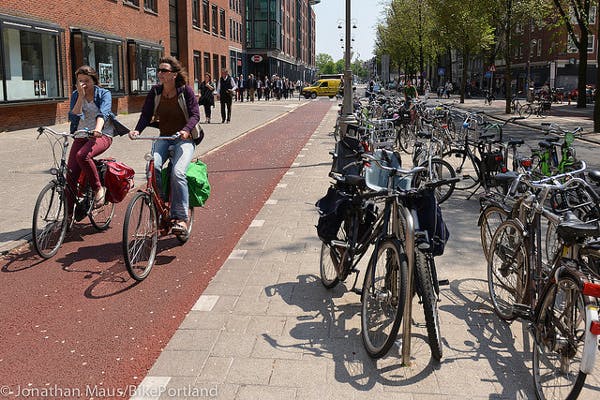
Bike lane philosophy: Are you an incrementalist or a completionist?
January 28, 2015
A lot of arguments in the world of progressive street design these days aren’t between good and bad. They’re between better and much better. This comes up again and again in the endless and usually fun arguments the bike-oriented Internet is always having with itself. ...
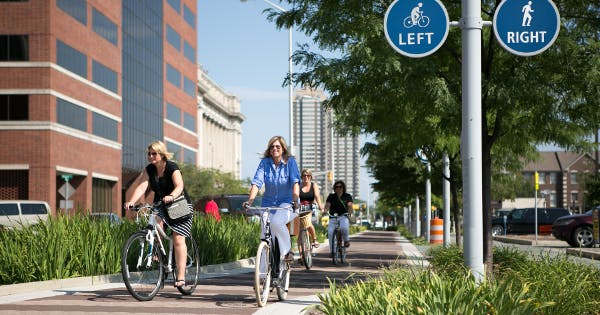
The thrilling future of traffic engineering
January 5, 2015
James Bond needs a Q. Scooby-Doo needs a Velma. Katniss Everdeen needs a Beetee. ...
Video: How Pittsburgh became a national model for rapid bikeway progress
November 19, 2014
https://vimeo.com/112197681 ...
Persistence pays off in western Pennsylvania
November 6, 2014
The theme for today is persistence. Webster?s defines it as, ?the quality that allows someone to continue doing something or trying to do something even though it is difficult or opposed by other people.? ...
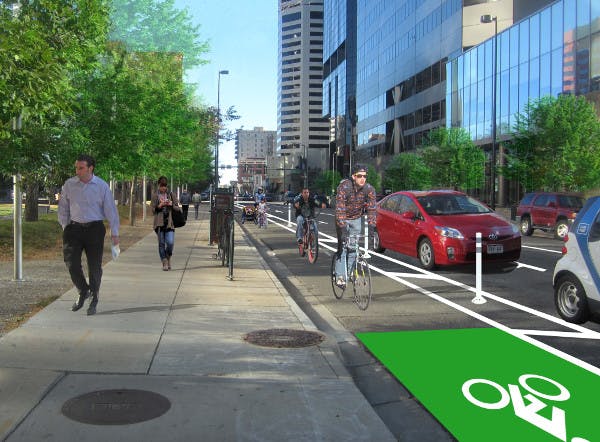
How Denver got an oil company to help crowdfund a protected bike lane
November 4, 2014
Need money for a better bike lane? Try asking the Internet. ...
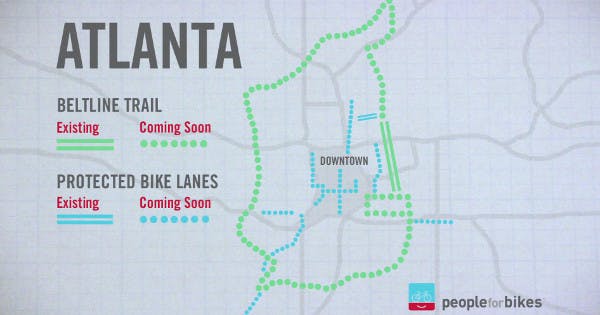
Atlanta plans big for bikes, and Atlantans turn out big time
October 16, 2014
The capital of the New South is working on its latest highway network. ...
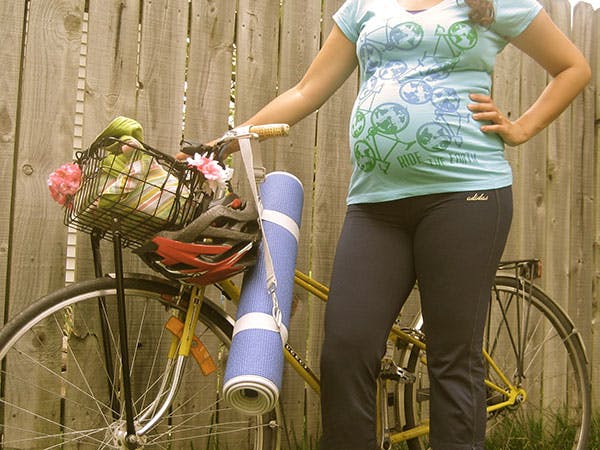
Baby on Board: 10 Tips for Riding While Pregnant
October 7, 2014
People rarely bat an eye at women doing tree poses in yoga while seven months pregnant, but taking to two wheels with a baby on board solicits everything from cheers to disapproving looks and cautionary tales. So what does this mean for pregnant bicyclists? Does a positive pregnancy test mean hangin ...
How Copenhagen helped Pittsburgh's Mayor Peduto understand the 'wedding cake of transportation'
September 22, 2014
For years, we’ve been leading politicians, city staffers and other community leaders from U.S. cities on curated study tours of the world’s best biking cities. But until Bill Peduto joined us in Denmark and Sweden this summer, we’d never had the chance to host a big-city mayor. ...

10 years ago next month, this letter to the NYT foresaw New York's biking triumph
September 4, 2014
This seems like a particularly good week to share the very first time protected bike lanes were mentioned in The New York Times. ...
Business leaders cheer protected bike lanes into busy downtown Pittsburgh
August 26, 2014
Downtown Pittsburgh has a perfectly good reason to be running out of room for more cars: its streets have been there since 1784. ...

Seattle holds bike lane open house right on the street,draws just as many people
August 22, 2014
No time to invite the neighborhood to your project’s open house? This week Seattle brought the open house to the neighborhood instead. ...
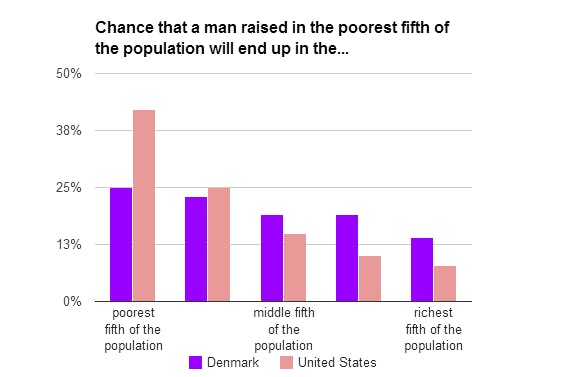
Can Chicago hit 30 miles of green lanes before the snow flies?
August 7, 2014
We don’t have to dream of a country where protected bike lanes and other quality bike infrastructure have dramatically improved life for people in poverty. We can visit it. ...
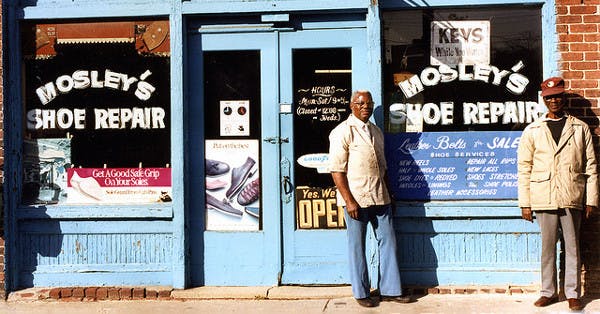
Two-day demo will reclaim one of Atlanta's most celebrated streets for people
June 13, 2014
Fifty years after a freeway sliced through one of the country’s wealthiest black communities and left it out to dry, the neighborhood is trying a new way to serve its seniors. ...
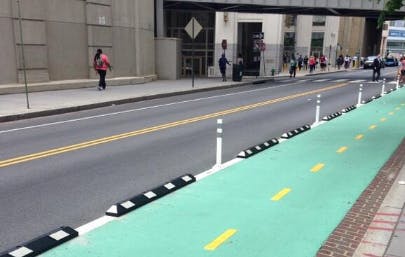
Tech Talk: No room for a buffer? Try a wheel stop barrier
May 13, 2014
Street designers know that every inch of a roadway is precious. And though more inches are better when it comes to low-stress streets, sometimes they just aren’t there. ...
The rise of American protected bike lanes: The 4-minute video introduction
April 30, 2014
Part of what we do here at the Green Lane Project is show our fellow Americans what we’re missing. ...
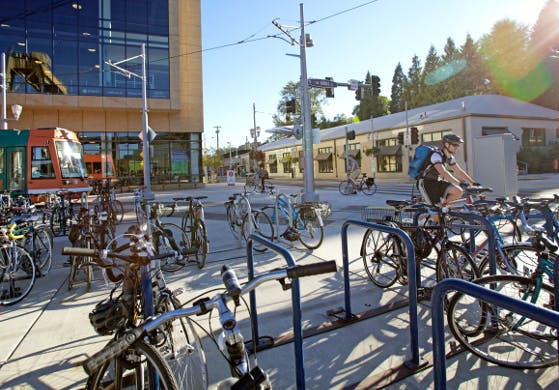
Indy celebrates a bikeshare win
April 24, 2014
In the business world, it’s called “first mover advantage.” It’s the head start Apple got in the smartphone market because it invented the device. ...
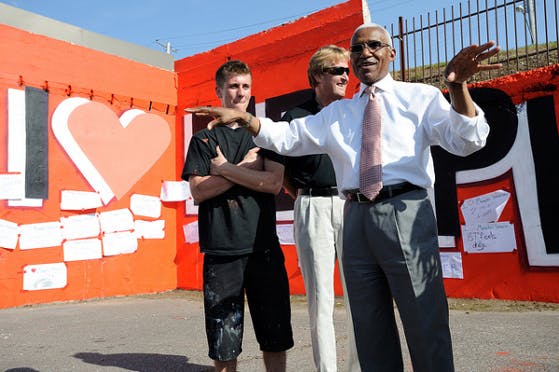
The big idea behind bike projects and the Memphis rebound
April 22, 2014
This week in Memphis, three of the country’s most interesting urban planners are giving a series of free lectures about the big, smart idea behind the deliberate, data-driven revitalization strategy that has led this city to embrace bike infrastructure. ...
Celebrate NYC's latest biking win
April 16, 2014
The George Washington Bridge is a critical link in greater New York City’s bicycle network. Commuter and recreational bike traffic over the bridge has grown so much that recent counts show nearly as many bicyclists as motorists on Rte. 9W north of the bridge! ...

Young people in Indianapolis want low-car lifestyles almost as much as young people in NYC
April 14, 2014
In the business world, it’s called “first mover advantage.” It’s the head start Apple got in the smartphone market because it invented the device. ...
Pacers Bikeshare launches in Indianapolis this week
April 14, 2014
This Tuesday, Indianapolis officially joins urban meccas like Paris, New York and Chicago as a leading city with bikeshare. ...
Indianapolis becomes first city to get NBA-backed bikeshare
April 7, 2014
How stoked would you be if someone told you that you were going to get 250 new bikes? Well, that’s exactly what just happened in Indianapolis! Last Friday, the Indianapolis Cultural Trail, Inc. announced exciting details about a new bikeshare program coming to Indianapolis in a few weeks. ...

Four simple lessons from Austin's brilliant bike plan update
April 3, 2014
In the tech boomtown of Austin, data is king — and city staffers are making some of the country’s strongest data-driven arguments for better bike infrastructure. ...

How high can they go? DC bike counts show continuing surge in protected lane use
March 31, 2014
The older DC’s first two protected bike lanes get, the more spectacular their results seem to become. ...
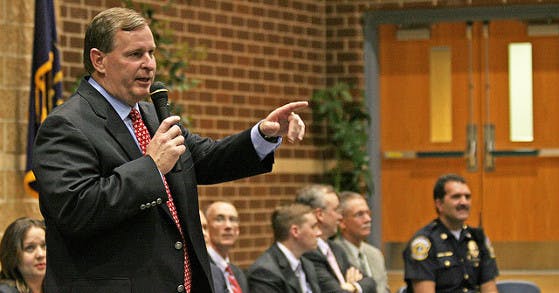
Indianapolis' GOP mayor on bikes and the 'great revival' of US cities
March 27, 2014
The mayor of Indianapolis, Greg Ballard, sounds like the Republican he is when he makes the case for urban bike infrastructure. ...

From DC,a better way to think about businesses and bike lane battles
March 17, 2014
Eventually, everyone redesigning city streets runs into the same problem: small businesses rarely support changes to the roads that bring them customers. ...
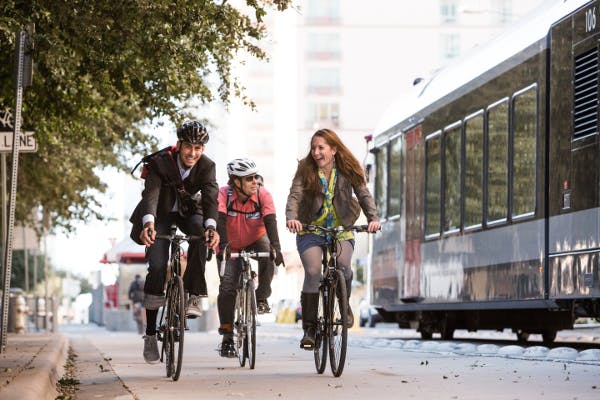
Hygge sighting: The little idea that built Denmark pops up in Austin
March 6, 2014
Would you describe riding a bicycle on a large street in the middle of a major city as “cozy”? ...

Tech Talk: Latest innovations may make it dirt cheap to color streets
January 29, 2014
As more and more U.S. cities embrace color as a way to make bike lanes visible, especially at intersections, a very important group of people are taking notice: the ones who figure out how to color things. ...
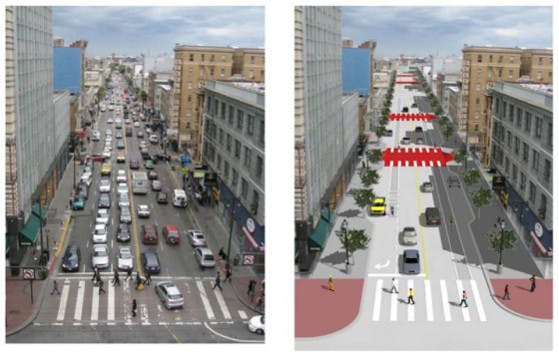
A poor SF neighborhood rallies for less auto parking
January 13, 2014
The trick to scoring community support for less auto parking on a street isn’t to get hell to freeze or pigs to fly. As a new project in San Francisco is proving, sometimes all you have to do is ask residents what they want. ...
'The private sector understands opportunity': How Portland scored its latest biking win
January 4, 2014
On Monday, we shared the almost shockingly good news from Portland that a protected bike lane has helped catalyze a massive bike-friendly private development nearby. The story of this project and the way it’s helping create a “second downtown” on Portland’s east side was one of the most exciting sto ...

Denver tech companies: 'The No. 1 thing they want is bike lanes'
October 31, 2013
The single biggest obstacle to recruiting tech workers to Denver is its lack of good bike lanes, the head of the city’s downtown business association said this month. ...

Why Atlanta is poised to go big for bicycling
October 24, 2013
Move over, Portland and watch out, San Francisco. There’s a new American Bike City on the horizon and she’s closing in fast. ...
Memphis is about to build the country's first crowdfunded bike lane
October 15, 2013
The most interesting bike project in the country just keeps getting more creative. ...
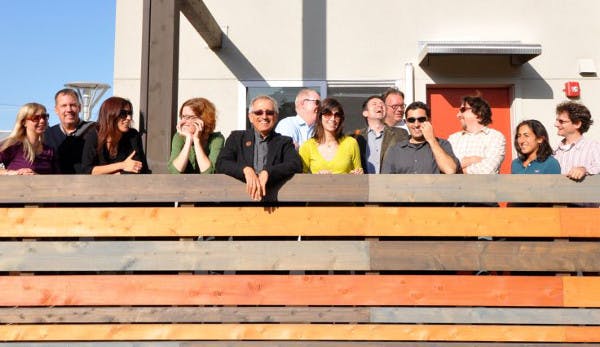
San Francisco architect: Better bike lanes = higher land value
October 10, 2013
David Baker, founder and principal at David Baker + Partners Architects, was dubbed “a starchitect for the common man” for his firm’s work designing green buildings and innovative housing complexes. ...
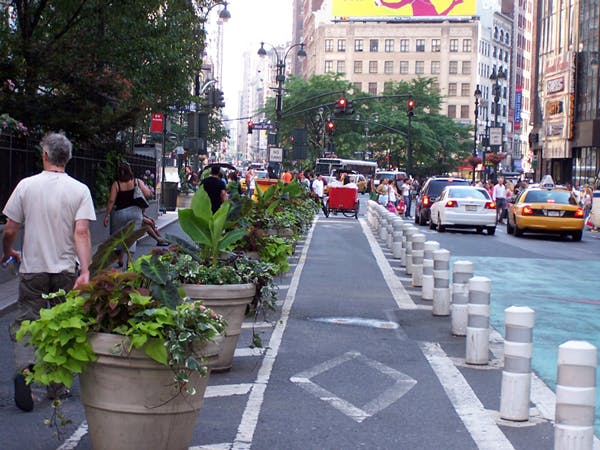
Tech Talk: 19 beautiful ways to protect bike lanes (photos)
October 4, 2013
In the grammar of street design, bollards — those plastic posts that are used to block cars from entering many protected bike lanes — are the commas. ...

Data confirms it: DC is the new U.S. bike city to watch
October 2, 2013
Well, Washington DC isn’t working the way it’s supposed to. But one thing in the District definitely has been: its local bike transportation policy. ...
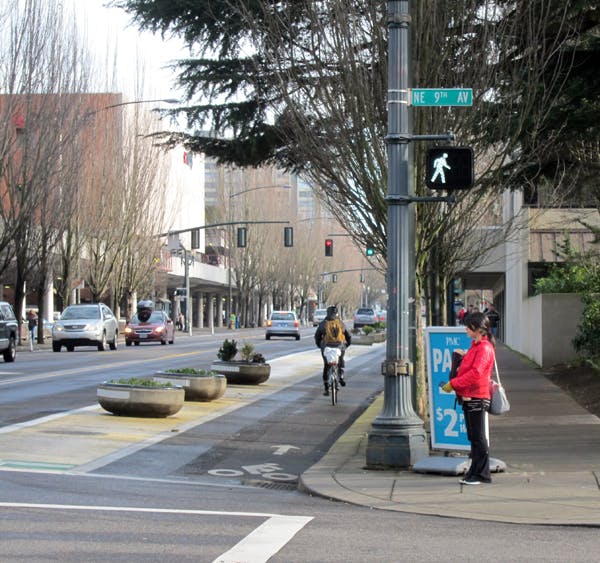
Tech Talk: Using planters as separation
June 27, 2013
We’ve been sharing this photo of Portland’s NE Multnomah protected bike lane in our presentations. We love the use of the planters as part of the separation between the car lane and the bike lane. We’ve been asked how planters can be justified from an engineering standpoint, as they could be conside ...
Green Lane Project officially kicks off in Chicago
May 31, 2013
Bikes Belong’s Green Lane Project is officially kicking off tomorrow, May 31, in Chicago. This initiative will work with Austin, Chicago, Memphis, Portland, Ore., San Francisco and Washington, D.C., to support the cities? development of world-class bicycling facility networks over the next two years ...
Memphis announces major initiatives for protected bike lanes
May 8, 2013
The city named as one of the worst for biking in the U.S. by Bicycling Magazine only five years ago is now aiming to be the best in Tennessee. Memphis Mayor AC Wharton announced groundbreaking plans today to implement a network of protected bike facilities as a part of their commitment to the Green ...
Ray LaHood supports green lanes at Safety Summit
May 3, 2013
The U.S. Department of Transportation hosted two Bicycle Safety Summits in April — one in Tampa and one in Minneapolis. Each summit brought together Federal, state and local officials, planners, designers, engineers, law enforcement, safety experts and others throughout the bicycle community to iden ...

Building support in Chicago, neighborhood by neighborhood
April 13, 2013
As Chicago seeks to implement grand plans for 100 miles of green lanes by 2015, a grant from the Green Lane Project is enabling theActive Transportation Alliance’s Neighborhood Bikeways Campaign to conduct valuable public outreach that is helping to keep Chicago’s plans moving forward. ...
Washington, DC prepares to double down on bicycling
April 12, 2013
The process of creating green lanes starts long before the construction crews show up, before the designs are presented to the public and before the engineers start their studies. It really starts in the unglamorous world of planning. Between 2009 and 2012 Washington has built four miles of protecte ...
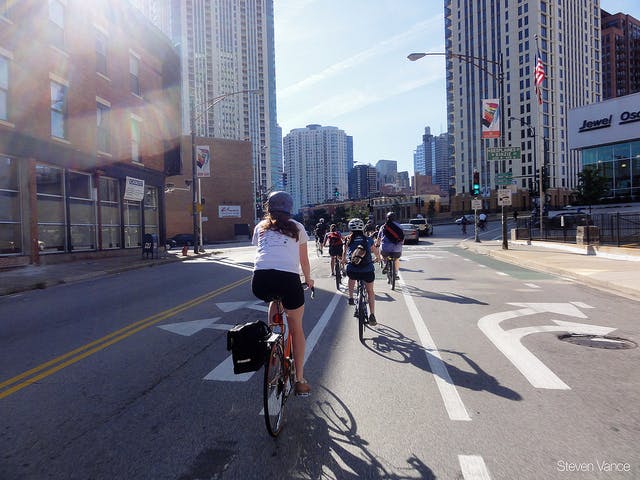
Chicago Considers Bold Steps to Make Room for Protected Lanes
March 7, 2013
The Chicago Department of Transportation has added many miles of protected and buffered bike lanes across the city, but it can be challenging to find space for protected lanes on the streets where they are needed the most. CDOT has implemented ?road diets? on several streets, replacing excess car la ...
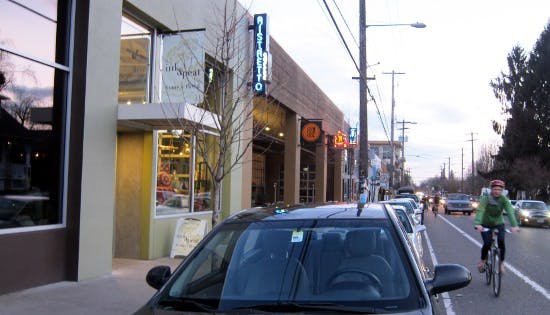
Portland retailers swoop into storefronts along bikeways
March 4, 2013
Urban commercial real estate has always been a rough-and-tumble scrum, and now Amazon.com has torn up the playbook. Across the country, many brick-and-mortar retailers are in big trouble. ...
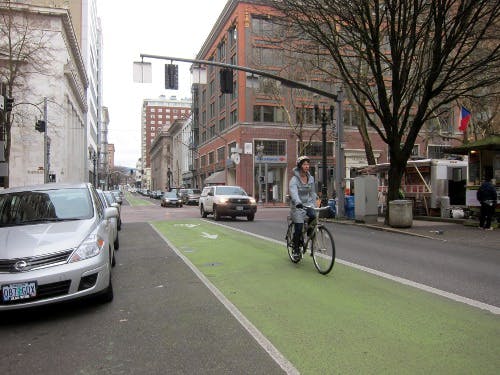
Boxed in by politics,Portland tries a splash of color
February 15, 2013
When protected bike lanes compete for space with commercial auto access, even Portlanders sometimes balk. That’s why the city is trying a new tool to make bikers feel safe: paint. ...
Improved Pennsylvania Avenue Green Lane in the spotlight
February 12, 2013
Last month, Washington, DC had its usual day in the sun for the 57th Presidential Inauguration. But as the traditional parade moved from the Capitol to the White House, it became clear that one of the unexpected stars of the parade would be DC’s Pennsylvania Avenue green lanes. In fact, DC’s commitm ...

Chicago keeps on trucking toward goal of 100 miles of green lanes by 2015
February 1, 2013
In a report released today (PDF), the Chicago Department of Transportation (CDOT) announced that in 2012 it installed and restriped a total of 39 miles of on-street bike facilities throughout Chicago, and has kept pace with Mayor Rahm Emanuel’s plan to install 100 miles of protected green lanes by 2 ...
Mueller District Finds Cycle Tracks Good for Business in Austin
February 1, 2013
The first thing that struck me when I walked into the main administrative building for Mueller was the mounted bicycle hanging over the diorama. I was meeting with some representatives from Catellus Development Group, the master developer of the Mueller mixed-use village, to find out what motivated ...
Looking back at San Francisco's big year
January 20, 2013
San Francisco had a landmark year for bicycle improvements and infrastructure in 2012. From the implementation of physically separated green lanes, to new bicycle traffic signals and more, each development gives added safety to those on and off a bicycle. After years of stalled improvements due to a ...
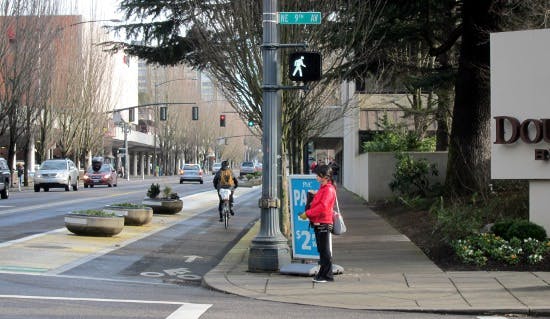
How economic growth sold Portland landlords on a bikeway
January 6, 2013
Not long ago, in the dark days of auto-only transportation planning, a property manager that urged the city to eliminate two auto lanes adjacent to its planned 650-apartment complex might have been judged completely insane. ...
Protected Green Lanes Nearly Double Nationwide in 2012
December 9, 2012
Total to Double Again in 2013 According to New Inventory ...
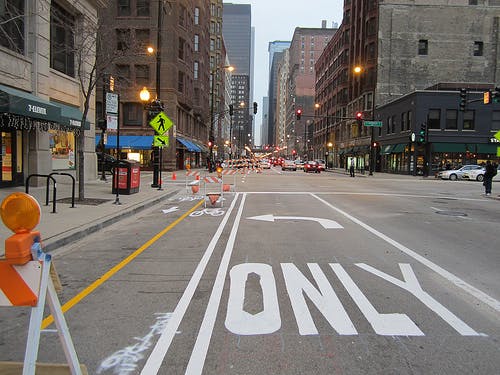
Oh Dearborn! A virtual tour of Chicago's first 2-way green lane
December 3, 2012
These are definitely thrilling times for Chicago cyclists. Last summer Mayor Rahm Emanuel announced that the Chicago Department of Transportation (CDOT) would be installing the city’s first two-way protected bike lane on Dearborn Street, a multilane northbound street through the center of the Loop d ...
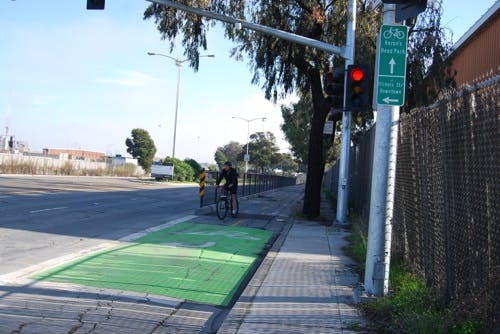
Relaxing Rides in San Francisco
November 25, 2012
The seasons are changing in San Francisco?the air is becoming increasingly crisp, as the days are growing darker. With the inevitability of winter upon us, now is the perfect time to get outside, ride your bike and enjoy the last few days of Indian Summer. And since the upcoming holiday season can b ...
Dutch Bike Embassy Brings Expertise to Austin
November 11, 2012
One of the many great things the Green Lane Project has done is provide funding for our city leaders to travel to Holland. Last month, members of the Dutch Cycling Embassy traveled to Austin to assess our streets and help envision how to make biking an integral part of Austin culture. Check out this ...
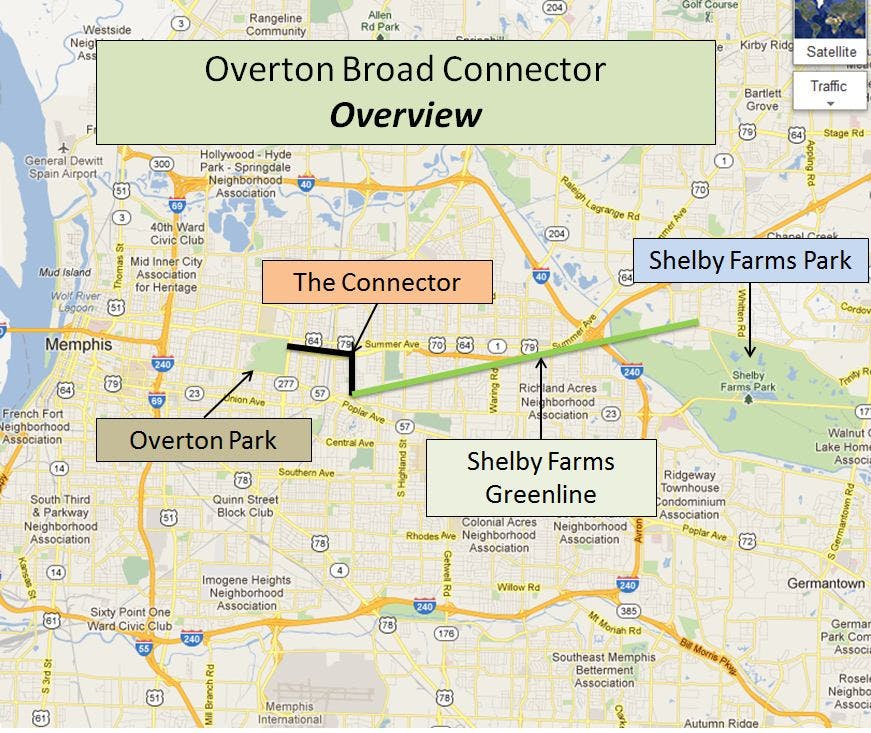
Memphis in the Netherlands: "Blown Away"
November 7, 2012
Even Kyle Wagenschutz, Memphis’ Bicycle and Pedestrian Coordinator, manages to crack a smile from the helm of a tandem where Memphis City Councilman Bill Morrison rides in tow. ...
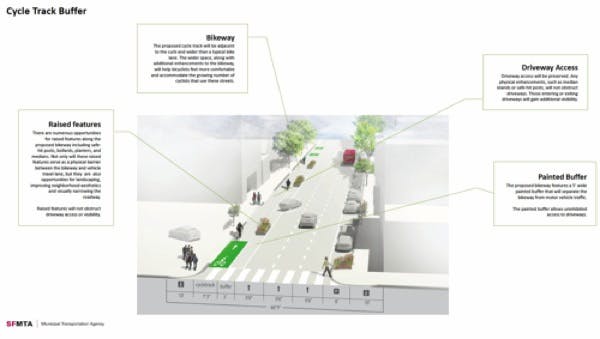
Introducing green lanes on Fell and Oak streets in San Francisco
November 6, 2012
Physically separated green lanes will be introduced on Fell and Oak streets, making the route safer and more inviting for all people who wish to ride a bike. These streets are the flattest and most direct links to the Panhandle bike path and the Wiggle route, which is an extremely popular path despi ...

Washington DC: Green lane to connect rail trail with transportation hub
October 31, 2012
Running north from Union Station, 1st Street NE is quickly becoming the main street of one of Washington, DC’s newest neighborhoods, NoMa. Short for “North of Massachusetts,” NoMa has risen from long-ignored former rail yards to become the east end of downtown. In the last decade, the area has adde ...

Memphis on Broadway
October 12, 2012
Maybe you saw Memphis when it landed on Broadway in October 2009. Or, maybe you read earlier this month about Warner Brothers’ plans to turn the “tale of two star-crossed lovers living in segregated Memphis in the 1950s” into a motion picture. After all, the Broadway performance of Memphis netted ...
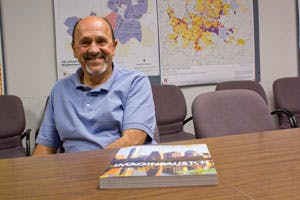
Imagine Austin - Compact and Connected
September 12, 2012
Garner Stoll is the Assistant Director for the Planning & Development Review Department for the City of Austin. He oversaw the development and completion of Imagine Austin, the city’s official comprehensive plan on dealing with growth population and development over the next three decades. ...
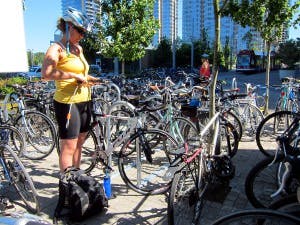
How Portland won its crown - and how to keep it
September 4, 2012
Portland has been the country’s bicycle capital for less than a decade. Claiming that crown took serious work — and retaining it will, too. ...
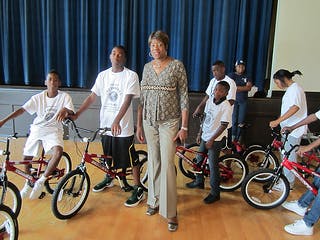
Chicago: Getting Ready for the Green Lane 'Breakthrough'
August 31, 2012
Last week dozens of engineers and planners from across the Chicago area converged on the Sears Tower to learn about green lanes and other new developments in bike facility design. The Chicago Metropolitan Agency for Planning, the region’s official planning organization, hosted this workshop, ?Design ...

San Francisco: Cycling in the City
August 24, 2012
It was a foggy August afternoon seven years ago when I arrived in San Francisco, my life neatly packed into a few boxes. Without a car, my options for transportation were walking, bicycling and taking public transit; luckily, San Francisco is a compact 47 square miles. I quickly learned that walking ...
Washington, DC: Nation’s Capital Commits to Green Lanes
August 23, 2012
Washington, DC is already one of the best biking cities in the United States, frequently being honored on various “best of” bicycling list. But the rapid rise of Capital Bikeshare membership and bike commuter share shows that the Nation’s Capital has room to grow. The success of bike facilities adde ...
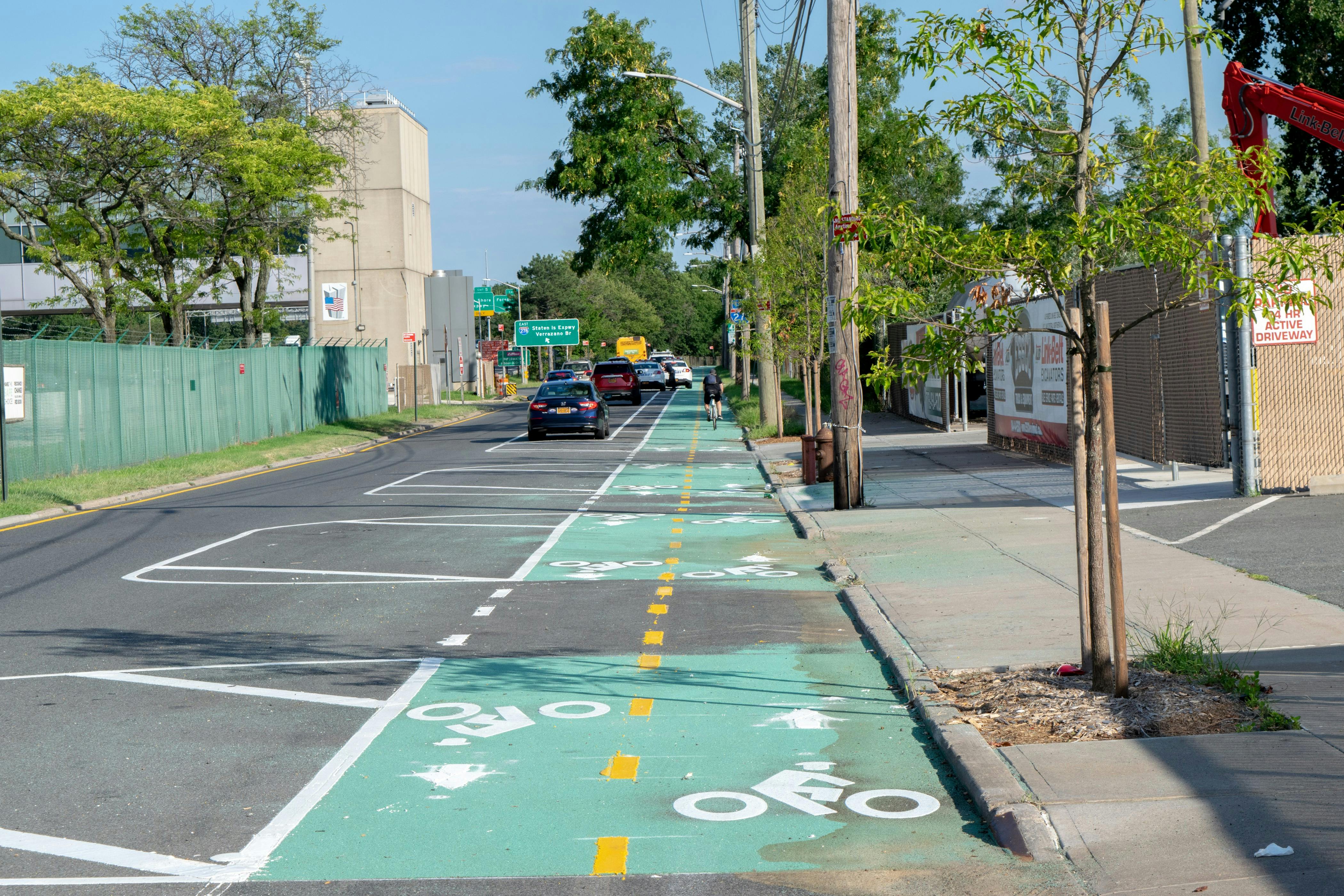
The simple, inexpensive breakthrough that is transforming American cities
June 6, 2012
You can glimpse the future right now in forward-looking American cities a few blocks here, a mile there where people riding bicycles are protected from rushing cars and trucks. ...

Using the Land and Water Conservation Fund for Local Bike Projects
Invalid Date Invalid Date, Invalid Date
There’s an opportunity to increase funding for cities and states to build new bike projects across the U.S. thanks to the Land and Water Conservation Fund (LWCF). The federal government fully and permanently funded the LWCF at $900 million annually when the Great American Outdoors Act became law in ...

FEDERAL AGENDA FOR ACTIVE TRANSPORTATION 2021
Invalid Date Invalid Date, Invalid Date
When it comes to advancing pro-bike policies in 2021, we’re not waiting to get things done. ...
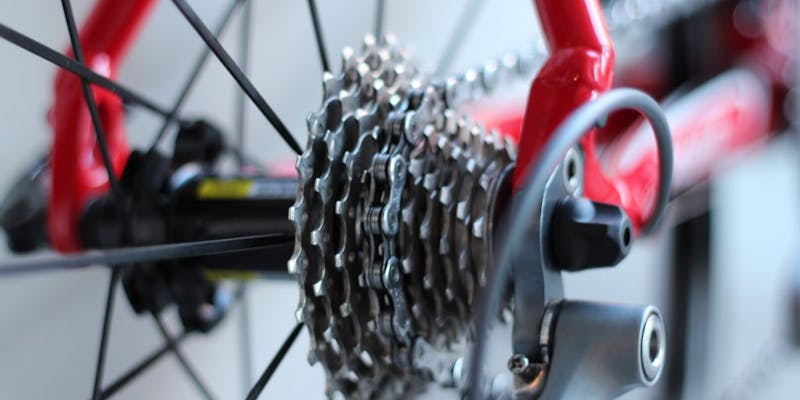
PeopleForBikes Responds to Tariff Announcement and Timetable
Invalid Date Invalid Date, Invalid Date
On Monday, September 17, President Trump announced tariffs on $200 billion of goods imported from China, including bicycles of all sizes, as well as many bike parts and accessories. For the bike industry, these tariffs amount to a $250 million annual tax increase. Considering that 94 percent of comp ...

E-bike Access in National Parks
Invalid Date Invalid Date, Invalid Date
On Aug. 29, Department of Interior Secretary David Bernhardt ordered the Bureau of Land Management, Bureau of Reclamation, Fish and Wildlife Service and the National Park Service (NPS) to establish interim policies within 30 days that guide the use of e-bikes on public lands. The departments were en ...

New Utah Bill Defines Multiple-Mode and Out-of-Class Electric Bicycles
Invalid Date Invalid Date, Invalid Date
The bill is the first in the nation to define multiple-mode products and their labeling requirements while establishing truthful advertising requirements for OCEVs sold as “e-bikes.”
